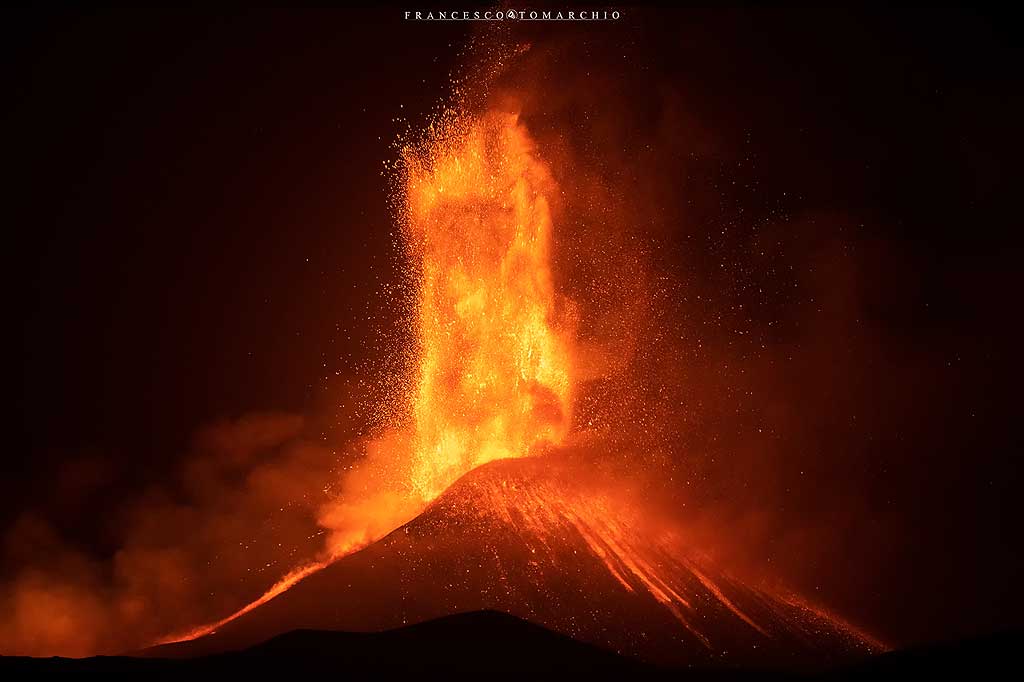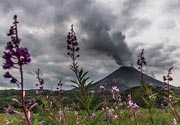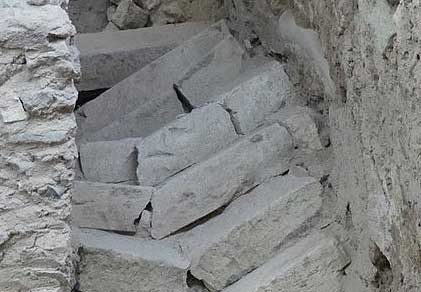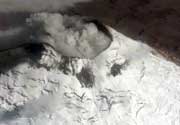Etna volcano (Sicily, Italy): small explosion last night
jeu., 11 avril 2024, 02:54 02:54 AM | AUTEUR : MARTIN
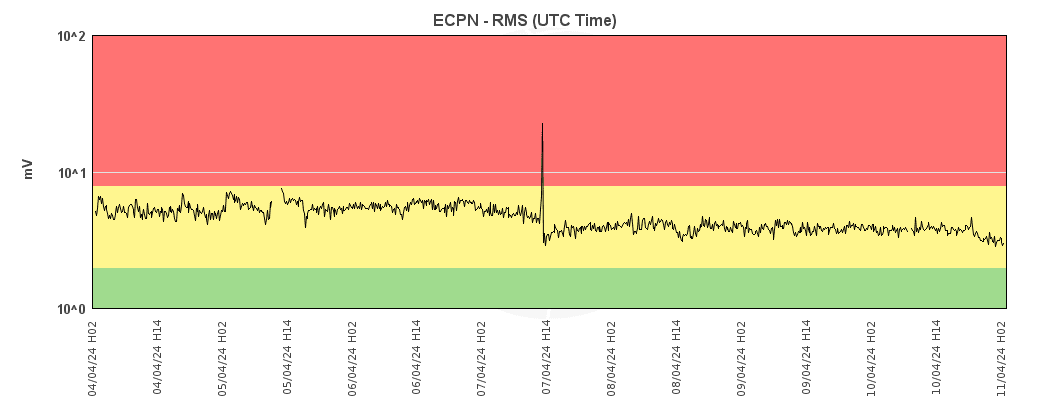
The tremor has remained at medium levels both prior to and during the eruption (image: INGV)
The Istituto Nazionale di Geofisica e Vulcanologia's surveillance cameras registered a minor explosion from the South-East Crater at 20:41 local time yesterday.
Small ash emissions were dispersed in the summit area.
The volcanic tremor remains at medium levels. The tremor was located at approx. 2900 m above the sea level beneath the South-East Crater.
No significant ground deformation was monitored.
Source: Istituto Nazionale di Geofisica e Vulcanologia volcano activity update 11 April 2024Etna volcano (Sicily, Italy): new ash emissions and beautiful vortex rings
lun., 8 avril 2024, 07:35 07:35 AM | AUTEUR : MARTIN
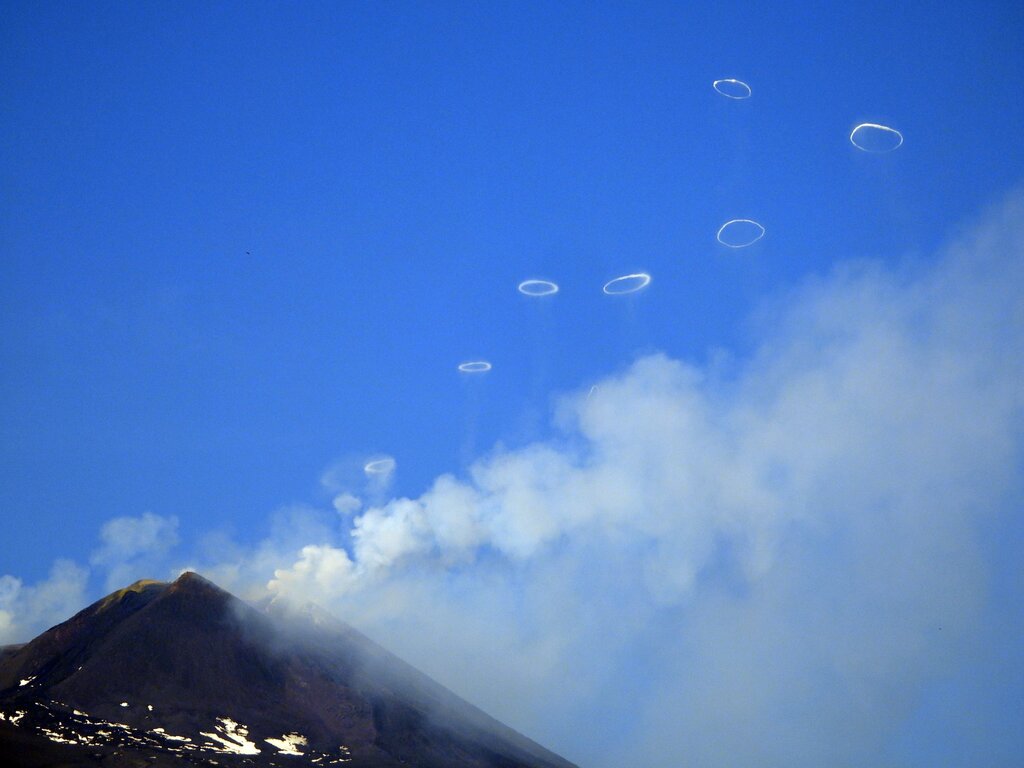
Dozens of steam rings from Etna volcano on 5 April (image: Boris Behncke)
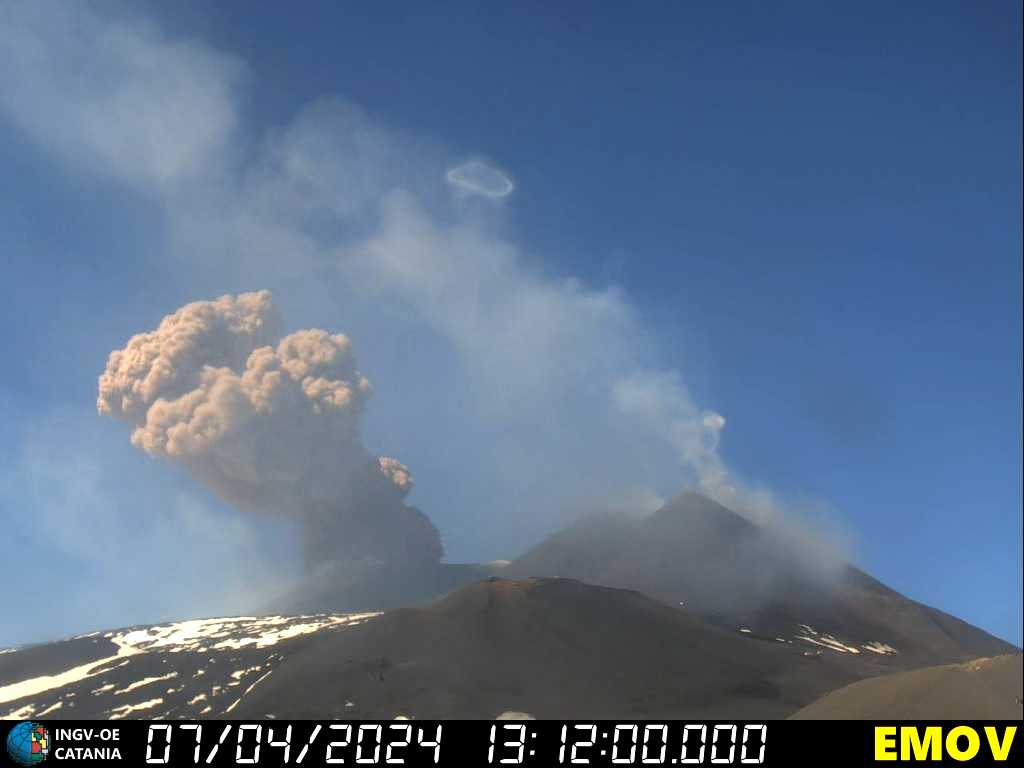
Dense ash emissions and smoke rings from Etna yesterday (image: INGV)
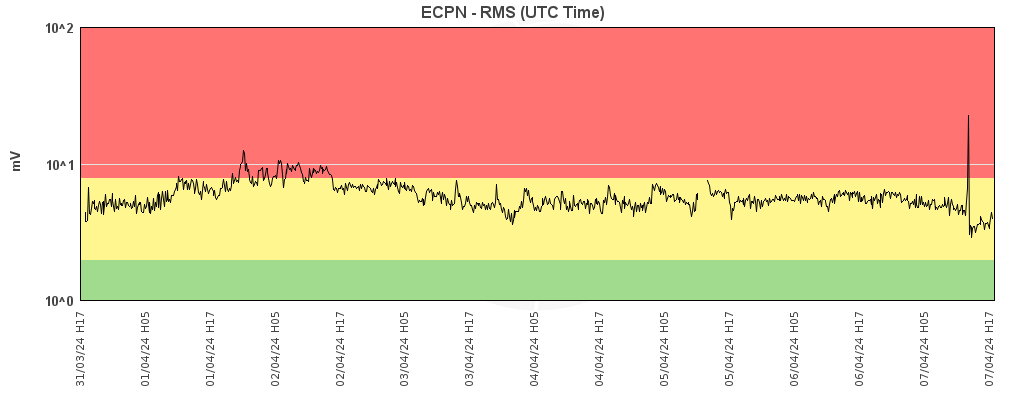
Tremor values at Etna volcano (image: INGV)
Strong, but short-lived ash emissions took place from the Bocca Nuova Crater yesterday.
Emissions, generating an ash plume to estimated 5 km altitude, lasted only 4 minutes and consisted of six explosive eruptions. Fine-grained ash material dissipated in the south direction.
Prior to the event, the INGV seismic station recorded a typical steep rise of a volcanic tremor, indicating rapid magma flux towards the surface through the conduit. Later on, values returned back to medium levels. The tremor was located at approx. 2900 m above the sea level beneath the South-East Crater.
Volcanic vortex ringsSince 2 April, a series of dozens-to-hundreds fantastic ring vortexes (steam/smoke rings) have been puffing from the Southeast Crater. These ring vortexes form when pulsating gas/steam emissions pass through a perfectly circular vent, generating this rare phenomenon.
Source: The Istituto Nazionale di Geofisica e Vulcanologia volcano activity update 8 April 2024 We would like to show you embedded content from X/Twitter. If you like to see this content, please make sure you agree with the
privacy policy of X/Twitter and click the button:
View embedded content from X/TwitterUpdate Fri 01 Dec 2023 21:51
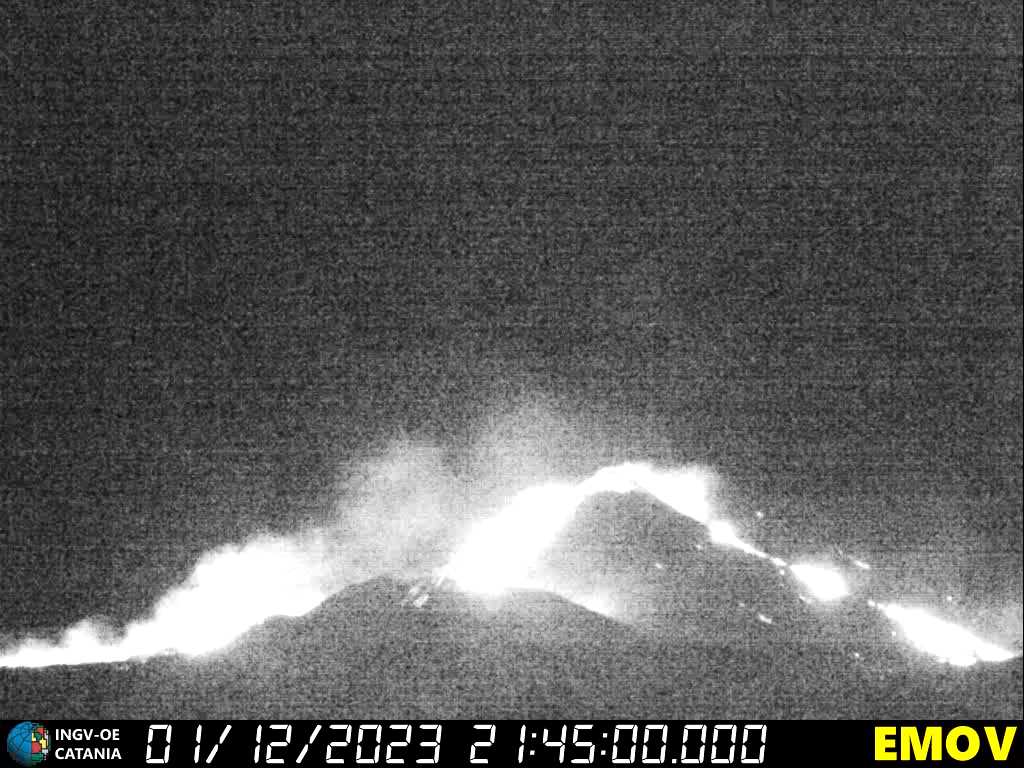
Webcam view of the SE crater after the end of the paroxysm (image: INGV Catania webcam)
The paroxysm ended abruptly (as usual). The aftermath is impressive: the SE cone covered with incandescent material and two bright lava flows still descending on its flanks, the eastern one into Valle del Bove.
Etna volcano (Italy): powerful lava-fountaining episode in progress
ven., 1 déc. 2023, 19:32 19:32 PM | AUTEUR : T
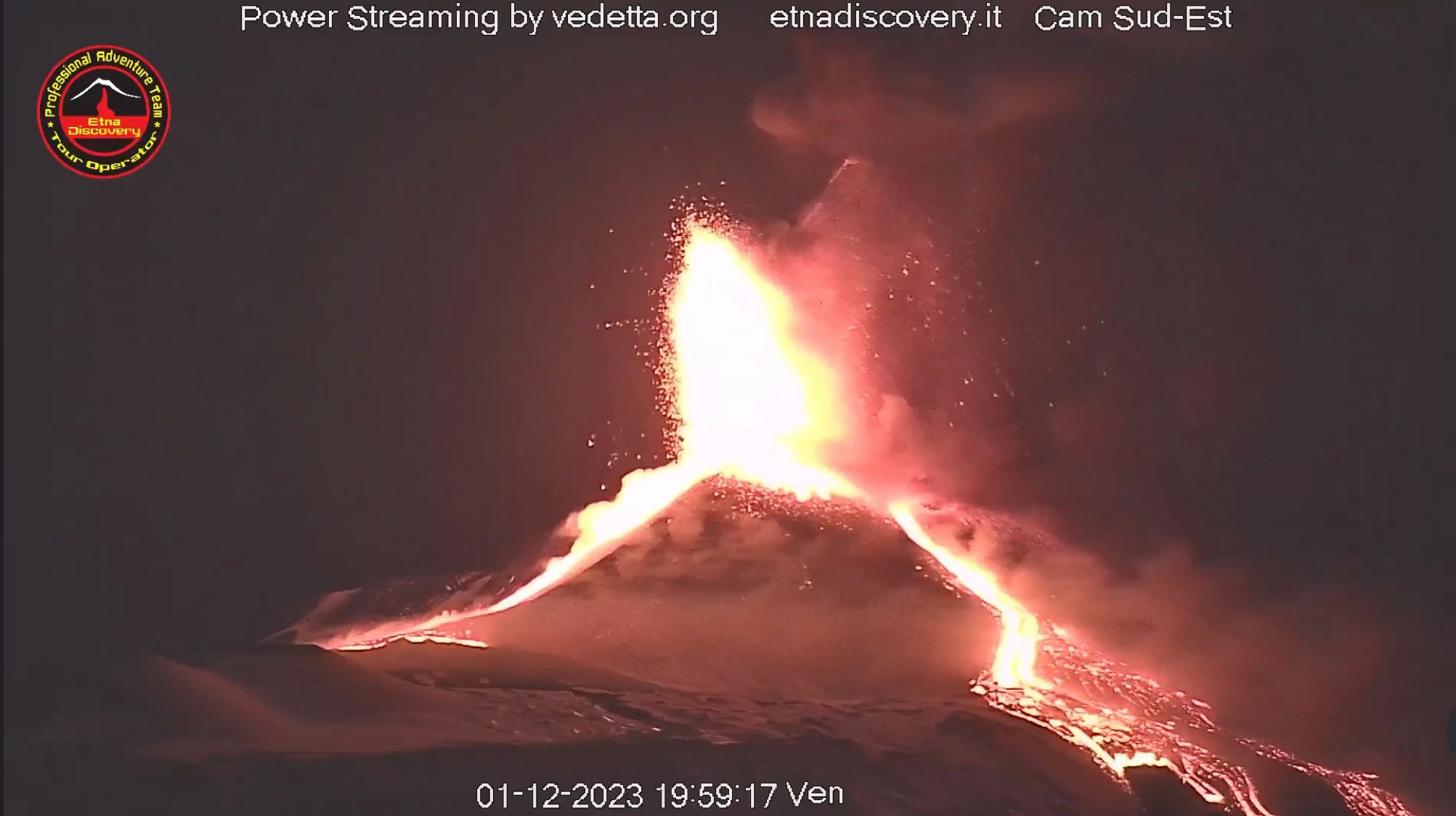
Lava fountains from Etna on 1 Dec 2023 evening (image: etnadiscovery.it webcam)
A powerful eruption is in progress at the volcano now. Known as paroxysms, the South-East crater produces strong lava fountains rising at least 500 m in height and feeding two lava flows towards the east and southwest of the cone.
The eruption is another one in a long series of paroxysms from the SE crater in recent years. As always, it announced itself in that volcanic tremor started to rise sharply a few hours ago. The eruption has now probably reached its peak intensity. In most cases, this phase will last less than a few hours at most.
At the moment, a dense column of ash is rising above the vent to an estimated altitude of 30,000 ft (10 km) and drifting towards the East. An aviation alert has been issued.
New series of paroxysms still continues, spectacular lava fountains and lava flow from SE Crater
Update Fri 01 Dec 2023 20:08
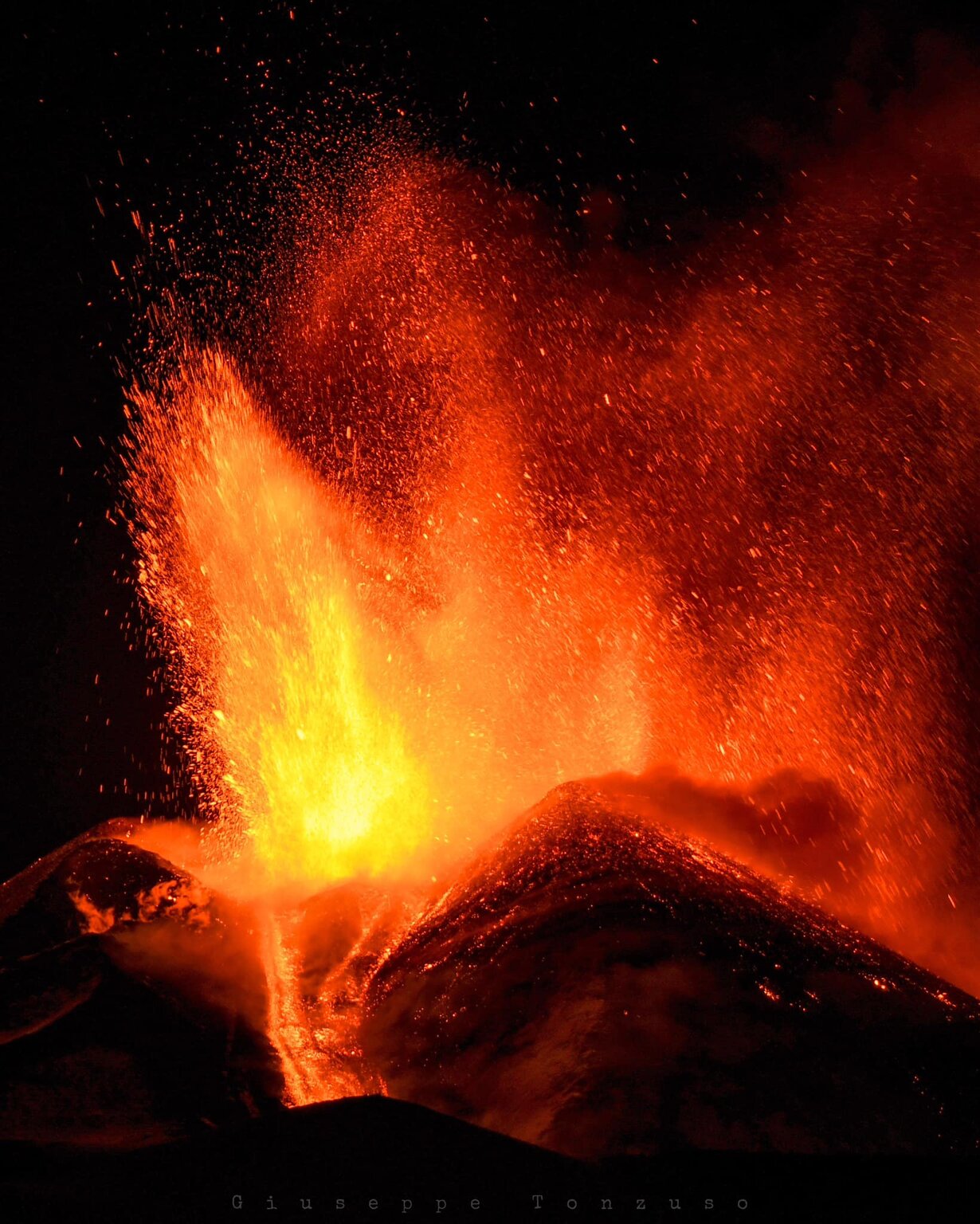
Bursting lava fountains from the Etna's SE Crater tonight (image: @mondoterremoti/twitter)
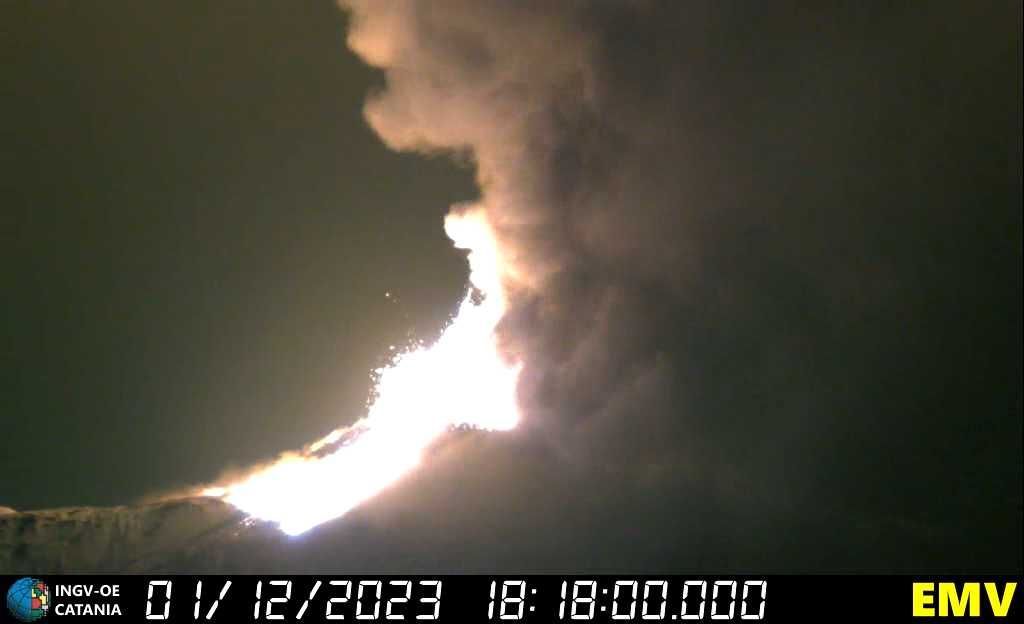
Strong eruptive episode at Etna today (image: INGV)
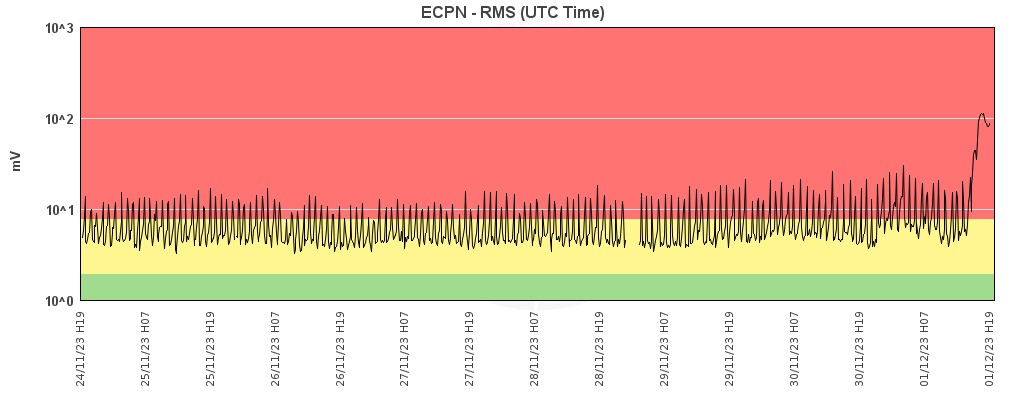
Sharp spike in tremor preceded the eruption (image: INGV)
Following periods of short-lived strombolian-style explosions from the volcano's from the Southeast Crater over the past three weeks, the eruptive activity has culminated in a strong eruptive episode (high magnitude explosive eruptions) today, known as paroxysms.
The intense constant strombolian activity from the crater continued until 18:00 local time since it has been picking up by forming high lava fountains.
Some lava jets are surpassing several hundreds of meters, throwing molten lava bombs on the crater flanks, which in turn form incandescent avalanches spreading in various directions.
A few minutes later, a new lava flow started to appear traveling over the flank towards the crater base. It formed as hot, fluid blebs of lava from fire fountains have been falling to the ground, coalescing thereby forming lava flow.
According to the VAAC Toulouse, continuous emissions of ash have been reaching an altitude of 30,000 ft (9,100 m) in the eastern direction.
Prior to the paroxysm episode, seismic recordings detected a strongly rising signal of volcanic tremor, hinting rapid magma flux towards the surface. The volcanic tremor continues to be localized in the SE Crater area at an altitude of 2900 meters above sea level.
The paroxysm activity is continuing at the time of this update, and you can watch a live stream
here.
We would like to show you embedded content from X/Twitter. If you like to see this content, please make sure you agree with the
privacy policy of X/Twitter and click the button:
View embedded content from X/TwitterWe would like to show you embedded content from X/Twitter. If you like to see this content, please make sure you agree with the
privacy policy of X/Twitter and click the button:
View embedded content from X/TwitterPhases of short-lived strombolian-style eruptions continue
Update Thu 30 Nov 2023 09:44
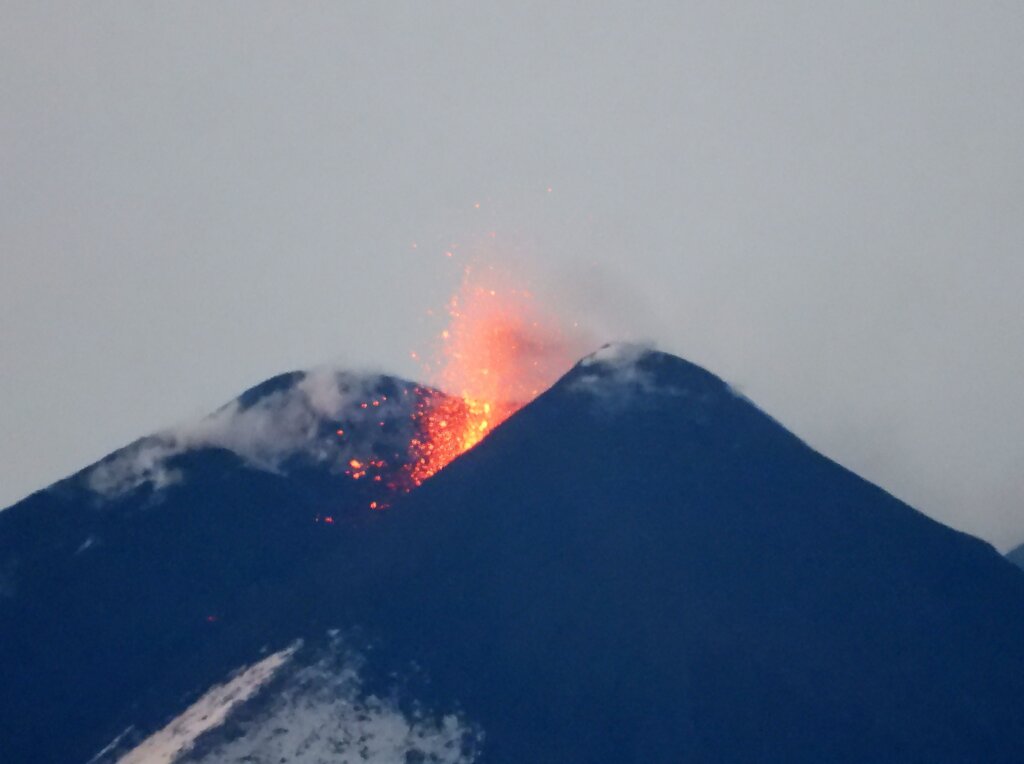
Molten lava bombs from the SE Crater (image: Boris Behncke)
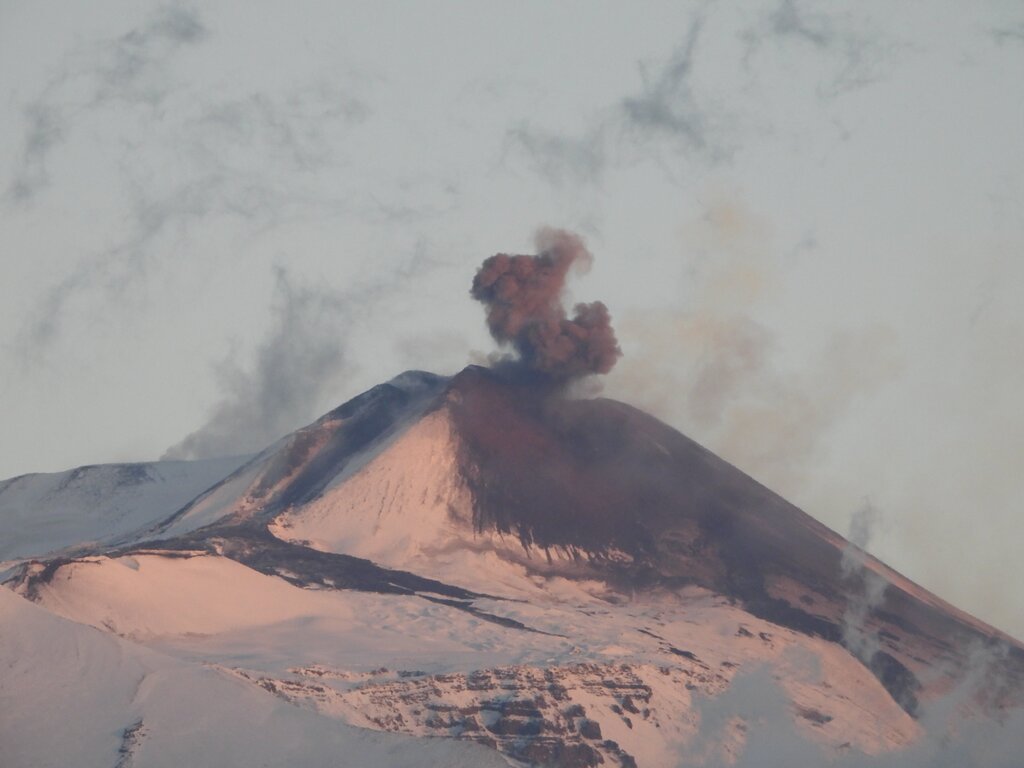
Ash emissions from Etna's SE Crater (image: Boris Behncke)
Strombolian activity, commencing on 19 November, has continued at the volcano over the past few days.
The eruptive activity from the Southeast Crater is defined by short sequences in series lasting at roughly regular intervals of 10-30 minutes combined with a period of 60-70 minutes of quiescence.
Typical bright fluidal lava bombs (spatter) have been ejected from the crater to an approx. height of several dozens to hundreds. Some of the lava bombs fall outside the crater.
Ash, gas and water vapor emissions extended toward the east-southeast.
Periods of mean amplitudes of the volcanic tremor have been varying between medium and high values. The volcanic tremor continues to be localized in the SE Crater area.
Source: Istituto Nazionale di Geofisica e Vulcanologia volcano activity update 30 November 2023Giant smoke ring puffing from crater
Update Sun 26 Nov 2023 11:59
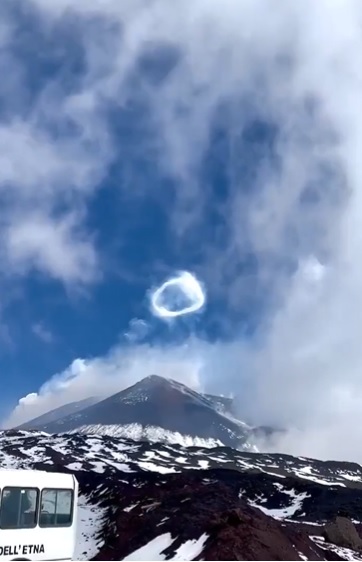
Etna volcano sends a giant vortex ring from the crater (image: Etna guide)
These ring vortexes form when pulsating gas / steam emissions pass through a perfectly circular vent, generating this rare phenomenon.
We would like to show you embedded content from X/Twitter. If you like to see this content, please make sure you agree with the
privacy policy of X/Twitter and click the button:
View embedded content from X/TwitterStrombolian activity from SE Crater persists
Update Sun 26 Nov 2023 06:59
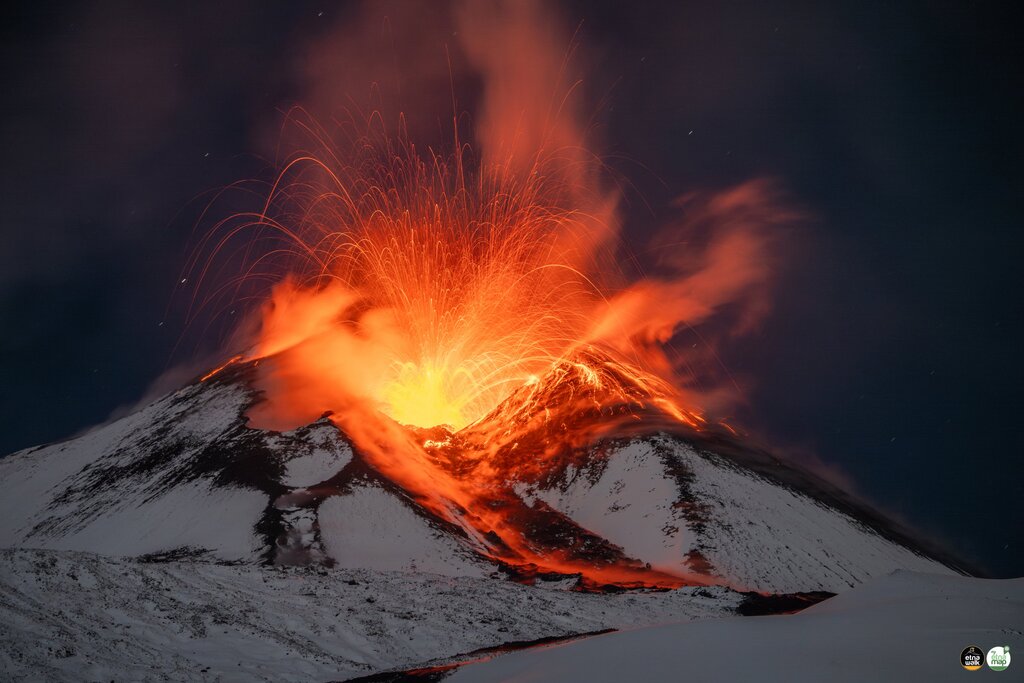
Strombolian activity from the SE Crater (image: Etna Walk)
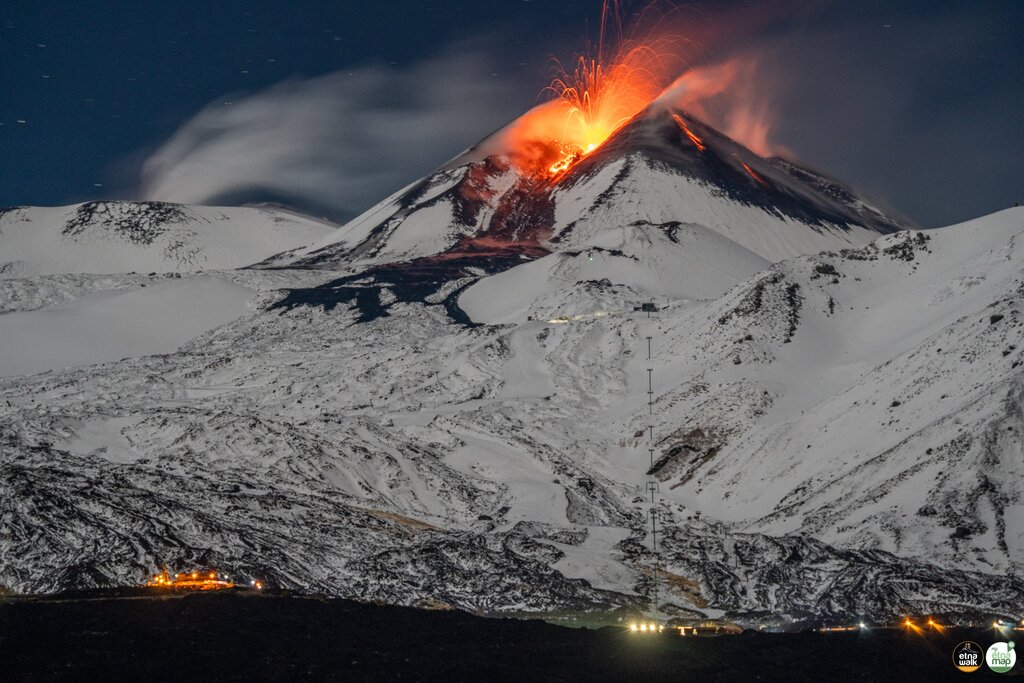
Strombolian activity from the SE Crater (image: Etna Walk)
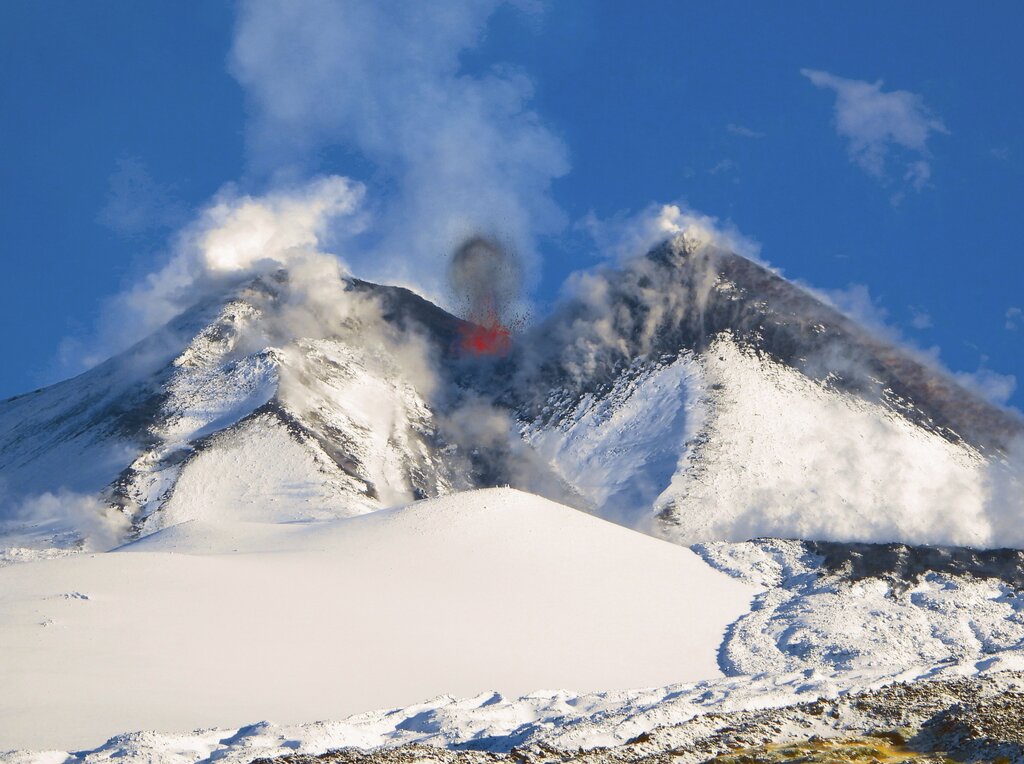
Red-hot glowing lava bombs from the SE Crater (image: Boris Behncke)
Strombolian activity, commencing on 19 November, has continued at the volcano throughout yesterday.
The eruptive activity from the Southeast Crater is defined by short sequences in series lasting at roughly regular intervals of 10-30 minutes combined with a period of 30-60 minutes of quiescence.
Typical bright fluidal lava bombs (spatter) have been ejected from the crater to an approx. height of several dozens to hundreds. Some of the lava bombs fall outside the crater.
Ash, gas and water vapor emissions extended toward the east.
Periods of mean amplitudes of the volcanic tremor have been varying between medium and high values. The volcanic tremor continues to be localized in the SE Crater area.
Source: Istituto Nazionale di Geofisica e Vulcanologia volcano activity update 26 November 2023
We would like to show you embedded content from X/Twitter. If you like to see this content, please make sure you agree with the
privacy policy of X/Twitter and click the button:
View embedded content from X/TwitterWe would like to show you embedded content from X/Twitter. If you like to see this content, please make sure you agree with the
privacy policy of X/Twitter and click the button:
View embedded content from X/TwitterVigorous strombolian eruption last night
Update Fri 24 Nov 2023 15:38
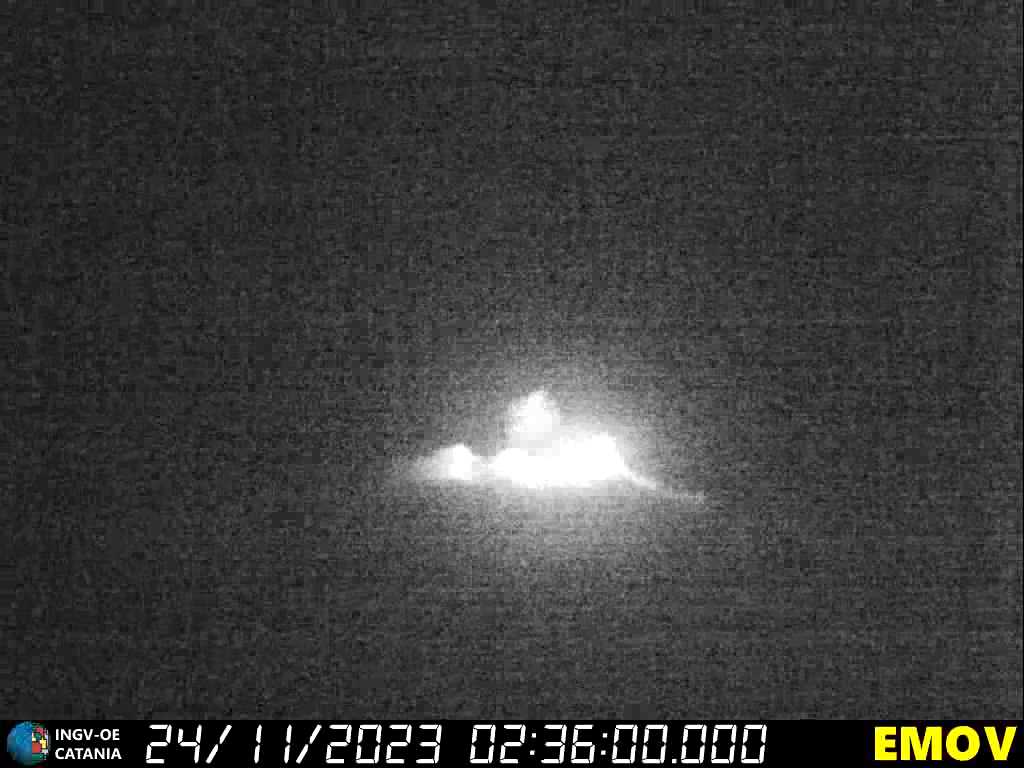
Strombolian explosion from the SE Crater last night (image: INGV)
The INGV volcano observatory reported an increasing strombolian-style activity from the Southeast Crater at 03:36 UTC last night.
Ash emissions, glowing lava bombs and emissions of steam and gas were ejected off the crater. Emissions dissipated to the north-northwest of the volcano.
Periods of medium-to-low amplitude tremor accompanied the eruption. The volcanic tremor were localized in the SE Crater area.
Source: Istituto Nazionale di Geofisica e Vulcanologia volcano activity update 24 November 2023Strombolian activity from SE Crater last night
Update Mon 20 Nov 2023 06:00
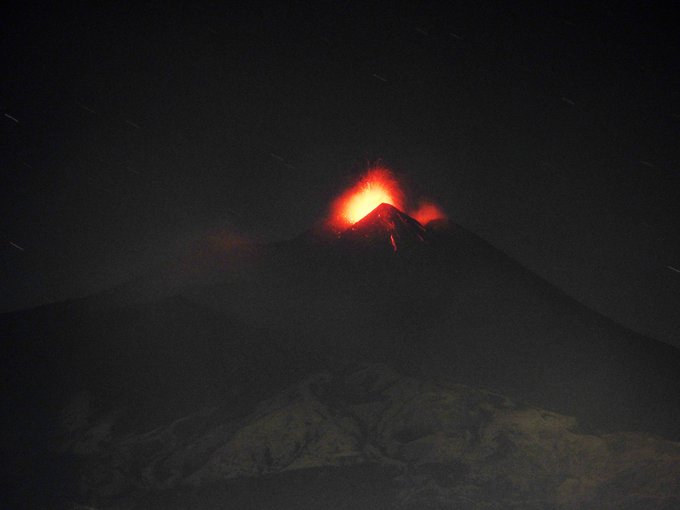
Strombolian explosions from the SE Crater continued last night (image: Boris Behncke)
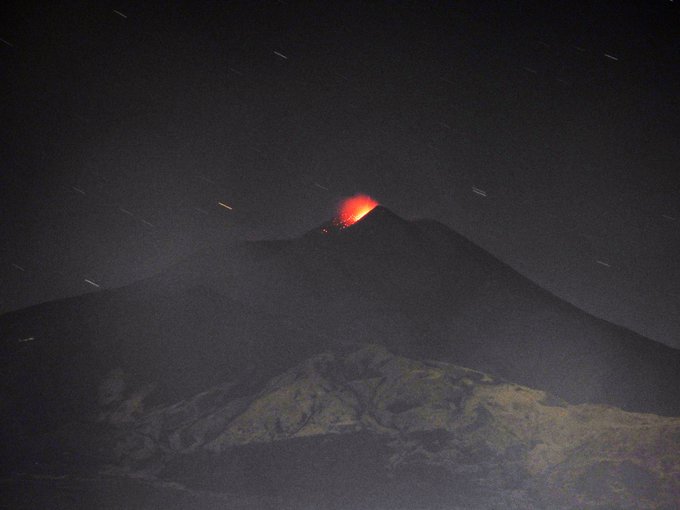
Strombolian explosions from the SE Crater continued last night (image: Boris Behncke)
After several days of a calm period at the volcano, minor strombolian-type explosions took place from the Southeast Crater last night.
Given the recent paroxysm, weak strombolian explosions preceded the lava-fountaining phase. It might be a precursor of another strong eruptive episode.
New series of paroxysm
Update Sun 12 Nov 2023 18:00
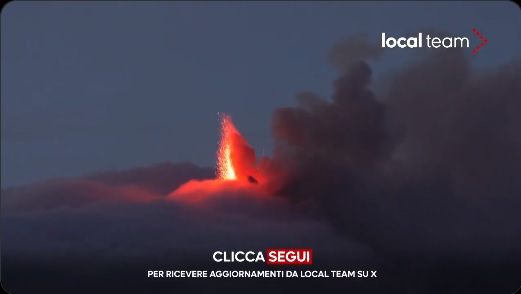
Tall lava fountains from Etna's Southeast Crater tonight (image: Local Team)
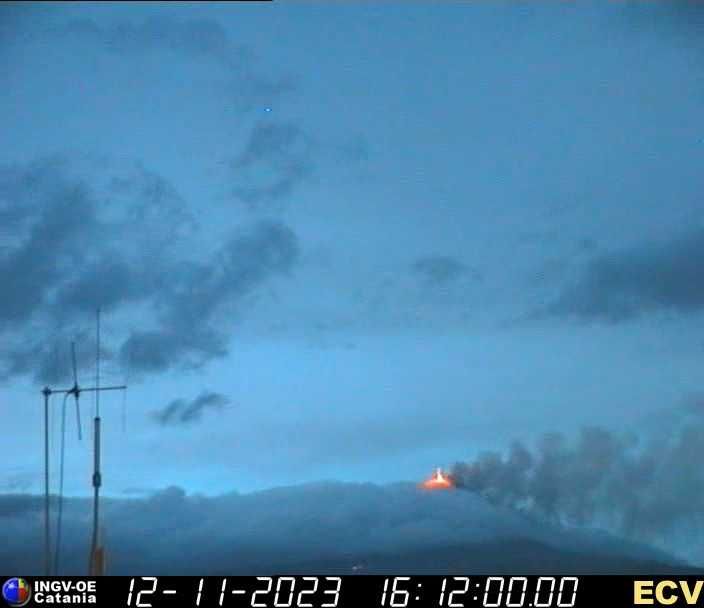
Vivid lava fountains over Catania (image: INGV)
A new strong eruptive episode (high magnitude explosive eruptions classified as paroxysm) is now in progress at the volcano's Southeast Crater.
Bursting intense lava fountains release glowing scoria lapilli-to-bomb sized material ejecting up to perhaps a few hundreds meters above the vent. The activity is associated with usual copious ash and gas emissions.
An eruption onset of paroxysm was dominated by increasing strombolian activity along with a typical several-hour rise in volcanic tremor since midnight. First, increasing gradually over hours, then very sharply peaked until it led magma flux towards the surface. Locations of tremor events rapidly shifted beneath the Southeast Crater at 2900 meters altitude.
A new batch of magma arrived in the inner vent therefore, from where overflowed the crater saddle rim and currently remains confined in the crater area.
The INGV observatory detected a usual precursor at 09:00 this morning when strombolian explosions started and have become stronger and near-continuous, culminating into the recently formed powerful lava-fountaining phase.
Ashfall has been reported in the town of Milo.
Etna's tendency to produce such events is nothing unusual and it occurs from time to time. Furthermore, it could be a beginning of a new series of paroxysm.
We would like to show you embedded content from X/Twitter. If you like to see this content, please make sure you agree with the
privacy policy of X/Twitter and click the button:
View embedded content from X/TwitterThe increasing strombolian activity before the paroxysm fountaining episode (source: Boris Behncke)
We would like to show you embedded content from X/Twitter. If you like to see this content, please make sure you agree with the
privacy policy of X/Twitter and click the button:
View embedded content from X/TwitterSmall lava overflow from SE Crater last night
Update Sat 11 Nov 2023 13:29
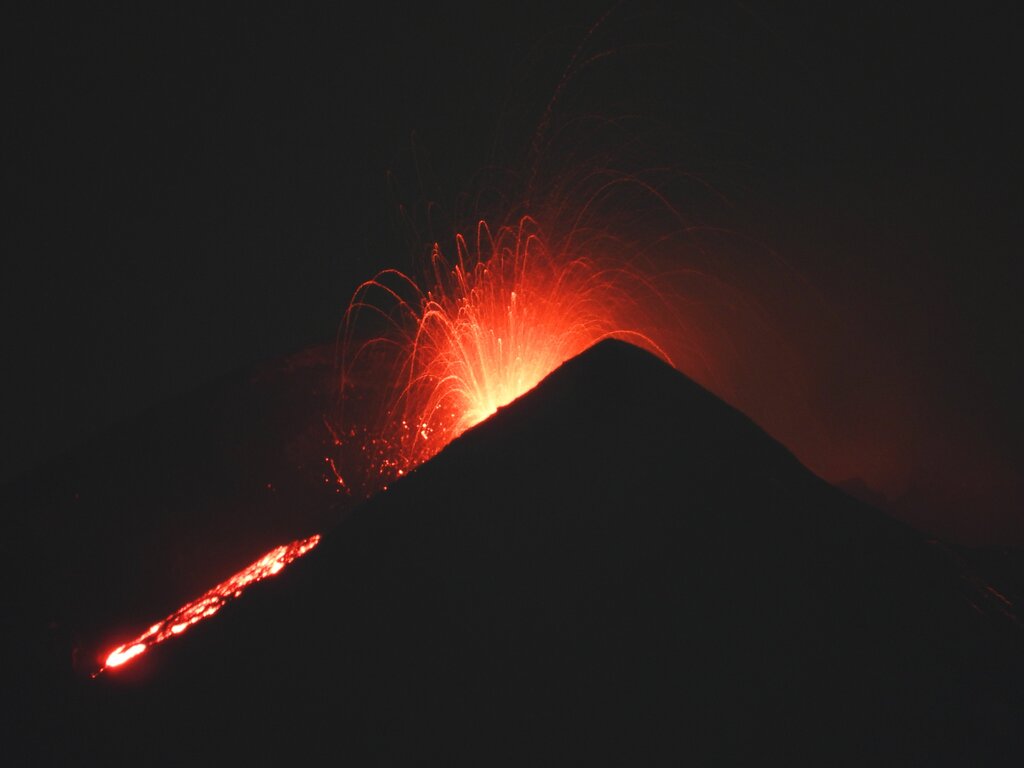
Elevated strombolian activity and the lava overflow from the Southeast Crater last night (image: Boris Behncke)
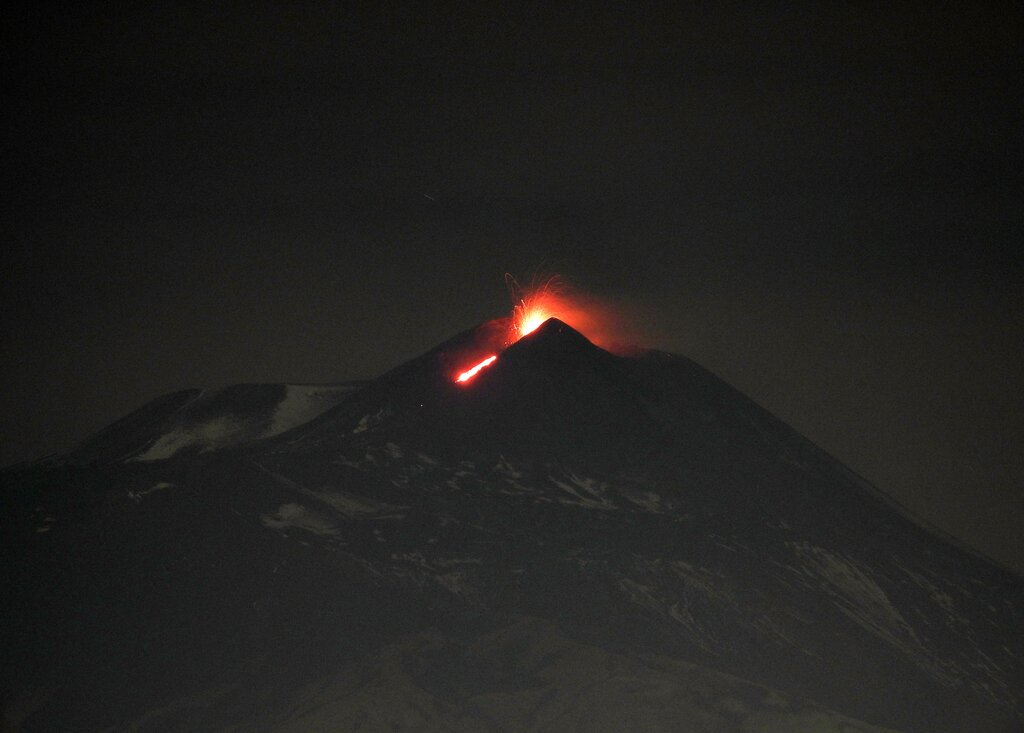
Elevated strombolian activity and the lava overflow from the Southeast Crater last night (image: Boris Behncke)
An increased phase of strombolian activity occurred at the volcano's Southeast Crater last night.
This eruption culminated in a short-lived lava overflow.
The activity ceased some time during the night to Saturday and reactivated a bit before noon today.
Sporadic mild strombolian activity at SE crater
Update Sat 28 Oct 2023 06:45
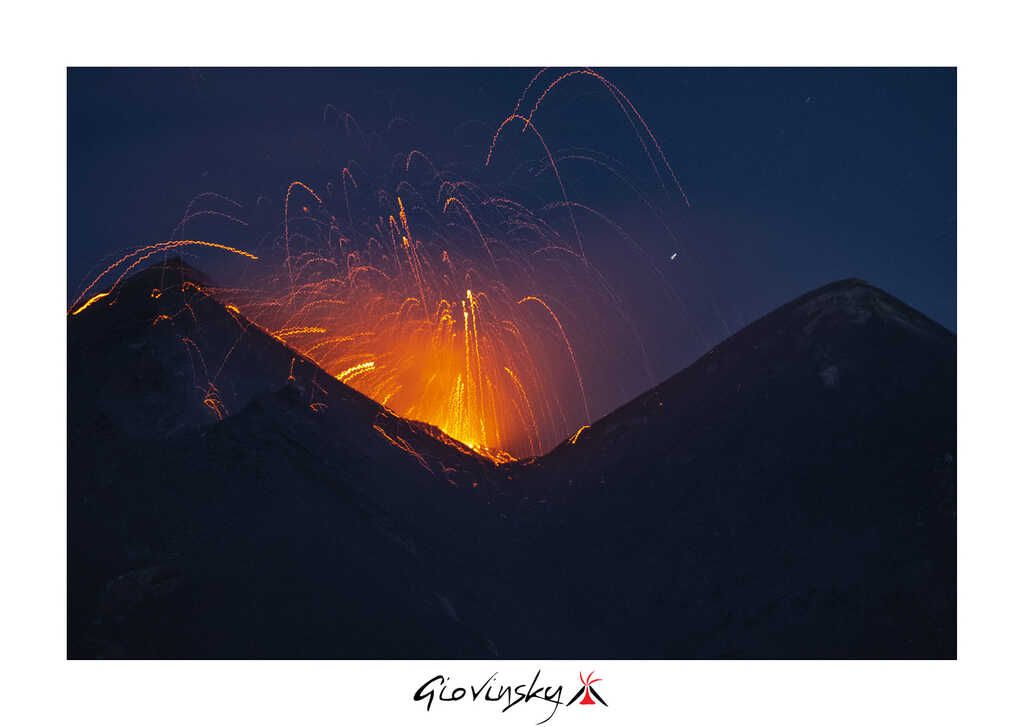
Mild strombolian eruption at Etna's SE crater on 27 Oct 2023 (image: Giovinsky Sicilia / facebook)
The volcano has been relatively calm, at least at the surface, during the past weeks.
However, there are clear signs that Etna is not in a deep slumber and might wake up with a more vigorous phase of eruptions at any time. The most telling is in the form of occasional, mild strombolian explosions from the SE crater such as
observed last night, indicating that magma inside the conduits remains high.
In many cases, such activity has been prelude for violent lava-fountaining episodes known as paroxysms, such as last in August this year. The onset of these is usually characterized by increasing strombolian activity along with a rise in volcanic tremor, first increasing gradually over hours or days, then very sharply during few minutes until reaching impressive peaks of violent activity.
Whether the current activity is going to evolve this way is impossible to say, or when it might do so. It remains a possible scenario for the near to medium future. For the moment, volcanic tremor remains low, meaning it is not imminent.
Etna volcano (Sicily, Italy): lava fountaining episode ceased
lun., 14 août 2023, 10:25 10:25 AM | AUTEUR : MARTIN
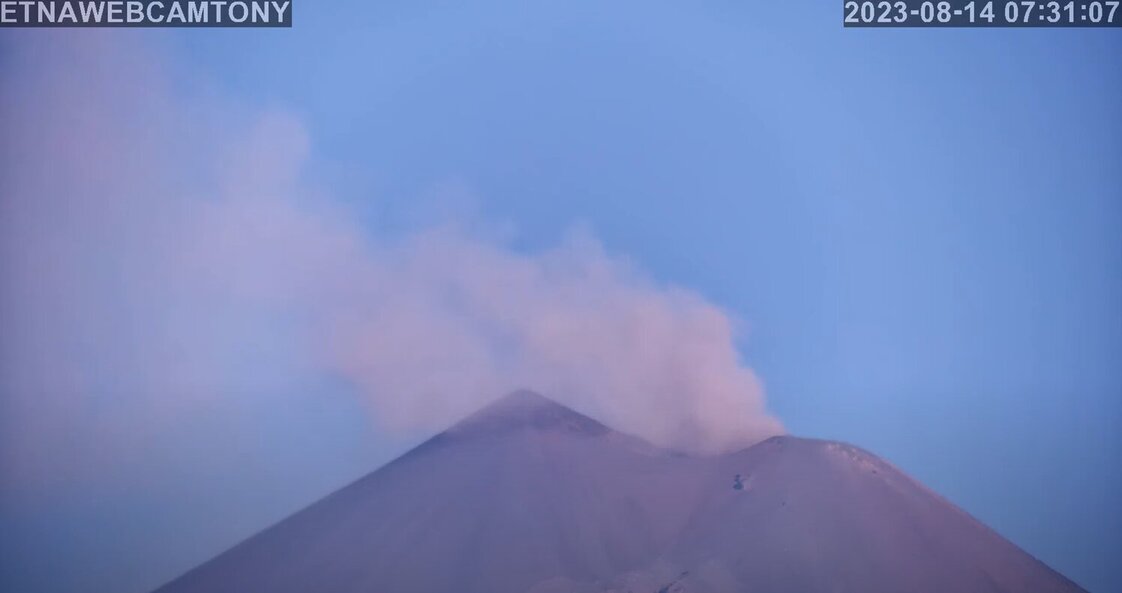
Weak ash emissions from the SE crater have continued this morning (image: Zafferana Etnea live webcam)
The recent paroxysm phase ended, and the activity of the volcano returned to background pre-eruption levels, the INGV reported.
Pulsating lava fountains from the South-East crater ceased at around 03:20 UTC. Thereafter, the volcano became calmer, with "only" venting of continuous small emissions of ash from the crater, at 05:50 UTC it switched into an intermittent phase.
Meanwhile, the lava flow on the southwestern flank of the SE crater stopped to be active.
The highly elevated volcanic tremor, which reached its peak at 01:20 UTC, decreased back to medium levels at 03:20 UTC, currently located at altitude of 2700 meters beneath the South-East crater.
Source: Istituto Nazionale di Geofisica e Vulcanologia volcano activity update 14 August 2023Etna volcano (Sicily, Italy): paroxysm episode followed intense strombolian activity last night, impressive lava fountains and new lava flow from SE crater
lun., 14 août 2023, 05:39 05:39 AM | AUTEUR : MARTIN
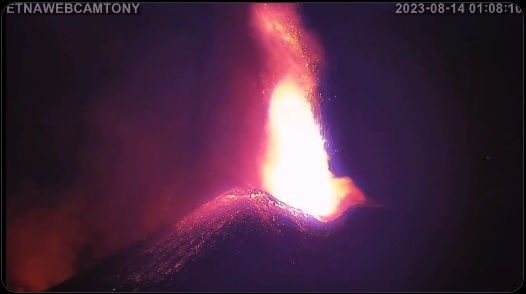
Paroxysm activity from the Etna's SE crater last night (image: Zafferana Etnea live webcam)
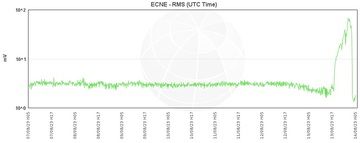
The usual sharp spike in tremor preceded the paroxysm onset and its strong decline afterwards (image: INGV)
The INGV volcano observatory reported that strombolian activity from the South-East crater began to increase last night.
The new eruption has been picking up gradually from 18:40 UTC, which became stronger and continuous, defined by a pulsating lava fountaining episode (likely to be classified as paroxysm) from the crater accompanied by continuous dense ash emissions. Glowing basaltic lapilli-to-bomb-sized scoria material has been regularly ejected onto the upper outer sloper of the crater and caused small incandescent avalanches. From an accessible webcam pointing to the eruptive site, the height of lava fountains seems to have surpassed by some lava jets several hundreds of meters above the vent.
This resulted in a new lava flow triggering from the southern flank of the South-East crater.
Ash and black lapilli set (tephra) have been reported in the area of Rifugio Sapienza - Piano Vetore from the ongoing paroxysm.
The live stream of the ongoing eruption, available
here, indicates a likelihood of a reduced activity at the volcano's SE summit crater, showing active brownish ash emissions, described as "earthy". This could mean that most of the emitted material might be from older lava rocks in the summit crater or inside the vent right now.
Prior to the eruption, the seismic network recorded a sharp peak in internal continuous vibrations (so-called tremor) at 18:00 UTC, a typical sign for the impending paroxysm, indicating magma moving upwards through the volcanic conduits. The high-amplitude volcanic tremor lasted about 20 minutes before the eruption onset. The earthquake swarm is being located at altitude between 2800 and 2900 meters beneath the South-East crater.
From a ground deformation point of view, no significant values have been detected.
Source: Istituto Nazionale di Geofisica e Vulcanologia volcano activity update 14 August 2023 We would like to show you embedded content from X/Twitter. If you like to see this content, please make sure you agree with the
privacy policy of X/Twitter and click the button:
View embedded content from X/TwitterWe would like to show you embedded content from X/Twitter. If you like to see this content, please make sure you agree with the
privacy policy of X/Twitter and click the button:
View embedded content from X/TwitterEtna volcano (Sicily, Italy): small eruption from SE crater
dim., 16 juil. 2023, 04:14 04:14 AM | AUTEUR : MARTIN
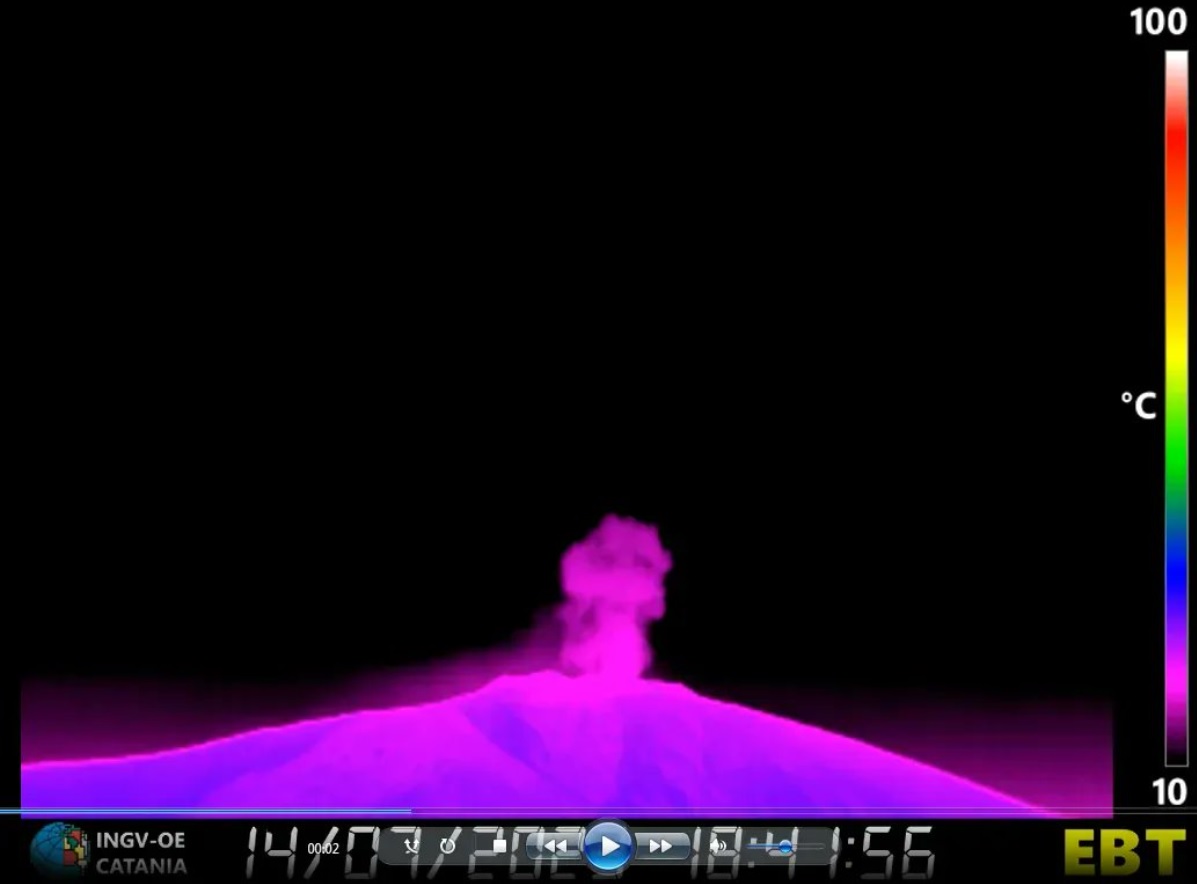
Small strombolian explosion from the Etna's South-east crater on 14 July (image: INGV)
The explosive eruption of the volcano continues.
A minor strombolian-type explosion occurred from the South-east crater on 14 July at 18:41 local time. Ash emissions were dispersed into the atmosphere.
Source: Istituto Nazionale di Geofisica e Vulcanologia volcano activity update 16 Julu 2023Etna volcano, Italy: sudden ash eruption from SE crater this morning
Update Mon 10 Jul 2023 10:37
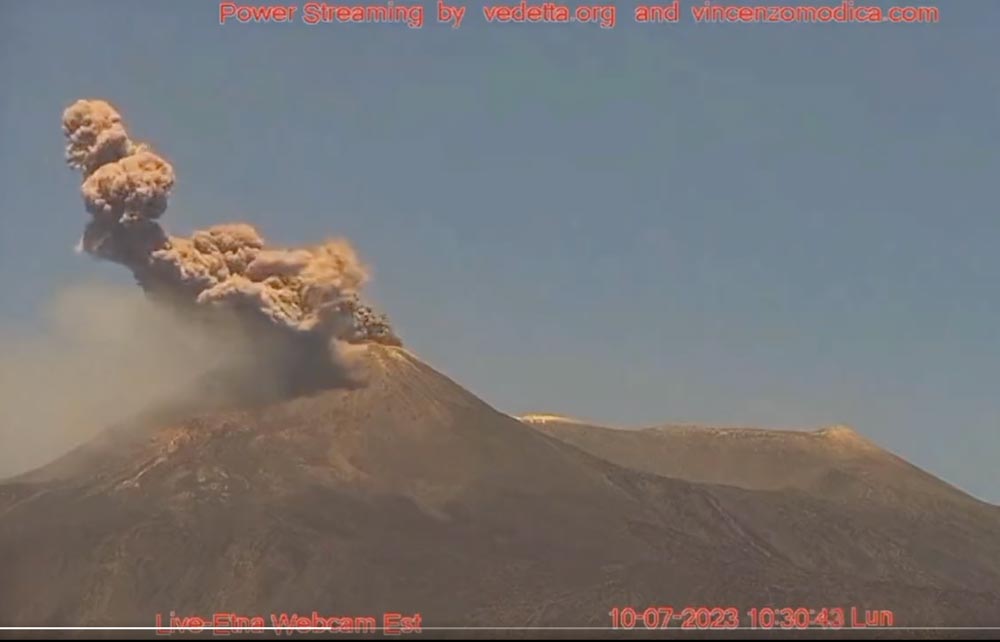
Ash eruption from Etna this morning (image: vendetta.org webcam)
While the volcano has been overall relatively calm during the past weeks, a sudden explosion occurred this morning from the southeast summit crater.
The eruption lasted about two minutes only and produced a dense brown ash plume that rose a few 100 meters and quickly dispersed to the southwest. No significant changes in volcanic tremor accompanied the event and there has been no official statement from the volcano observatory so far.
It is possible that the event did not involve any fresh magma and was driven purely by an internal phreatic explosion as trapped water can interact with hot rocks or residual magma inside the conduit.
We would like to show you embedded content from X/Twitter. If you like to see this content, please make sure you agree with the
privacy policy of X/Twitter and click the button:
View embedded content from X/TwitterEtna volcano (Sicily, Italy): minor strombolian explosion last night
mer., 24 mai 2023, 05:41 05:41 AM | AUTEUR : MARTIN
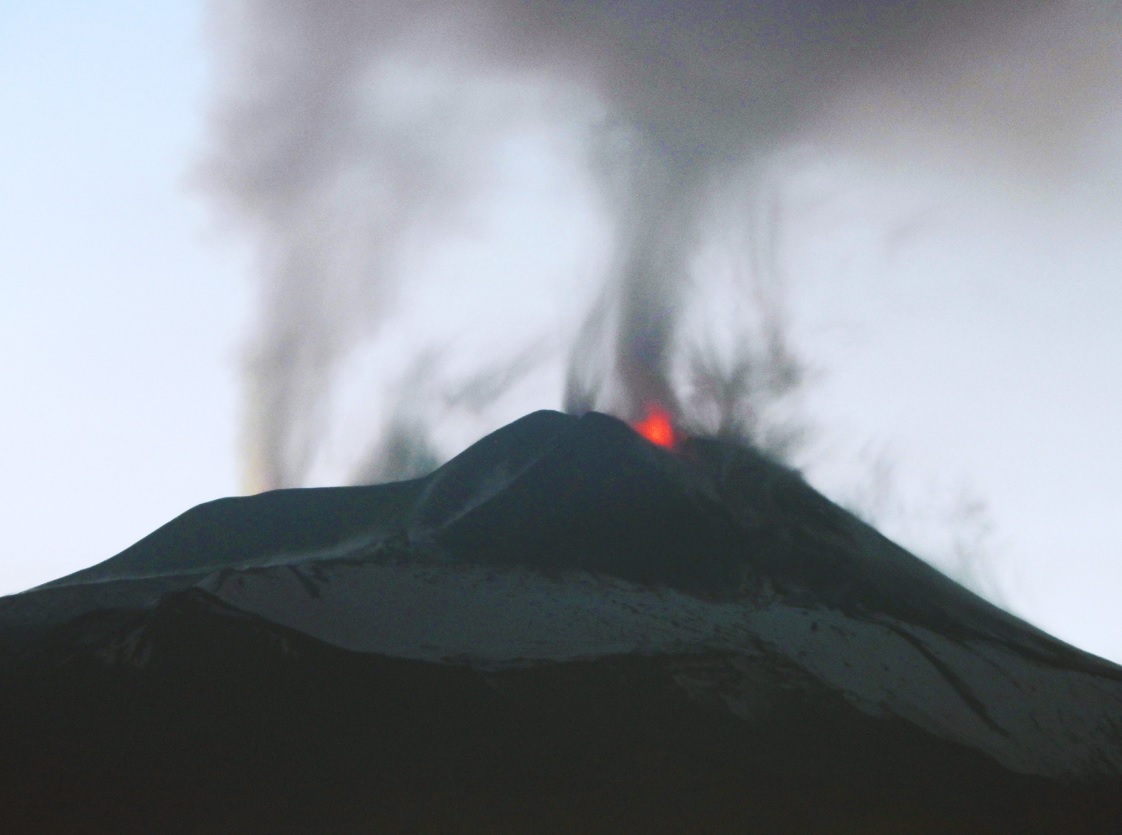
Glowing SE Crater as seen from Tremestieri Etneo on the evening of 23 May (image: Boris Behncke)
The activity at the volcano continues at low-to-moderate levels since the recent paroxysm episode ceased on 21 May.
A mild strombolian eruption appeared from the Southeast Crater at 01:53 local time last night, the National Institute of Geophysics and Volcanology reported. Ash emissions drifted towards the northeast direction.
The ongoing night-time glow is well visible from the Voragine Crater, as well.
The tremor's tendency shown elevated periods of amplitude in average over the past couple of hours. The tremor has been located beneath the Southeast Crater at an altitude 2800 meters.
Infrasound activity continues at moderate values, localized between the Voragine and Bocca Nuova craters.
Source: Istituto Nazionale di Geofisica e Vulcanologia volcano activity update 24 May 2023Etna volcano (Sicily, Italy): new series of paroxysm, lava flow from SE Crater and ash to 23,000 ft yesterday
lun., 22 mai 2023, 07:23 07:23 AM | AUTEUR : MARTIN
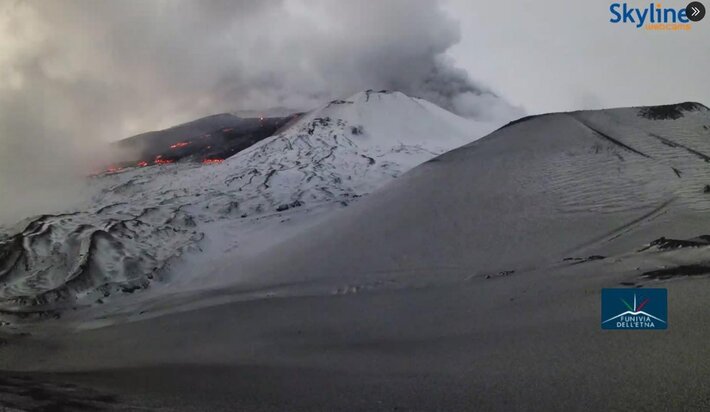
The new lava flow showed up traveling down the western flank from the SE Crater as the sky got cleared out (image: Il Mondo dei Terremoti)

The thermal image of the lava flow (image: INGV)
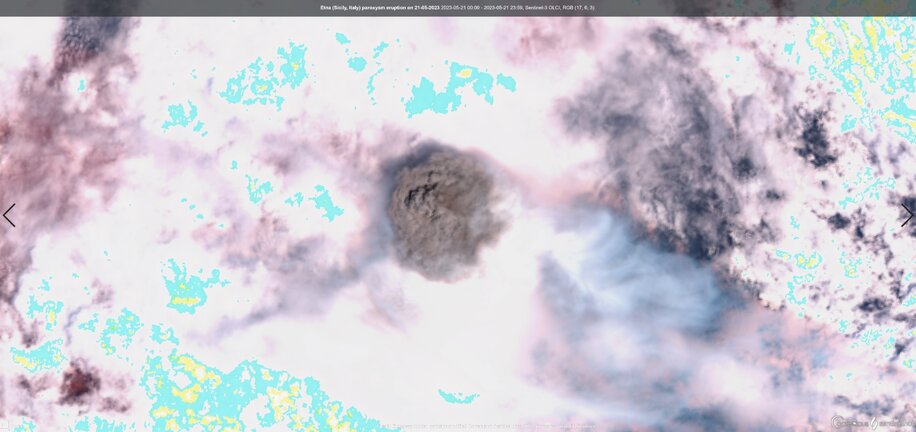
The large ash column from paroxysm eruption yesterday as detected by the satellite from space (image: Sentinel-3)
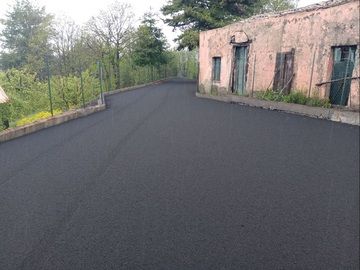
Ash-lapilli-affected road from the eruption (image: Boris Behncke)
The unstable activity at the volcano continues over the past two weeks or so.
A new lava-fountaining episode (likely to be classified as paroxysm) took place from the Southeast Crater yesterday. Visibility of the eruptive phase was very limited due to dense clouds, but the Sentinel-3 satellite detected a huge grey ash plume showing an umbrella region as the top of the column. The Volcanic Ash Advisory Center Toulouse (VAAC) reported spewing ash to an estimated 7 km altitude drifting towards the SW (INGV).
Following the paroxysm eruption, a new lava flow started to overflow the Southeast Crater's rim and descend over the western flanks. Due to poor weather conditions, the lava flow front's current position was impossible to detect then. Later on, the observatory's thermal surveillance cameras could catch glimpses of the lava flow.
Preceded to the eruption, the INGV (National Institute of Geophysics and Volcanology) recorded another sharp spike in tremor at 05:20 local time yesterday. High values of amplitude ground vibrations continued by 09:35 local time when it decreased rapidly to average medium levels. The activity stabilized at about 10:00 local time. The tremor has been located beneath the Southeast Crater at an altitude 2500 meters. An infrasound analysis to localize an eruption corresponded to an area between the Voragine and Bocca Nuova craters.
Soon after the eruption, a moderately strong ash fall of lapilli scoria from the ongoing paroxysm occurred on the SW flanks. The eruption's plume affected the southwestern area of the volcano and caused to interrupt flights at Catania airport.
Source: Istituto Nazionale di Geofisica e Vulcanologia volcano activity update 22 May 2023Etna volcano (Sicily, Italy): rapid increase in tremor and minor eruption yesterday
ven., 19 mai 2023, 06:30 06:30 AM | AUTEUR : MARTIN
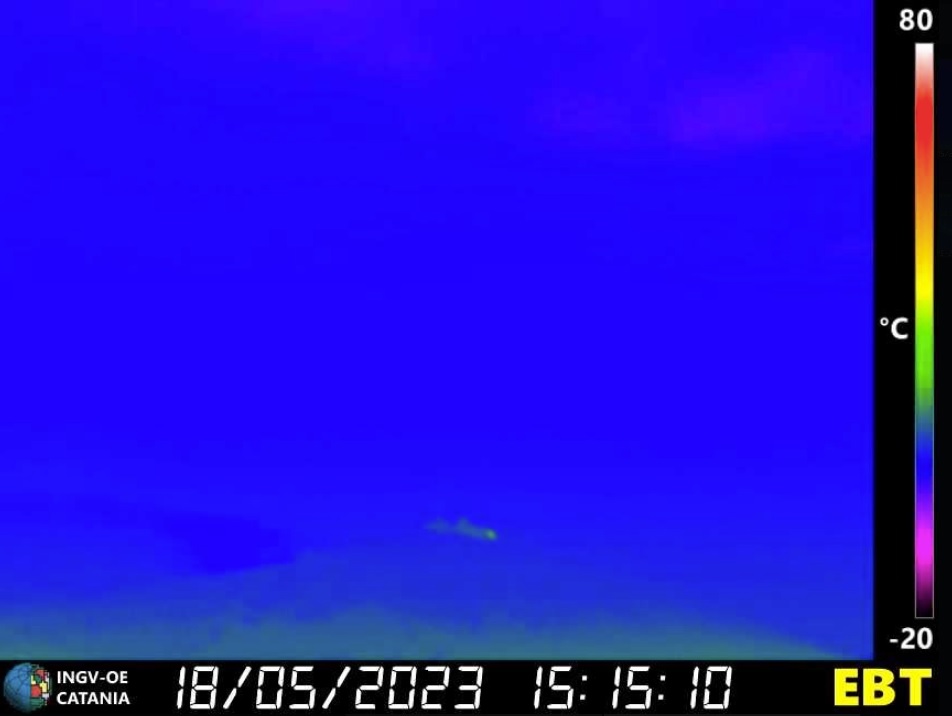
A minor explosion from Etna volcano at 15:15 local time yesterday following the elevated tremor (image: INGV)
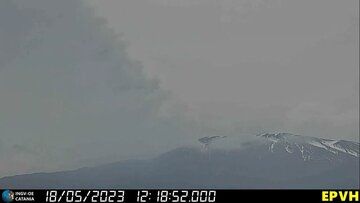
A degassing activity from Etna volcano yesterday (image: INGV)
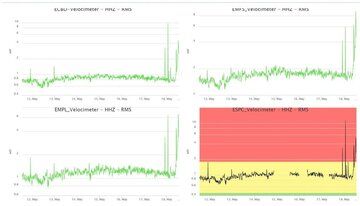
Sharp peaks and drops in volcanic tremor at the beginning of the activity, but generally has continued at high levels (image: INGV)
The INGV (National Institute of Geophysics and Volcanology) seismic network detected a rapid increase of continuous vibrations (so-called tremor) associated with a degassing at noon (12:10 local time) yesterday.
Volcanic tremor reached temporarily high values, indicating magma moving upwards through the volcanic conduits, and later on showed significant variations following a decrease to medium values. A sharp spike of high amplitude tremor returned back at 11:30 local time with an increasing tendency. The tremor has been located between the Bocca Nuova crater and the Southeast Crater at an altitude 2500 meters.
Moreover, a seismic crisis has continued to evolve from 14:44 local time.
A volcano-tectonic earthquake with magnitude M 1.9 was registered at 15:00 local time following a small explosive eruption at the same time.
No significant ground deformation was detected.
Local visibility was very limited due to dense clouds, which didn't allow scientists to observe the activity via surveillance cameras.
Source: Istituto Nazionale di Geofisica e Vulcanologia volcano activity update 19 May 2023Etna volcano (Sicily, Italy): small explosion from SE Crater yesterday
lun., 15 mai 2023, 07:34 07:34 AM | AUTEUR : MARTIN
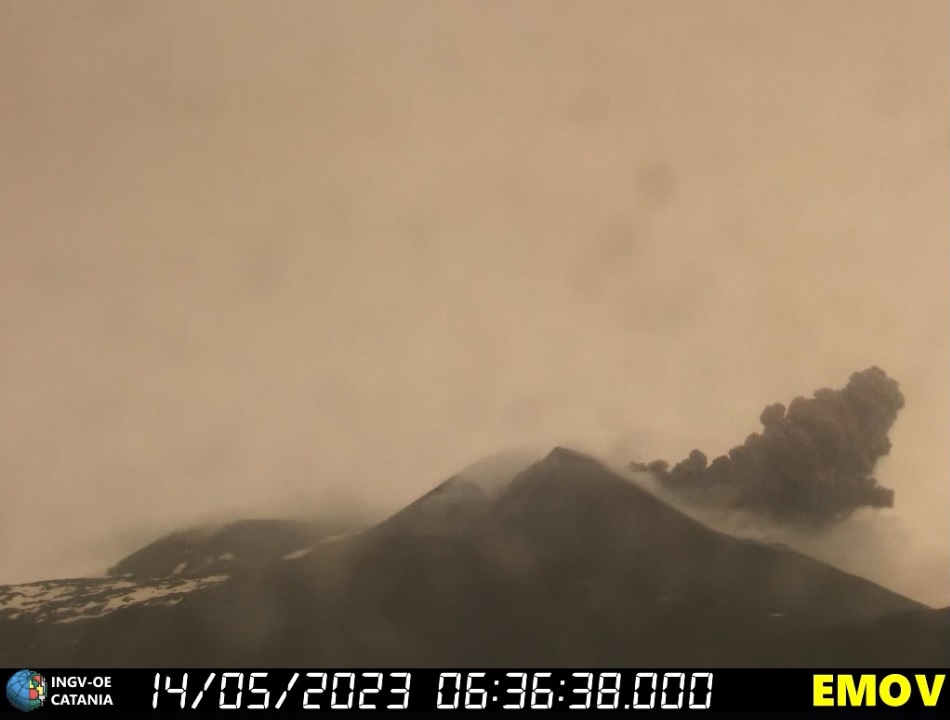
Small eruption from the SE Crater at Etna yesterday morning (image: INGV)
A sudden but minor explosion occurred from the Southeast Crater at 06:36 local time yesterday, the National Institute of Geophysics and Volcanology (INGV) reported.
Moderate ash emissions followed the eruption, which dispersed in the summit area.
Seismic recordings have not shown significant variations as the event had no detected precursor.
The volcano institute issued the end of the eruptive phase at 16:27 local time.
Source: Istituto Nazionale di Geofisica e Vulcanologia volcano activity update 15 May 2023Etna volcano (Sicily, Italy): minor eruption last night
dim., 7 mai 2023, 03:10 03:10 AM | AUTEUR : MARTIN
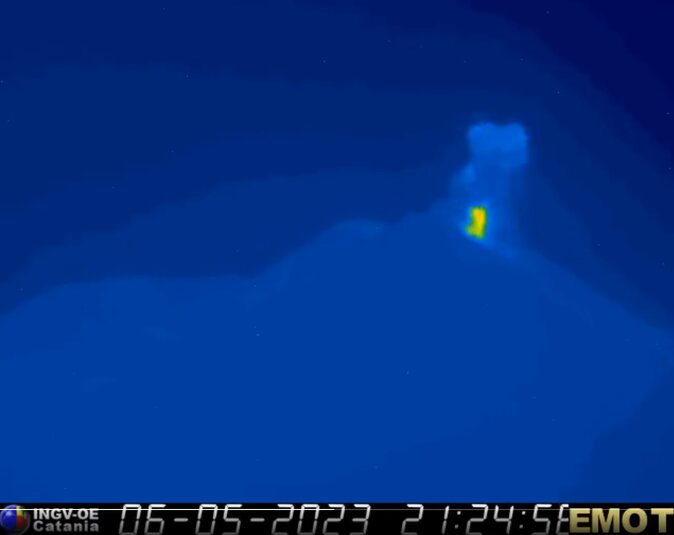
A small eruption from the SE Crater last night (image: INGV)
The National Institute of Geophysics and Volcanology (INGV) in Catania reported that an explosion occurred from the Southeast Crater at 22:04 local time last night.
The eruption generated a small amount of ash emissions.
A volcanic tremor remains at medium levels and has been detected at an altitude between 1500 and 2500 meters above sea level.
Source: Istituto Nazionale di Geofisica e Vulcanologia volcano activity update 7 May 2023 We would like to show you embedded content from X/Twitter. If you like to see this content, please make sure you agree with the
privacy policy of X/Twitter and click the button:
View embedded content from X/TwitterEffusive eruption officially declared to have ended
Update Wed 08 Feb 2023 11:24
The volcano observatory in Catania released a bulletin for aviation services (VONA) mentioning that the effusive eruption (lava flow) at the summit craters has ended.
The volcano still shows unrest above background, but no other particular activity. Ash emissions are negligible.
Lava flow activity has paused or ceased
Update Tue 07 Feb 2023 07:39

Etna's effusive activity last clearly seen two days ago (l) and no apparent activity this morning (r) from INGV Catania's webcam on the eastern flank
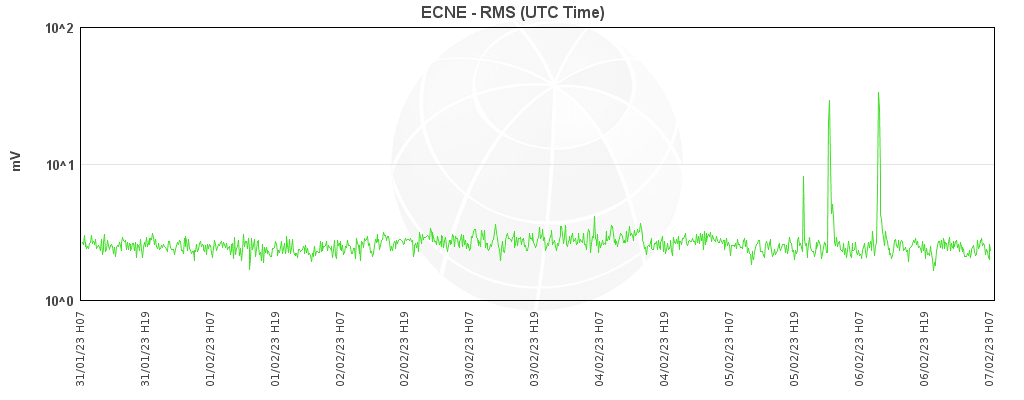
Current tremor amplitude (image: INGV Catania)
The effusive activity from the fissure vent on the eastern foot of the SE crater has been pausing for at approx. two days now.
It is uncertain whether it is another pause, longer than the shorter pauses in previous weeks, or the effective end of this eruptive phase that had been going on since late November last year. Volcanic tremor is at similar levels as during the past weeks, which could indicate that the ascent rate of magma inside the conduits hasn't changed significantly.
This in turn could favor a resumption of activity in the near future, but Etna (and volcanoes in general) is always unpredictable.
Etna volcano (Italy): effusive activity continues at fluctuating intensity
mar., 31 janv. 2023, 08:01 08:01 AM | AUTEUR : T
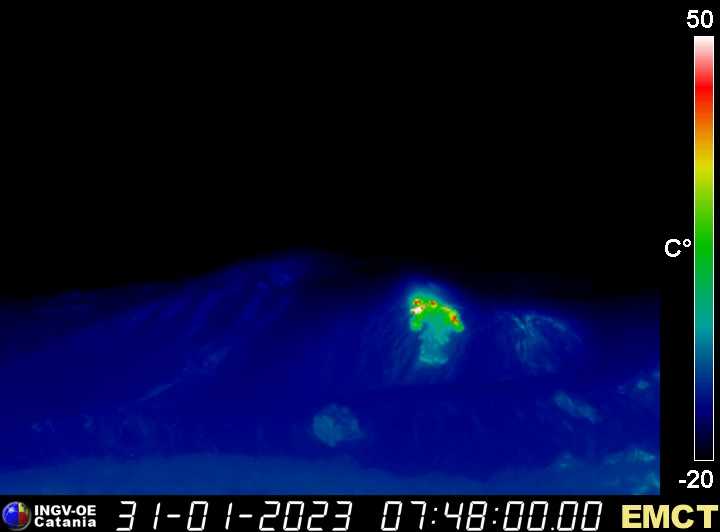
Thermal image Etna's summit area seen from the east, showing the SE crater complex and the effusive vents as of this morning (image: INGV Catania)
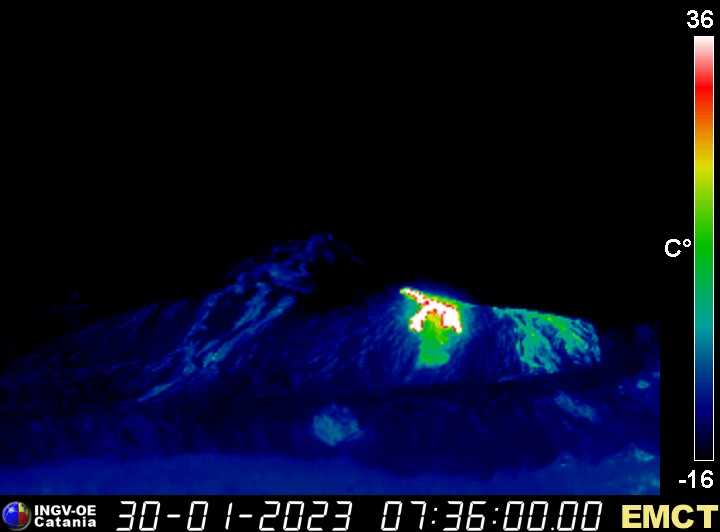
The same view yesterday showing two active lava flows from the fissure vent
The effusive activity from the vent at 2850 m elevation at the eastern base of the SE crater complex remains active, but fluctuates strongly. While several new lava flows were seen on the surface near the vent yesterday, only one of them can still be seen weakly alimented this morning.
Overall, there seems to be a slow change towards a possible reactivation of the SE crater itself. Sporadic explosions from its summit vent have been occurring more frequently during the past days and the thermal signal from the crater has increased. Whether and how long the effusive activity continues or gives way to a new phase of explosive activity from the summit vents is impossible to say, but a probably scenario for the near to medium-term future (days to weeks).
Lava flow active (again), new surface flow near vent
Update Wed 18 Jan 2023 08:10
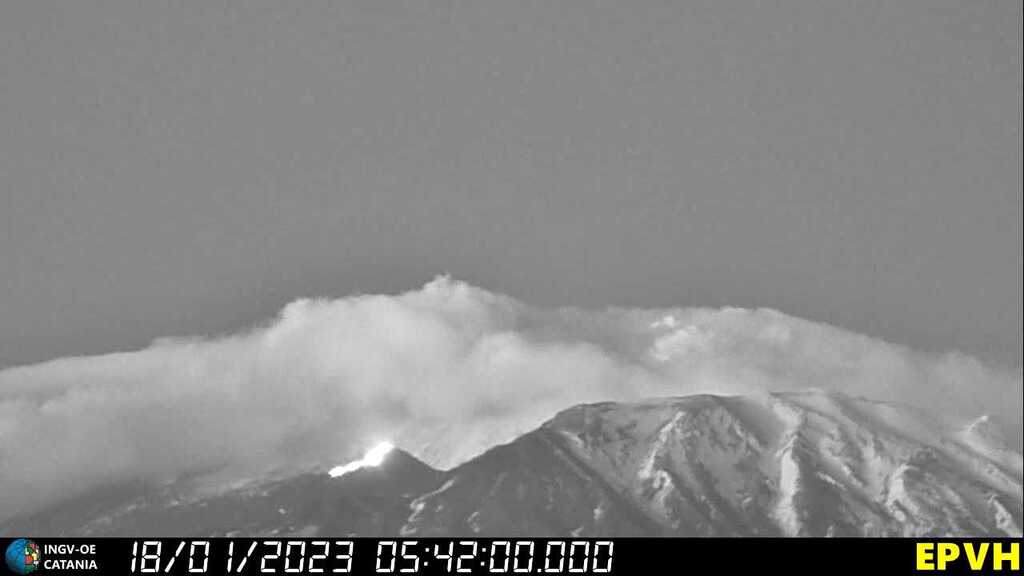
New surface lava flow from the effusive vent at the southern base of Etna's SE crater (image: INGV thermal webcam)
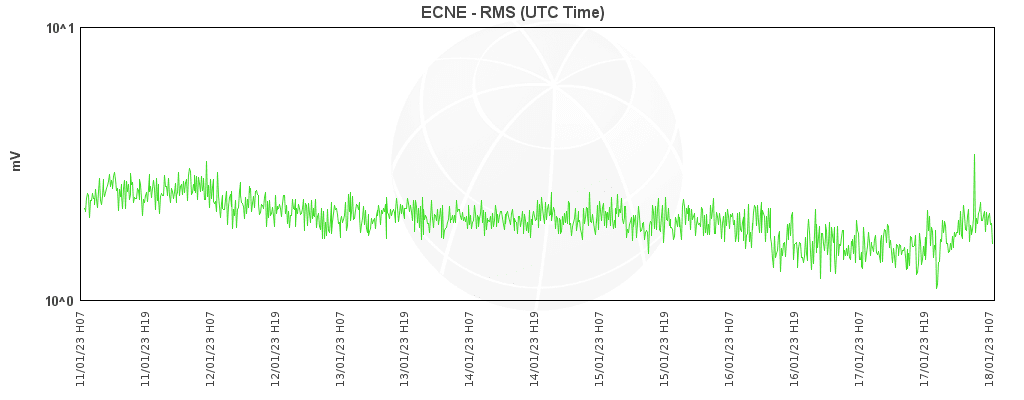
Tremor amplitude
The lava flow from the vent at the southern base of the SE crater is active again this morning, and a new lava flow has been advancing on the surface.
Webcam imagery indicates that this new surface flow started to advance from the vent during the early morning hours.
It is unclear whether it had completely ceased during a brief pause yesterday or whether it's activity had simply dropped significantly and now increased again, which is suggested by a bulletin of the volcano observatory mentioning that there was a lava flow in the summit area yesterday afternoon.
In alignment with the visual impression of a temporary pause or drop in activity, the volcanic tremor has risen again today as well.
Lava flow seems to have stopped
Update Tue 17 Jan 2023 12:08
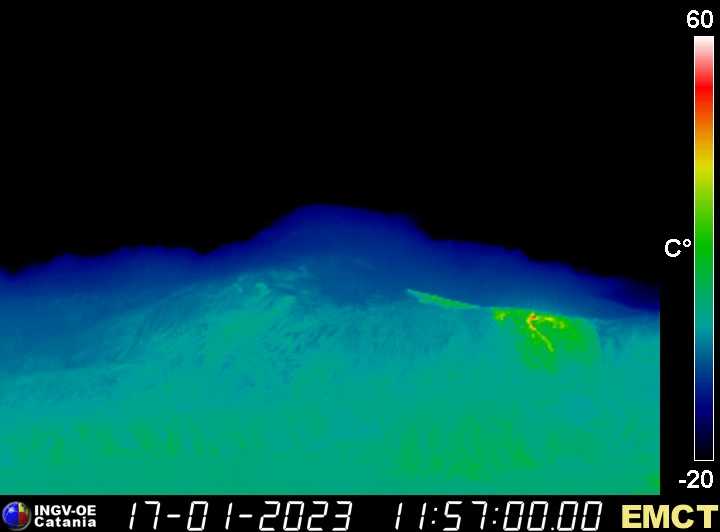
Thermal webcam view of the (now cooling) lava flow as of 17 Jan 2023; it seems no longer active (image: INGV Catania thermal webcam)
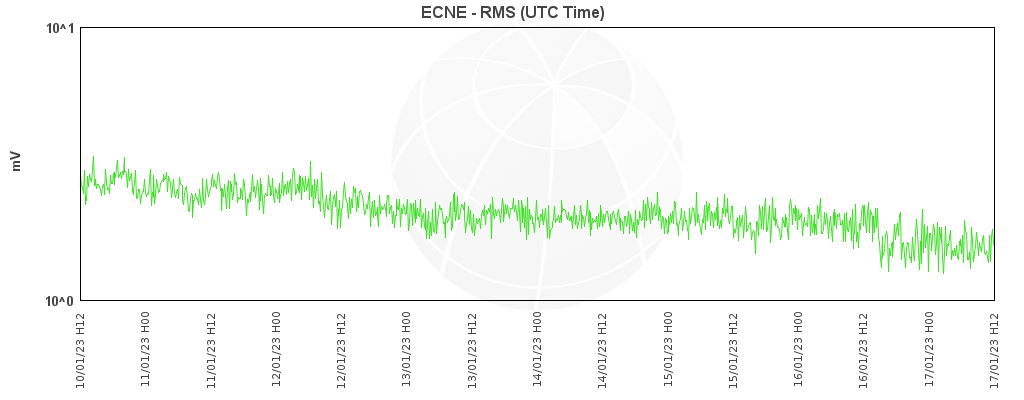
Volcanic tremor ECNE station (image: INGV Catania)
According to webcam imagery and the impression of one of our friends, mountain guide on Etna, the lava flow at the southern base of the SE crater has likely stopped. We still wait for official confirmation.
However, the recorded volcanic tremor has dropped as well during the past 24-48 hours, suggesting that this is likely indeed the case, thus marking the end of the most recent effusive episode that had started in late November last year.
Etna volcano (Sicily, Italy): eruption continues with lava flow
ven., 13 janv. 2023, 04:30 04:30 AM | AUTEUR : MARTIN
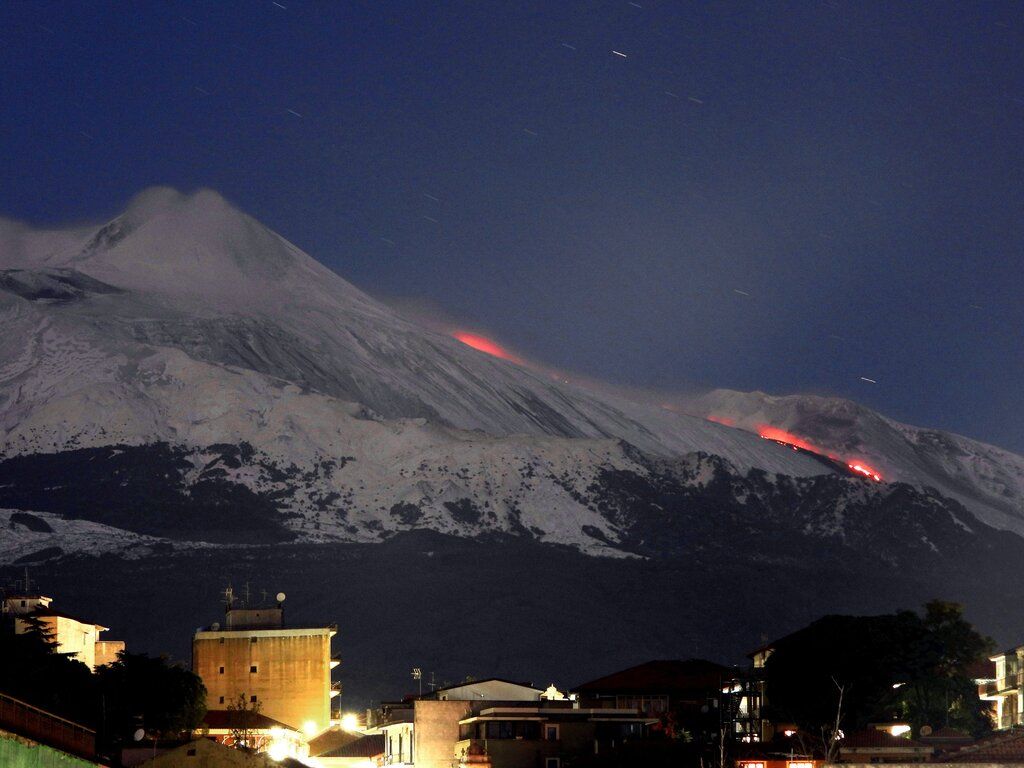
Glowing steam from the lava flow travelling down the slope (image: Boris Behncke)
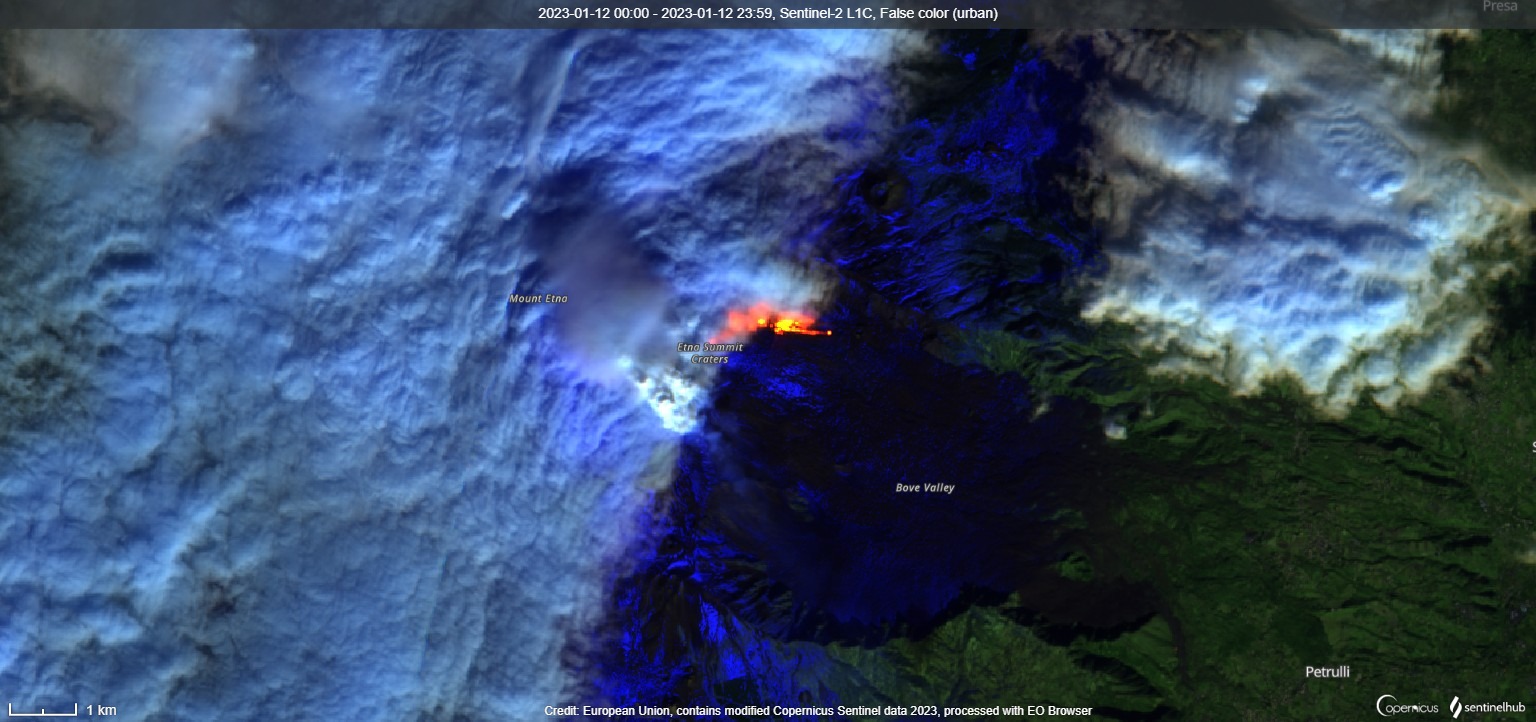
A false-colour satellite image of Etna and its current active lava flow visible from space (image: Sentinel 2)
The effusive eruption at the volcano continues.
The lava flow on the northeastern flank of the SE crater remains active, spilling out from the fissure at 2800 meters elevation.
You may watch amazing drone footage of the lava flow
here.Near-frequent degassing continues at the SE crater by only "venting" of gas and water vapor emissions.
Astonishing video of ice being thrown into the molten lava rock (source: Etna Walk)
Etna volcano (Sicily, Italy): outpouring lava flow
mar., 3 janv. 2023, 09:52 09:52 AM | AUTEUR : MARTIN
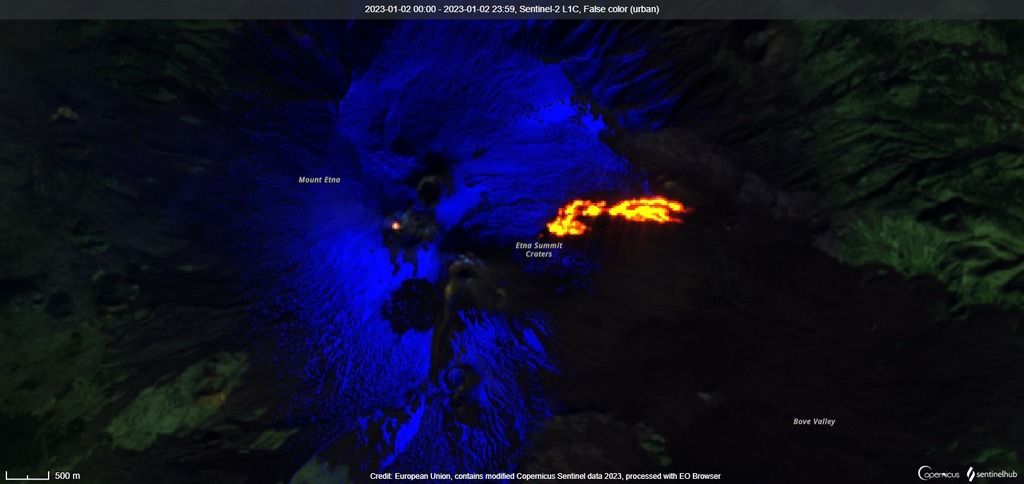
The oozing lava flow from the eruptive vent on the NE flank of the SE crater (image: Boris Behncke)
The moderate effusive eruption at the volcano continues and has remained essentially unchanged since 27 November.
The lava flow continues to be active on the northeastern flank of the SE crater and slowly advancing from the eruptive fissure vent.
Near-frequent degassing continues at the SE crater by only "venting" of gas and water vapor emissions.
Etna volcano (Sicily, Italy): continuing lava flow
mer., 30 nov. 2022, 13:29 13:29 PM | AUTEUR : MARTIN
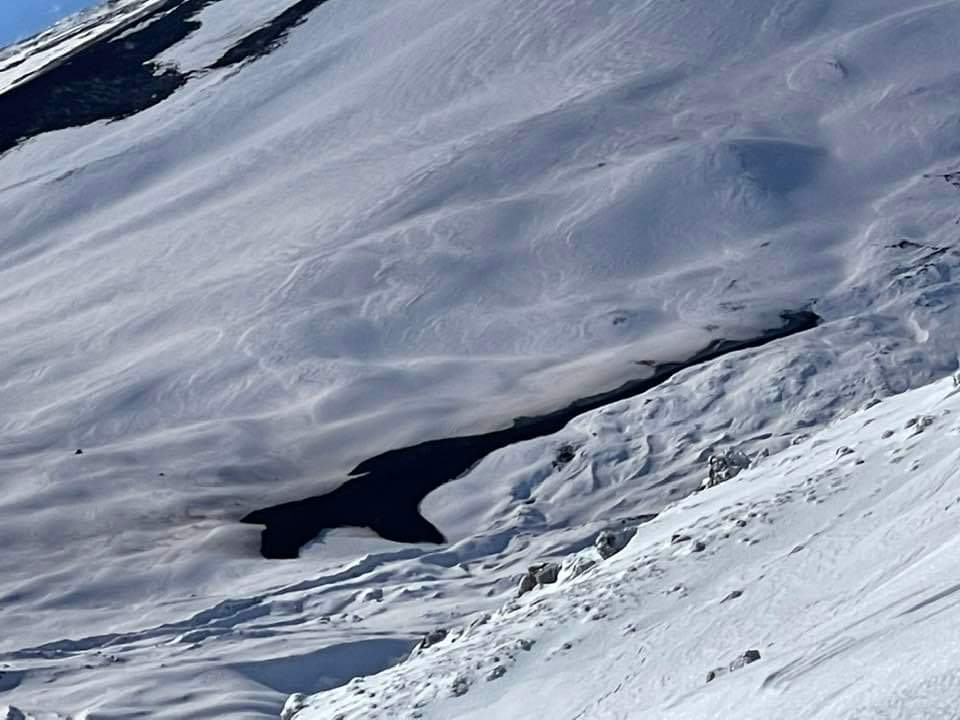
Short lava flow on the northeastern flank of the SE crater (image: Etna News)
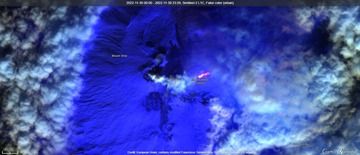
Satellite image showing the thermal anomaly at Etna today (image: Sentinel 2)
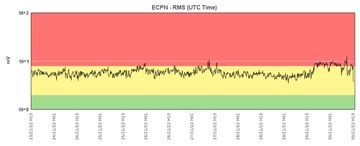
Fluctuating values of the tremor on 29 and 30 Nov at the volcano (image: INGV)
The effusive eruption at the volcano continues at fluctuating intensity.
The small lava continues to ooze out from the vent onto the northeastern flank of the SE crater at a slow rate and has advanced only a few hundred meters into the Valle del Leone over the past two days.
The seismic data showed an increased tremor to high levels on 29 November including a period of medium values today. This varying trend continues at the time of this update. The volcanic tremor is located in the area between the Southeast Crater and the Bocca Nuova Crater at an altitude between 2000 and 2600 meters.
Source: Istituto Nazionale di Geofisica e Vulcanologia volcano activity update 30 November 2022Etna volcano (Sicily, Italy): new fissure vent opened on SE crater
lun., 28 nov. 2022, 06:56 06:56 AM | AUTEUR : MARTIN
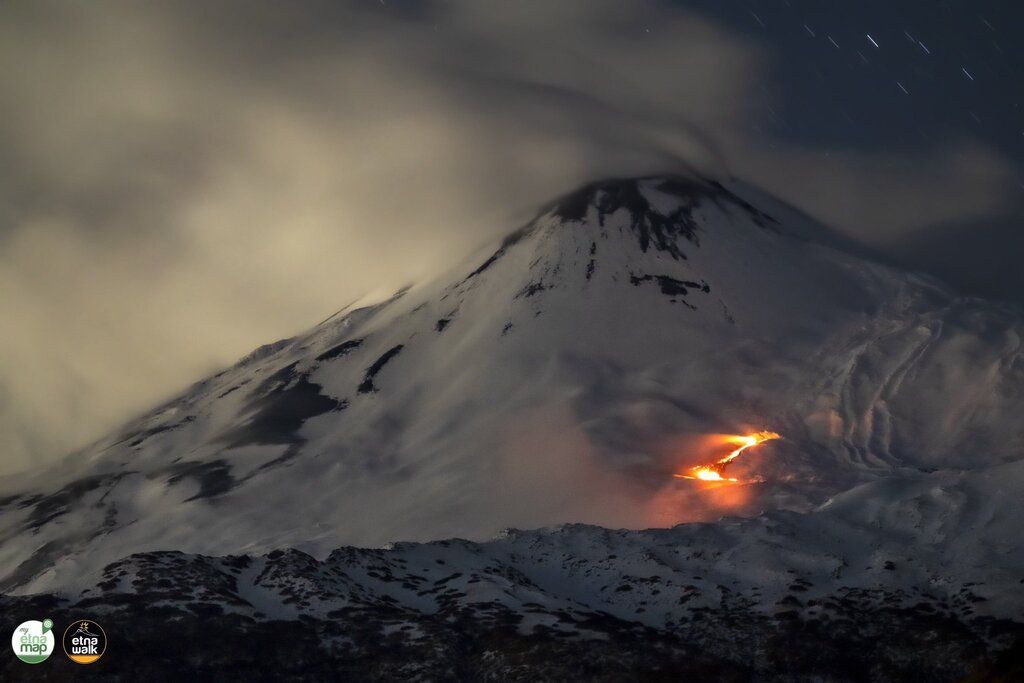
Vividly glowing new lava flow on the snow on the SE crater of Etna (image: @etnawalk/twitter)
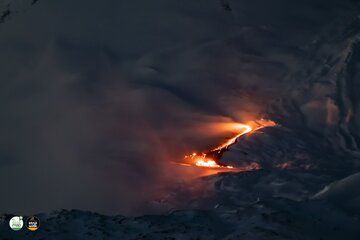
New eruptive fissure on the northeastern flank of the SE crater (image: @etnawalk/twitter)
The Istituto Nazionale di Geofisica e Vulcanologia (INGV) reported that a new eruptive fissure opened at the volcano yesterday.
The new fissure vent is located on the northeastern flank of the SE crater at an altitude of approx. 2800 meters. The vent has been producing a small lava flow descending down the Valle del Leone valley.
Etna itself is currently snow-covered and contact with the lava flow may likely cause an explosion of steam and water, i.e., steam driven only, caused by overheated water flashing to steam.
Prior to the eruption, a typical rise of volcanic tremor to high values has been detected, indicating moving magma upwards through the volcanic conduits. Consequently, it decreased again to medium levels and it still continues like that at the time of this update.
Source: Istituto Nazionale di Geofisica e Vulcanologia volcano activity update 28 November 2022Etna volcano (Italy): period of relative calm continues, but for how long?
ven., 4 nov. 2022, 15:55 15:55 PM | AUTEUR : T
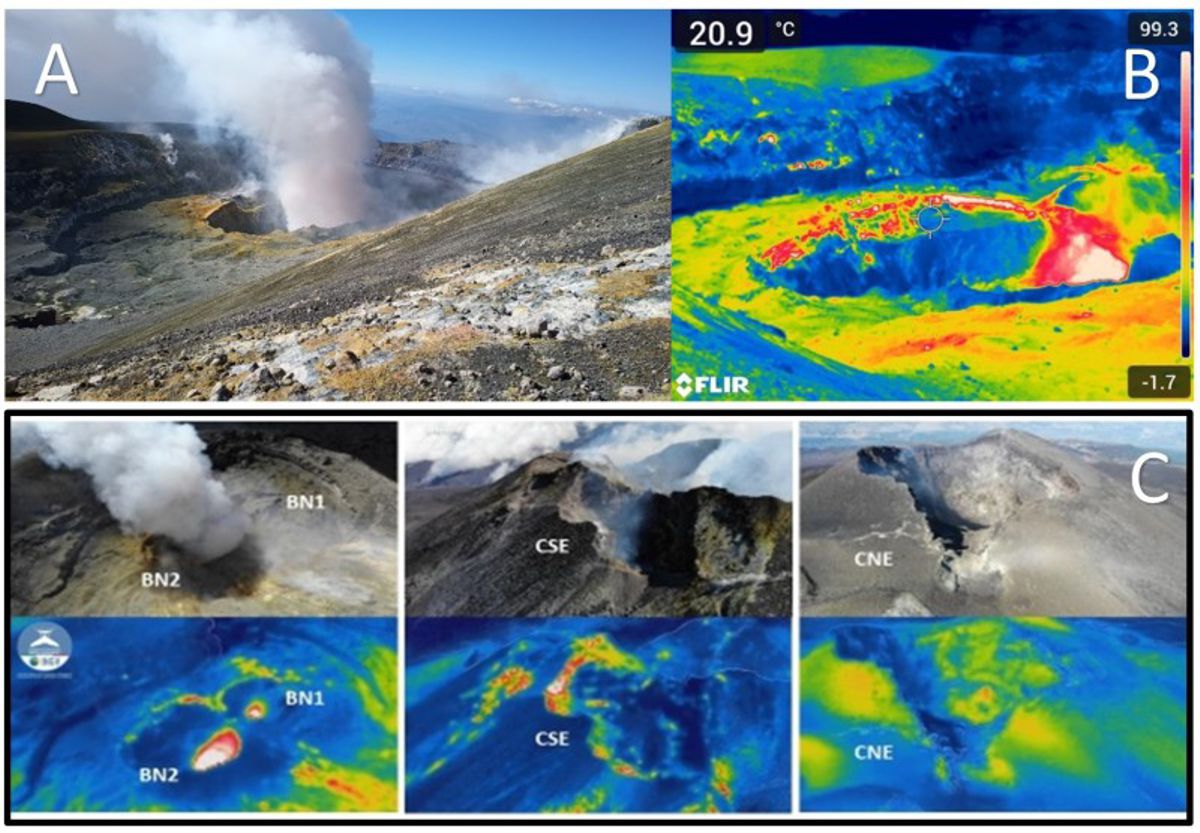
Visual and thermal images of Etna's Bocca Nuova, Central and NE craters in Oct 2022 (image: INGV Catania)
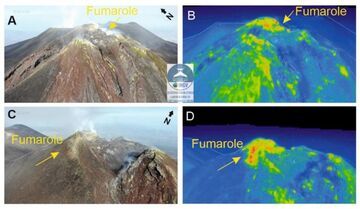
Visual and thermal images of Etna's SE crater complex in Oct 2022 (image: INGV Catania)
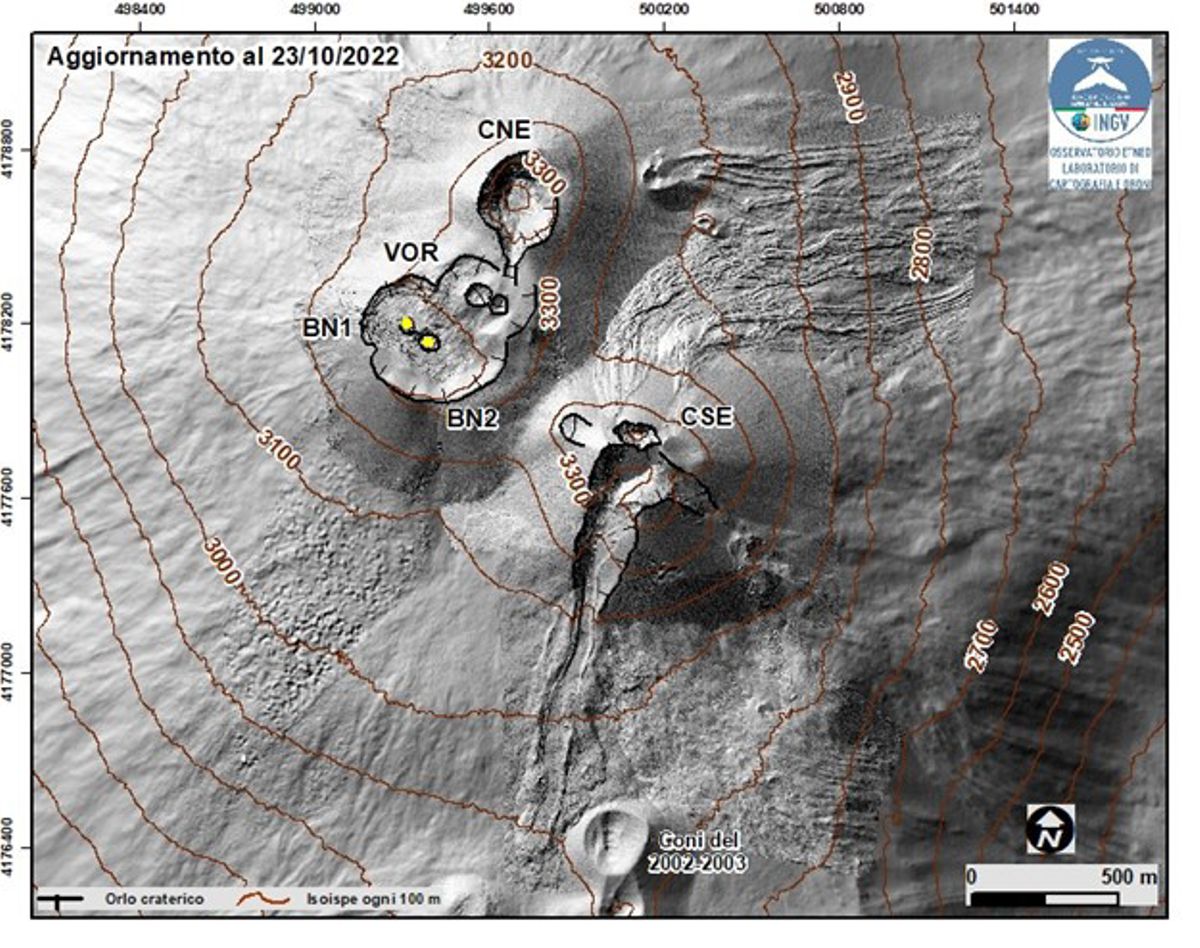
Map of Etna's summit craters as of 23 Oct 2022 (image: INGV Catania)
During the past weeks and months, the volcano has remained relatively calm. Most monitored parameters (seismic, degassing, ground deformation etc activity) have not shown significant variations and are generally around low to moderate levels, typical for most intervals between eruptive episodes.
A slow trend of inflation continues to persist of the edifice, likely reflecting magma accumulation inside the storage areas of the volcano.
The latest monthly summary of the volcano observatory INGV in Catania summarizes the activity as follows:
1) Summit craters show degassing activity at variable intensity, most notably from the western vent in the Bocca Nuova crater, which produces puffing events with audible roars reflecting deep-seated explosions. When observed from the crater rim last week, we could not see ash or solid ejecta leaving the vent.
2) Seismic activity has been overall low, with medium tremor levels.
3) Infrasound (reflecting internal explosive degassing events) has been fluctuating strongly.
4) Ground deformation continues as slow, gradual swelling of the edifice.
5) Degassing from vents and fumaroles, as well as diffuse soil emissions, have been at average levels. Helium isotope ratios have increased to high values compared to the previous month of September 2022. This likely reflects fresh magma at depth.
6) Satellite observations only show low thermal activity at the summit vents.
Overall, the current period of calm is likely not to last very long although it is impossible to predict how long it will take until a new eruptive phase starts again.
---
Source:
Lava effusion stopped
Update Sun 19 Jun 2022 19:51
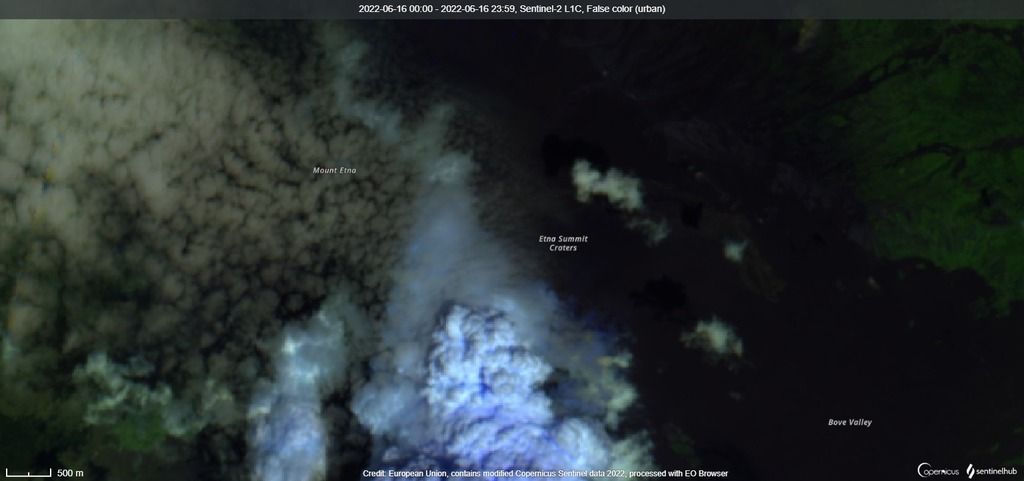
No thermal anomalies detected in the satellite image from 16 June (image: Sentinel 2)
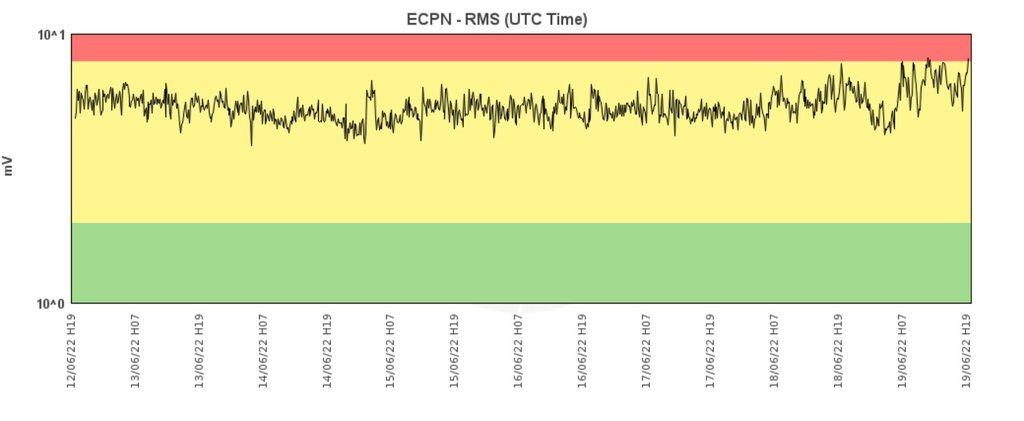
The volcanic tremor continues at medium values (image: INGV)
It seems the effusive activity at Etna ceased, at least according to the latest satellite imagery on 16 June.
This was later confirmed by the National Institute of Volcanology in Catania (INGV) as well, the fissure vent at 1900 m altitude stopped some time during the night between 15 and 16 June, another ones at 2850 and 2730 m elevation ended on 13 June.
The volcanic tremor continues at medium levels, located at 2,9-3 km altitude.
Source: Istituto Nazionale di Geofisica e Vulcanologia volcano activity update 19 June 2022New fissure vent opened in Serracozzo again
Update Mon 13 Jun 2022 04:21
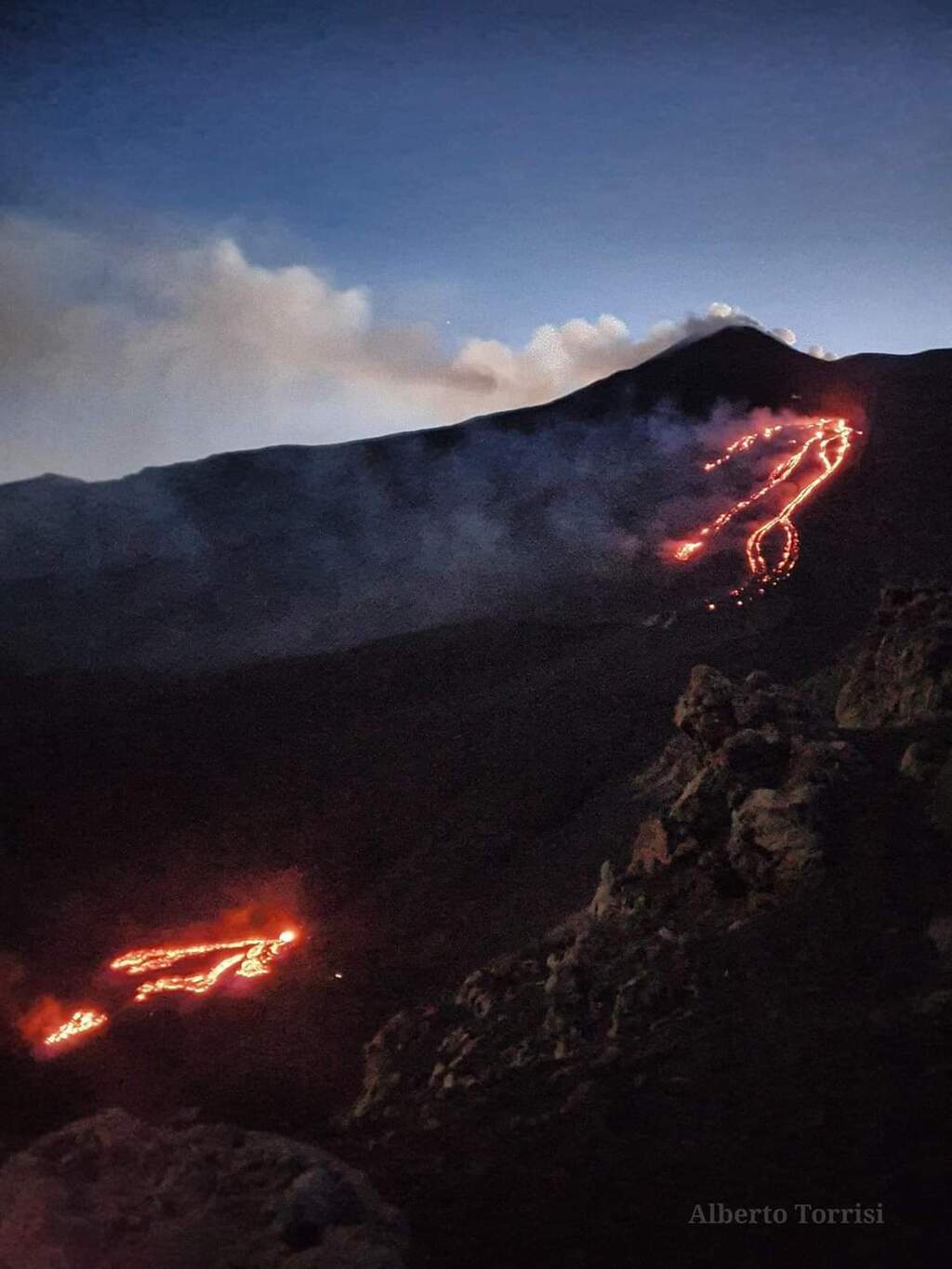
New eruptive fissure from yesterday (left bottom), continuing fissure vents from 29 May (upper right) (image: Alberto Torrisi)
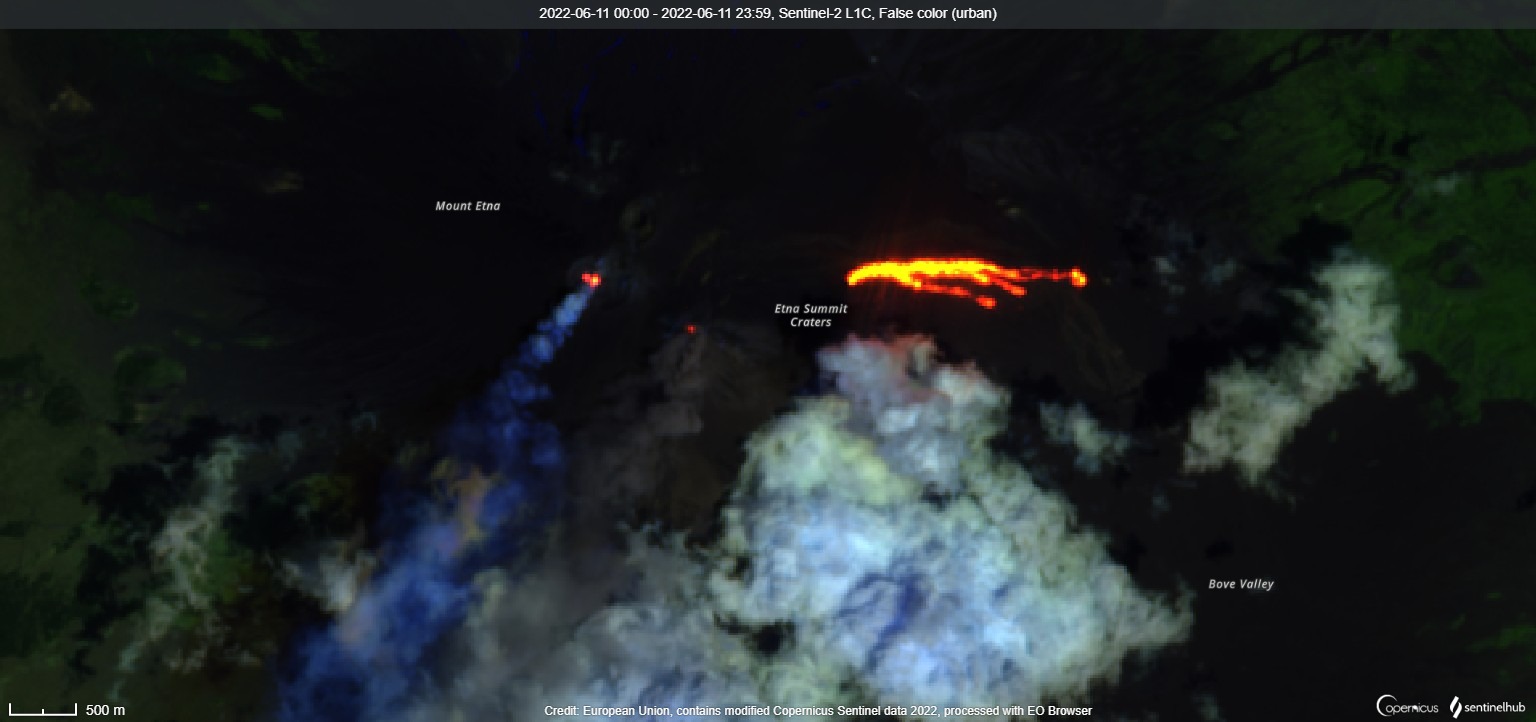
Eruptive summit activity associated with lava effusion at Etna visible from satellite (image: Sentinel 2)
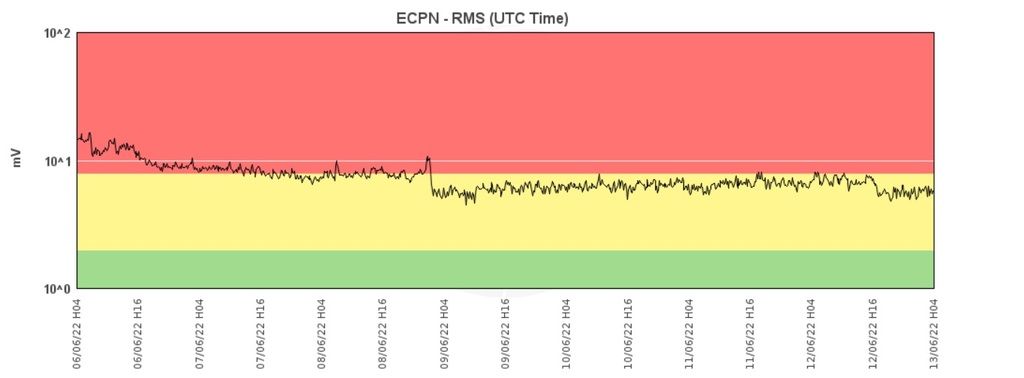
The volcanic tremor continues at medium-high values (image: INGV)
A new eruptive fissure opened in the northern wall of Valle del Bove yesterday.
The new vent is situated in Serracozzo area at 1900 m altitude, in the close vicinity of the latest, already ceased fissure vent erupted on
7 June.
A new, poorly-supplied lava flow started to emerge from the vent slowly advancing a few tens of meters further.
Fissure vents, located at 2850 and 2730 m elevation, continue to feed lava on the Southeast crater sliding down along the Valle del Bove.
Sporadic ash emissions continued at the Southeast crater today.
The volcanic tremor continues at medium levels, located at 2,9-3 km altitude.
Source: Istituto Nazionale di Geofisica e Vulcanologia volcano activity update 12 June 2022Lava flow eruption from SE crater continues, short lava spill out on N slope has stopped
Update Sat 11 Jun 2022 01:25
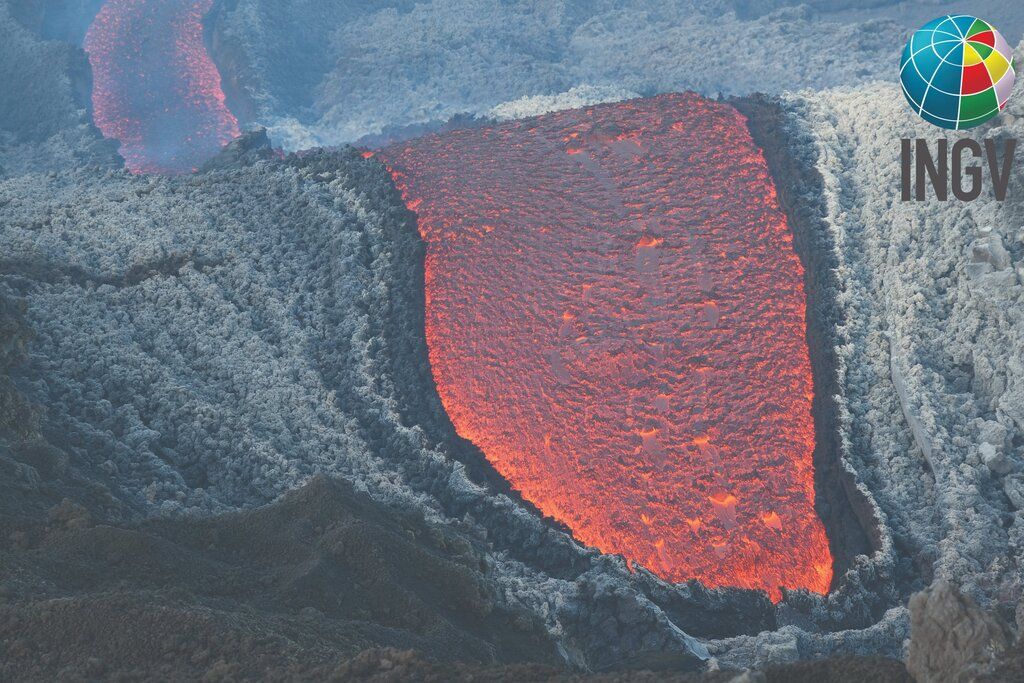
Runny lava flows over the slopes of the SE crater (image: INGV)
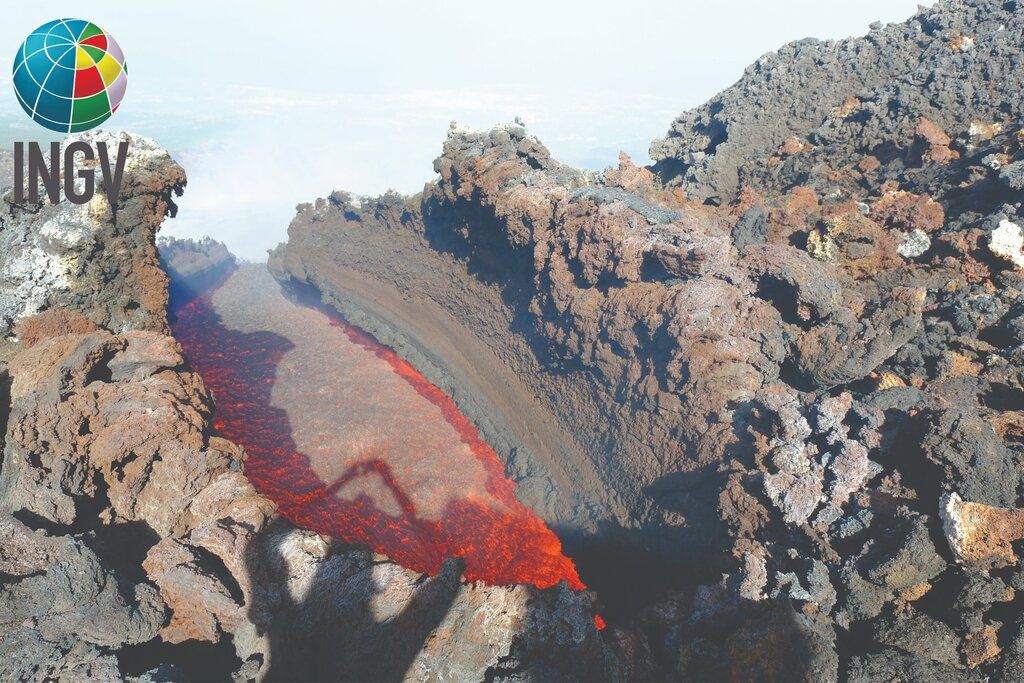
Runny lava forms chilled banks at the sides of the flow, so-called levee (image: INGV)
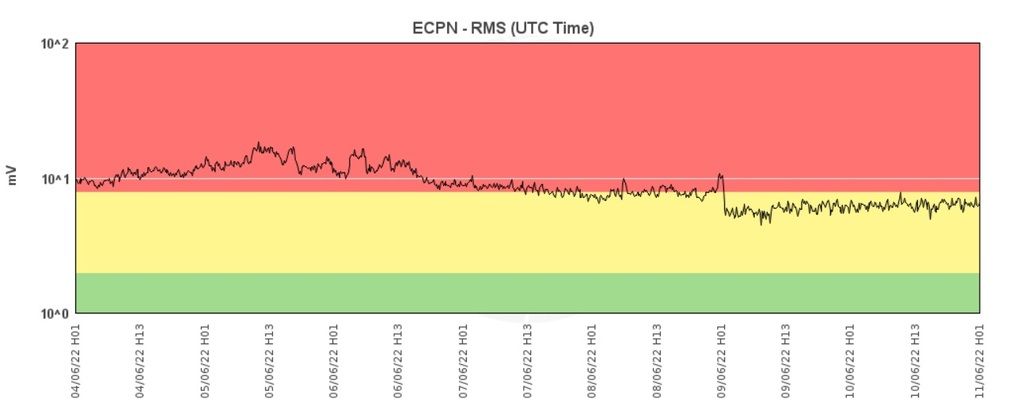
The medium-level tremor dominates at Etna now (image: INGV)
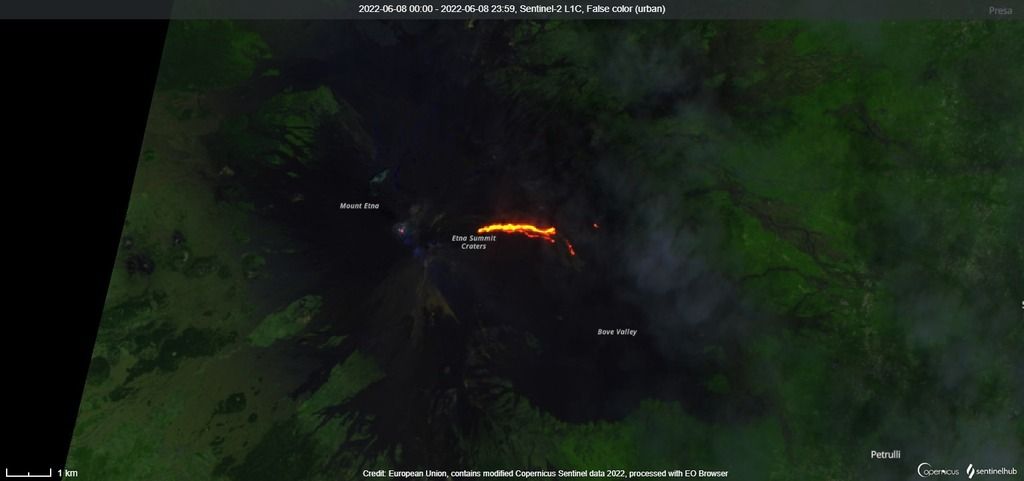
The satellite image depicts the active lava flow and the cooling lava on the N flank on 8 May (image: Sentinel 2)
The effusive activity at the volcano continues.
Fissure vents, located at 2850 and 2730 m elevation, continue to feed lava from the Southeast crater sliding down along the Valle del Bove.
The short lava flow on the northern flank of Valle del Bove from the evening of 7 June ceased some time during the next day on 8 June.
The volcanic tremor continues at medium values.
The lava flow on the N slope of Valle del Bove has been cooling off at a quick pace on 7 June (source: @INGVvulcani/twitter)
We would like to show you embedded content from X/Twitter. If you like to see this content, please make sure you agree with the
privacy policy of X/Twitter and click the button:
View embedded content from X/TwitterSmall short-lived lava flow started to quickly crystallize
Update Thu 09 Jun 2022 04:56
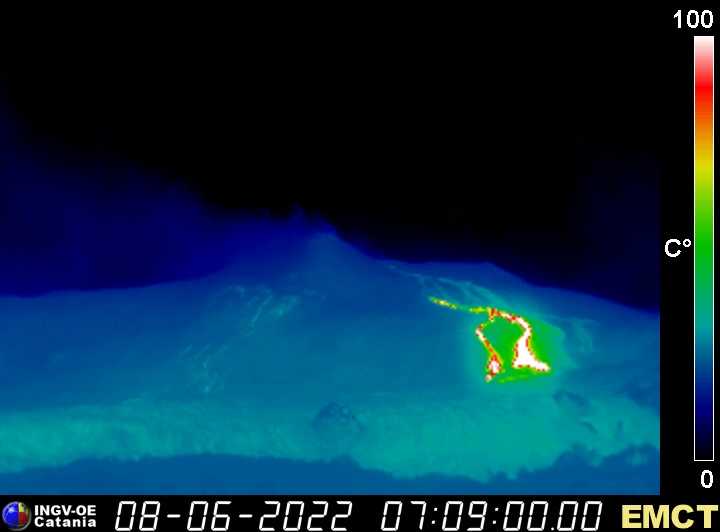
Thermal image of small lava flow from yesterday (image: INGV)
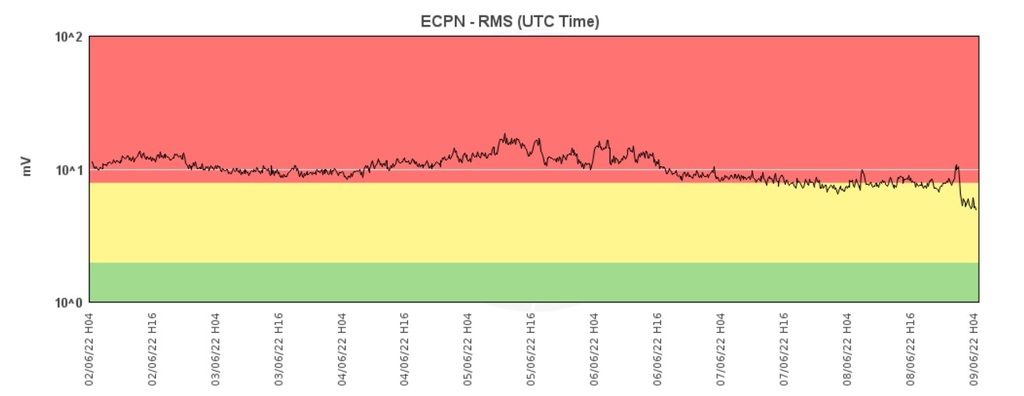
The volcanic tremor continues at medium-high values (image: INGV)
The effusive eruption at the volcano continues.
The new lava flow front has shortly increased since yesterday and has reached only about 170 meters distance from the fissure. Molten rock continues to cool off, meaning the crystallization process is now in progress at 1938 m elevation.
The National Institute of Volcanology in Catania (INGV) did GPS measurements to confirm the origin new fissure elevation point at 1979 m.
The volcanic tremor continues at medium-high values.
Source: Istituto Nazionale di Geofisica e Vulcanologia volcano activity update 8 June 2022New eruptive fissures opened today
Update Wed 08 Jun 2022 02:34
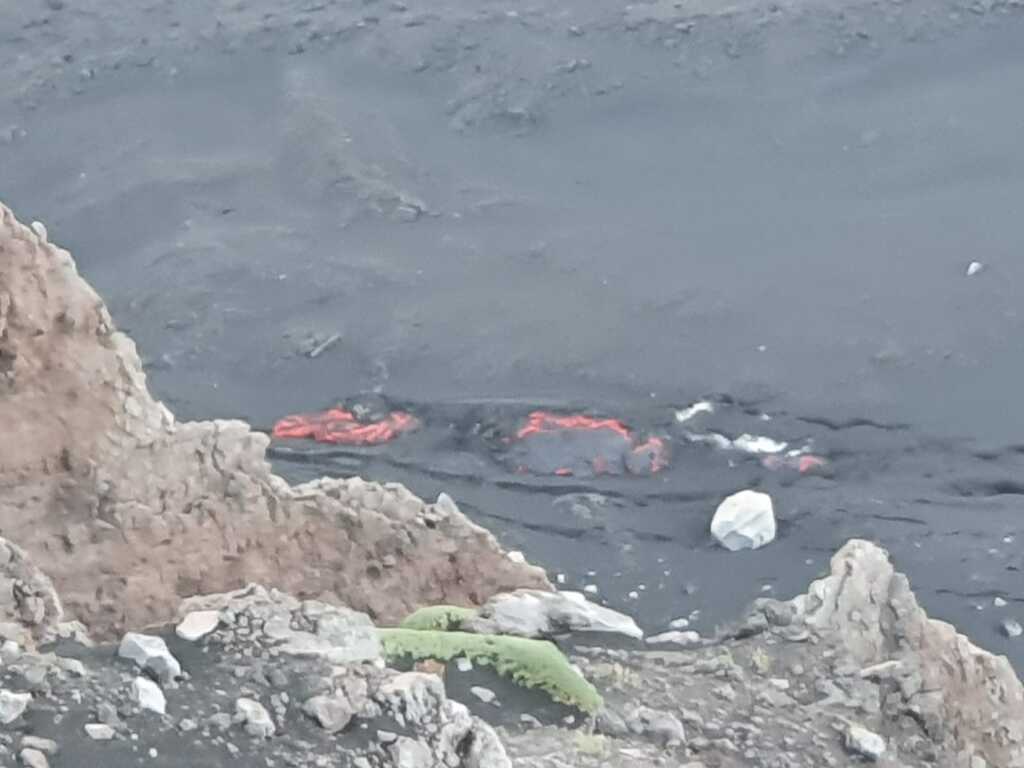
Two close-by fissures at the N slope of Valle del Bove today (image: INGV)
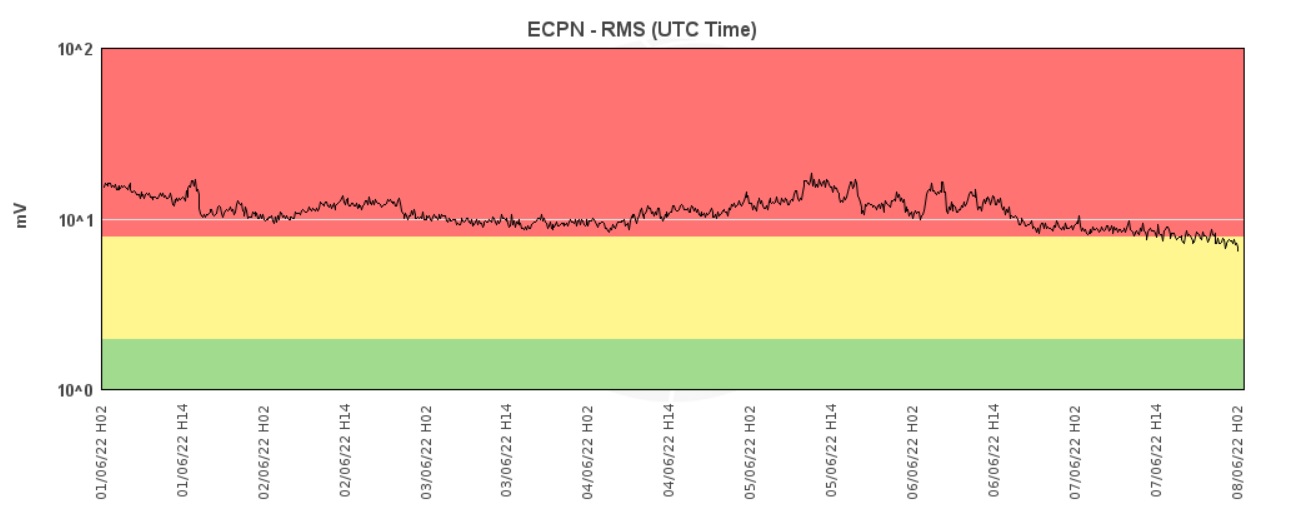
Tremor decreased to medium-high levels yesterday (image: INGV)
opened on the northern flank of Valle del Bove today.
It actually seems to consist of two close-by fractures, of which one started to erupt a small lava flow at altitude between 1900 and 1950 meters advancing a few tens of meters further.
The volcanic tremor decreased to medium-high values yesterday late afternoon, located at 2,9 km altitude.
Lava spill-outs from 29 May continue to keep flows active, currently about 700 m and 900 m long so far.
Source: Istituto Nazionale di Geofisica e Vulcanologia volcano activity update 7 June 2022Sustained ash-rich emissions today, decreased tremor stays at high values
Update Thu 02 Jun 2022 04:49
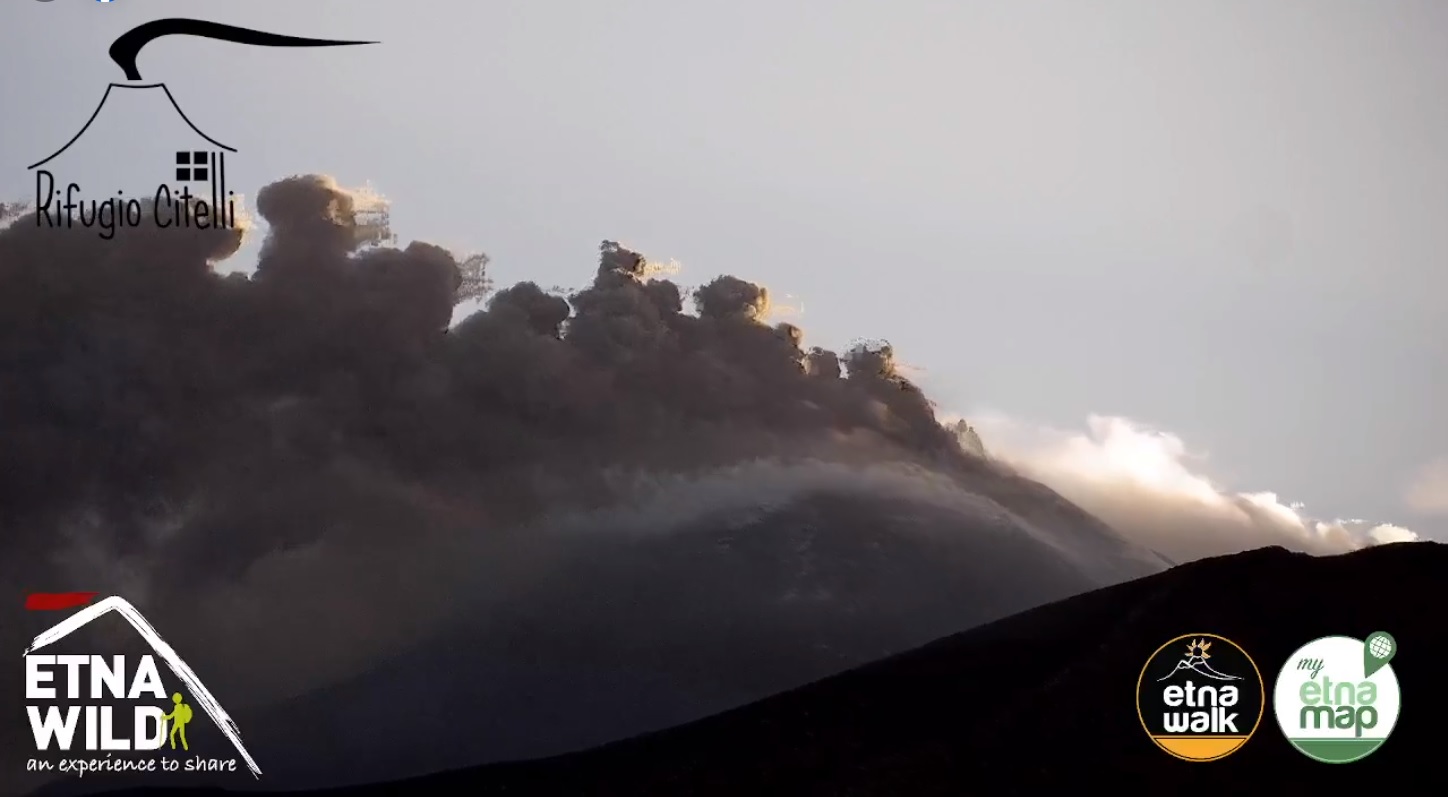
Constant dense ash emissions at Etna volcano this afternoon (image: Etna Walk)
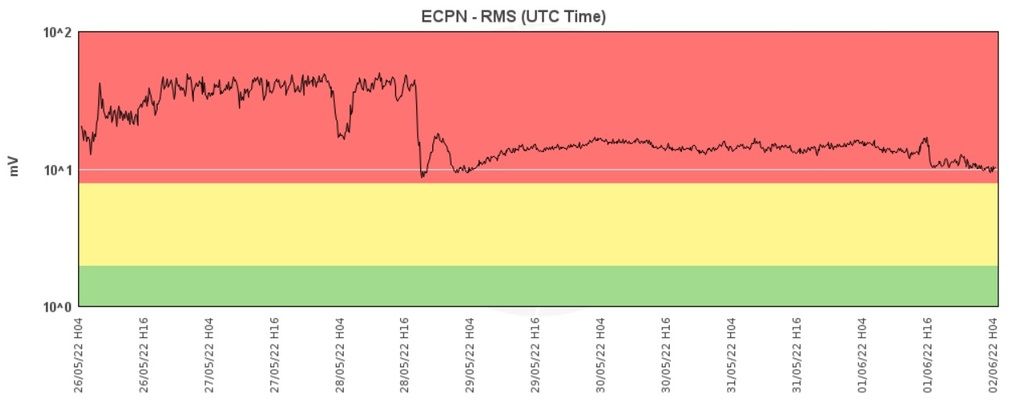
Stable tremor decreased at 16:00 today (image: INGV)
The National Institute of Volcanology in Catania (INGV) reported about emitting dense ash emissions from the Southeast crater started at about 17:00 local time.
Advancing lava flows have reached approx. 2100 m elevation today.
The internal volcanic tremor, currently located at 3000 m altitude, continued at stable levels until it started to decrease at 16:00 local time today, but still remains at high levels.
Source: Istituto Nazionale di Geofisica e Vulcanologia volcano activity update 1 June 2022Beautiful video of new lava flow from close
Update Tue 31 May 2022 02:26
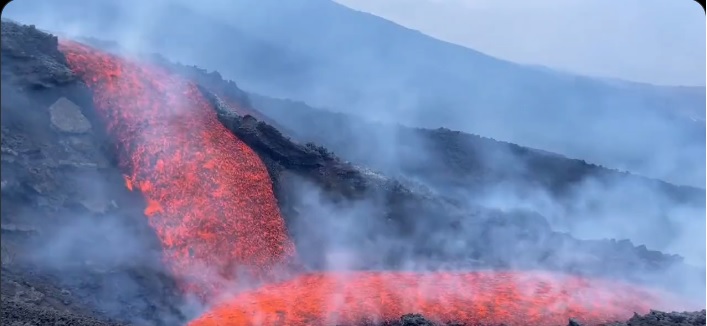
Screenshot from the video of the new lava flow at Etna volcano (image: Etna Guide)
Enjoy an impressive video of the new pāhoehoe-type lava flow from the close view that is being fed by two vents that opened yesterday.
We would like to show you embedded content from X/Twitter. If you like to see this content, please make sure you agree with the
privacy policy of X/Twitter and click the button:
View embedded content from X/TwitterEtna volcano (Italy): new lava flows from eastern flank vents continue at low intensity
lun., 30 mai 2022, 19:14 19:14 PM | AUTEUR : T
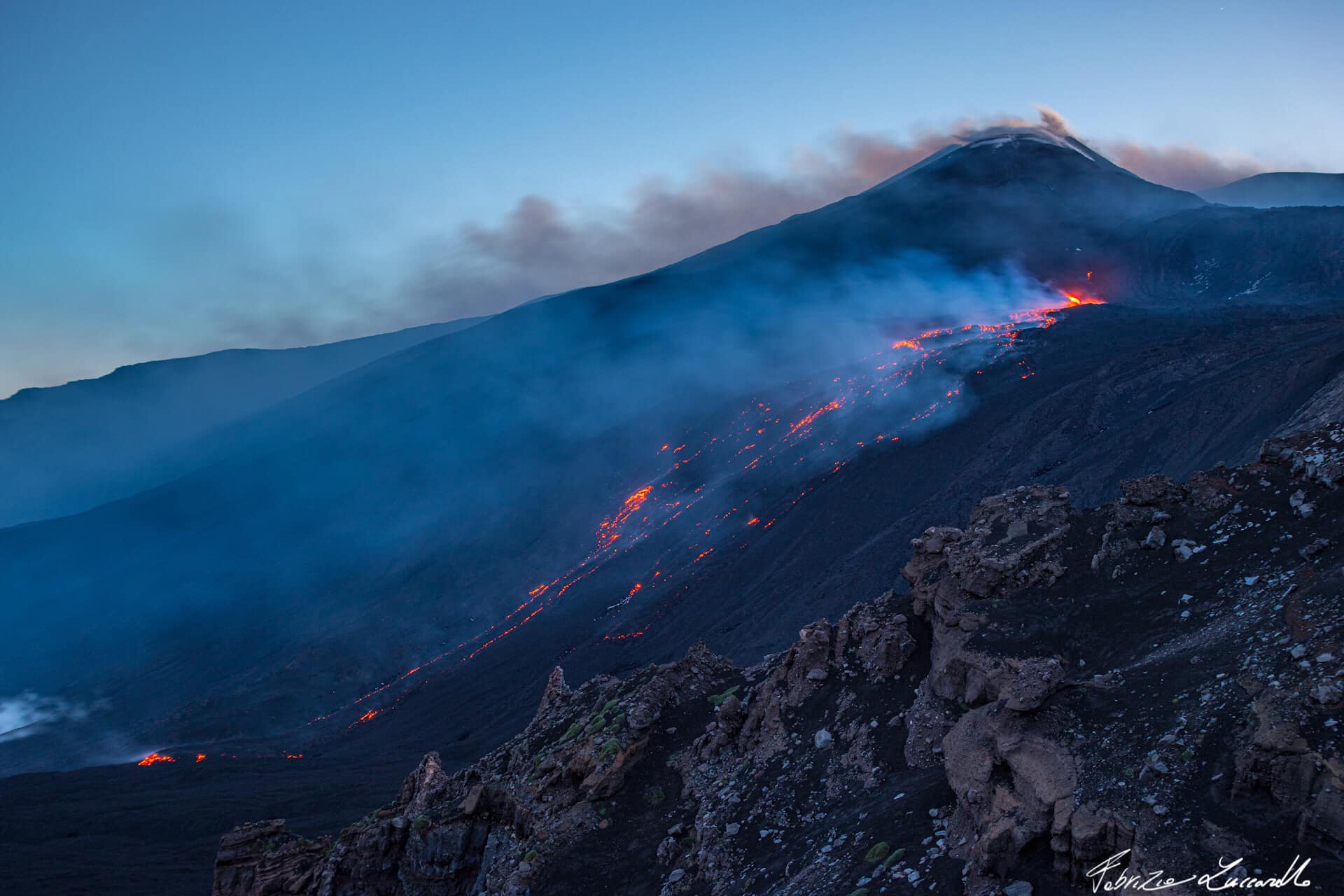
View of the new lava flow as of 29 May 2022 (image: Fabrizio Zuccarello / facebook.com/FabryZucc)
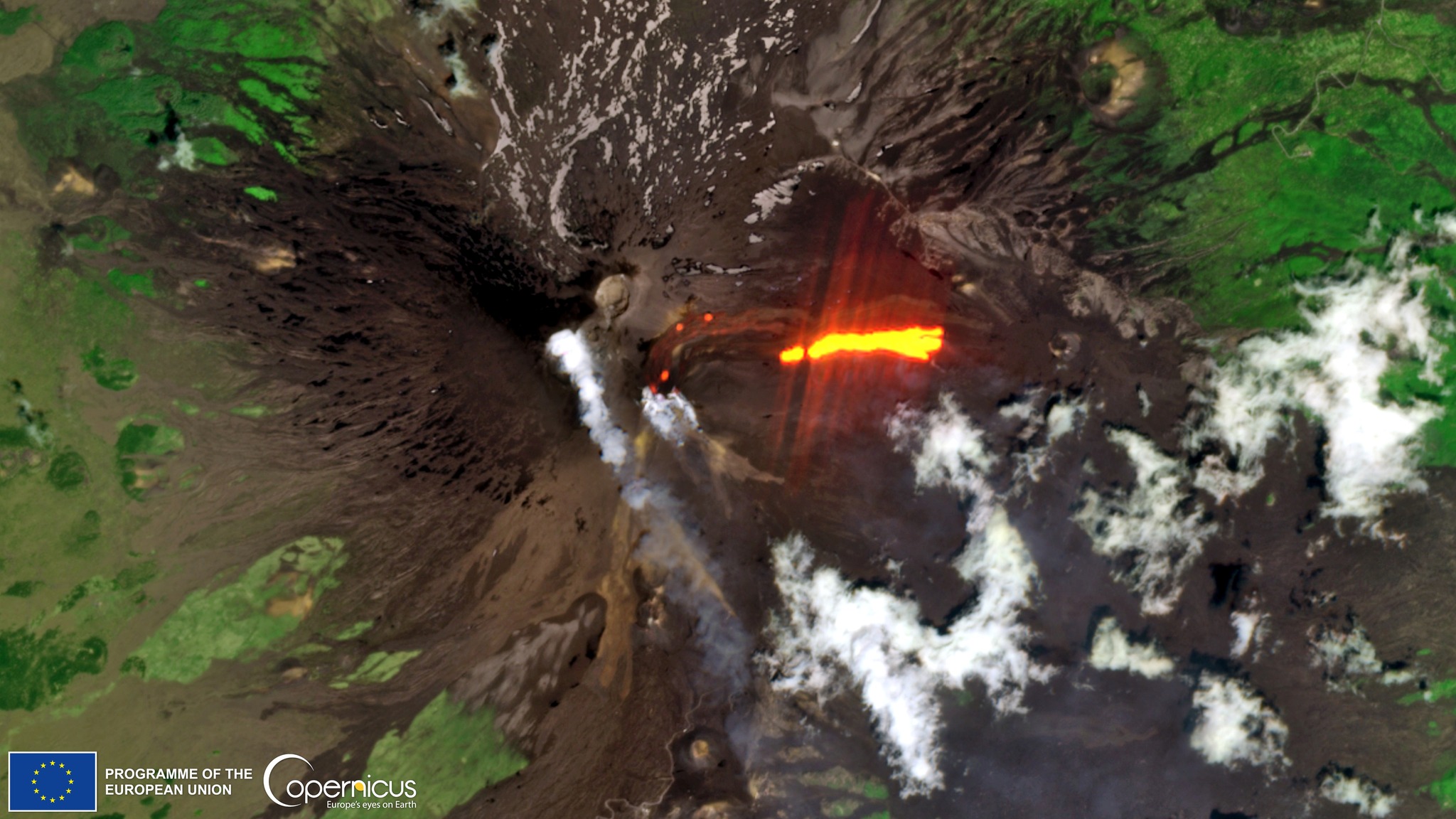
Infrared satellite image of Etna showing the lava flows as of 30 May (image: Copernicus)
The new effusive eruption from subterminal flank vents on the volcano's upper eastern flank continues. The lava flow that started yesterday remains active. It is being fed by two vents that had opened in succession, one at 3250 m and the other at 2800 m elevation on the upper eastern flank, according to a statement by the National Institute of Volcanology in Catania (INGV) who monitor the volcano.
The lava front had reached the 2100 m elevation yesterday afternoon and was heading towards Monte Simone in Valle del Bove. The overall effusion rate remains only modest.
Explosive activity at the SE crater complex has decreased, hinting at that the currently erupted magma is from the column below the gas-rich batch that erupted in the preceding days.
Ground deformation, seismic and other data indicate that the supply of magma from depth is at similar levels as the current output, thus indicating a stable situation of low intensity, at least for now. Etna has been known for periods with effusive activity of low intensity that can last from few days to many months. How the activity will evolve is open to speculation.
New effusive flank vent opened this morning
Update Sun 29 May 2022 18:54
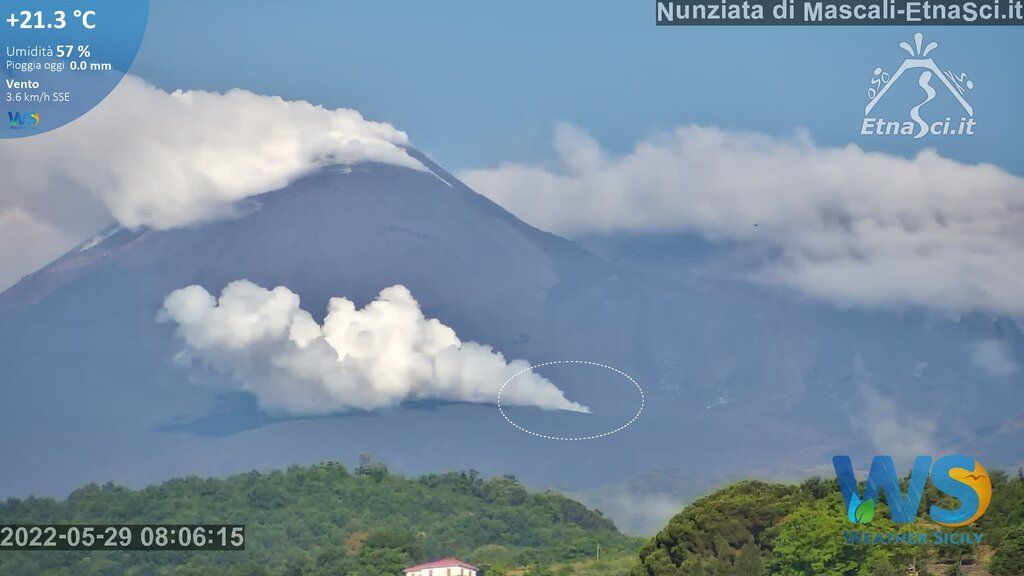
A new fissure flank vent at E-NE slope of the Valle del Bove (image: Weather Sicily webcam)
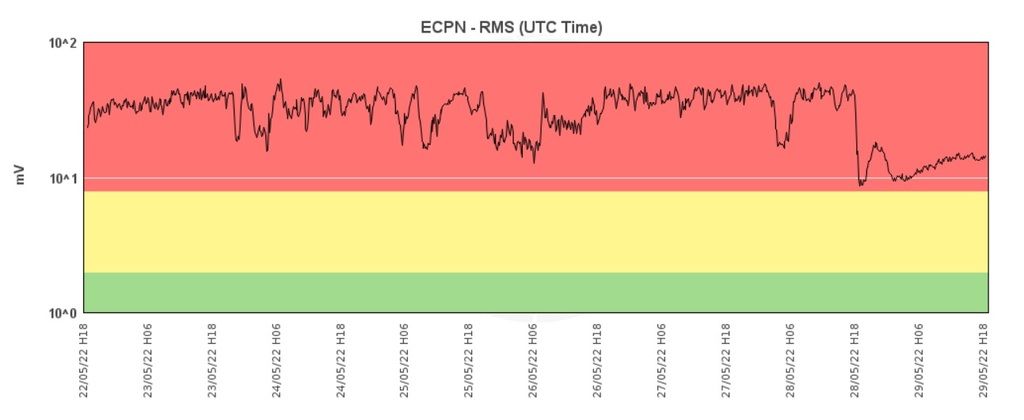
Steep decline of the tremor before the eruption and rapid rise indicating magma intrusion towards the surface (image: INGV)
opened at 06:05 local time this morning at altitude of 2800 meters at the E-NE upper part of the Valle del Bove.
The flank vent started to effuse a new lava flow.
Preceded the eruption, the fluctuated volcanic tremor rapidly decreased to medium-high values, but later strongly peaked, which indicated rapid magma flux towards the surface.
Source: Istituto Nazionale di Geofisica e Vulcanologia volcano activity update 29 May 2022Spectacular video of vent opening and intense summit explosions on 20 May
Update Fri 27 May 2022 01:19
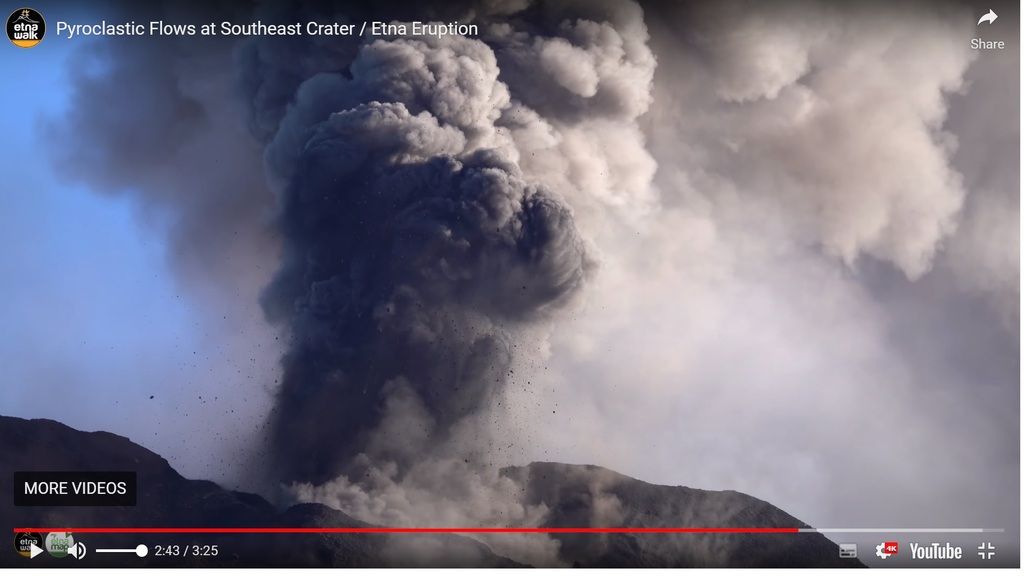
Screenshot from the video (image: Giuseppe Distefano)
An amazing brief video of the onset of the recent eruption phase on 20 May has been published by Giuseppe Distefano from Etna Walk.
The footage depicts the intensified activity of the Southeast crater accompanied by the opening of the vent generating the new lava flow and hot avalanches.
We would like to show you embedded content from X/Twitter. If you like to see this content, please make sure you agree with the
privacy policy of X/Twitter and click the button:
View embedded content from X/TwitterIntense strombolian eruptions continue with lava flows from flank vents
Update Tue 24 May 2022 02:53
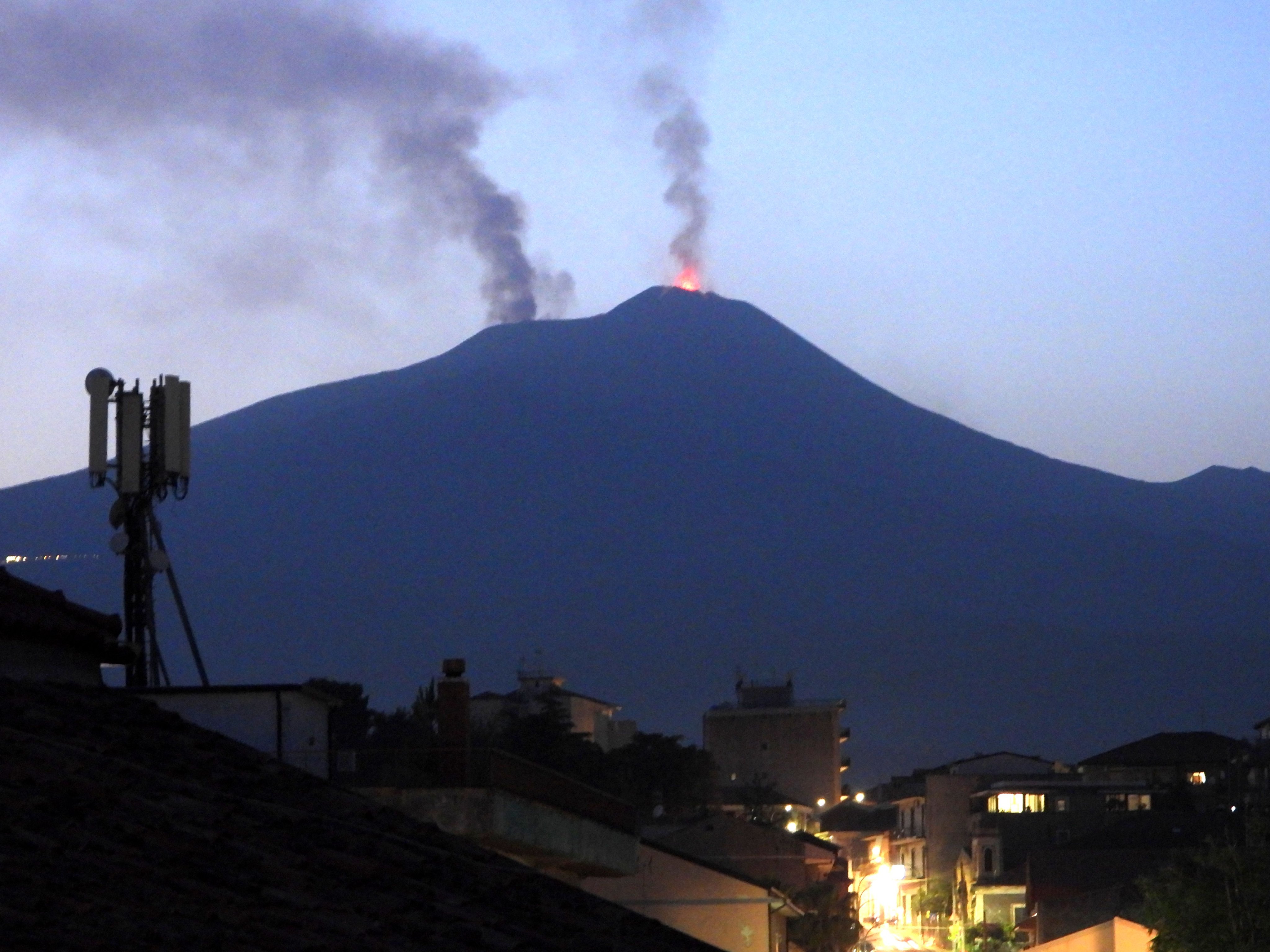
Strombolian activity with flank effusive eruptions (image: Boris Behncke)
The INGV local observatory detected that strombolian activity at the Southeast crater began to increase gradually at 17:40 local time yesterday.
Ash emissions have increased and reached 5 km altitude in the southern direction.
Active lava flows continue to advance from both fissure vents and have been reaching 2800 and 2700 m elevation into the Valle del Leone.
The high level volcanic tremor has been fluctuating a lot during the past few days, currently located at 3 km altitude beneath the Southeast crater.
Source: Istituto Nazionale di Geofisica e Vulcanologia volcano activity update 23 May 2022New fissure vent, two lava flows
Update Sat 21 May 2022 03:24
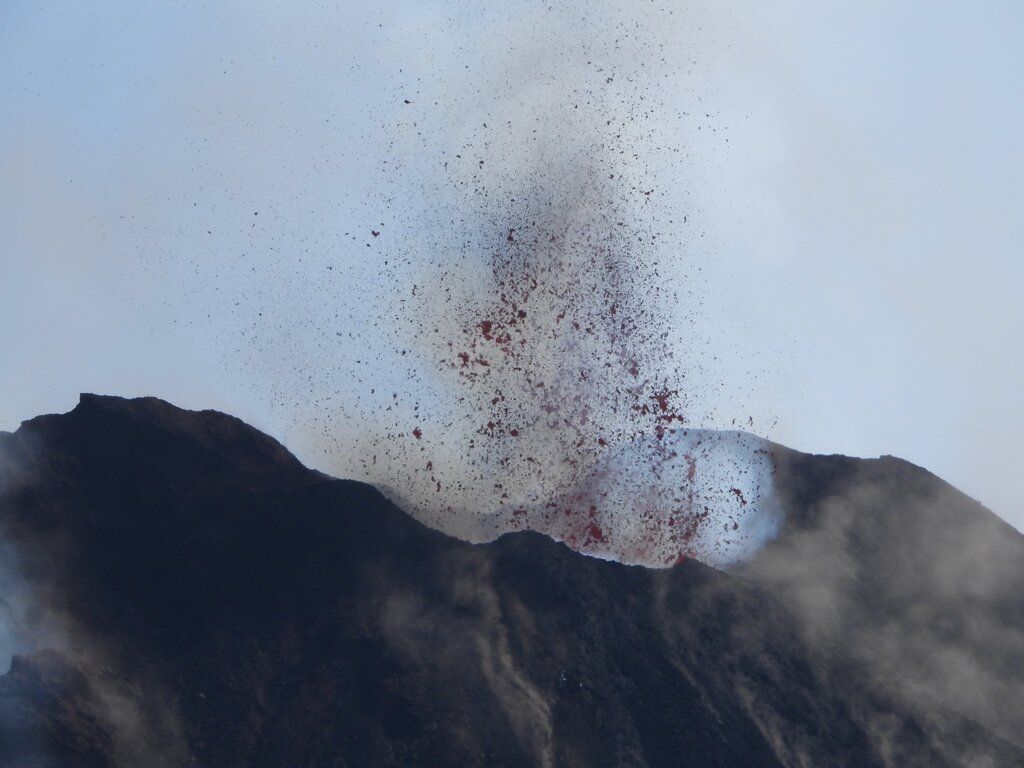
Strombolian activity at Etna volcano (image: Boris Behncke)
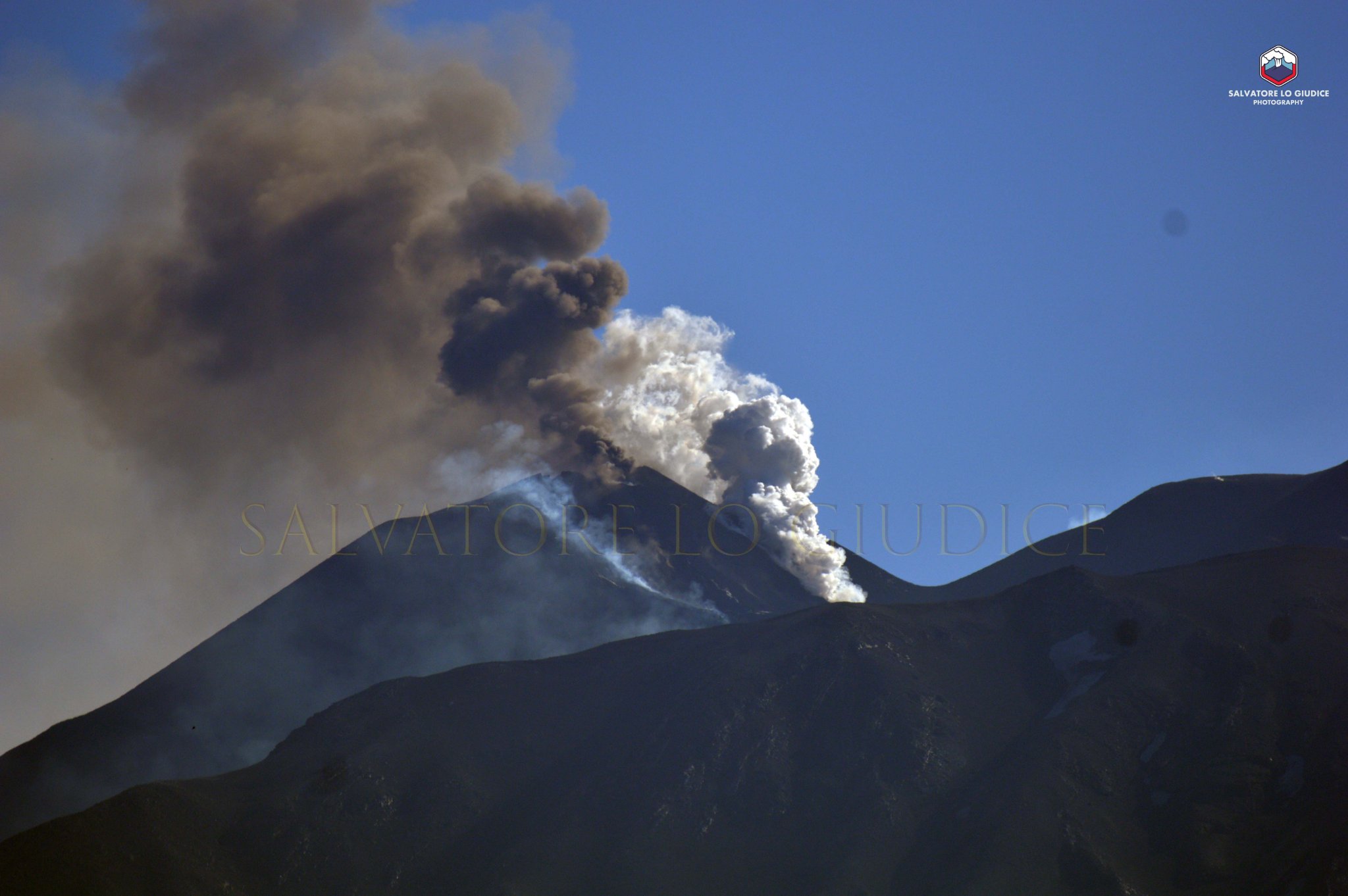
Ash and gas emissions at the SE crater today (image: INGV)
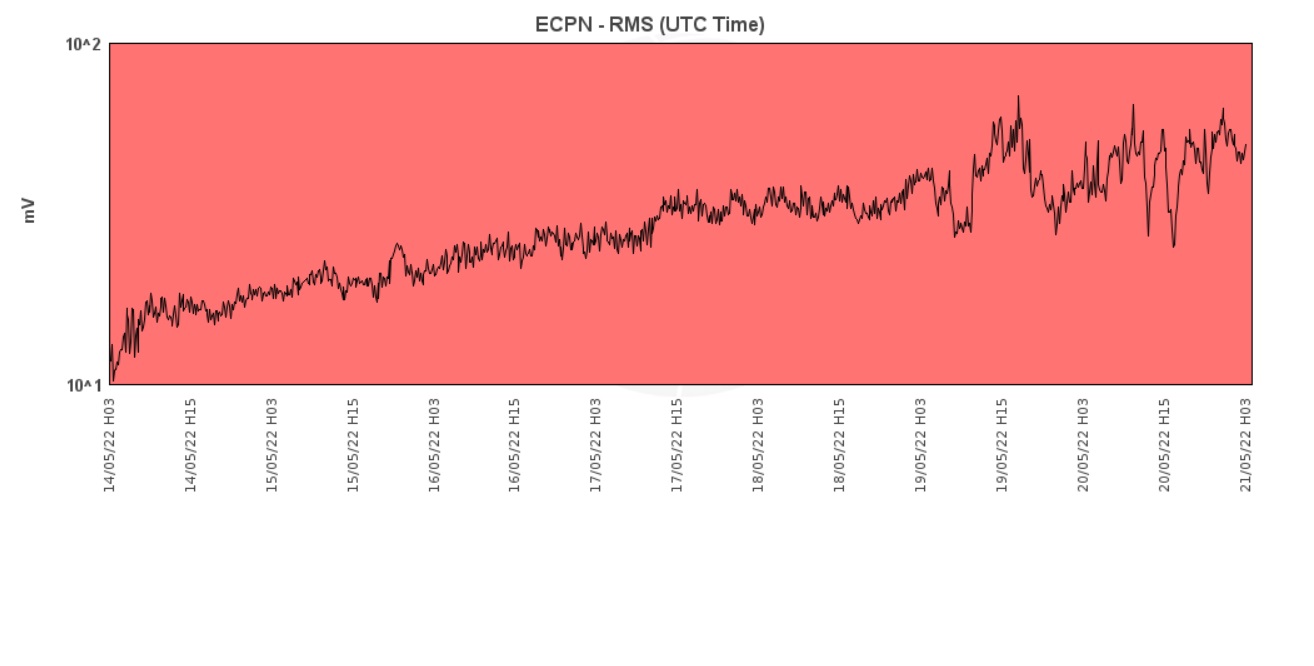
Fluctuating tremor at high levels continues (image: INGV)
opened on the north slope of the Southeast crater at altitude of approx. 3250 m at 15:30 local time today.
Opening of the new vent, located to the northwest of the latest fissure, was accompanied by intermittent ash emissions and lava spattering that has changed to erupting small lava fountains and spilling
a new lava flow out towards the northeast.
In parallel, the advancing lava flow from 12 May remains active traveling E-NE direction into the Valle del Bove.
Intense strombolian-type explosions continue from the Southeast crater with glowing ejecta of lapilli and lava bombs.
Preceded to the eruption, a typical sharp peak in tremor accompanied the event which continues at fluctuating intensity at high values.
Source: Istituto Nazionale di Geofisica e Vulcanologia volcano activity update 20 May 2022
The current effusive activity at Etna volcano (source: Boris Behncke)
We would like to show you embedded content from X/Twitter. If you like to see this content, please make sure you agree with the
privacy policy of X/Twitter and click the button:
View embedded content from X/TwitterSmall, but intense lava fountains feeding lava flow + stunning video footage of lava
Update Thu 19 May 2022 03:46
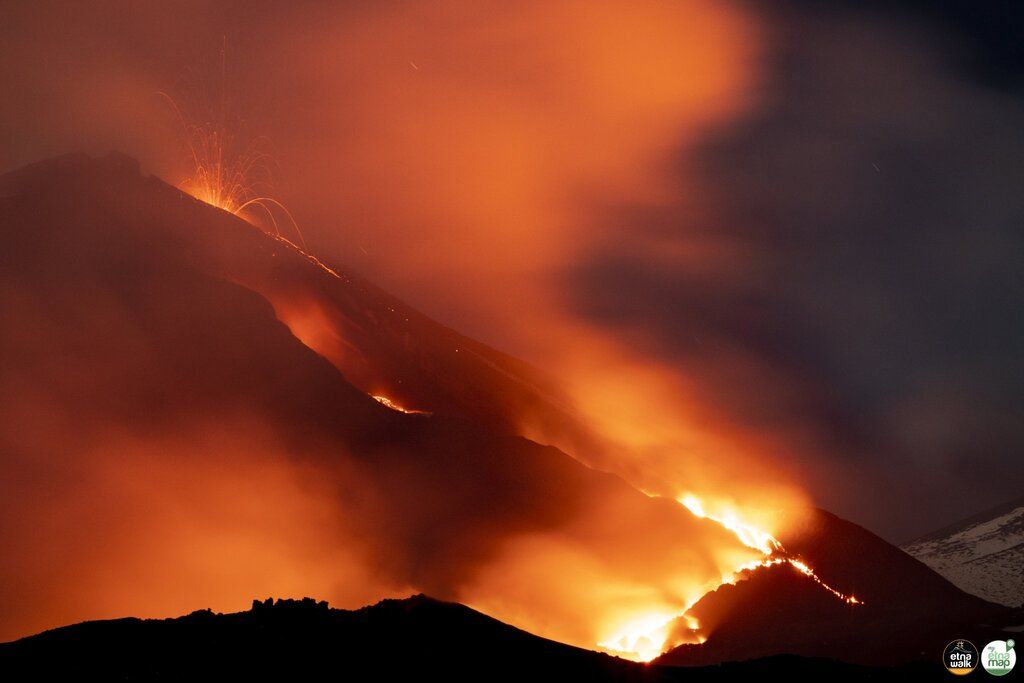
Fountaining and lava flow at Etna volcano (image: Etna Walk)
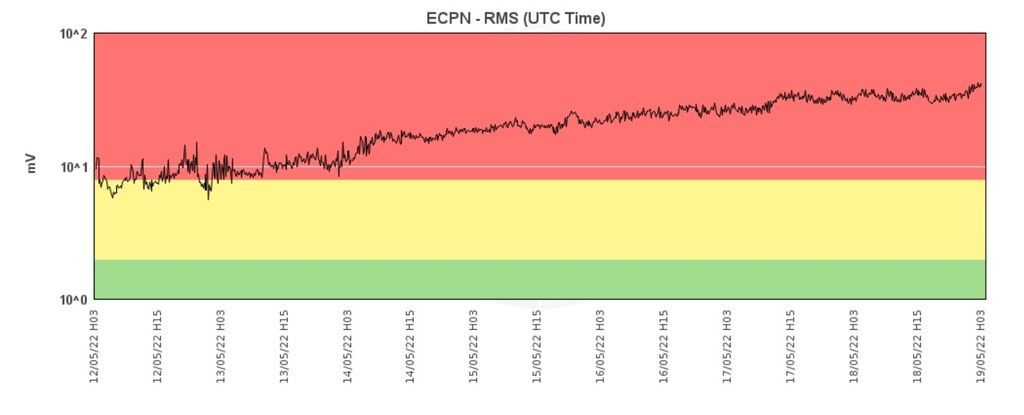
Higly elevated tremor continues (image: INGV)
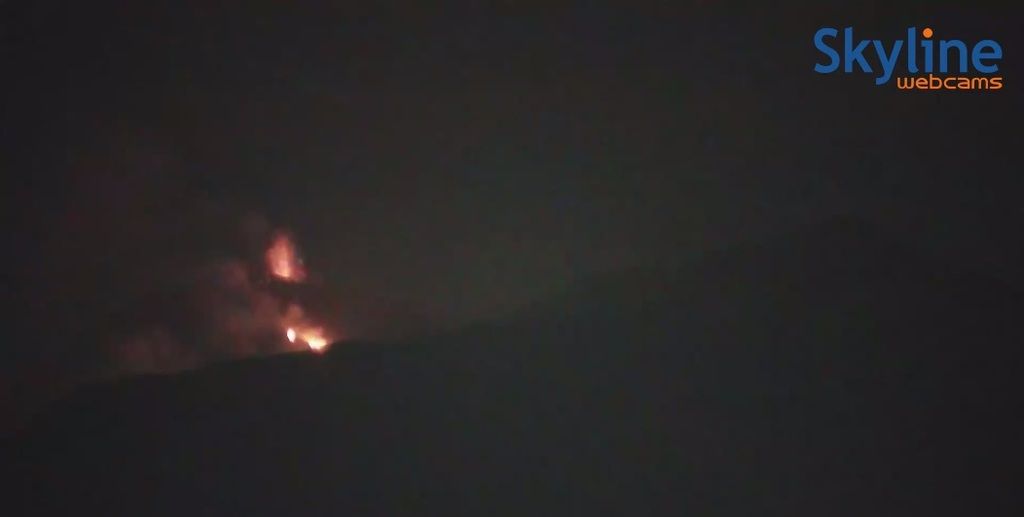
Lava fountains visible via Skyline Webcam
The new fissure vent continues to feed lava flowing into the Valle del Bove in the E-NE direction.
Behavior of the volcano has changed over the last 24 hours and slowly, but surely intensified characterized by strombolian activity at the vent.
It appears (and judging from the
live stream) that the vent started to produce pulsating small lava fountains likely caused by magma change composition from basaltic gas-poor to gas-rich melt.
Currently there are no signs to cease the eruption in the near future as indicate the high and stable volcanic tremor.
A beautiful video of 'A'ā lava flow at Etna characterized by typical jumble of loose, irregularly shaped cindery blocks (source: @mondoterremoti/twitter)
We would like to show you embedded content from X/Twitter. If you like to see this content, please make sure you agree with the
privacy policy of X/Twitter and click the button:
View embedded content from X/TwitterStrombolian explosions, outpouring lava flow continues
Update Wed 18 May 2022 04:26
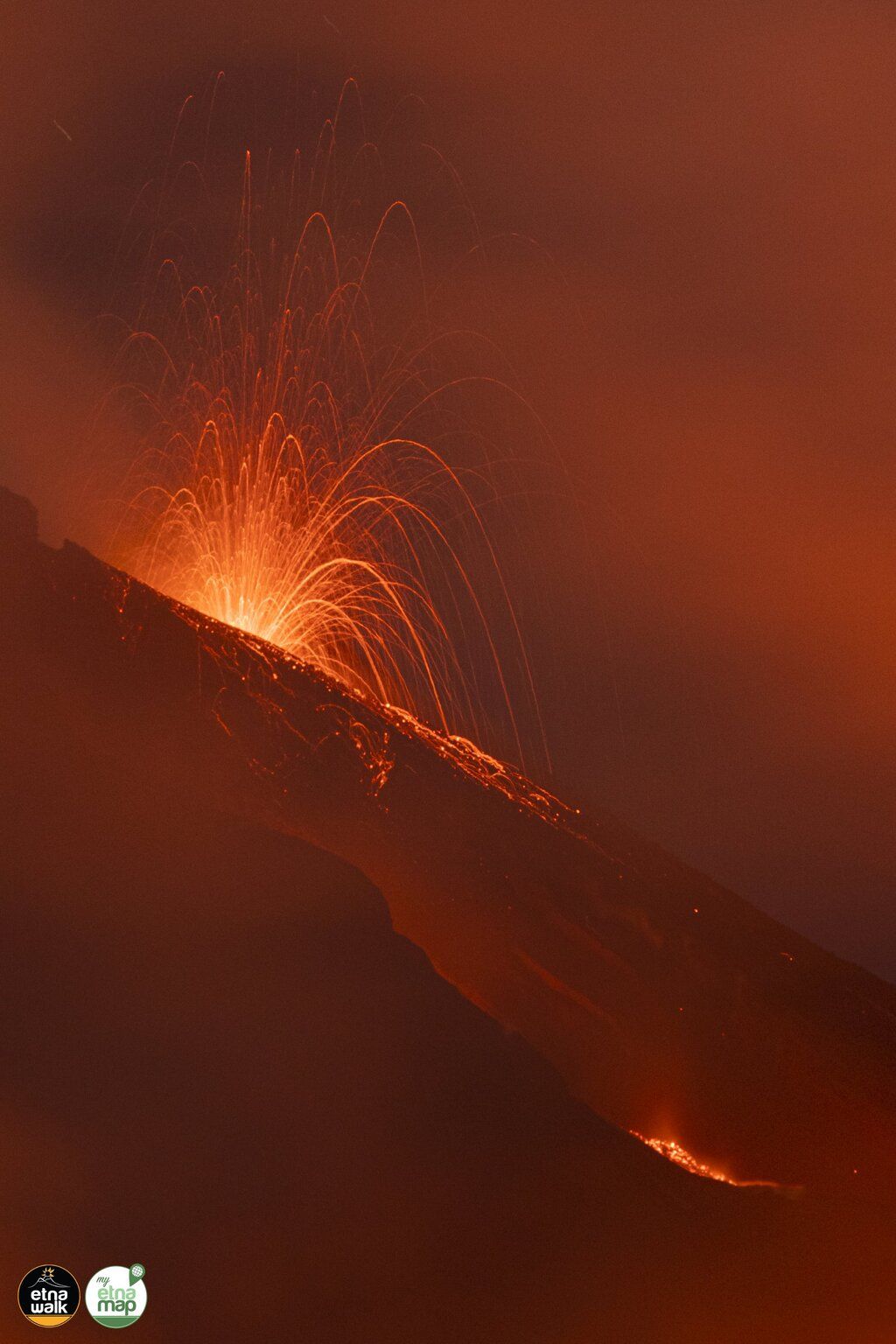
Strombolian activity from the SE crater (image: Etna Walk)
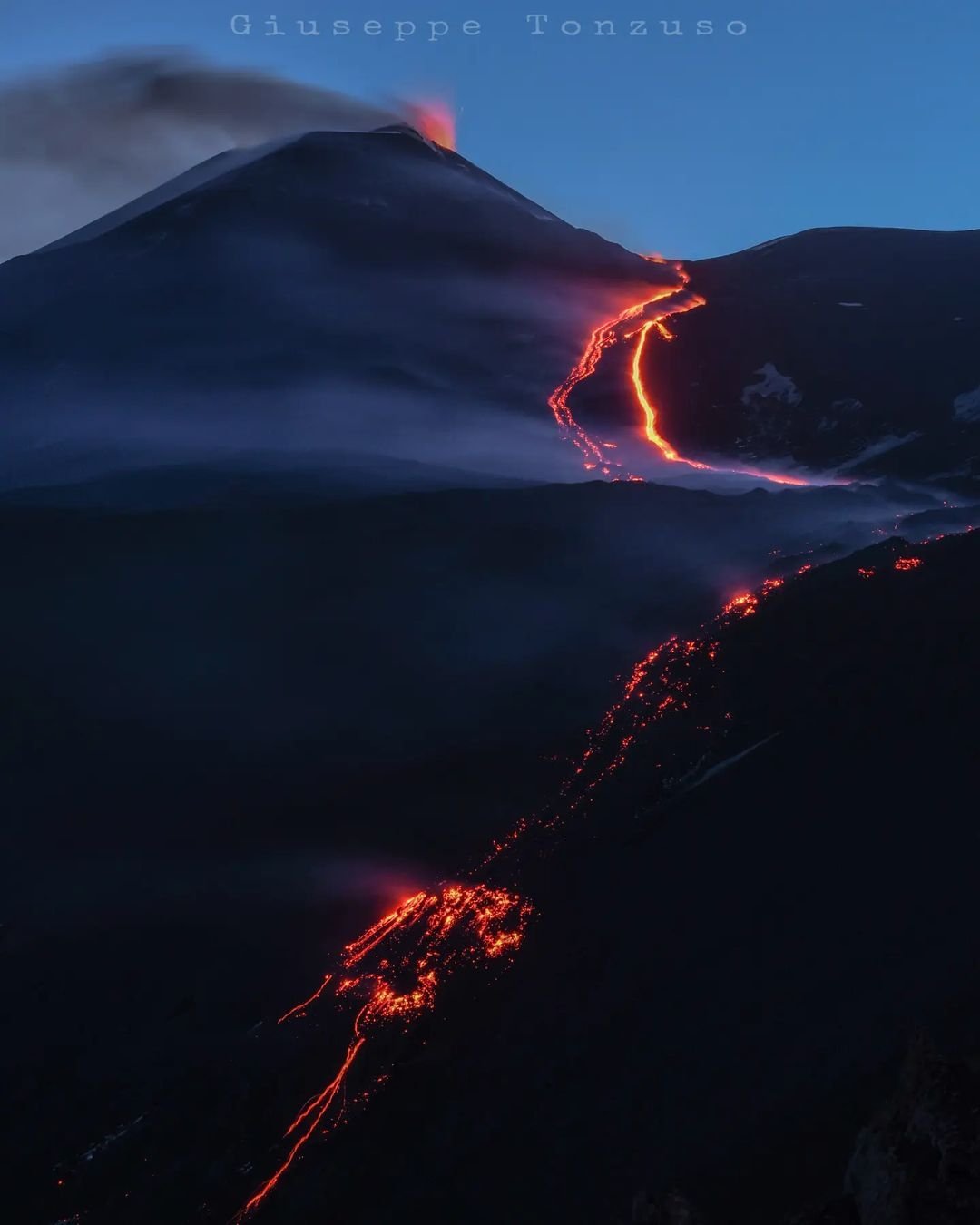
The lava flow and strombolian eruptions at Etna volcano (image: Etna News)
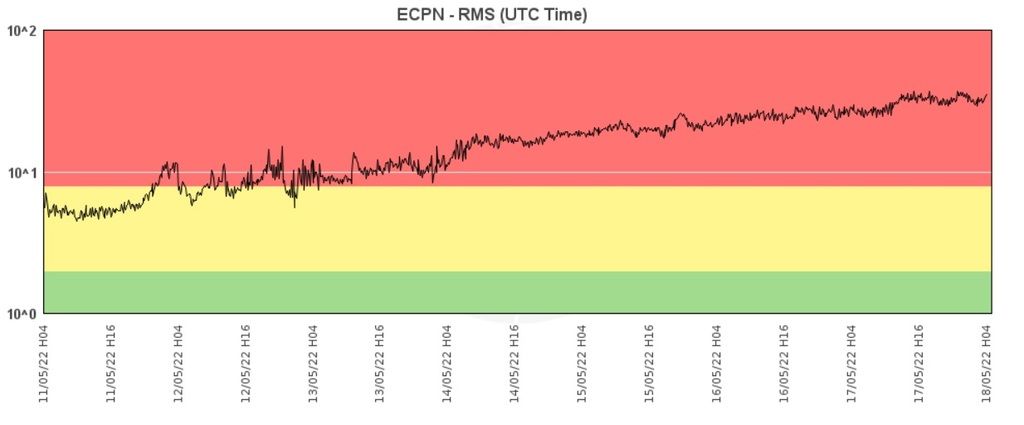
Highly elevated tremor continues (image: INGV)
The emitting lava flow has reached 2300-2400 meters elevation and continues to travel toward the Valle del Bove in the E-NE direction.
Strombolian activity at the Southeast crater has been mostly mild only, but at intense values has produced ash emissions.
The strong volcanic tremor has been located at about 3 km above sea level.
No significant ground deformation was detected.
Source: Istituto Nazionale di Geofisica e Vulcanologia volcano activity update 17 May 2022Smoothly flowing lava glows over Catania
Update Mon 16 May 2022 03:39

The lava spills out from the new fissure vent (image:
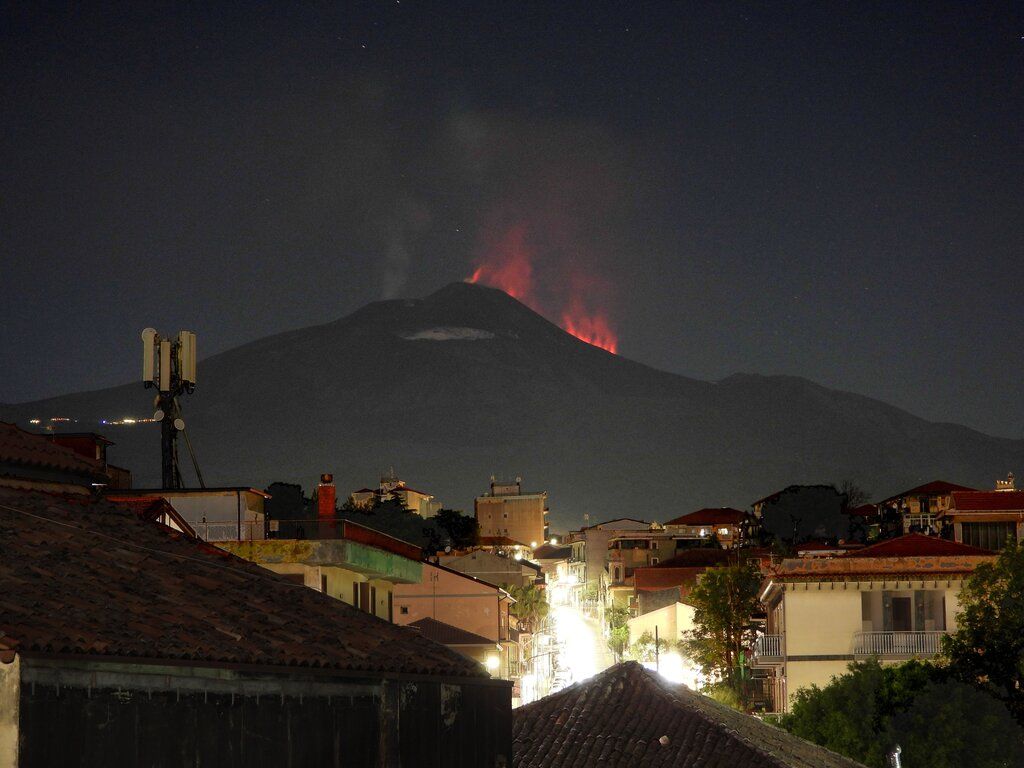
Glowing steam from the lava seen from Tremestieri Etneo (image: Boris Behncke/twitter)
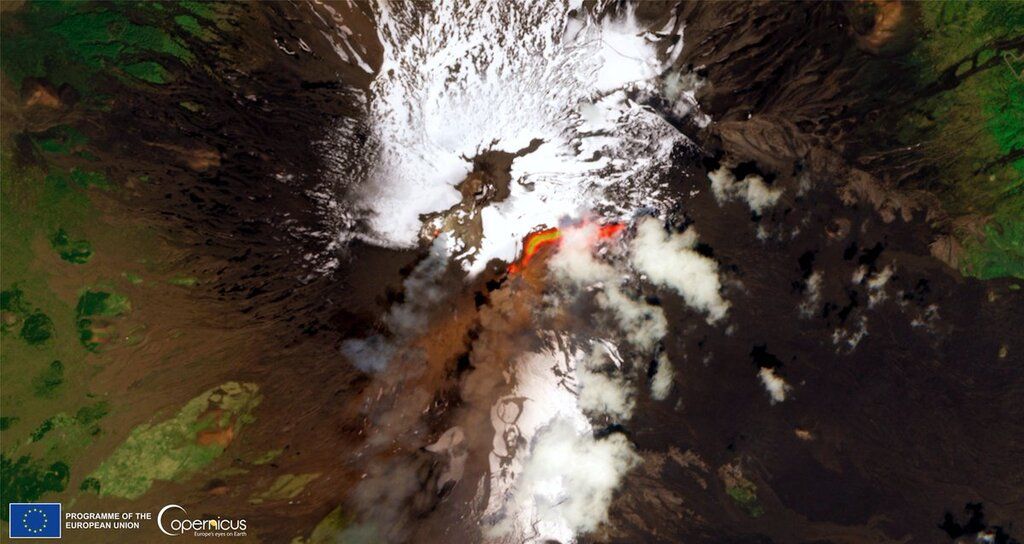
The lava flow at Etna volcano visible from space (image: Copernicus EU/twitter)
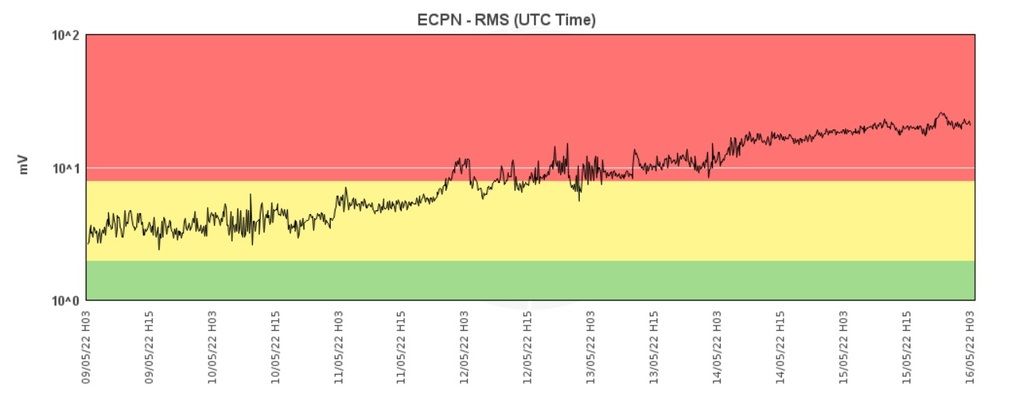
Tremor continues at stable levels (image: INGV)
The lava flow continues to be active on the northern flank of the Southeast crater for almost 60 hours since the effusive eruption started on Friday the 13th.
The volcanic tremor has continued at stable conditions over the weekend and is still continuing. This likely suggests a delicate equilibrium of effusion rates of magma.
Lava flow eruption continues
Update Sat 14 May 2022 05:35
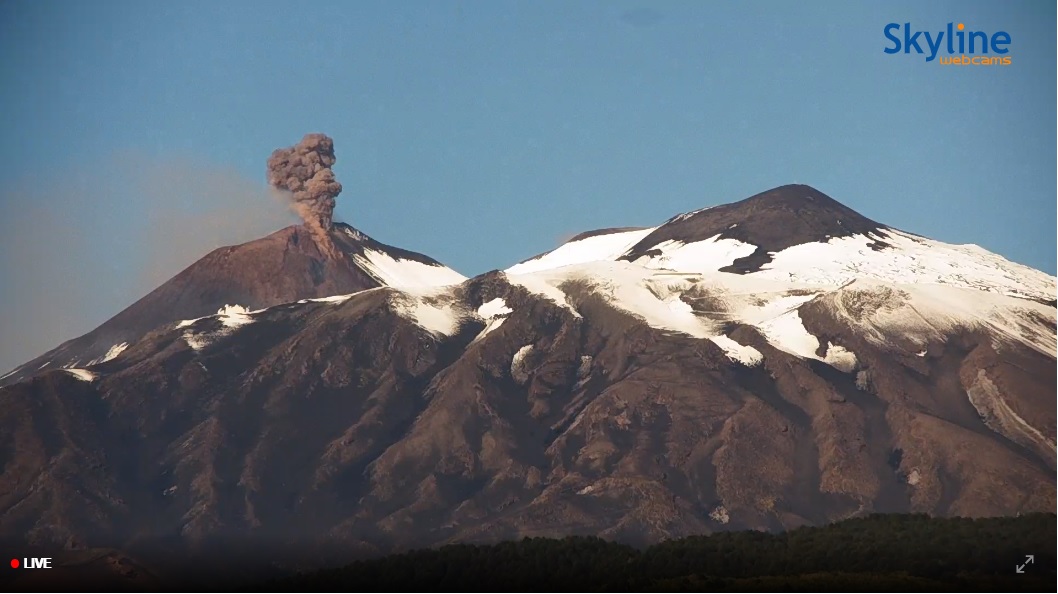
Live webcam screenshot from the erupting Etna volcano now (image: Skyline webcam)
The effusive episode is still in progress at the volcano (
live stream).
The lava continues to keep the flow active, emerging from the new eruptive fissure and advancing onto the northern flank of the Southeast crater.
Presence of snow and ice in interaction with the flow front generates ash-steam-rich plumes as visible in the attached video below from Etnasentieri Irene.
New eruptive fissure and lava flow tonight
Update Fri 13 May 2022 02:37
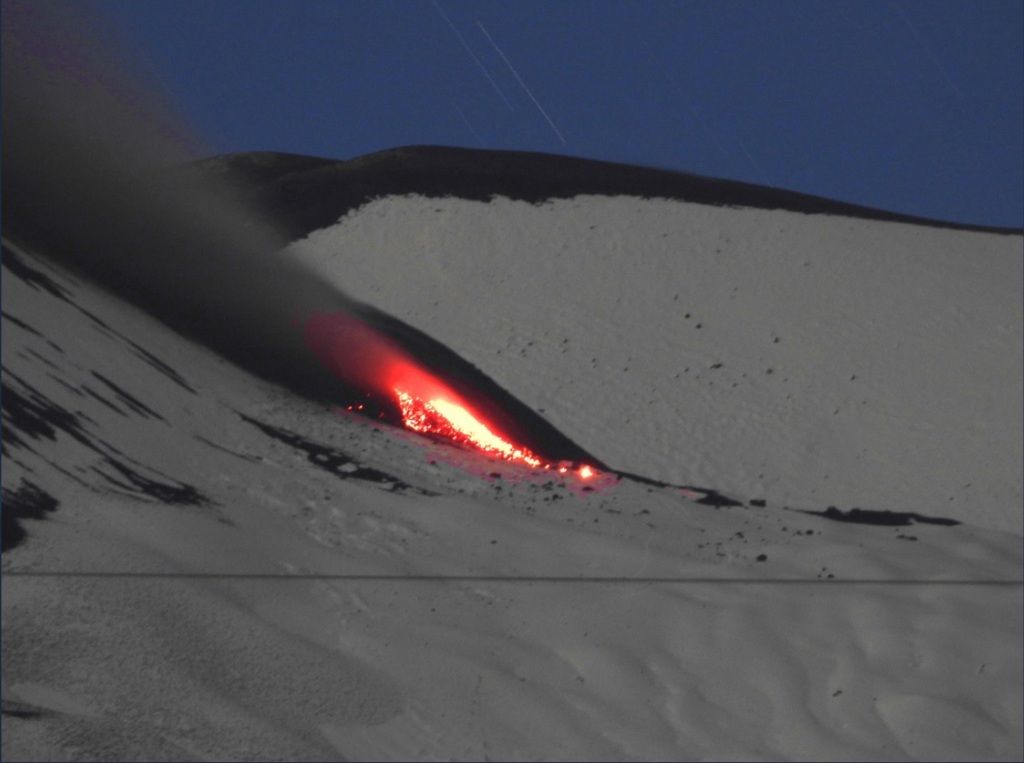
New lava flow at Etna volcano this evening (image: INGVvulcani/twitter)
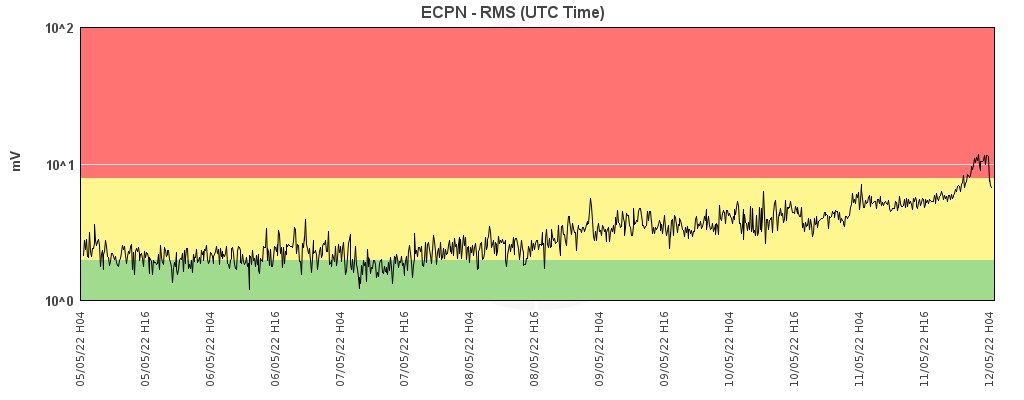
Evolving tremor reached its peak tonight at about 19:00 (image: INGV)
A
new fissure vent opened at the volcano that started to produce a new small lava flow at about 19:45 this evening as reported by the INGV local observatory.
The new lava flow is currently descending to the base of the northern flank of the Southeast crater.
The opening of the vent was accompanied by ash emissions from the Southeast crater at around 19:00 local time today generating an ash column to 3,5 km height towards the SW direction.
Prior to the eruption, the volcanic tremor started to evolve at about 22:00 local time yesterday to medium-high levels. It remains at high values for now at altitude of about 3000 m, suggesting continuing effusion of magma.
The effusive eruption at the time of this update is still continuing which proves also the Skyline webcam link
here.
Source: Istituto Nazionale di Geofisica e Vulcanologia volcano activity update 12 May 2022Etna volcano (Italy): beautiful steam ring
mer., 4 mai 2022, 04:42 04:42 AM | AUTEUR : MARTIN
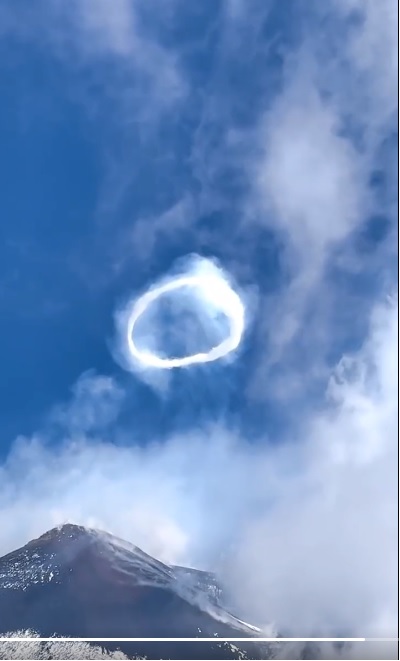
The steam ring ("smoke ring") of Etna volcano yesterday (image: Il Mondo dei Terremoti/twitter)
A beautiful greeting to the world, the volcano sent out a large steam ring from the Bocca Nova crater into the air yesterday - a ring vortex created when a sudden pulse of gas leaves a circular vent.
We would like to show you embedded content from X/Twitter. If you like to see this content, please make sure you agree with the
privacy policy of X/Twitter and click the button:
View embedded content from X/TwitterCalm continues at surface, but increasing deep-seated explosion signals
Update Thu 03 Mar 2022 11:33
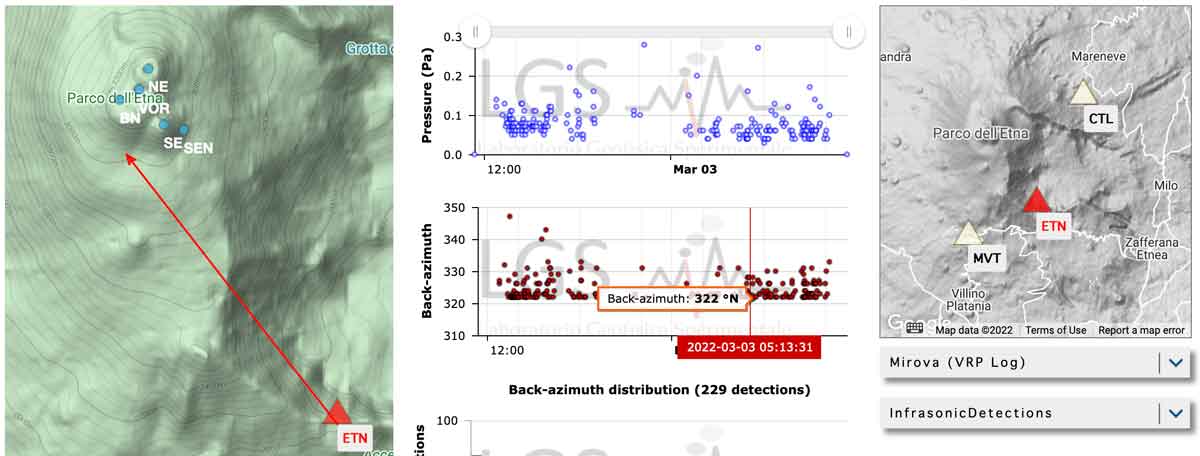
Infrasonic events detected during the past 24 hours (image: LGS)
The volcano remains relatively calm at the surface although many people are almost expecting it to produce another paroxysms in the very near future.
Whether this might happen or not cannot be predicted, but deep-seated explosions have increased again, as detected by low-frequency acoustic pressure waves by the network of the
Experimental Laboratory of Volcanology of the University of Florence (LGS). Most of these come from the conduit feeding the New SE crater complex, indicating the presence of degassing magma not too far from the surface.
On the other hand, volcanic tremor and other parameters remain at low levels of intensity, but things can change very quickly at Etna as we know.
Etna volcano (Italy): scientists find evidence of new magma involved while waiting for new activity
mer., 2 mars 2022, 17:30 17:30 PM | AUTEUR : T
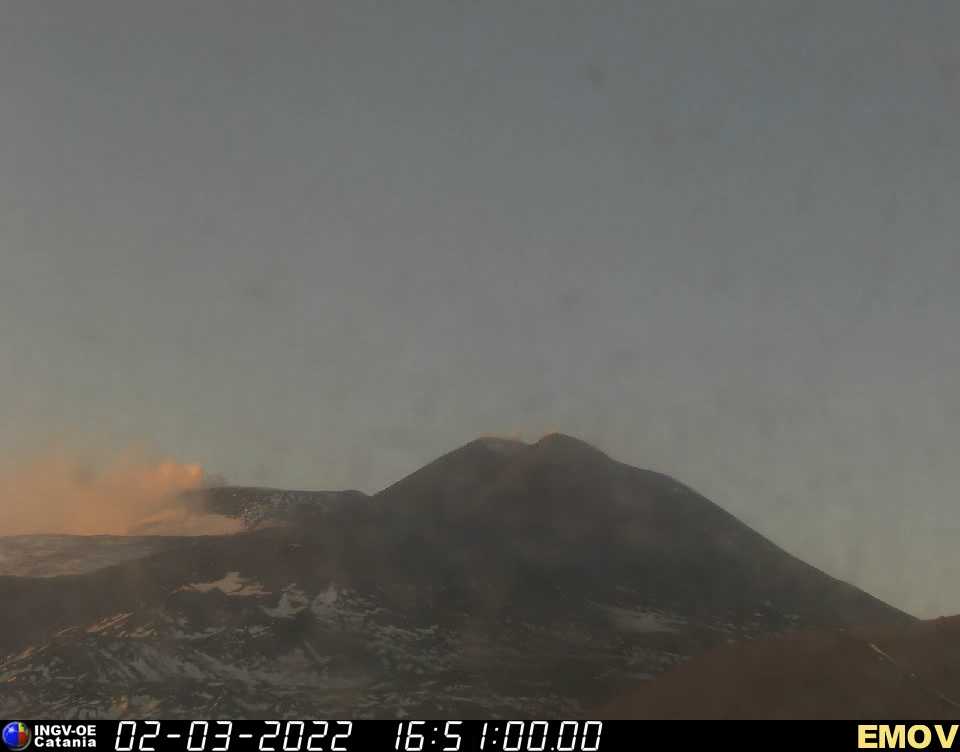
Etna volcano this afternoon, calm for how long? (image: INGV webcam)
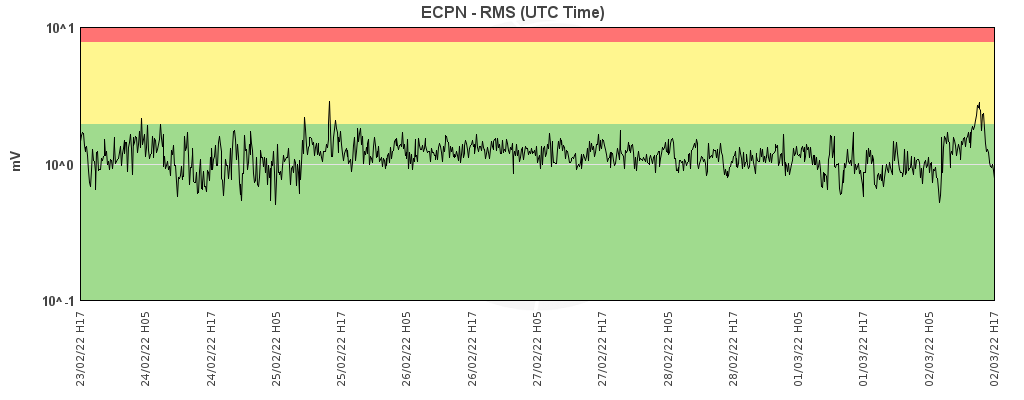
Current tremor amplitude at ECPN station showing a small peak earlier today (image: INGV Catania)
Etna has remained mostly calm since its latest paroxysm on 21 Feb, while many are speculating that it might now be close to another lava fountaining episode in the near future, if it follows the same interval as between the previous ones.
Short periods of ash emissions from the North East crater, infra-sound signals indicating deep-seated explosions inside the upper conduits beneath the summit vents, as well as a small peak of tremor earlier today all indicate that the volcano is restless and could awaken any time towards more vigorous activity again.
In the meantime, the volcano observatory INGV Catania made an interesting discovery mentioned in a
report from yesterday: analysis of lava samples from the last two paroxysms revealed that their chemistry changed with respect to the lava erupted during the many paroxysms in 2021. This indicates that the latest eruptions involved new magma coming from a different, likely deeper reservoir beneath the volcano. This magma has started to access the conduit feeding the activity at the New SE crater, and increases the likelihood we will see more activity from this vent soon.
The involvement of magma from a different storage underneath the volcano could also have been the reason for a brief phase of increased earthquake activity in January, as it created intrusions (and breaking rocks at depth) towards the conduit(s) involved.
Ash emissions yesterday
Update Sat 26 Feb 2022 01:25
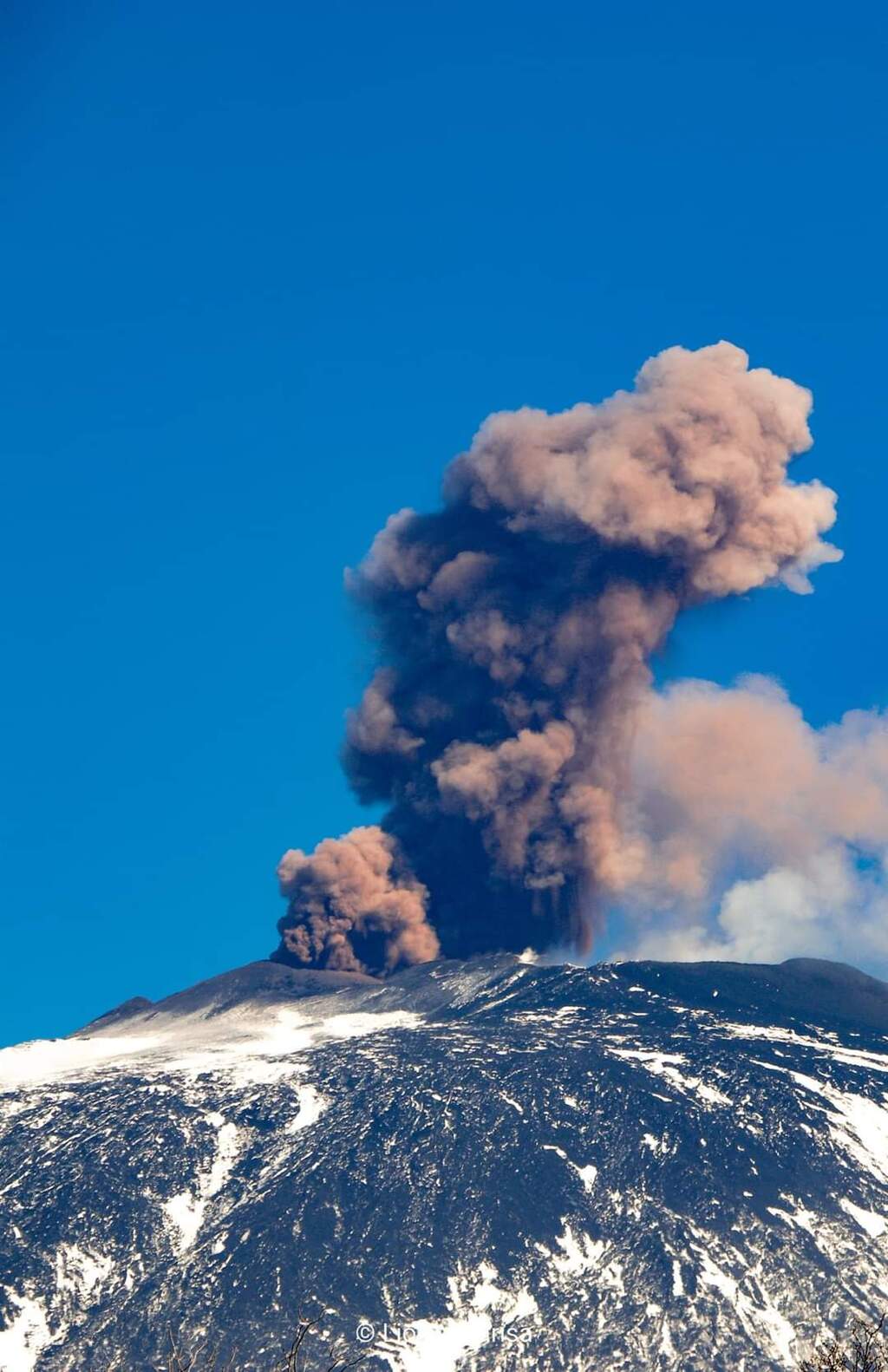
Ash plume from the NE crater at Etna yesterday (image: @etnanews7/twitter)
The local observatory INGV informed that ash emissions were observed from the Northeast crater at 12:38 local time yesterday.
Volcanic ash dispersed towards the S-SE direction.
The seismic tremor remained at low levels located at the area between Bocca Nuova and the Southeast crater in 2000-2500 meters elevation.
Source: Istituto Nazionale di Geofisica e Vulcanologia volcano activity update 25 February 2022Lava fountaining episode ended
Update Thu 24 Feb 2022 01:21
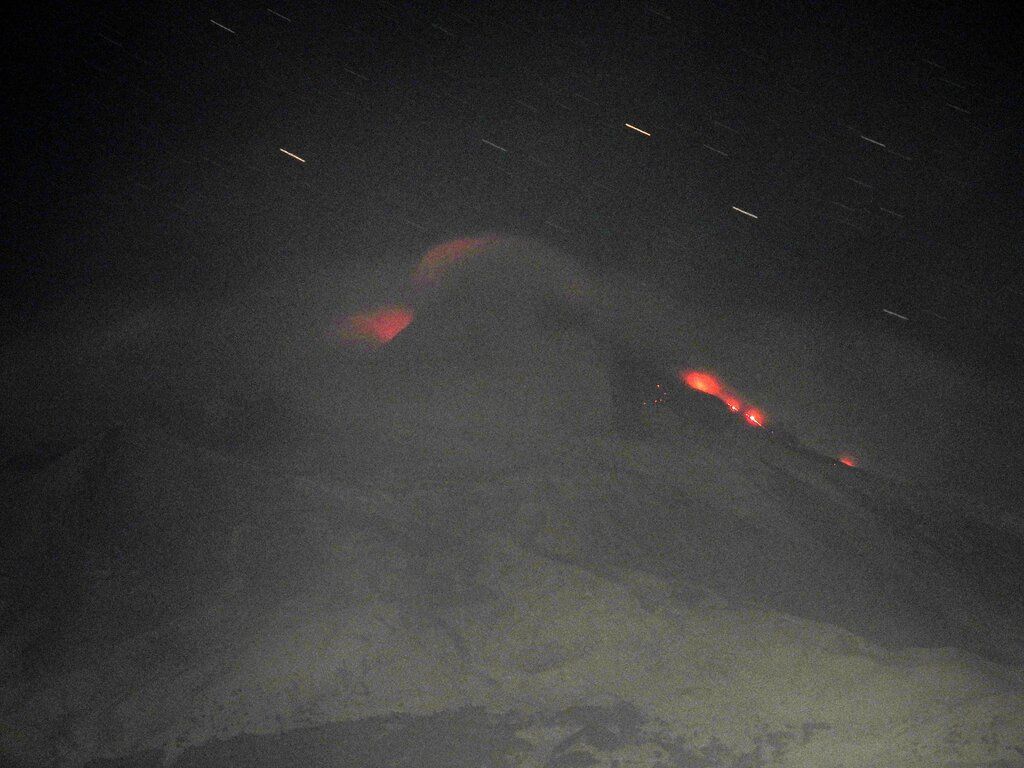
Cooling lava from the New SE crater yesterday (image: Boris Behncke/twitter)
The volcano observatory in Catania (INGV) reported that the latest paroxysm episode on 21 Feb ended.
After the eruption ceased, the activity within the New SE crater showed signs of weak strombolian activity by passive emissions of steam and ash drifting towards the south.
The lava flow on the eastern flank of the New SE crater decreased its advance as it is in the progress of cooling.
Volcanic tremor continues at medium-low levels.
Source: Istituto Nazionale di Geofisica e Vulcanologia volcano activity update 23 February 2022Very strong lava fountaining episode (paroxysm) in progress
Update Mon 21 Feb 2022 12:21
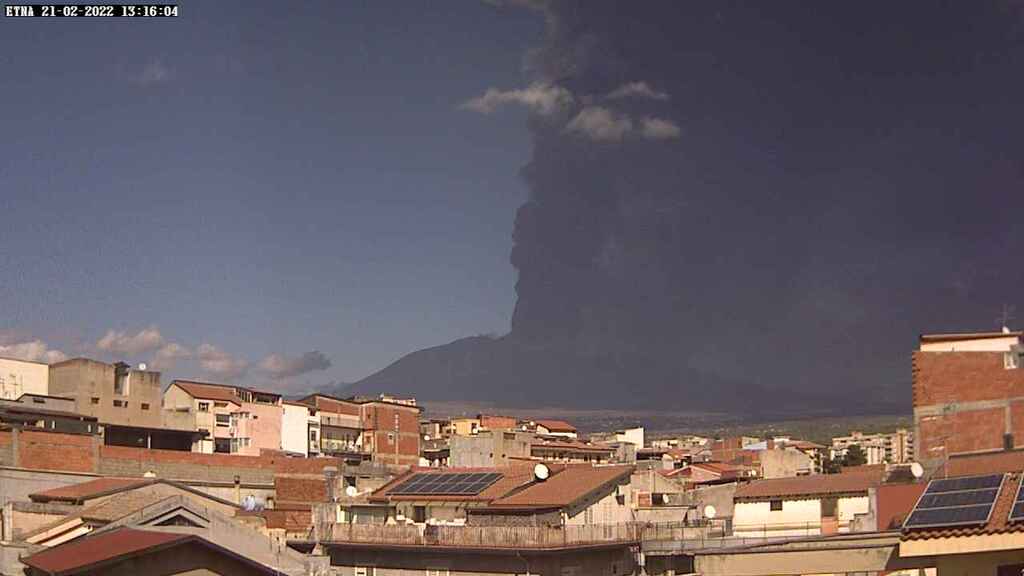
Etna today seen from Catania (image: Radio Touring webcam)
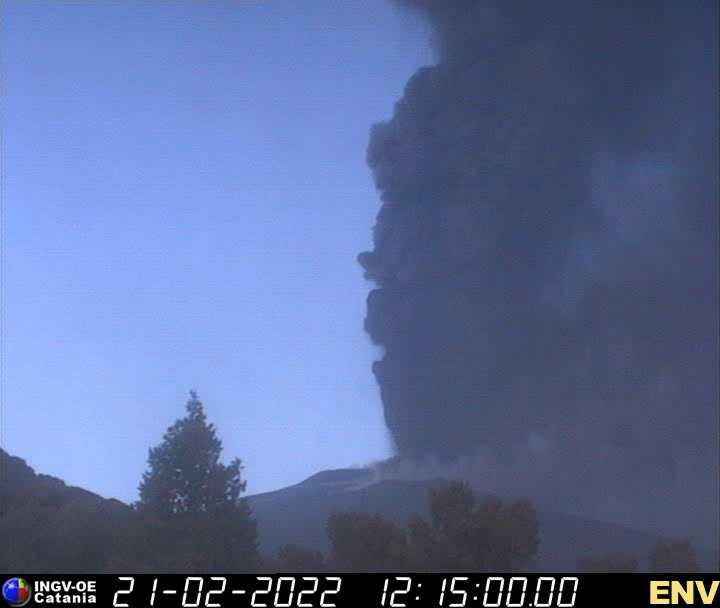
Lava fountain from the SE crater seen from Nicolosi (image: INGV webcam)
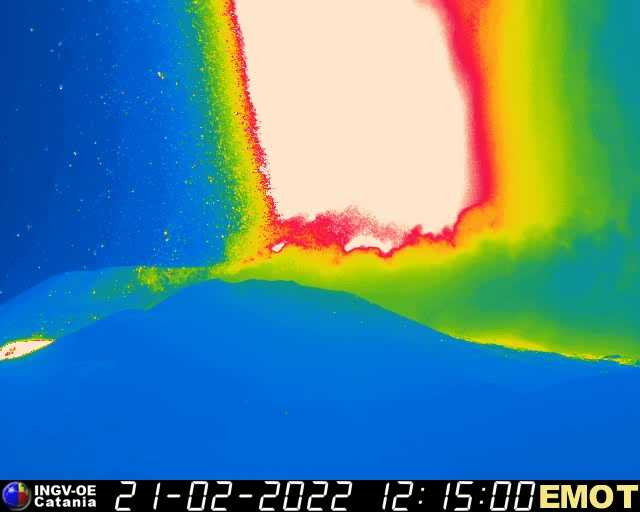
Thermal image of the lava fountain (image: INGV thermal webcam)
10 days since the lava-fountaining episode, known as paroxysm, from the volcano's New SE crater, another powerful paroxysm is started today and is now in full swing.
Lava fountains are shooting into the Sicilian sky for probably more than 1000 meters and a dark ash column is rising to estimated 10 km height, drifting east where heavy lapilli and ash fall are occurring.
The activity started around 9 a.m. local time, when a thermal anomaly and soon after, weak strombolian activity were first observed at the New SE crater. At the same time, volcanic tremor started to increase. These are the typical short-term precursors for Etna's paroxysms.
By noon, the strombolian activity began to increase significantly, and quickly turned into lava fountaining by around 12.20 that generated a tall eruption column rising to approx. 10-11 km.
A lava flow started to erupt from the southern breach of the SE crater complex and has been traveling towards the SW, overlapping the many previous flows from the paroxysmal episodes that have been occurring since February last year at the volcano.
At the time of this update, the activity is still increasing, but likely is near or at its peak.
Continuing ash emissions from SE crater
Update Sat 12 Feb 2022 03:11
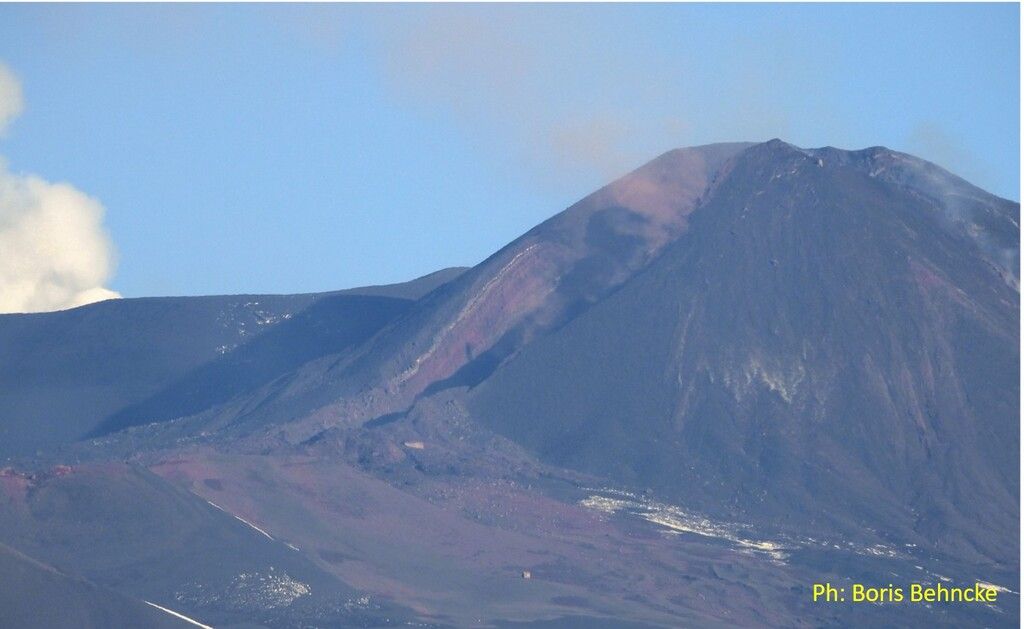
Mild ash emissions from the SE crater at Etna volcano today (image: Boris Behncke)
Although yesterday's vigorous paroxysm activity ended, emissions continue from the SE crater, with only venting of small ash.
The lava flow from last night has stopped and is no longer active. The flow front reached approx. 2850 m elevation west of Monte Frumento Supino.
Volcanic tremor remains at average levels at 2800 m altitude.
A thermal anomaly has been detected at 10:25 local time at the southeastern base of the SE crater at altitude of 3000 m.
Source: Istituto Nazionale di Geofisica e Vulcanologia volcano activity update 11 February 2022First paroxysm episode in 2022, pyroclastic flows in Valle del Bove, spectacular lava fountains and lava flow
Update Fri 11 Feb 2022 04:54
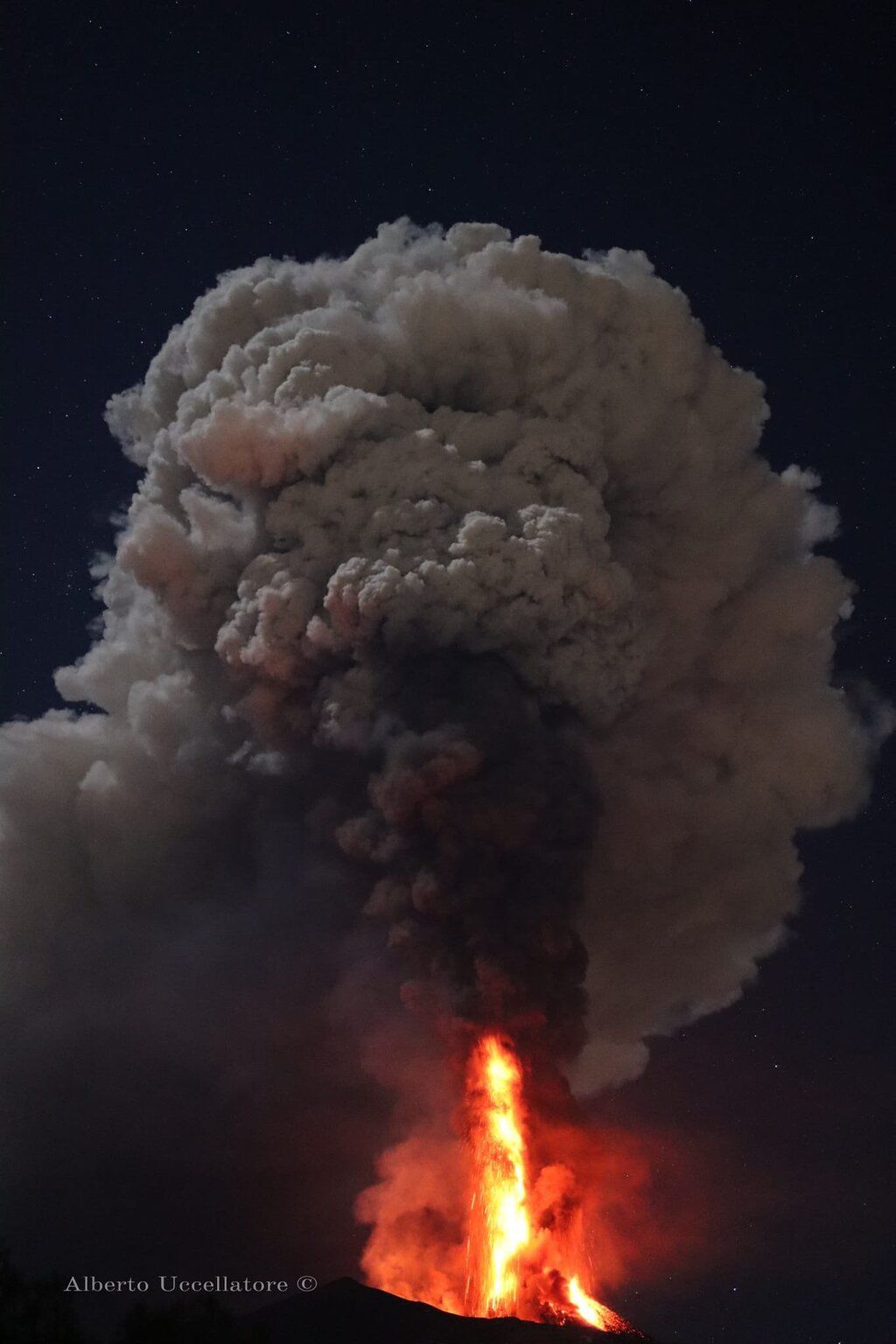
Paroxysm episode at Etna today (image: Alberto Uccellatore)
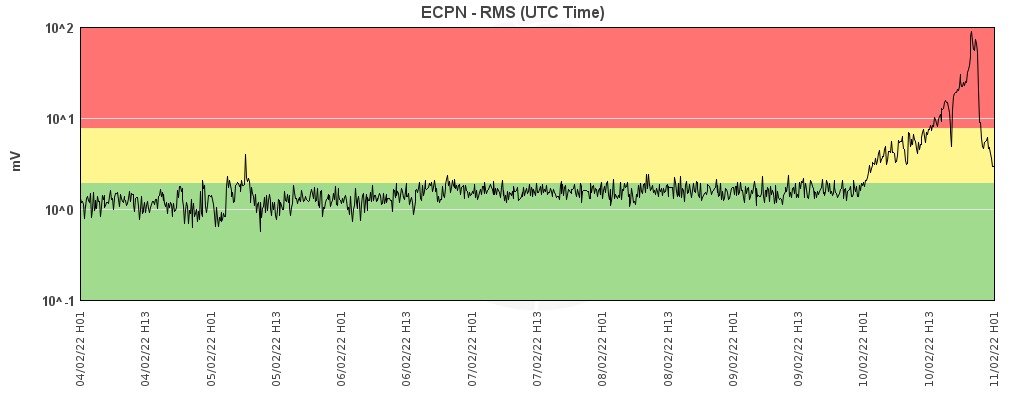
Volcanic tremor amplitude showing the increase typical for paroxysms in their build-up stage (image: INGV Catania)
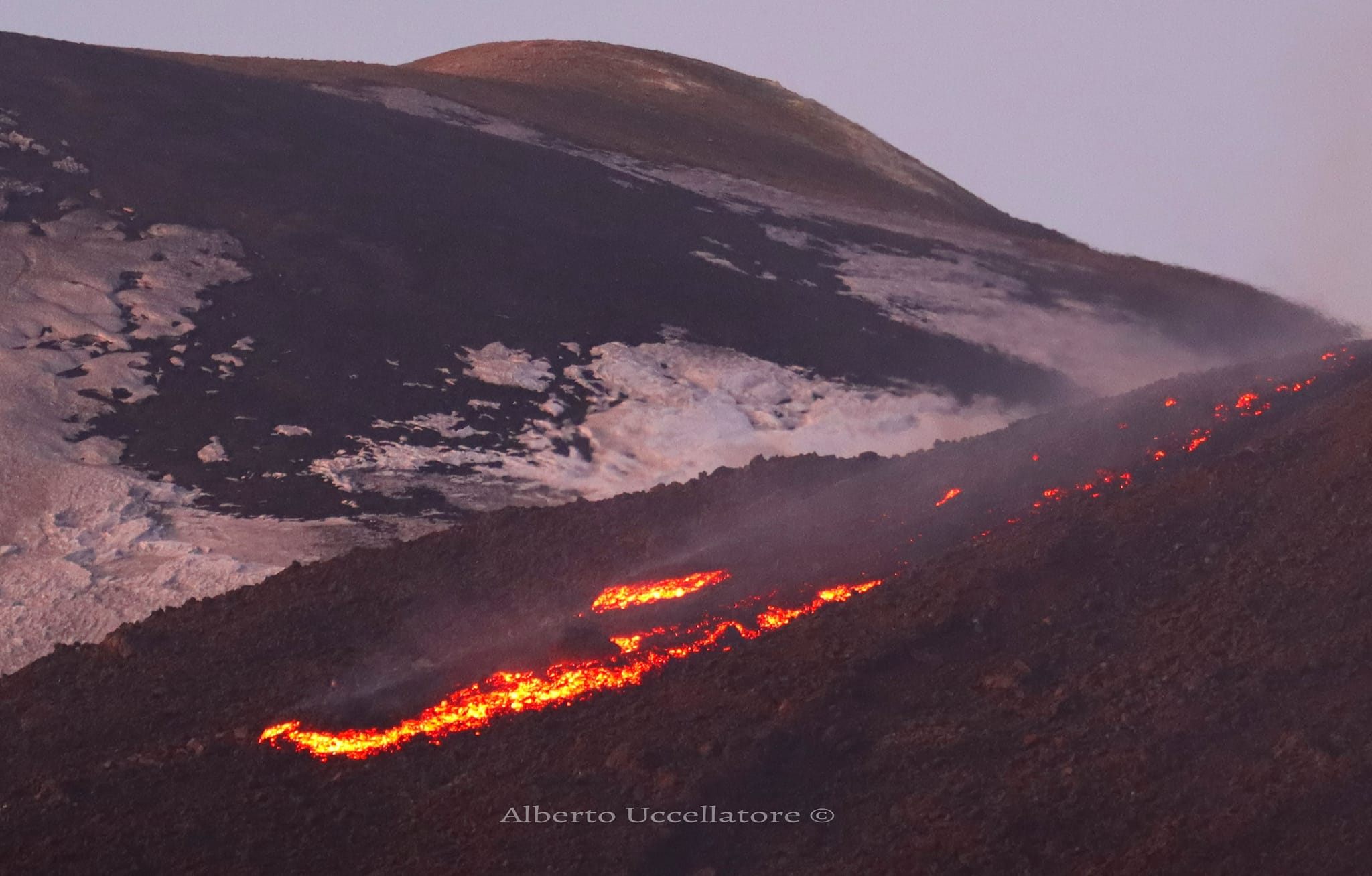
The lava flow from the SE crater (image: Alberto Uccellatore)
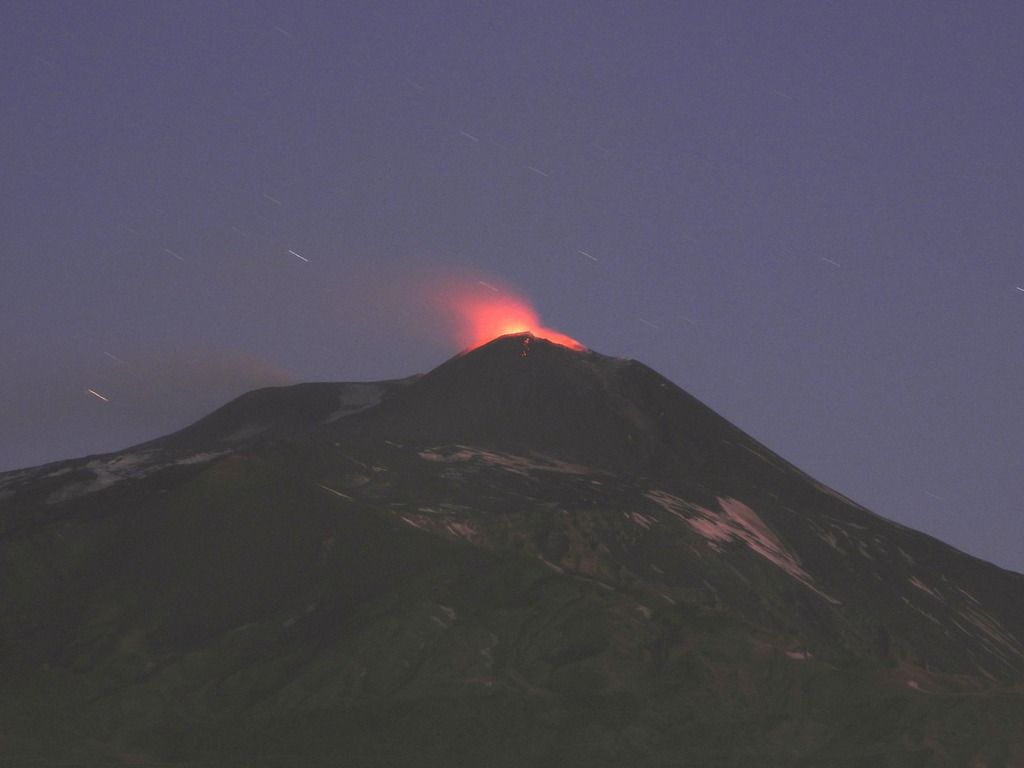
Mild strombolian activity at Etna (image: INGV)
The volcano observatory in Catania (INGV) reported that the explosive activity at the volcano's South East summit crater has been renewed last night.
Minor ash emissions have been rising from the crater, but from 01:30 local time today, volcanic tremor started to rise to average values.
The activity intensified about 13:30 local time, accompanied by a strongly rising signal of volcanic tremor, located at 2800 m elevation, indicating rapid magma flux towards the surface.
At 14:32 local time,
a new lava started overflowing the SE crater rim and has been emerging on the west-southwest slopes.
Strombolian activity picked up and became stronger at the SE summit crater starting around 16:00 local time accompanied by periods of high amplitude tremor. The lava has continued to ooze out, kept the flow active and reached approx. 2900 m elevation.
At about 20:40 local time,
a new lava-fountaining episode (classified as paroxysm) started at the SE summit crater producing a tall and dense ash and gas-rich plume that rose to estimated 10 km altitude drifting west.
The strong paroxysm episode followed a sharp peak in tremor.
The paroxysm activity culminated in (unusually, but common) three
pumice-and-ash flows observed at 20:40, 21:19 and 21:26 local time traveling in the Valle del Bove direction. Pumice-and-ash flows are the result of column (or fountain) collapse.
After the maximum amplitude of a seismic signal at 21:00 local time, volcanic tremor started to decrease back to medium values.
The fountaining activity ended, although the eruption column continues to dissipate to 8000 m height towards the west.
The lava flow remains active and the front seems to have cooled at 2700 m elevation.
Source: Istituto Nazionale di Geofisica e Vulcanologia volcano activity update 10 February 2022
A small pyroclastic flow during the paroxysm episode tonight (source: Boris Behncke)
We would like to show you embedded content from X/Twitter. If you like to see this content, please make sure you agree with the
privacy policy of X/Twitter and click the button:
View embedded content from X/TwitterLava fountains at the SE crater today (source: Boris Behncke)
We would like to show you embedded content from X/Twitter. If you like to see this content, please make sure you agree with the
privacy policy of X/Twitter and click the button:
View embedded content from X/TwitterStrombolian activity ceased
Update Sat 05 Feb 2022 02:39
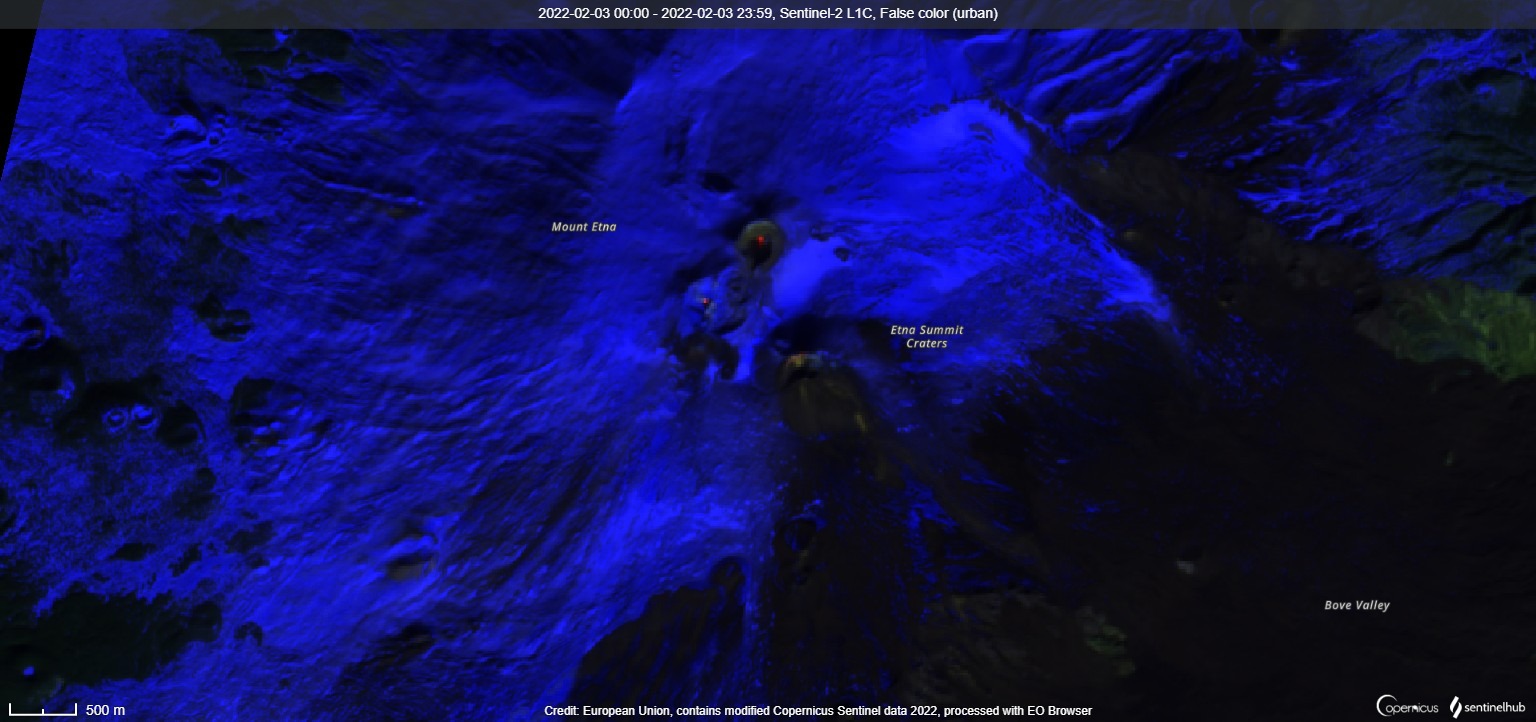
Satellite image from yesterday detected glowing craters only (image: Sentinel 2)
The volcano observatory in Catania (INGV) reported that strombolian activity at the volcano has ended for now.
The volcanic tremor continues at low levels as seismic signals are detected in the area between central craters and SE crater.
Source: Istituto Nazionale di Geofisica e Vulcanologia volcano activity update 4 February 2022Renewed strombolian activity continues
Update Tue 01 Feb 2022 02:34
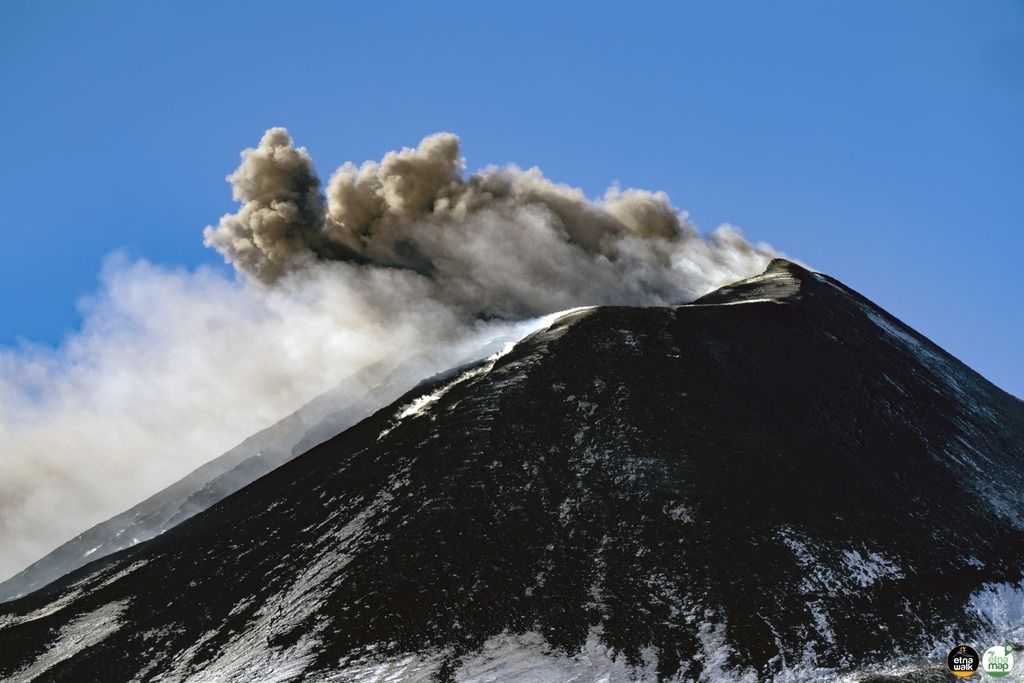
Ash emissions from the New SE crater yesterday (image: Etna Walk)
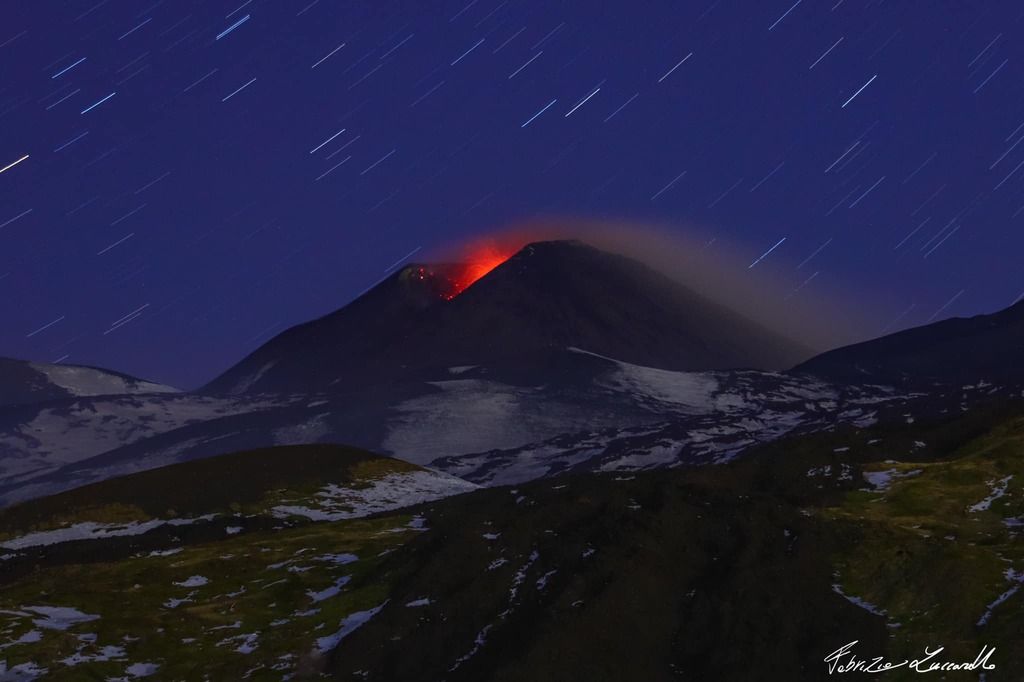
Strombolian activity at Etna yesterday (image: Fabrizio Zuccarello)
The volcano observatory in Catania (INGV) reported about the resumption of the activity after almost 7 weeks that picked up shortly after midnight, at around 00:15 local time yesterday.
Weak strombolian explosions continue from the New SE crater characterized by sporadic small-to-moderate ash emissions and glowing ejecta thrown from the crater.
The volcanic tremor has been located on the SE of the New SE crater at 3000 m elevation accompanied by medium-to-low values.
Source: Istituto Nazionale di Geofisica e Vulcanologia volcano activity update 31 January 2022Etna quiet again after ash-rich eruptive phase
Update Wed 15 Dec 2021 17:52
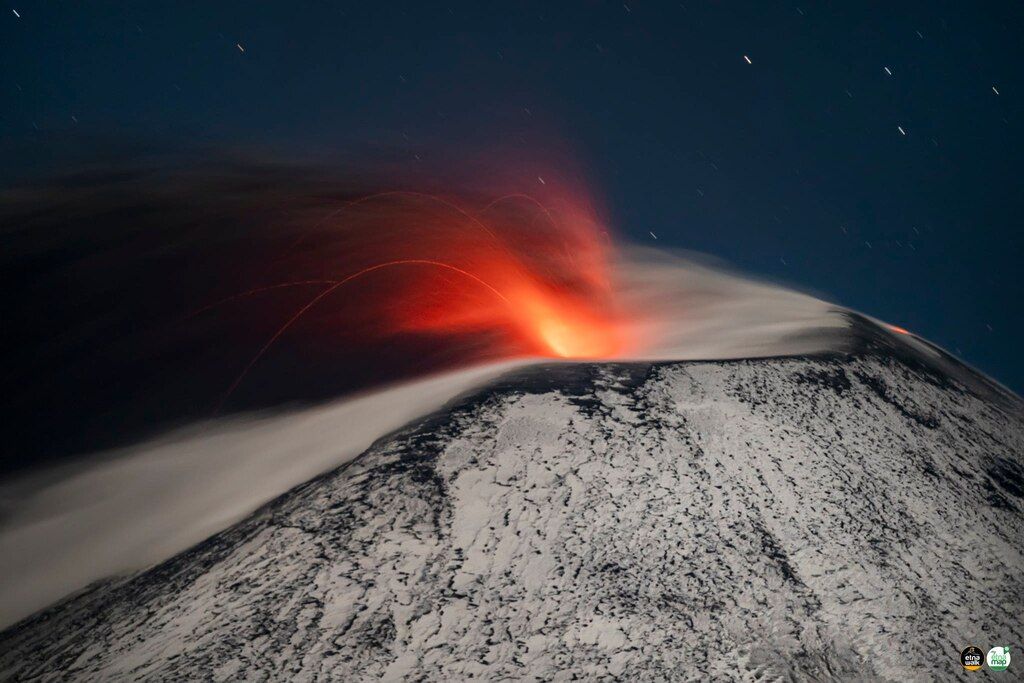
Strombolian activity at Etna's New SE crater last night (image: Giuseppe Distefano / Marco Restivo / Etna Walk / facebook)
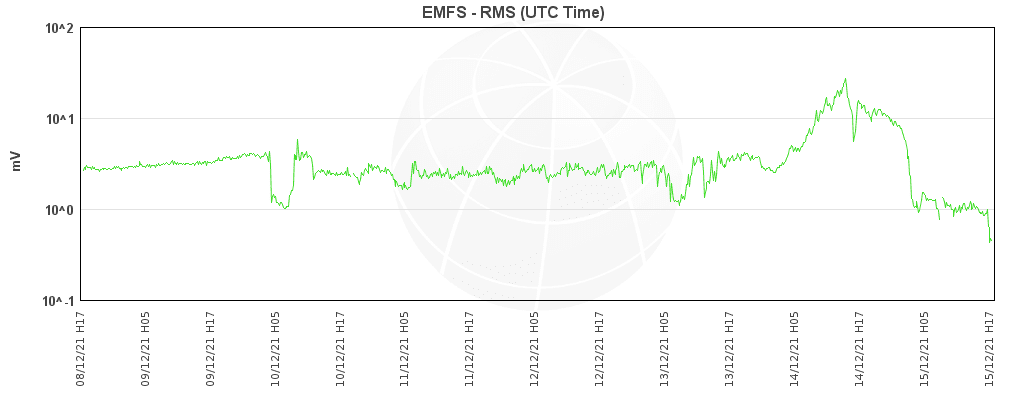
Current tremor amplitude EMFS station (image: INGV Catania)
The activity from the New SE crater yesterday did not develop into a lava fountaining phase such as the many paroxysms observed during this year, although it shared many characteristics of it.
Rather than sustained fountains with significant amounts of liquid lava bombs, it produced mostly a dense ash column that rose up to 6-7 km altitude (much less than during most paroxysms).
Only little glowing material could be seen in the eruption column. Activity waned at around 5 pm., then picked up again during the evening, to continue with less intensity and mild strombolian eruptions during much of the night. It gradually decreased in the early morning hours and seems to have stopped by now.
The small lava flow that had been erupted in the Valle del Bove during the day before yesterday and yesterday has also stopped.
Etna is again calm, but for how long nobody knows...
Some images of yesterday's activity from
Etna Walk:
Increasing ash emissions, New SE crater heading for paroxysm
Update Tue 14 Dec 2021 14:27
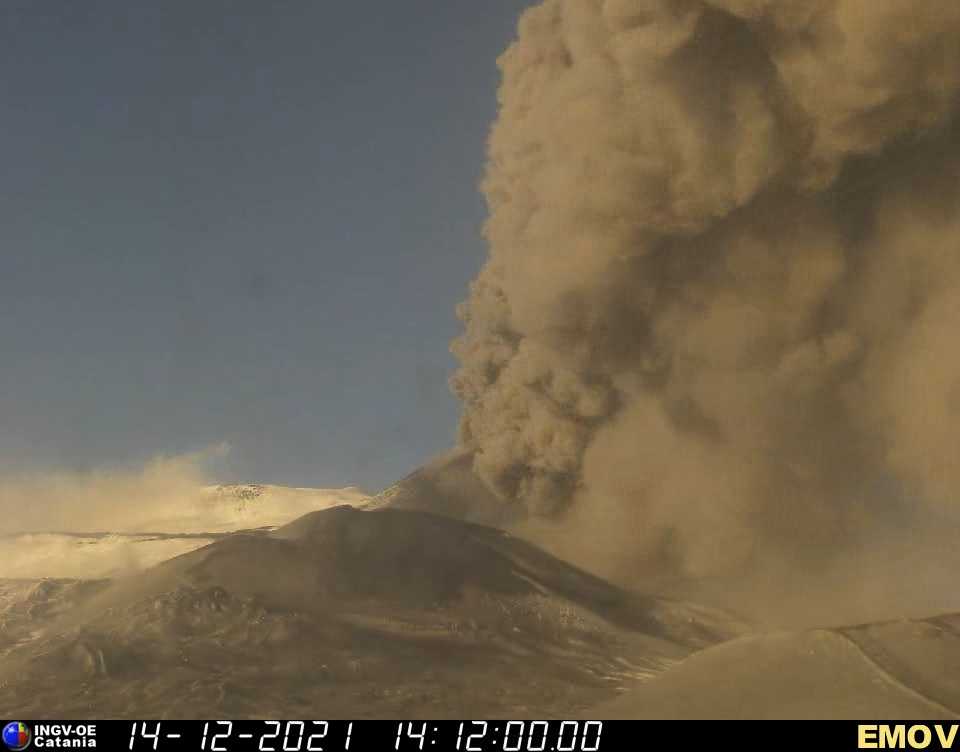
Ash column rising from the New SE crater at 15.20 local time (image: INGV webcam Montagnola)
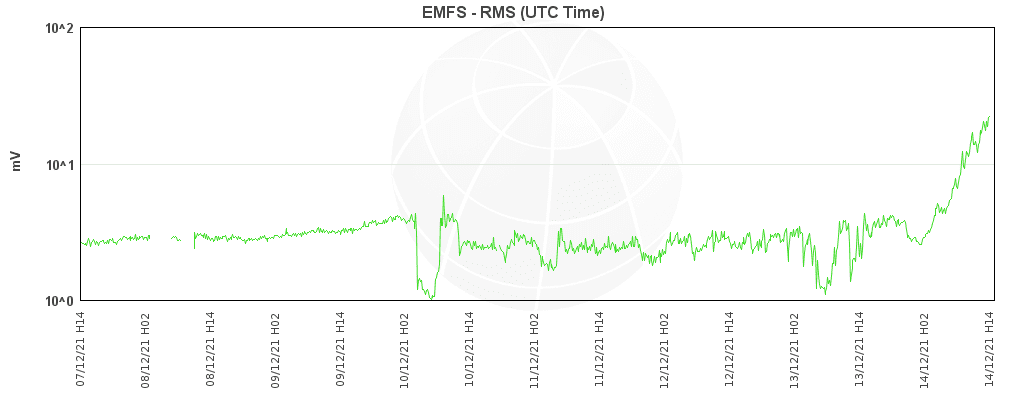
Volcanic tremor amplitude showing the increase typical for paroxysms in their build-up stage (image: INGV Catania)
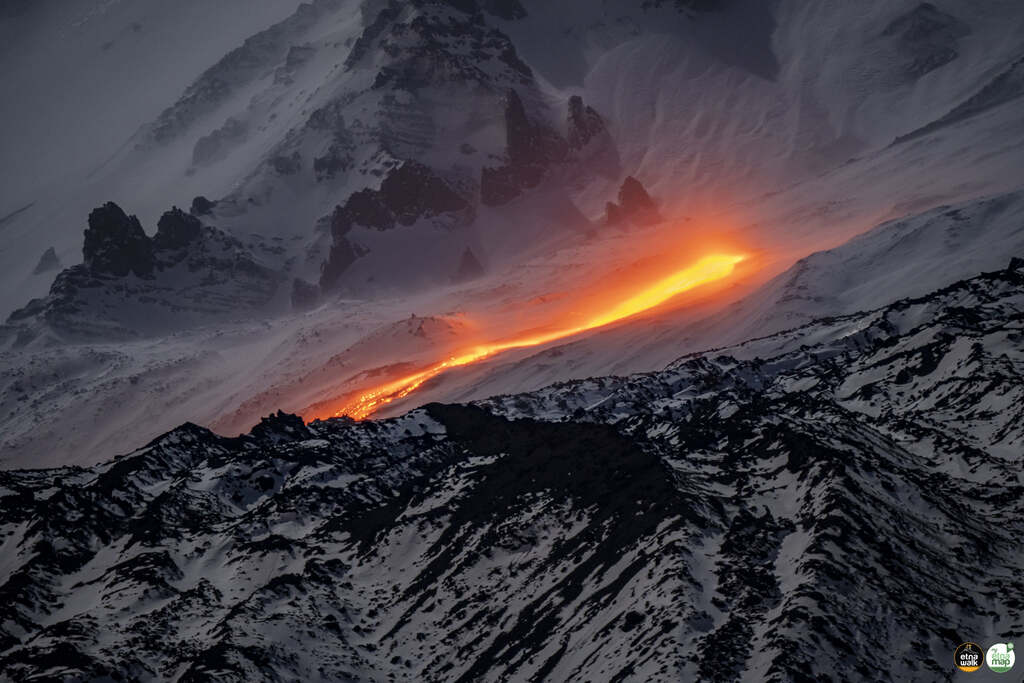
Last night's lava flow in the Valle del Bove (image: Giuseppe Distefano / Marco Restivo / EtnaWalk / facebook)
The activity at the New SE crater has been increasing, with dense ash columns rising to estimated 20,000 / 6 km altitude or more. At the same time, volcanic tremor has been increasing as well. It looks likely that the volcano is about to produce another lava fountaining-phase, known as paroxysm from its most active summit vent.
It is unclear at the moment whether the lava effusion from the small fissure vent in the Valle del Bove that had opened yesterday still continues.
It had been modestly active throughout the night, producing a small lava flow, but there was no sign of explosive activity. Volcanologists interpreted it as old (degassed) magma from the conduit leading towards the summit vents, that had simply "leaked" through a small lateral fissure. No inflation or particular seismic signals that would be typical for larger flank eruptions involving new magma had been detected accompanying it.
Etna volcano (Italy): new eruptive phase, dense ash emissions from New SE summit crater
mar., 14 déc. 2021, 12:04 12:04 PM | AUTEUR : T
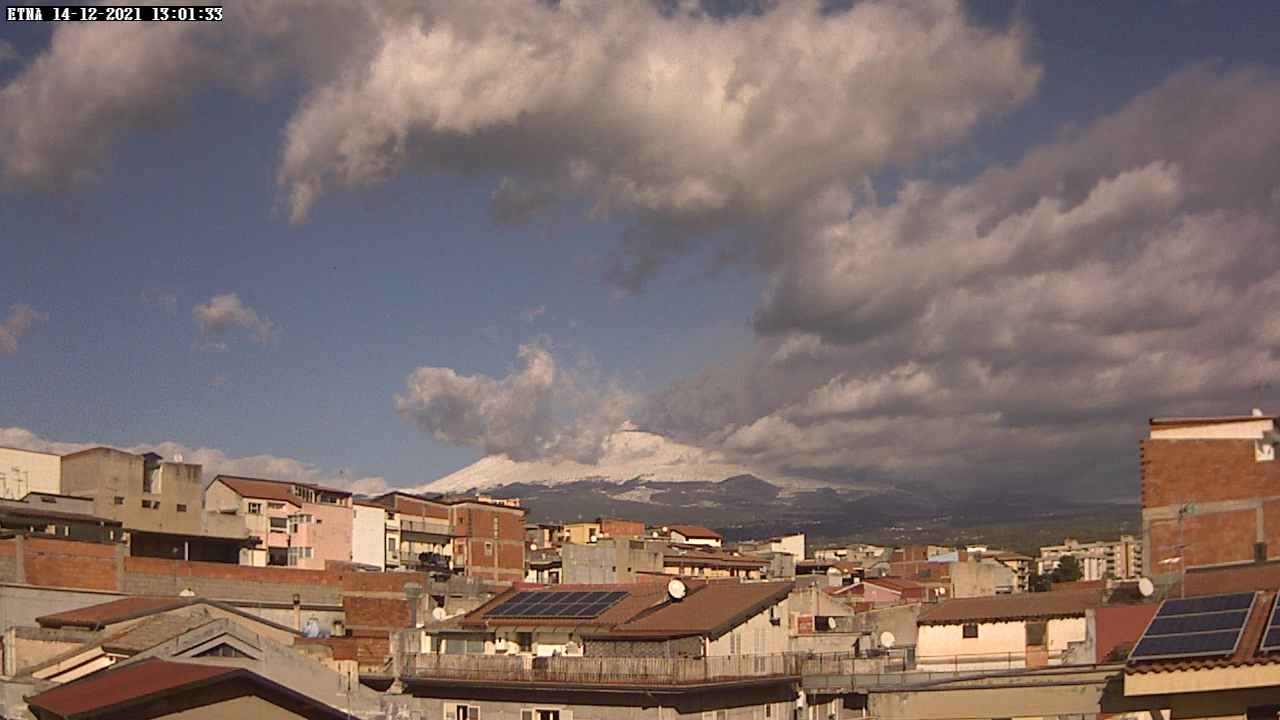
Dense ash emissions from the New SE crater of Etna a few minutes ago (image: Radio Touring webcam)
A new phase of activity seems to have started a short time ago. Dense ash plumes started to rise from the New SE crater around noon local time.
We will follow up when more details become available.
Etna volcano (Italy): new lava flow in Valle del Bove
lun., 13 déc. 2021, 22:36 22:36 PM | AUTEUR : T
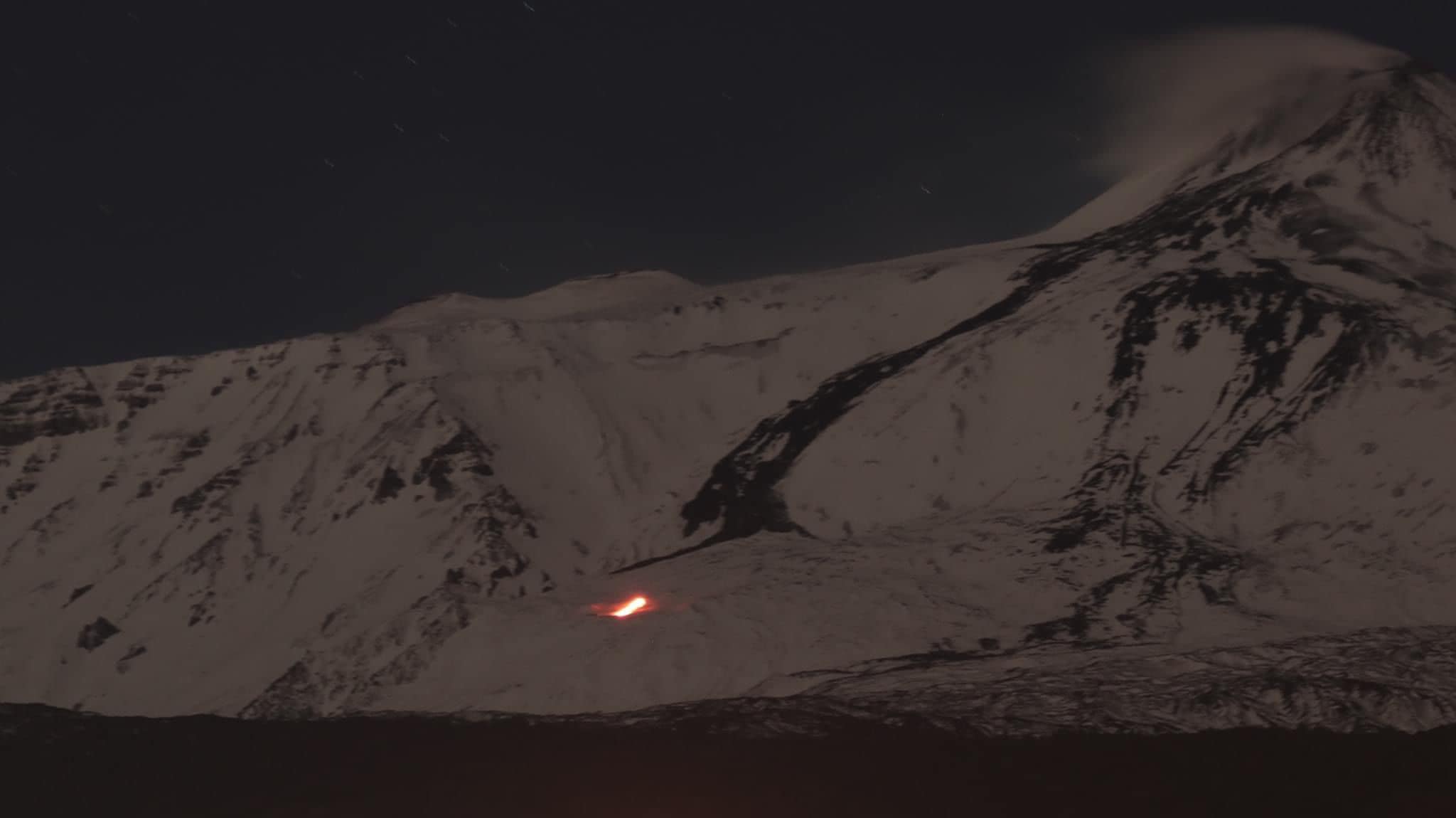
The new vent and lava flow in Etna's Valle del Bove (image: Francesco Caltabiano / EtNativo / facebook)
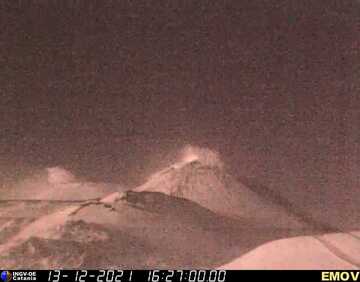
Mild strombolian explosion at the New SE crater in the evening (image: INGV Catania Montagnola webcam)
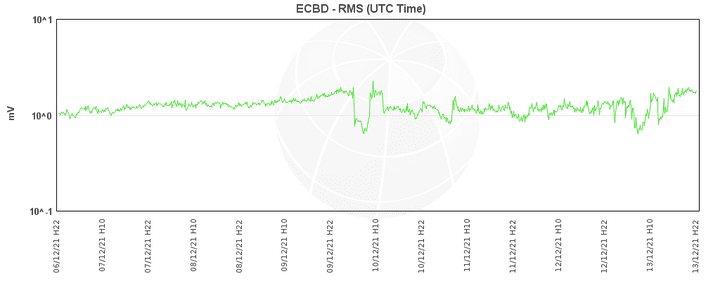
Current tremor amplitude at ECBD station (image: INGV Catania)
A (so far) very small flank eruption started this afternoon or evening in the Valle del Bove at around 2,100-2,200 meters elevation. At the base of the western wall of the volcano's large U-shaped depression on the eastern flank, a fissure opened and became an effusive vent, from which a small lava flows has been descending during the past hours.
So far, this activity has been very small. Volcanic tremor has risen only a bit, and no other data suggest that we're about to witness the beginning of a larger flank eruption (although this is still a possibility). At the same time, intermittent, mild strombolian activity continues from the New SE summit crater. Likely, some of the magma inside the conduit feeding this crater has found a lateral exit at lower elevation - the question will be whether this lateral dike can expand and more effectively create a way out for magma stored, or whether it might soon close up again.
Photo credit: Francesco Caltabiano / EtNativo / facebookWeak but constant strombolian activity continues
Update Mon 06 Dec 2021 18:14

Continuous ash emissions from Etna today (image: Boris Behncke/twitter)
Ongoing strombolian activity is now in progress from the South-East crater characterized by weak ash emissions extending to the E-NE of the volcano today.
A volcanic tremor has slowly increased, but remains at medium values detected at 2700 meters altitude.
No significant ground deformation was recorded.
Strombolian activity started and may trigger paroxysm
Update Sat 04 Dec 2021 18:40
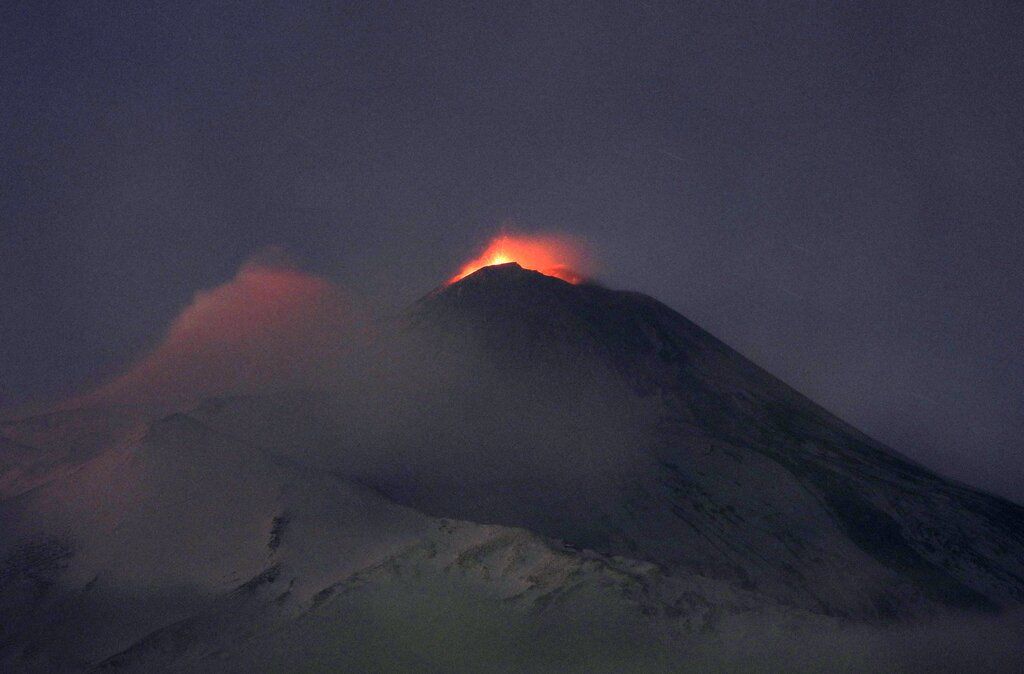
Strombolian activity at Etna volcano tonight (image: Boris Behncke/twitter)
After a six weeks since the last strong eruptive episode (classified as paroxysm), it seems the activity to have picked up again.
The volcano observatory in Catania (INGV) reported that strombolian explosion started from the South-East crater at 16:10 local time today.
The instruments detected a strongly rising signal of volcanic tremor indicating rapid magma flux towards the surface, typical sign for an impending series of paroxysm in the coming days, weeks.
Weak explosions reported from Northeast crater
Update Sat 20 Nov 2021 17:49

Steam plumes rising from Etna's Bocca Nuova summit crater (image: INGV Catania webcam)
In the past weeks, Etna has been more or less calm. Today, small intermittent explosions resumed at the North-East crater, the volcano observatory in Catania (INGV) reported.
According to a report, these explosions began at 11.16 a.m. local time and have been producing small ash plumes that dispersed quickly in the area of the summit craters. Volcanic tremor shows no significant variations and remains at low to medium levels.
Apart from this, the Bocca Nuova seems to be the most active crater at the moment, producing dense steam plumes with some pulsating activity as can be seen in the image attached.
Occasional ash emissions from SE crater
Update Thu 28 Oct 2021 18:49
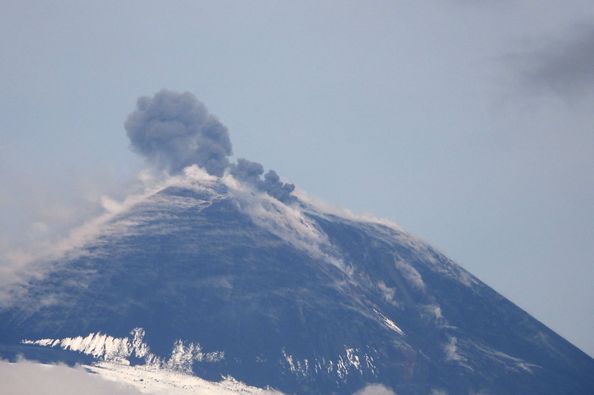
Ash emission from Etna's SE crater (image: Boris Behncke / facebook)
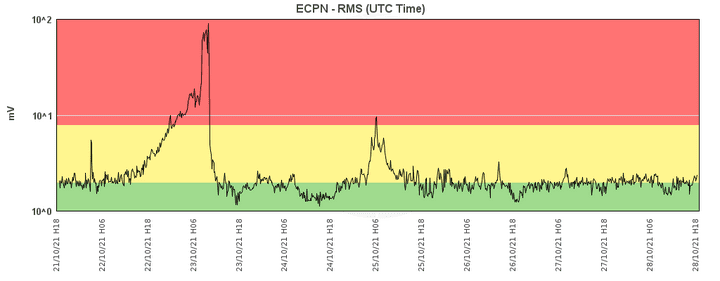
Current tremor signal at Etna's ECPN station (image: INGV Catania)
After last Saturday's paroxysm, the volcano has not remained completely calm, but produces ash emissions from the New SE crater from time to time.
Volcanic tremor is at low to moderate levels, something that can change any time.
Etna volcano (Italy): violent eruptive episode, parts of SE crater collapse into dangerous pyroclastic flows
sam., 23 oct. 2021, 10:52 10:52 AM | AUTEUR : T
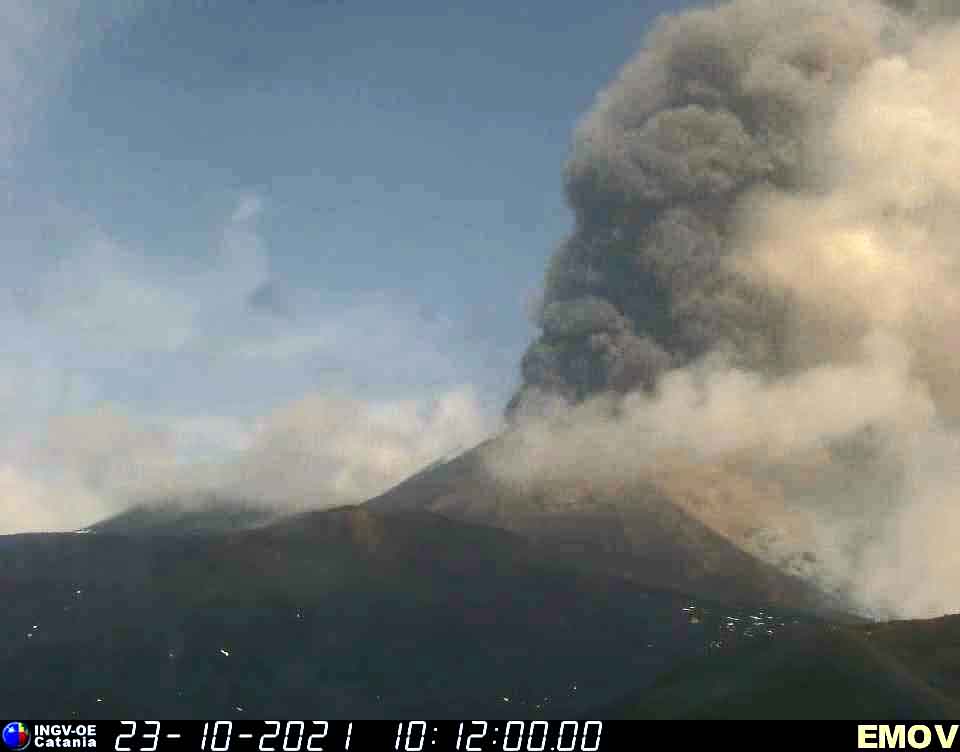
Etna volcano near the end of this morning's paroxysm (image: Montagnola webcam of INGV Catania)

Current tremor signal showing the peak of this morning's paroxysm (image: INGV Catania)
A strong paroxysm is in progress at the volcano. As suspected already last night by the presence of intermittent strombolian activity and the slowly rising tremor, this activity continued to evolve gradually throughout the night and early this morning.
Tremor reached high levels at 7.40 a.m., followed by a strong increase of explosive activity at the SE crater from 10.15 a.m.
Lava fountaining was observed to have started at around that time, and lasted until 12.20 p.m. It generated a dense ash plume that rose several kilometers and drifted east, producing ash falls in the area of Piedimonte and Linguaglossa.
The eruption was characterized by several collapse events on the eastern sides of the crater, which generated
pyroclastic flows - hot turbulent avalanches of loose lava material, and extremely fast-moving and dangerous as everything in their path is being destroyed.
The first was observed at 10.49 a.m., when parts of the eastern crater wall broke into an avalanche heading towards the Valle del Bove and traveling about 1.5 km distance. Additional pyroclastic flows with similar mechanism took place at 11.02, 11.30 and/or 11.37, and 11.58 a.m.
A lava flow was erupted from the breached SE crater heading towards the east into the Valle del Bove as well.
Watch the eruption filmed by LocalTeam:Volcanic tremor slowly rising
Update Fri 22 Oct 2021 16:09
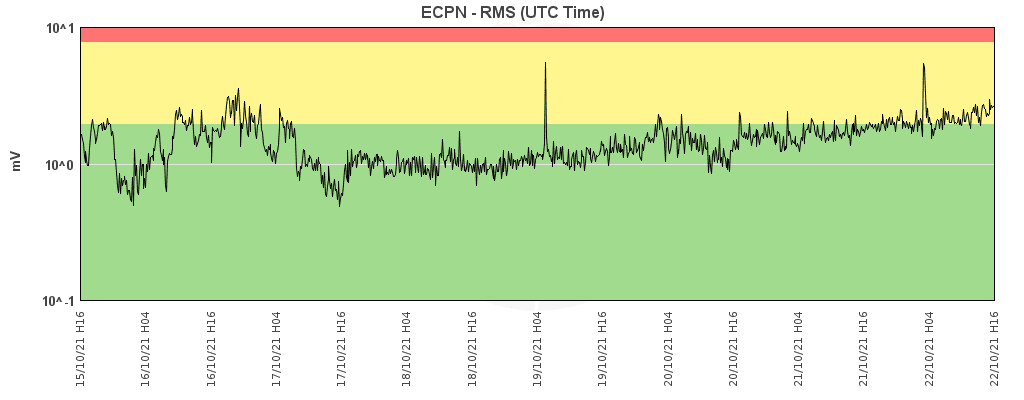
Current tremor signal at Etna's ECPN station (image: INGV Catania)
In tandem with the reported increase of activity in form of strombolian explosions at the SE crater, volcanic tremor has been gradually rising.
Whether this is a first sign the volcano is heading towards another fire-fountaining episode, known as paroxysm, as it did more than 50 times this year alone so far, will be likely seen in the near future (hours to few days from now).
Etna volcano (Italy): resumption of strombolian activity after month
ven., 22 oct. 2021, 07:14 07:14 AM | AUTEUR : MARTIN

Strombolian activity at Etna volcano this morning as seen from Tremestieri (image: Boris Behncke)
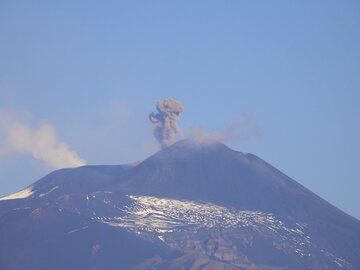
Ash emissions at Etna volcano today (image: Boris Behncke)
After one month since the latest paroxysm episode, strombolian activity has picked up again at 02:47 local time yesterday.
Small strombolian explosions started to erupt from the Southeast Crater, which became gradually stronger on 21 October at 17:20 local time and are still continuing at the time of this update.
Sporadic ash emissions are accompanied by small glowing steam and gas plumes dispersing towards the E and SW.
The average amplitude of volcanic tremor varies between low-to-medium levels located at altitude between 2900 m and 3000 m.
Source: National Institute of Geophysics and Volcanology volcano activity update 21 October 2021Volcano remains restless
Update Fri 22 Oct 2021 07:02
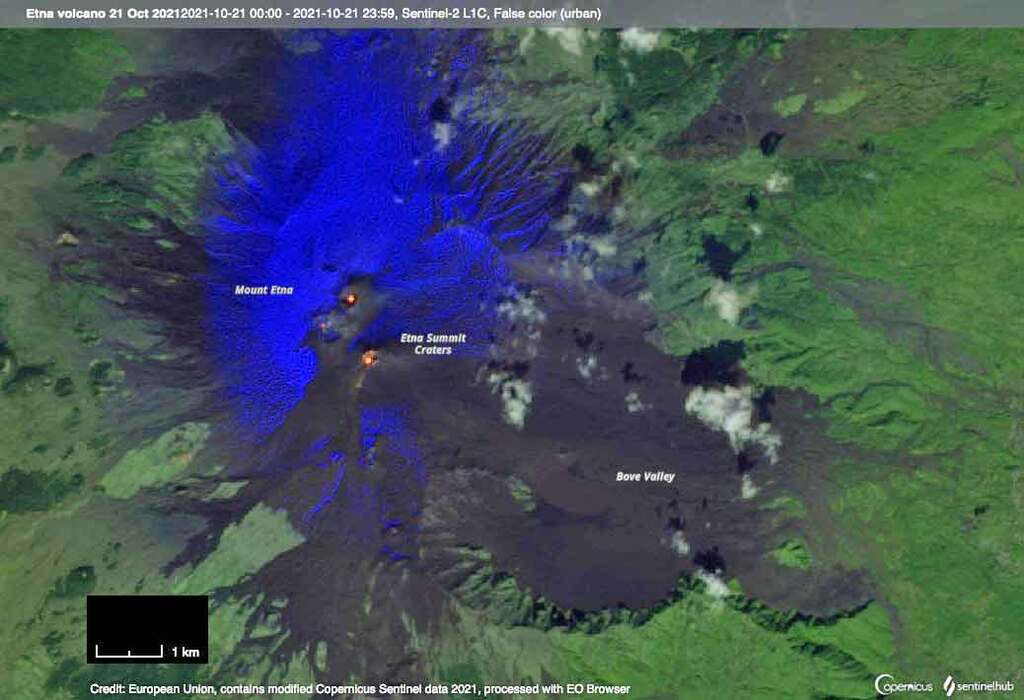
False-color satellite image of Etna volcano on 21 Oct 2021, emphasizing thermal anomalies in the summit craters (image: Sentinel Hub)
The volcano has remained more or less calm, but it is only a matter of time when activity will pick up again.
The summit craters continue to show marked thermal anomalies at the New SE crater, Voragine and Bocca Nuova complex as well as the NE crater. All of these emit gas and steam plumes and instruments detect frequent small acoustitc signals from dee-seated explosions, likely strombolian in type.
The
volcanological institute of the University of Florence (LGS) reported more than 6000 infrasonic (explosion-related) events during 24 hours, with maximum pressures of up to 3.21 Pa. Volcanic tremor remains low, but as often in the past, it can change very quickly.
Etna volcano (Italy): new paroxysm from SE crater sends tall ash plume to 9,000 m altitude
mar., 21 sept. 2021, 08:54 08:54 AM | AUTEUR : T

Ash column from Etna's paroxysm this morning (image: Radio touring webcam)
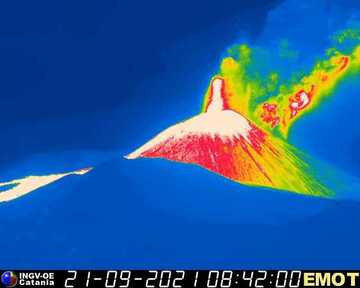
Thermal image of the lava fountain from the south (image: INGV webcam)
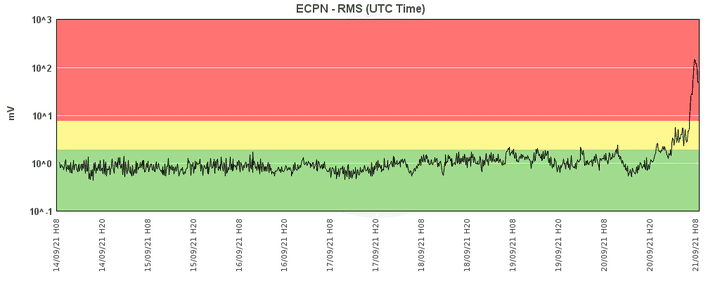
Current tremor signal (image: INGV Catania)
After little more than 3 weeks of calm, the volcano has again produced a violent lava fountaining episode, known as paroxysm, from its SE crater this morning:
At 4.20 a.m. local time, volcanic tremor suddenly began to rise sharply. At 8.15 a.m., ash emissions were seen from the New SE crater, and strombolian explosions started a7 8.55 a.m., generating an ash plume that quickly rose to 4,500 m altitude.
This activity continued to increase, and by 9.55 a.m. resulted in lava fountaining that generated a tall column reaching approx. 9,000 m height and drifting to the ENE. At the time of this update, the activity is still going on, but seems to be reaching its end as tremor started to descend again.
As during the previous paroxysms, a lava flow is traveling from the southern rim of the crater towards the SW.
Etna volcano (Italy): after 3 weeks of calm, another lava fountaining phase is in the making tonight
dim., 29 août 2021, 15:49 15:49 PM | AUTEUR : T
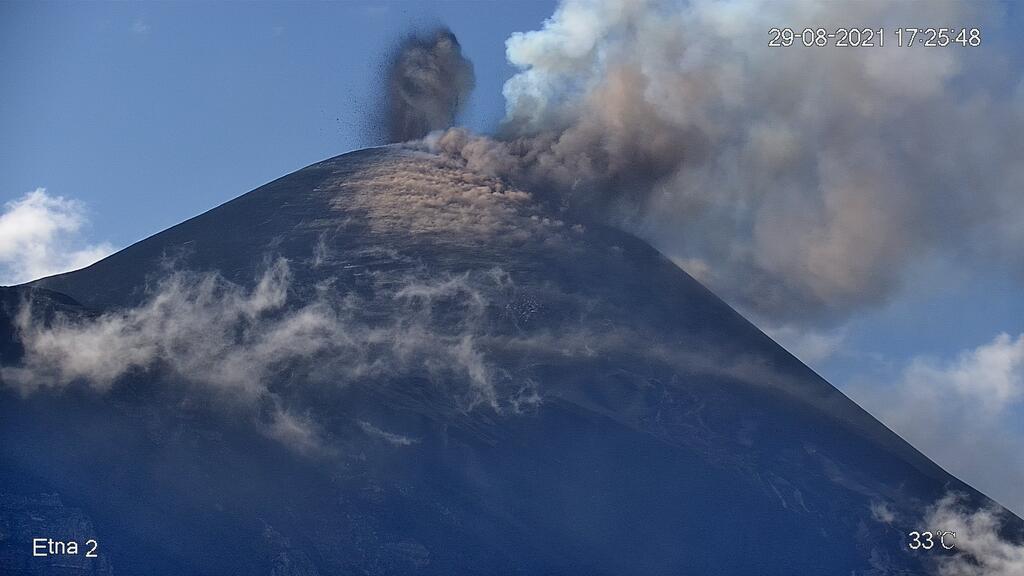
Strombolian eruption from the New SE crater of Etna (image: LAVE webcam)
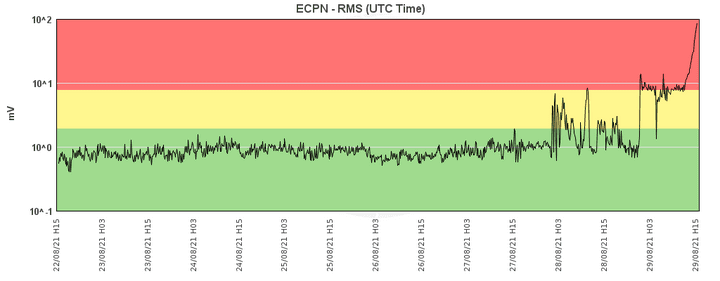
Current tremor signal (image: INGV Catania)
After being mostly calm for about 3 weeks since the violent SE crater paroxysm (or lava fountaining episode) on 9 August this year, the volcano seems to be keen to produce this fiery show of lava fountains once again before the month is over:
Already yesterday, fluctuating tremor heralded some sort of instability in the supply system, although no significant eruptive activity at the craters itself could be noted. Today, the tremor began to rise steeply at 3pm, followed by the resumption of intermittent strombolian activity at the New SE crater.
So far, all looks as if very soon a lava fountaining phase should occur if the volcano follows the pattern of the more than 50 such previous phases during this year. In fact, at the time of finishing this update, the activity already has increased! The next hours will be interesting to
follow the volcano live.
Small pyroclastic flow during small landslide on east flank of SE crater
Update Mon 09 Aug 2021 14:26
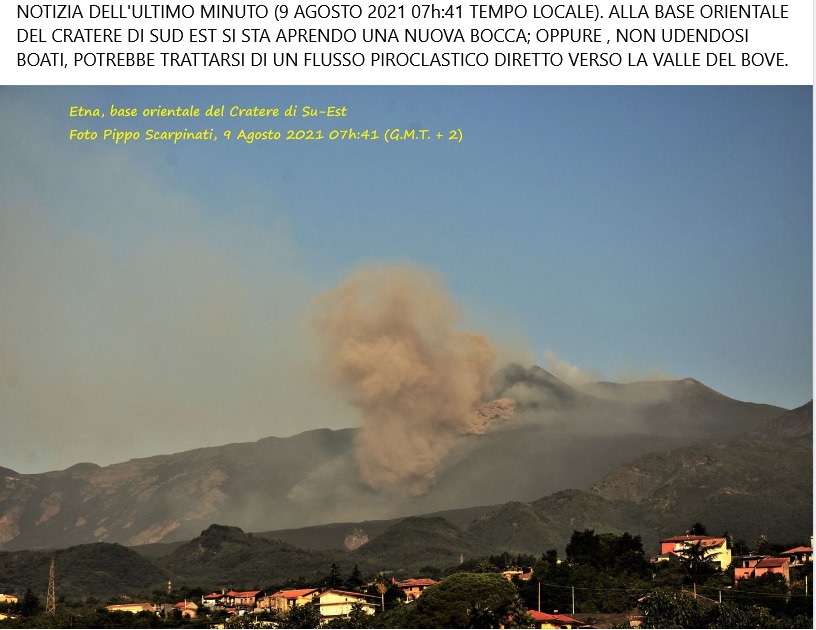
Small pyroclastic flow from the lower eastern SE crater flank (image: Pippo Scarpinati via Alessandro Corsaro / facebook)
At 7.41 am local time, an avalanche of brown ash could be seen originating from a point on the lower east flank of the New SE crater and descending several 100 meters towards the Valle del Bove.
While it looks as if a new vent opened, according to INGV Catania, it was a small landslide from the eastern flank of the SE crater and only involved cold material, without involving a new vent (which would have shown as hot thermal signals).
Etna volcano (Italy): lava fountains and loud explosions wake up residents
lun., 9 août 2021, 07:19 07:19 AM | AUTEUR : T
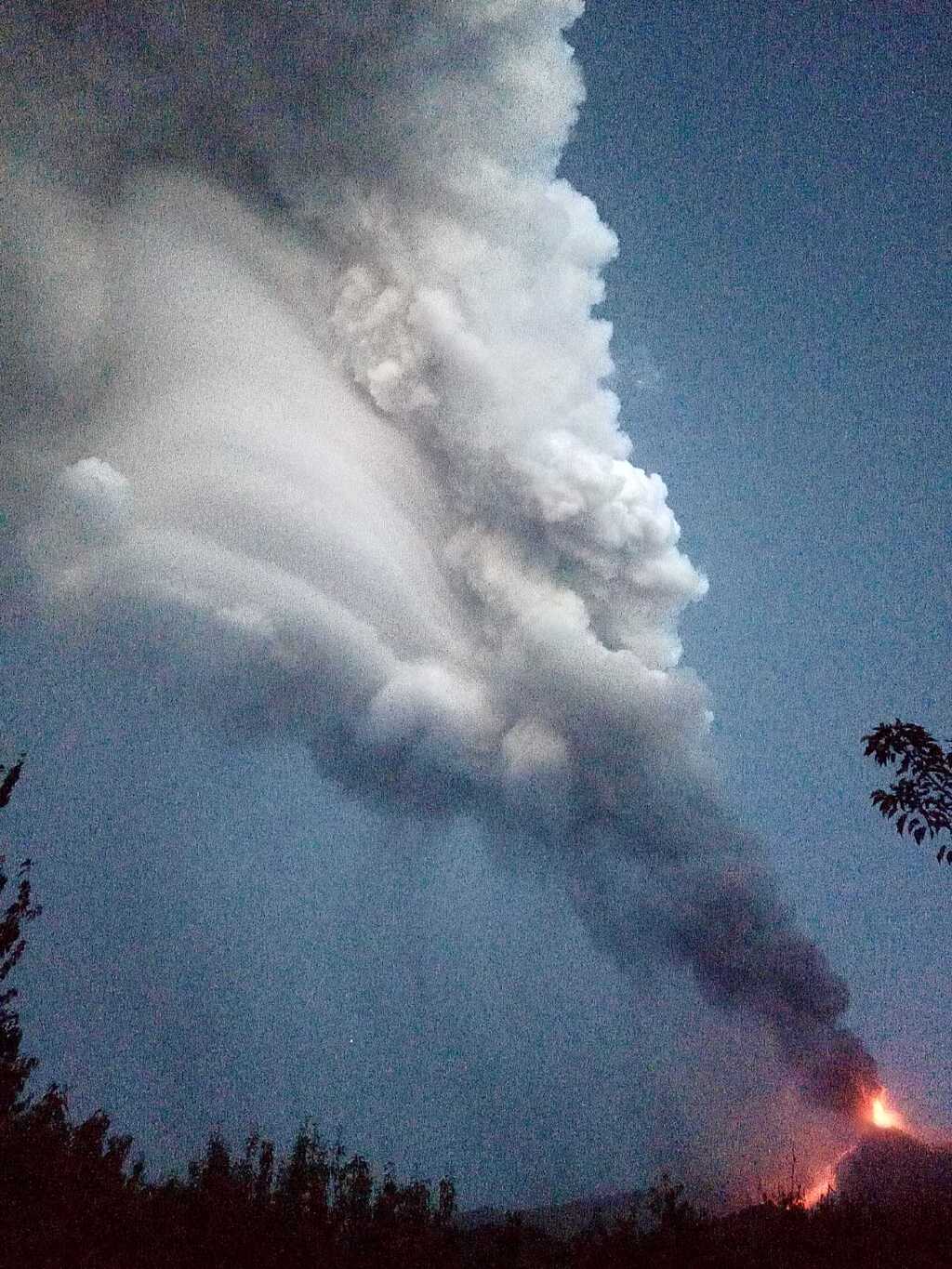
Lava fountain at Etna this morning (image: Franca Fulle)
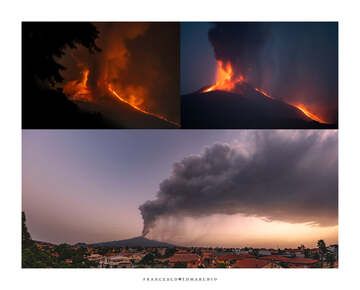
Images of the paroxysm by Francesco Tomarchio (Image: Francesco Tomarchio / facebook)
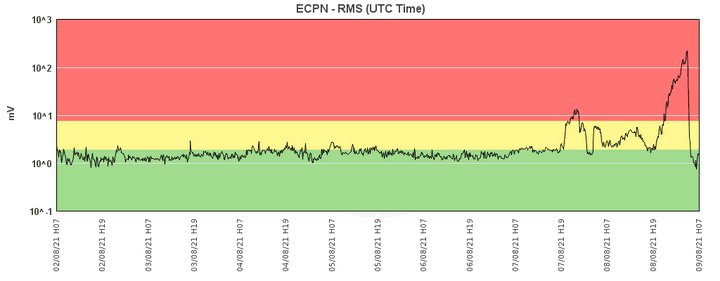
Current tremor signal showing the peak of this morning's paroxysm (image: INGV Catania)
After little more than a week, another lava fountaining episode or paroxysm occurred from the New SE crater early this morning.
After a brief episode of ash emissions from the NE crater on 4 August, the volcano continued to be calm until yesterday, when first signs of a reawakening appeared in form of intermittent strombolian explosions at the New SE crater, along with fluctuating tremor with peaks reaching moderate values.
This activity gradually picked up late at night and peaked after midnight and reached lava fountaining in the early hours around 3 am local time. Again, a tall eruption column rose several kilometers from the summit of Etna and spread into a plume that drifted east. At least two lava flows were produced as well: one towards the SW "as usual", another one down the SE flank into the upper Valle del Bove.
The lava fountains might not have reached the same intensity as during the exceptionally violent preceding 31 July-1 Aug paroxysm, but the volcano greeted people living around the mountain with a series of particularly strong explosions of large bursting lava bubbles from the crater that generated shock waves that rattled windows and doors in more than 15 distance and kept many people awake to watch the mesmerizing show from the volcano.
As long as these paroxysmal eruptions, or eruptive phases, now the 53rd in a row since February this year, continue from the New SE crater in the summit area, they pose no danger to the surroundings, only great annoyance with the frequent ash and lapilli fall deposits in varying sectors, but most frequently the eastern ones affected where people almost constantly need to clean roofs and surfaces including roads from the black volcanic ash.
Impressive SO2 plume from latest paroxysm drifting over Ionian Sea and Greece
Update Mon 02 Aug 2021 04:35
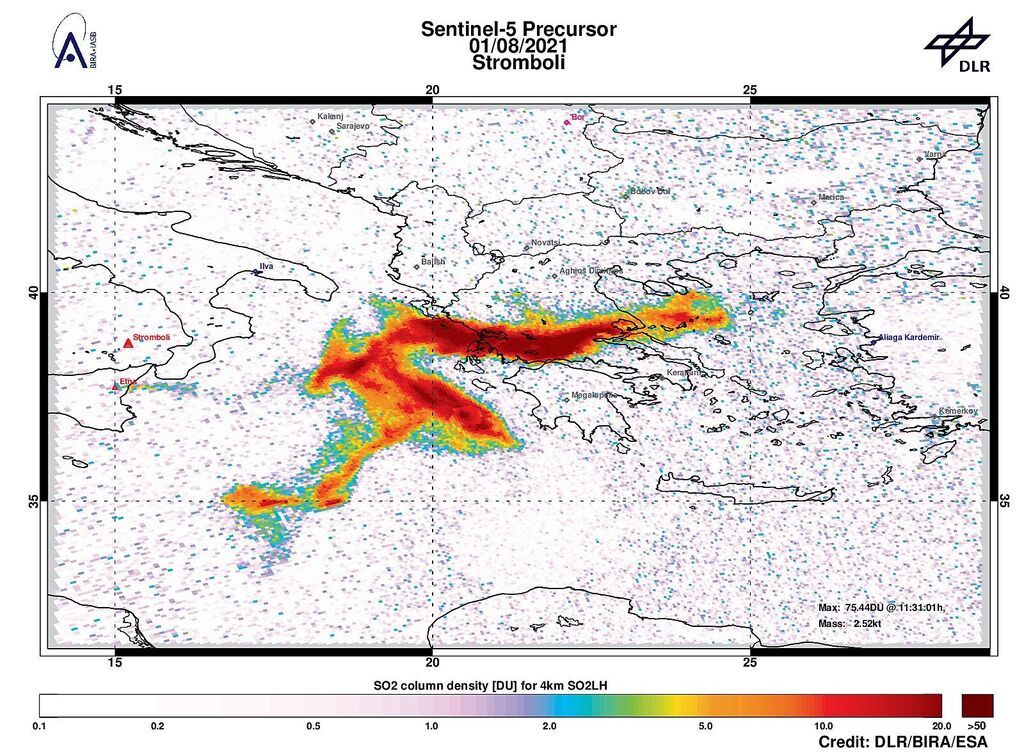
SO2 plume from Etna's 31 Jul-1 Aug eruption seen on Sentinel-2 satellite data (image: @DlrSo2/twitter):
The SO2 aerosol plume from the volcano's latest paroxysm during the night Saturday-Sunday can be traced drifting over the Ionian Sea and Greece now, extending more than 430 km east.
Note that the automatic association of "Stromboli" as the volcano culprit in the image attached is wrong; the plume is from Mt Etna - the system tries to match the closest active volcano, which is usually, but like here not always the source of the emission.
Update Sun 01 Aug 2021 19:35
Francesco Tomarchio sent us a small selection of his videos and photos he took during the remarkable and very powerful lava fountaining episode from Etna's New SE crater on 31 July-1 Aug 2021:
See the photos!At 52 lava fountaining eruptions and counting, Etna is poised to break Olympic records
dim., 1 août 2021, 18:46 18:46 PM | AUTEUR : T
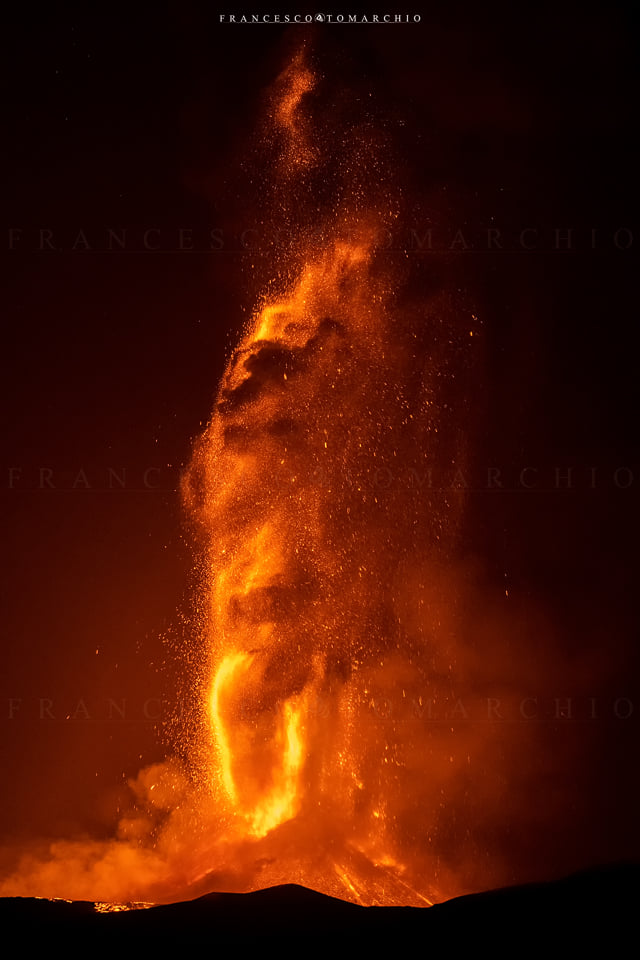
Lava fountain over 1000 m tall at Etna's New SE crater last night (image: Francesco Tomarchio / facebook)
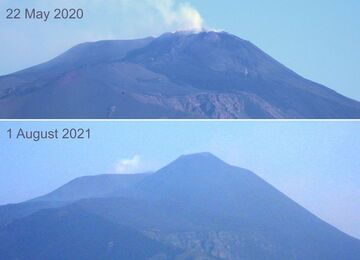
Extremely rapid growth of the SE crater during the past months (image: Boris Behncke / facebook)
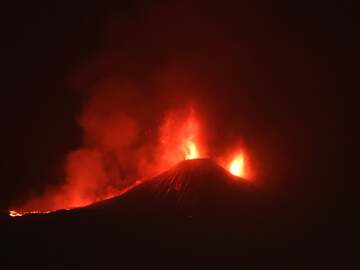
Main and eastern vent active during the eruption (image: Boris Behncke / facebook)
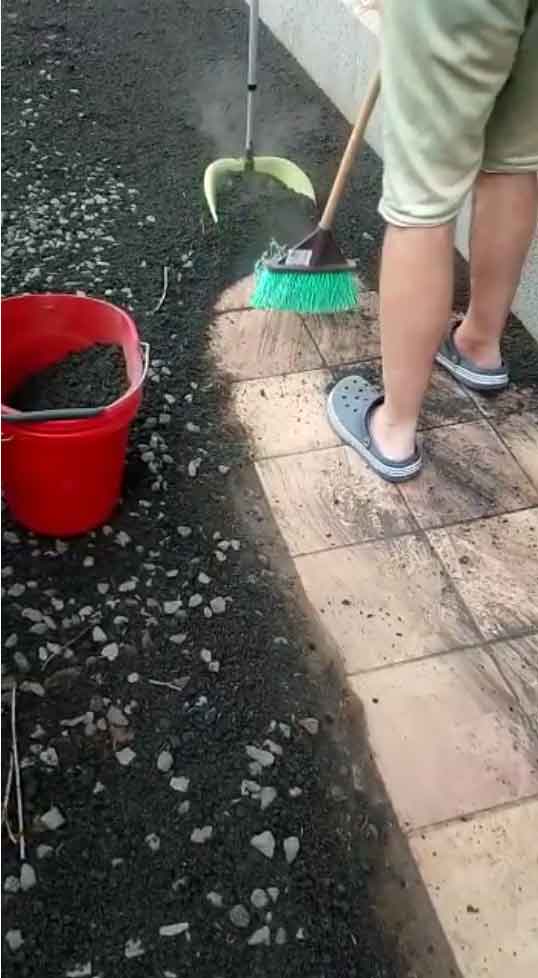
Cleaning up the ash fall in 10 km distance on the eastern flank (image: Franca Fulle)
Last night's lava fountaining episode paroxysm at the New SE crater came after one of the longest-so-far intervals in the recent record-breaking series of paroxysms, but certainly was also one of the most impressive and powerful ones.
At its peak lava fountains probably surpassed 1000 m in height and the duration of the lava-fountaining phase also was remarkable with about two hours.
See photo gallery!Noteworthy was also that the eastern vent of the New SE crater had become active again during the eruption, resulting in a second lava flow towards the north (in addition to the “usual” lava flow towards SW).
Thanks to only little wind and shifting directions, multiple sectors around the southern and eastern flanks of Etna received heavy ash and lapilli fall - something this year has seen a lot of already...
Record-breaking seriesThe ongoing series of paroxysms at the New SE crate had started in Feb 2021, paused for several weeks after 17 events until 1 April, only to restart strongly on 19 May, entering a hectic rhythm of one eruption every few days (or sometimes less), often in sequences of near-identical intervals repeated many times. The short intervals lasted until the paroxysm during the night 8-9 July, after which the intervals have increased: the next ones occurred on 14 July, 20 July, and now 31 July-1 August 2021, which marks the 52nd event in total!
The only known series of paroxysms at Etna with a greater number occurred in 2000, when the then-much-smaller SE crater produced a total of 66 fire-fountaining phases between January and August. However, who knows where the current series is ending and whether Etna has put herself the challenge to exceed that number this time, while we have belayed Olympic Games?
New summit of Etna volcanoAnd once again, the New SE crater has gained probably several meters in height, now clearly forming the volcano's summit at probably 3400 or more altitude. The deposits of the recent lava fountains have drastically changed the morphology of the crater complex, building a cone, as if a miniature volcano, on top of the former saddle vent area of the SE crater.
Video of the eruptionThe eruption last night was once more a great show of fire and fury, marvellously captured by photographer Francesco Tomarchio:
Links:
Francesco Tomarchio / facebook)Boris Behncke (facebook)Paroxysm seems ending after 2 hours of intense lava fountaining
Update Sat 31 Jul 2021 23:40
Short time after the previous update, activity is now decreasing rapidly; the paroxysm is likely to be over soon. However, the lava fountaining phase lasted about 2 hours!
Violent lava fountaining phase at New SE crater in progress
Update Sat 31 Jul 2021 23:27
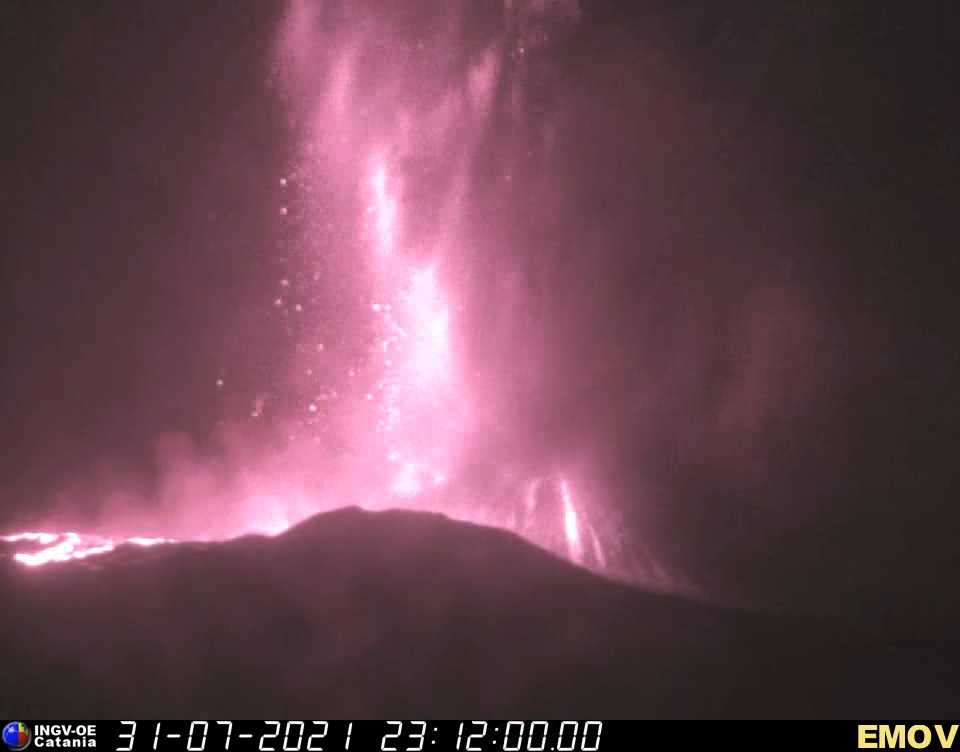
Lava fountain from the New SE crater around midnight 31 July-1 Aug (image: INGV webcam from Montagnola)
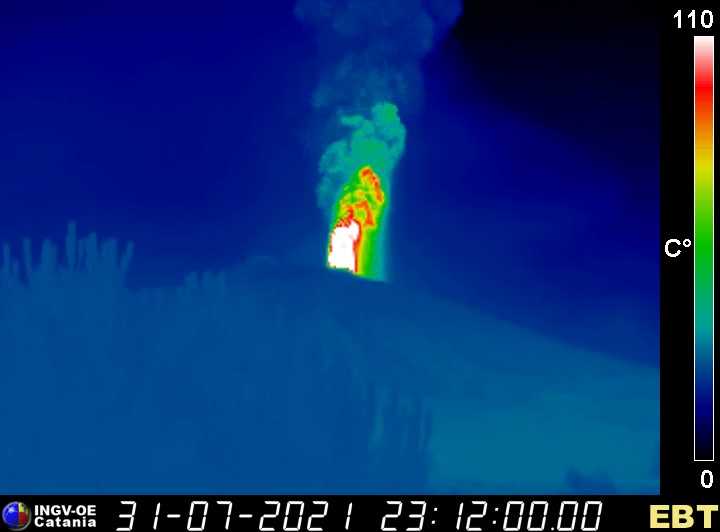
View of the lava fountain on the thermal cameral from the west side (Bronte thermal webcam of INGV)
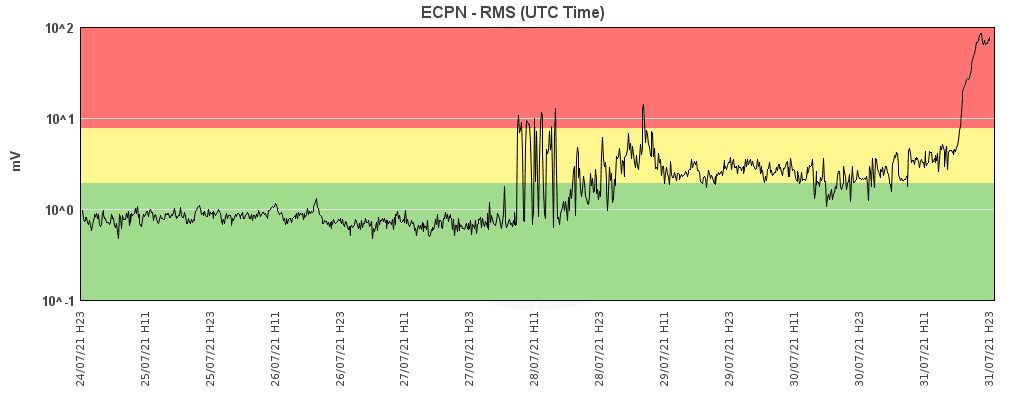
Current tremor signal (image: INGV Catania)
After several days of alternating phases of quiet and shifting activity at moderate to strong levels from the New SE crater following a brief interlude of strong ash emission at the NE crater, the volcano has once again started to enter a paroxysmal phase or paroxysm at the New SE crater, still in progress:
At the time of update, the lava fountaining activity seems to be at or near its climax, with lava fountains reaching 500-1000 m in height.
A summary of the previous days and the build-up of the activity follows:
26 July: from 20:20 in the evening strong ash emissions from NE crater, reaching 6000 m altitude.
28 July: early in the morning, at 05:25, intermittent strombolian activity begins at the New SE crater and culminates in a violent explosion in the afternoon. Activity ceases almost completely in the late evening.
31 July: After 2 and a half day of relative calm, activity sets in at the New SE crater again crater again in the evening at around 19:15, accompanied by a rising volcanic tremor signal, which starts to climb steeply from around 19:30.
Explosive activity at the crater increases from 19:50, and markedly again at 20:15, when it produces an ash plume rising to 5000 m by 20:15.
From 21:15, a lava flow starts to descend from the crater towards the SW.
Around 23:20, the now very intense strombolian activity begins to merge into lava fountains reaching several hundred meters in height.
By midnight, the lava flow has reached an elevation of 2800 m west of the 2002 craters.
Rising tremor - probably new paroxysm ahead
Update Thu 29 Jul 2021 07:21
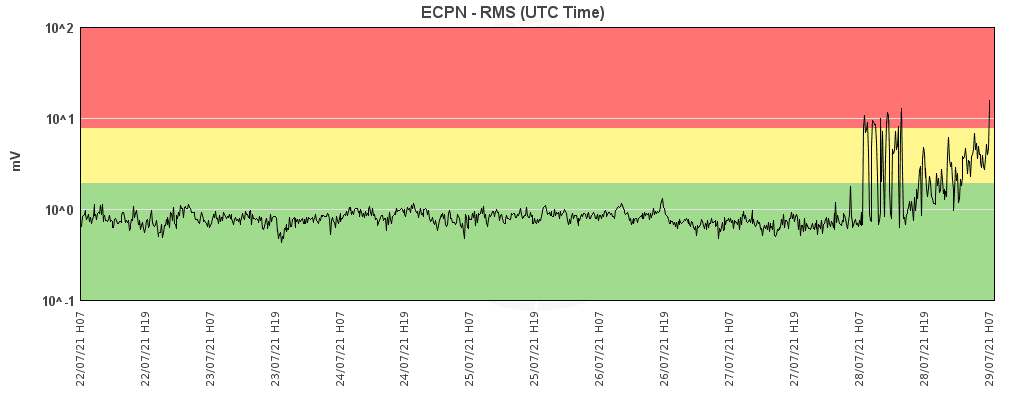
Current tremor signal (image: INGV Catania)

Mild explosion at Etna's New SE crater yesterday (image: LAVE webcam)
After little more than a week of calm, the volcano started to be restless again during the past 2 days, and has been increasing its activity at the New SE crater in the past two hours or so.
Accompanied by strongly fluctuating tremor, ash emissions and mild explosive activity began again at the New SE crater yesterday. Right now, the volcanic tremor signal is rising sharply, which in the past months always announced a new lava fountaining episode to occur very soon.
Etna volcano (Italy): new violent lava fountaining phase this morning
mar., 20 juil. 2021, 08:50 08:50 AM | AUTEUR : T
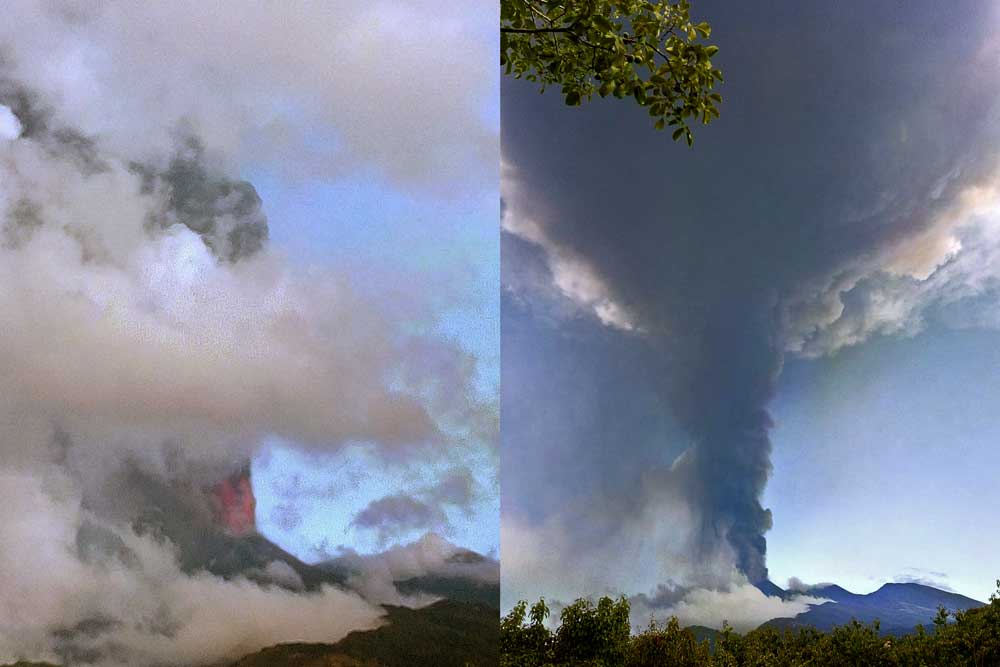
This morning's paroxysm at Etna (image: Franca Fulle)

Current tremor signal showing the peak of this morning's paroxysm (image: INGV Catania)
A new paroxysm occurred at the volcano's New SE crater this morning - almost 6 days after the previous one.
This time, the build-up to the lava fountaining phase was very slow and started during yesterday, when strombolian activity restarted at the vent in the late evening, accompanied by a fluctuating but overall increasing tremor amplitude.
The activity continued to increase very gradually over night and picked up quickly in the early morning after around 4:20 am, reaching lava fountaining by around 8 am. The peak of the eruption occurred during 9-10 am, when tall lava fountains of 500-1000 m height produced an impressive eruption column that reached approx. 10 km altitude, producing a dense plume drifting into southeasterly direction.
As usual, activity stopped abruptly around 10:30.
Ash emissions, strongly fluctuating tremor signal
Update Mon 19 Jul 2021 12:41
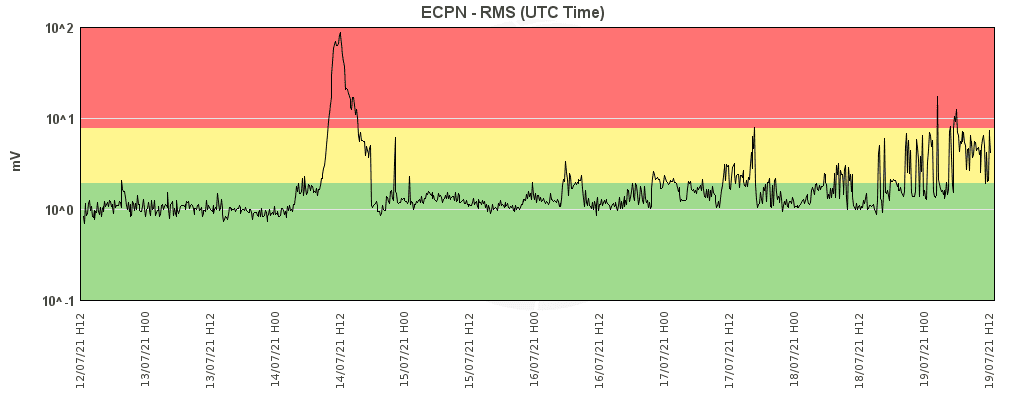
Current tremor signal (image: INGV Catania)
The volcano has been restless during the past days, but not (yet?) produced another paroxysm.
Although visibility hasn't been very good, friends on location reported ash emissions from the New SE crater. Volcanic tremor is fluctuating strongly between low to medium and medium to high values, but generally showing an increasing trend - it looks as if the volcano is currently "undecided" whether to erupt or not.
Powerful lava fountain episode Wednesday noon sends ash to Calabria
Update Thu 15 Jul 2021 07:26

Eruption column during yesterday's paroxysm at Etna (image: Radio Touring webcam from SW side)
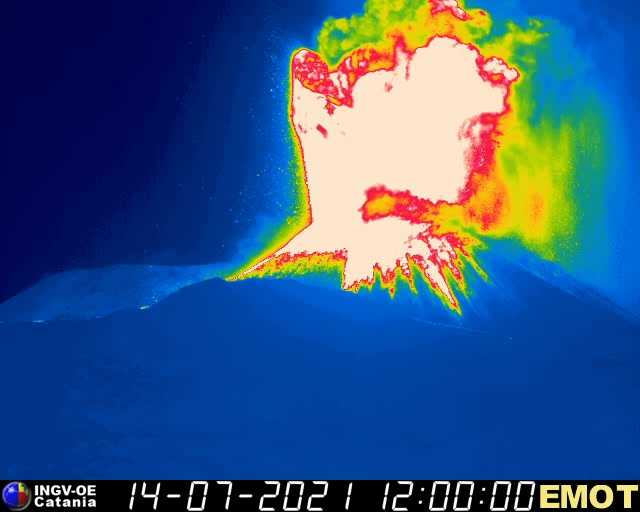
Thermal view of the lava fountain (image: INGV thermal webcam)
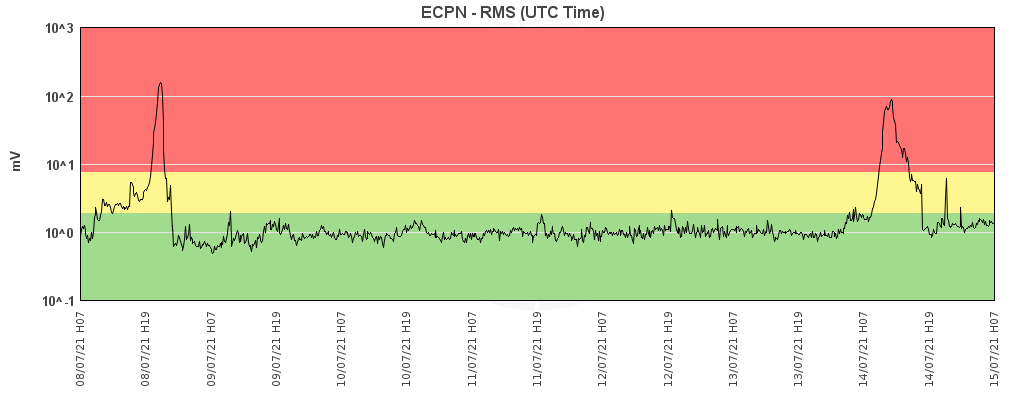
Current tremor signal (image: INGV Catania)
Following 5 and a half day of quiet, the New SE crater produced yet another paroxysm, and one of the most powerful ones in the current series, perhaps as a result of the longer-then-usual interval that had passed since the previous episode Thursday evening last week.
Events building up to the eruption followed the usual pattern:
Volcanic tremor increased in the morning after 09:50 local time, and strombolian activity restarted at the New SE crater from around 11:05. A lava flow started from the southern crater rim to travel to the SW from around 12:40.
At the summit vent, explosive activity increased gradually and merged into lava fountaining by around 1 pm, lasted for approx. one hour and half. During the peak phase from 1.40-2.20 pm, the lava fountains reached 600-1000 m in height and produced a thick eruption column that rose to more than 9000 m above sea level, which drifted NE, causing lapilli and ash fall as far as Taormina and Reggio Calabria.
In the summit regions, large incandescent bombs were seen reaching the southern slopes of Bocca Nuova crater.
After around 2.30 pm, summit activity rapidly dropped, although intermittent, sometimes large strombolian explosions went on for a while before stopping again by late afternoon. The lava flow to the SW of the SE cone remained active for a while before ceasing as well.
New paroxysxm at noon
Update Wed 14 Jul 2021 12:34
A new paroxysm occurred at the New SE crater today around noon. It seems to be ending at the time of this update. More details will be posted later.
You can watch the activity live at various webcams, e.g.:
Skyline Webcam on Montagnola.
Volcano quiet so far for more than 4 days
Update Tue 13 Jul 2021 09:18
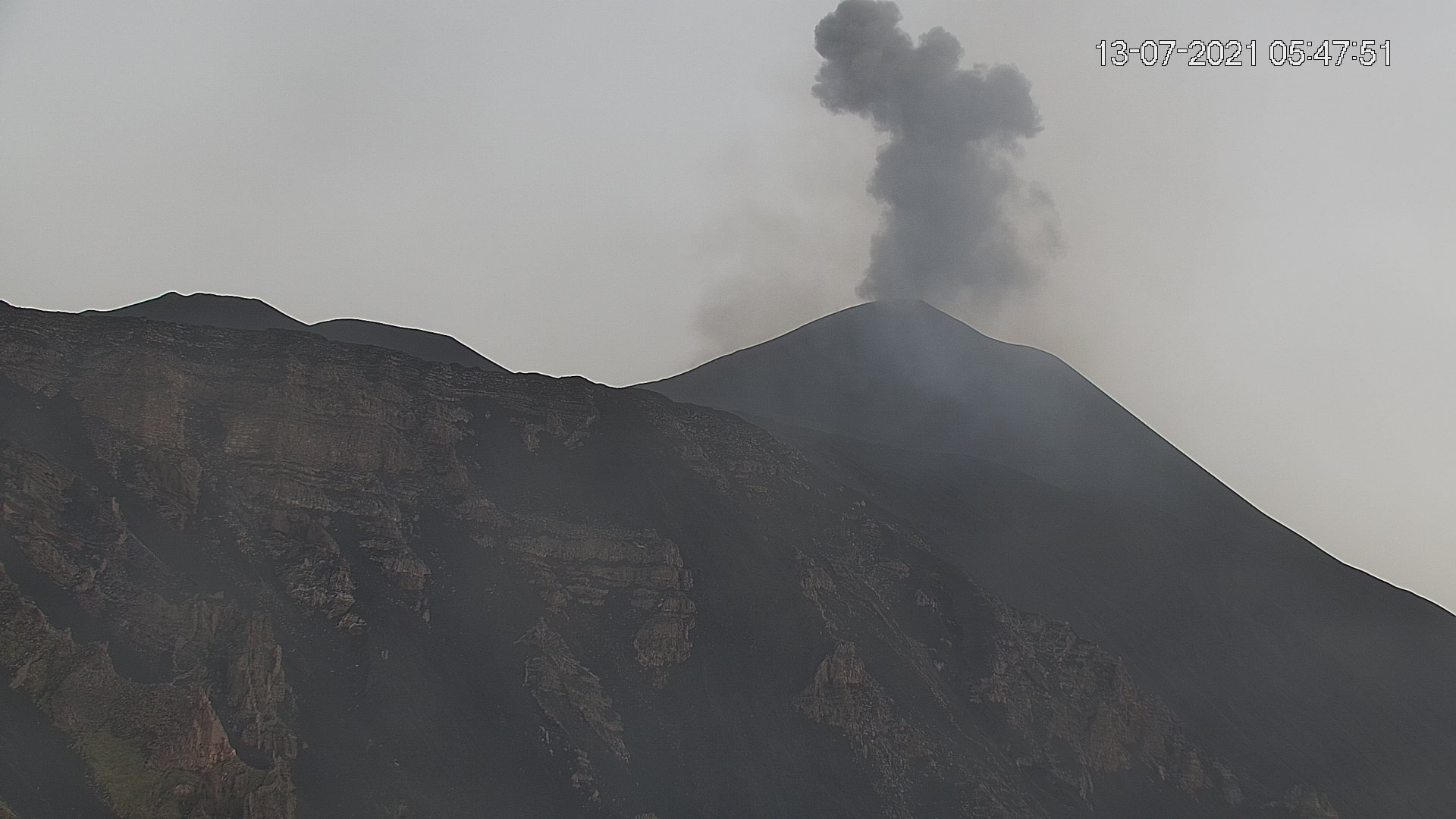
Ash emission from Etna's New SE crater this morning (image: LAVE webcam)
The volcano has been relatively calm for more than 4.5 days now since the latest paroxysm late Thursday evening. This marks the longest so-far interval in the record-breaking series of more than than 40 lava fountaining episodes that had started on 19 May this year.
The only activity has been in the form of intermittent small and mostly passive ash emissions from the New SE crater's summit vent.
Whether the series of paroxysms is over for now or whether the interval is just going to be much longer until a next one occurs is impossible to predict.
Powerful lava fountain during night 8-9 July 2021, ash plume to 11 km altitude
Update Fri 09 Jul 2021 10:05
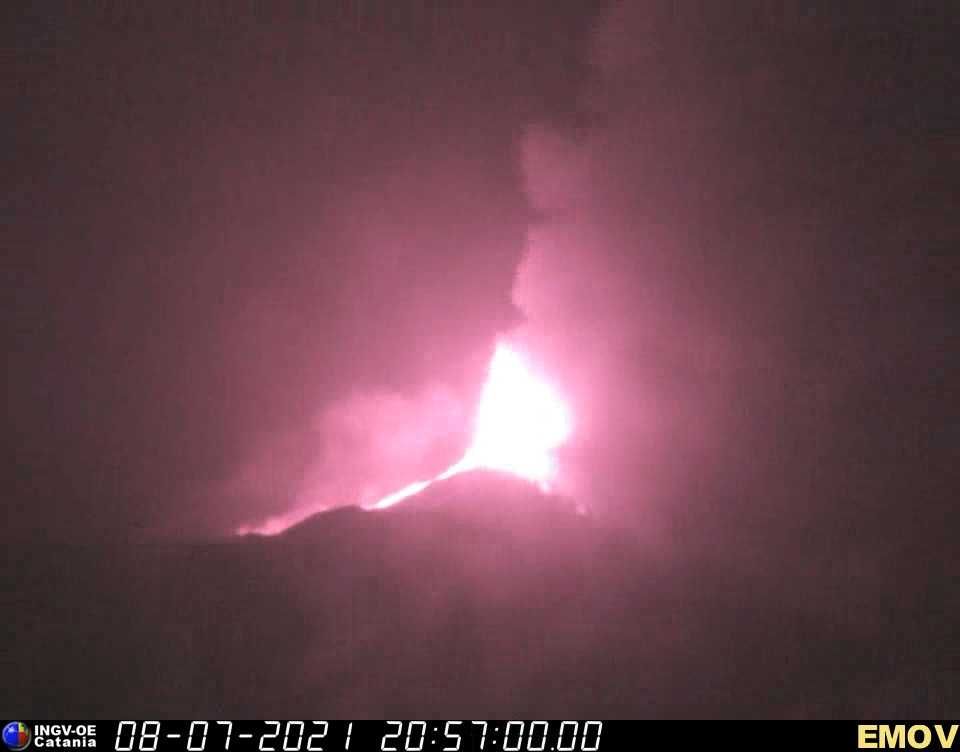
Lava fountain from last night's paroxysm at Etna's New SE crater (image: INGVvulcani / facebook)
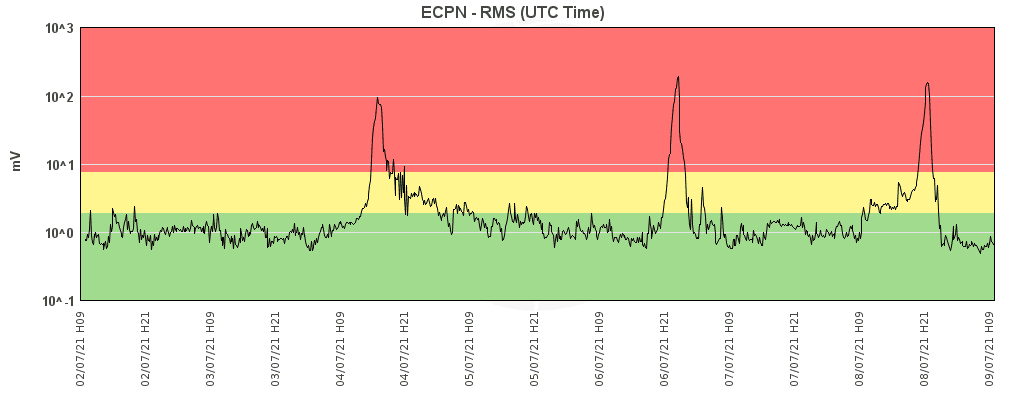
Current tremor signal (image: INGV Catania)
During last night (8-9 July 2021), yet another paroxysm (lava fountaining episode) occurred from the New SE crater, after an interval of less than 48 hours since the previous one.
Etna continues its breathtaking, record-breaking sequence of regular paroxysms at intervals around 2 days now, with no end in sight... The sequence of events was almost identical to the previous events, but this time, the eruption seems to have been significantly stronger as it produced a tall eruptive column that rose to estimated 11 km altitude.
Strombolian activity had reappeared around 9pm local time, gradually increased afterwards to merge into sustained tall lava fountains by 22:45, lasting for about 2 hours until 00:45 this morning.
Heavy lapilli and ash fall occurred on the southern and eastern sectors of Etna, including Zafferana Etnea, Fleri, Pedara and Cannizzaro.
A small lava flow was also produced as lava overflowing the southern crater rim and moving over the previously emplaced flows SW of the cone.
New lava fountain episode during night 6-7 July 2021
Update Wed 07 Jul 2021 15:17
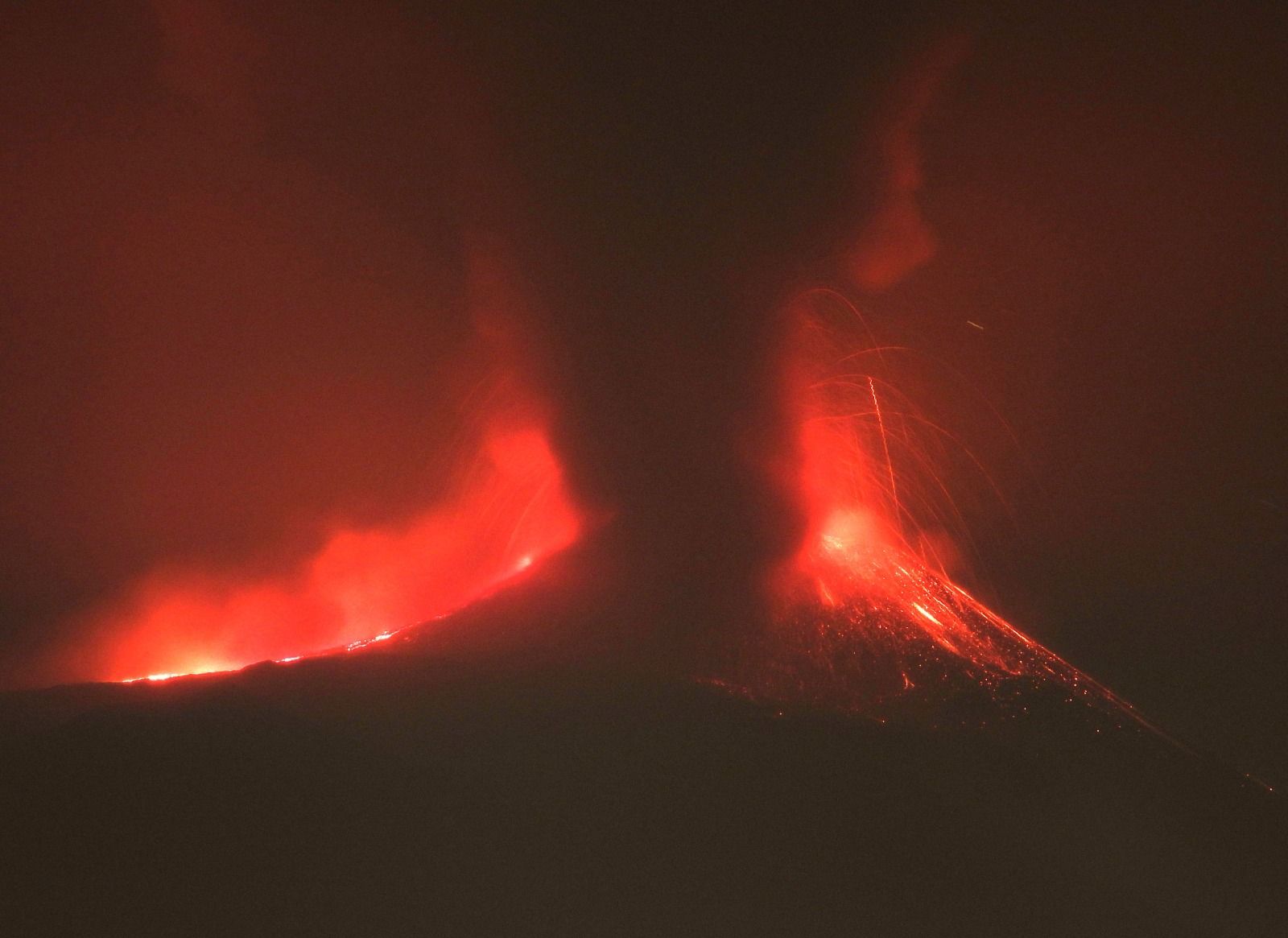
Lava fountain from Etna's New SE crater early this morning (image: INGVvulcani / facebook)
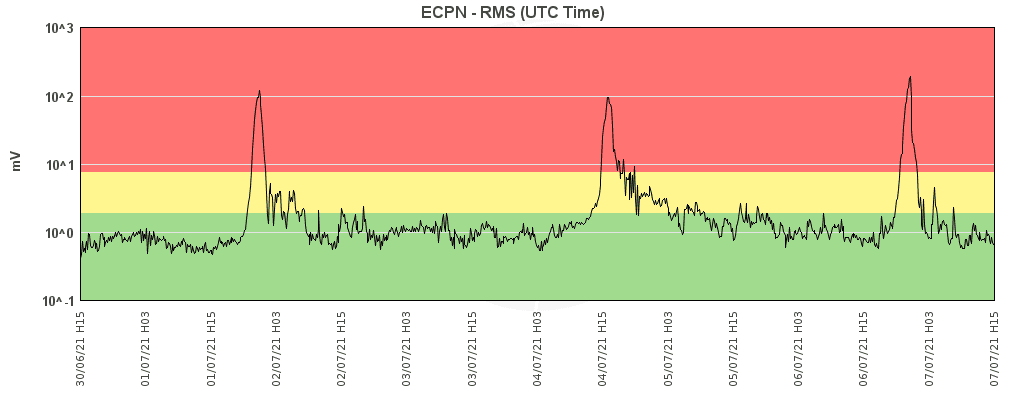
Current tremor signal (image: INGV Catania)
Two and a half days since the last one, another lava fountaining episode or paroxysm took place at the New SE crater, following more or less the same usual pattern:
Strombolian activity resumed at the New SE crater starting at 11:30 pm local time last night 6 July. After a phase of intense explosive activity until around midnight, it shifted gradually to lava fountaining of several hundred meters height and producing an eruptive column reaching about 5 km above sea level.
Ash and lapilli fell on the south side of the volcano including Tremestieri and Nicolosi towns. Shortly after 2 am this morning, the lava fountain activity ended, replaced by a weak Strombolian activity with minor ash emissions. The activity also produced a small lava flow on the southern flank of the Southeast Crater cone, which traveled until about 2800 m elevation.
As of now, it seems the volcano is completely quiet again, probably only to return to maybe yet another paroxysm in the near future; if the current rhythmic pattern persists, it could probably be expected to occur during Friday...
New lava fountaining episode after less than 3 days of calm
Update Mon 05 Jul 2021 08:26
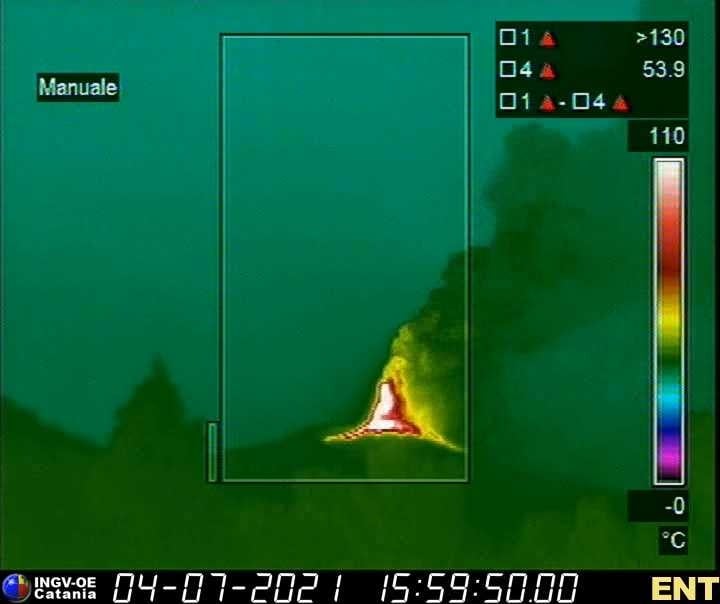
Thermal view of the lava fountain at Etna's New SE crater on 4 July 2021 (image: INGVvulcani / facebook)
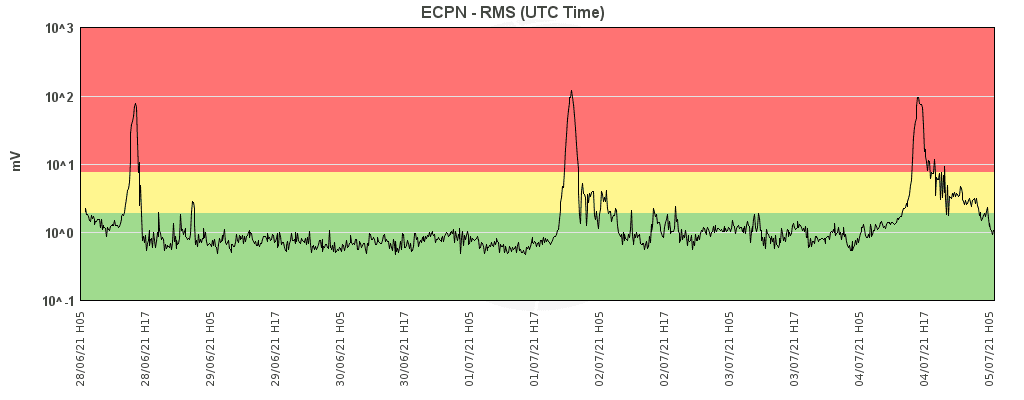
Current tremor signal (image: INGV Catania)
Less than 3 days since the last paroxysm early morning last Friday, another similar eruption occurred yesterday afternoon (4 July 2021). During the afternoon, strombolian activity resumed at the SE Crater, quickly increased and produced a lava fountain from 17:25-19:00.
The activity also produced two lava overflows from the SW and NNE crater rims, the latter of which reached the upper part of the Valle del Bove.
After the cessation of lava fountaining, intermittent weak strombolian activity continued at the crater for a while before stopping as well.
New spectacular paroxysm after 4 days of quiet
Update Fri 02 Jul 2021 09:18
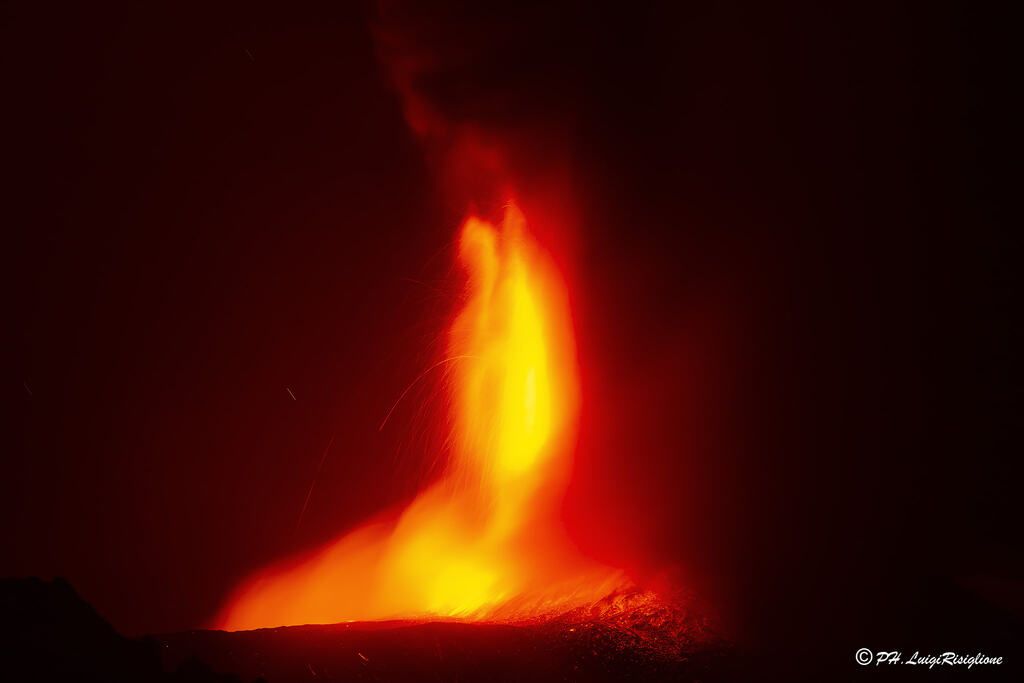
Lava fountain from this morning's paroxysm at Etna (image: Luigi Risiglione / facebook)

Thermal view of the lava fountain (image: INGVvulcani / facebook)
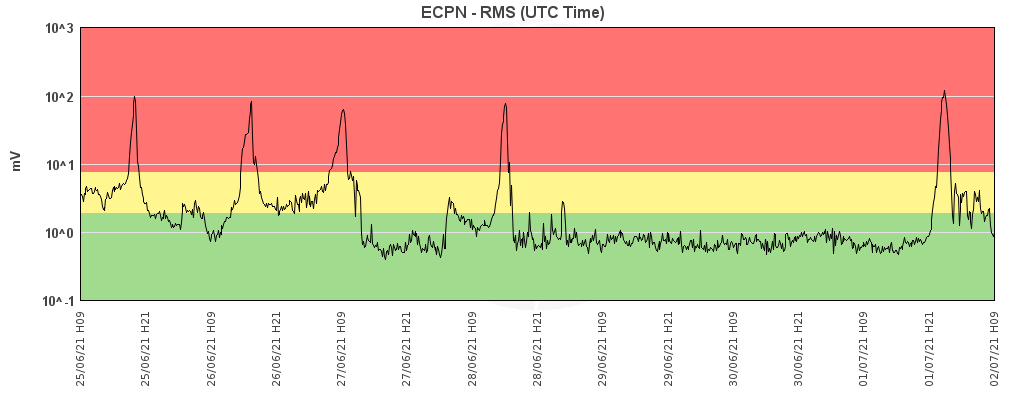
Current tremor signal (image: INGV Catania)
Another spectacular fire-fountaining episode or paroxysm occurred at the New SE crater during the last night, marking it the 42th such event in 2021 so far.
It came after a significantly longer interval of 4 and a half days since the preceding event on Sunday, but its evolution followed the same pattern observed during nearly all paroxysms this year:
Around 00:40 local time, strombolian activity resumed at the South-East crater, accompanied by quickly rising volcanic tremor amplitude and the source of the tremor having moved to shallow depth beneath the crater itself, indicating the rising magma inside the conduits.
At 01:24, the activity became lava fountains reaching several hundred meters of height and producing a lava overflow on the southern side that traveled SW. The lava fountain lasted until 02:50, after which moment the activity quickly dropped again.
Video:
Series of spectacular summit eruptions continues
Update Tue 29 Jun 2021 07:19
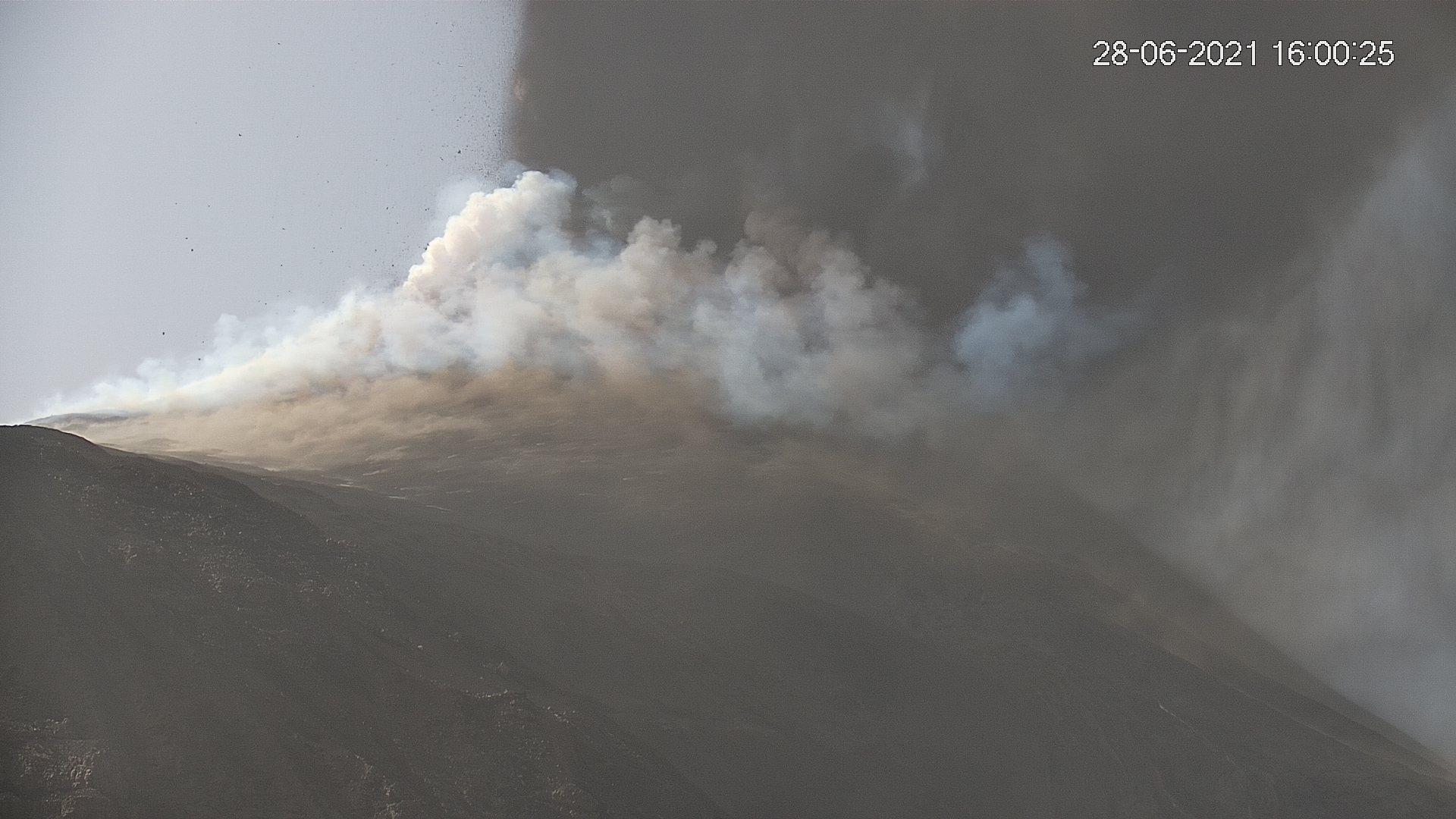
Yesterday's paroxysm at Etna (image: LAVE webcam)
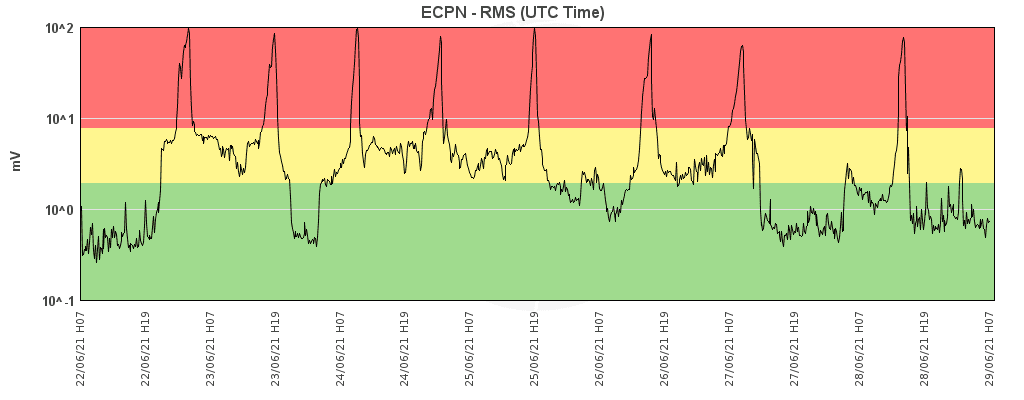
Current tremor signal (image: INGV Catania)
The amazingly regular series of paroxysms from the New SE crater at very regular intervals of approx. 20-30 hours continues with no signs of ending soon. Since the last update, two more lava-fountaining episodes occurred Sunday and yesterday:
After having rested for less than 18 hours, strombolian activity restarted at 09:12 local time Sunday (27 June) morning, increased rapidly after around 10 am and turned into lava fountaining by 11 am, which lasted until 11:50, creating an eruption plume that rose to approx. 6.5 km altitude.
Another lava flow traveled from the southern rim of the cone towards the SW. Strombolian activity continued for a while at the summit vent and finally ceased by 14:30.
The volcano stayed calm until yesterday afternoon only: the next paroxysm occurred about 30 hours since Sunday's, following the almost identical pattern as during the previous episodes. Strombolian activity began at 16:00 local time, increased gradually and then very fast from 16:27, turning into lava fountains by 17:00, which lasted until 17:30 and then returned to intermittent explosions. Another lava flow as over-spill of lava from the southern rim and traveling to the SW below the cone was erupted as well.
While the lava fountain phase of the last paroxysm was “only” about 30 minute, it was more powerful than the previous episodes and produced an eruption column that rose to 10 km altitude.
Lava fountains at clockwork rhythm
Update Sun 27 Jun 2021 07:26

Yesterday's paroxysm at Etna (image: LAVE webcam)
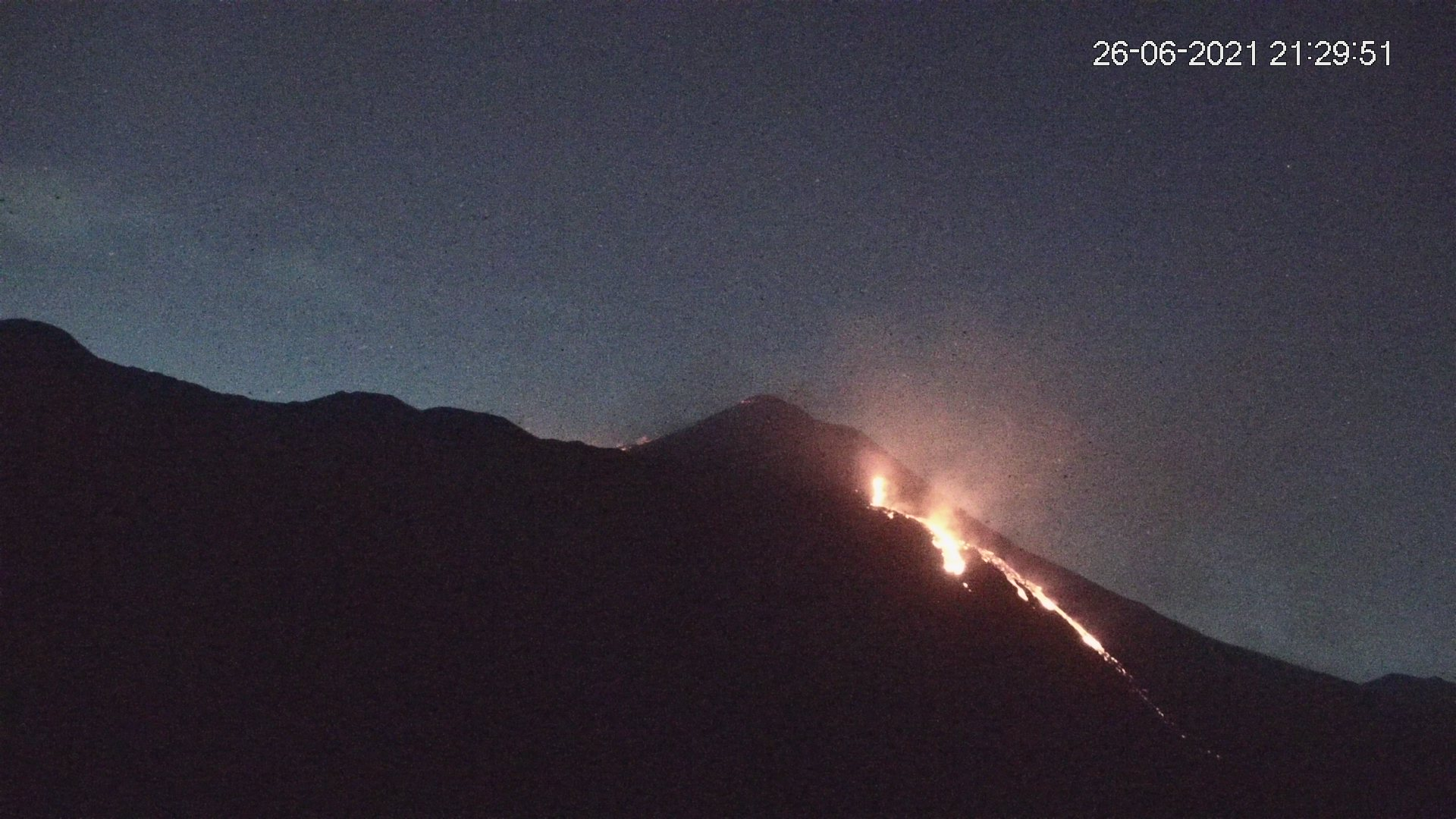
Continuing lava flows from the new eruptive fissure on the lower SE flank (image: LAVE webcam)
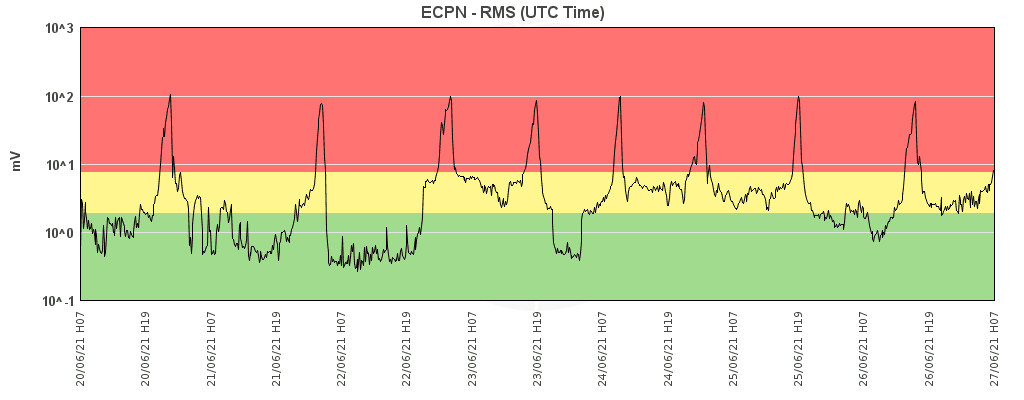
Current tremor signal (image: INGV Catania)
The very regular pattern of paroxysms (lava-fountaining episodes) continues at the volcano. After a slightly longer interval of about 24 hours since the last one, yet another paroxysm occurred yesterday evening.
It followed the same sequence of events as usual: first signs of new activity began around 16:20 local time when volcanic tremor started to rise, followed by strombolian explosions appearing at the New SE crater shortly after.
An hour and half later, this activity had reached lava fountaining stage by 17:48 and an eruptive column rose to approx. 5 km altitude, i.e. significantly lower than during the previous eruptions.
As lava fountains set in, lava over-spilled the southern rim and created another lava flow towards the SW, overlapping the numerous previous flows in this area. At 19:05, the lava fountains ceased and activity returned to intermittent strombolian explosions that ceased by around 22:40, when then eruption was essentially over.
As to the effusive fissure at the lower SE flank of the New SE crater cone, which has opened during the paroxysm on Thursday 24 June, it became active again during this episode and produced a weakly alimented lava flow that reached a few hundred meters length. It remained active during much of the night, but then gradually weakened. By early morning today, it seems to have stopped.
Two spectacular lava fountains in one day
Update Sat 26 Jun 2021 12:44
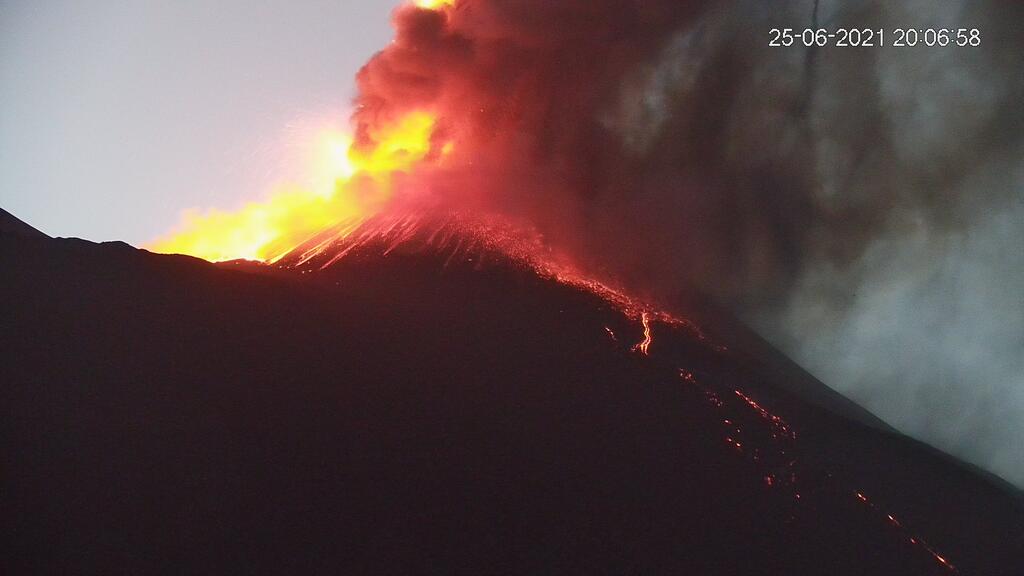
Last evening's lava fountain at Etna's New SE crater (image: LAVE webcam)

Lava fountain and flows yesterday early morning (image: LAVE webcam)
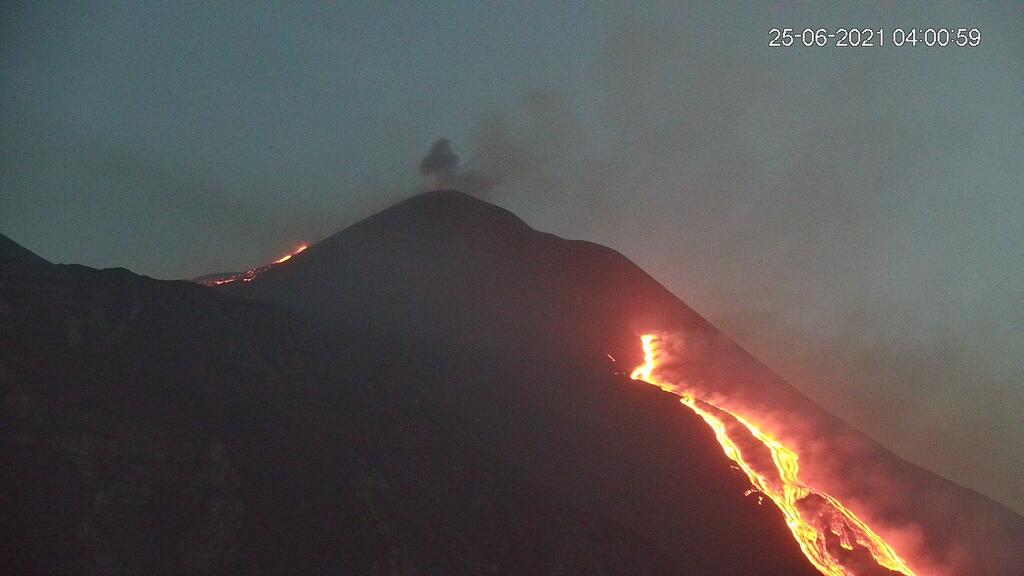
Continuing effusive activity after the first paroxysm
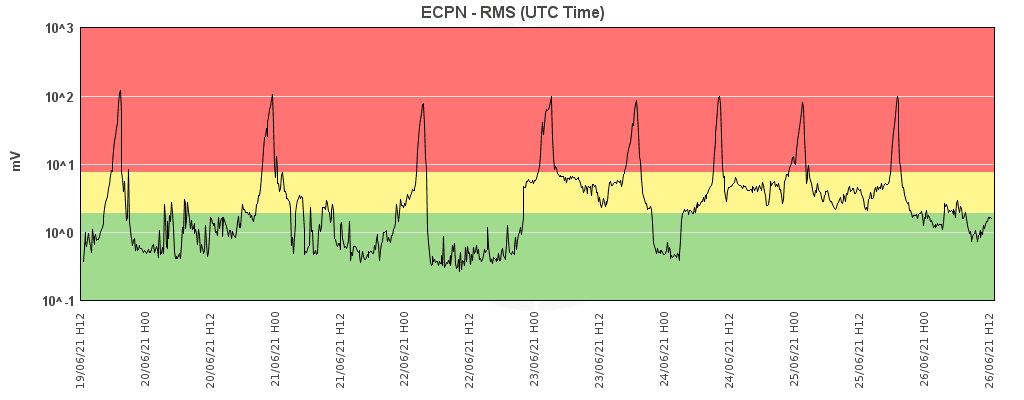
Current tremor signal (image: INGV Catania)
Following the short lava-fountaining episode Thursday noon, which had been remarkable by the dual activity of a new lava flow from a flank fissure and the fountaining at the summit, the volcano produced two similar eruptions in rapid succession yesterday, one in the morning and one in the evening:
The first one announced itself early on Friday (25 June 2021), when strombolian activity started at the New SE crater again from 01:17 am local time, while the lava flow from the effusive vent at the SE base of the cone at around 3050 m elevation continued to be active and formed two main branches into the upper Valle del Bove.
Shortly afterwards, volcanic tremor started to rise sharply, and from 01:50 on, explosive activity also picked up rapidly, merging into lava fountains by around 3 am, which lasted little less than an hour and produced a tall eruption column rising to 8.5 km altitude and drifting east.
From 3:15 am, lava overflowed from the southern crater rim and produced a second flow towards the SW. The lava effusion from the lower vent at the SE side mentioned earlier continued without changing significantly during the whole event.
The paroxysm (lava fountaining phase) ended at 3:48, with continuing mild strombolian explosions at the summit. The lava flow towards the SW had by then reached approx. 2900 m elevation, while the other flows from the SE fissure vent had active fronts at 2700 m in the western flank of the Valle del Bove. This activity continued also after the summit eruption had paused. At 6:15 am, a third flow emerged from this vent following a path further to the north, and reached an elevation of 2800 m by early afternoon.
Second paroxysm:
During the morning, activity at the summit vents more or less ceased temporarily. The lava over-flow towards the SW was no longer active by 2 pm, while lava continued to feed the active flows from the fissure at the SE side. The most advanced flow front had descended to 2550 m elevation by then.
About 18 hours past the beginning of the previous paroxysm, another similar eruptive episode took place in the evening. At 19:37, strombolian activity began at the summit vents of the New SE crater and tremor began again to increase steeply. Activity increased from 20:05 and from 20:25, lava overspilled the southern rim and formed a new flow towards the SW. Lava fountaining stage was reached by 20:40 and lasted until 21:15, generating an eruption column rising to approx. 7 km altitude and drifting east.
The lava flows from the fissure vent at the SE base at 3050 m elevation had gradually decreased in their activity earlier. Only the 3rd of them, on the northern side that had started after the end of the previous paroxysm was still weakly active in the evening, but seemed to die down.
New paroxysm at noon
Update Thu 24 Jun 2021 16:52
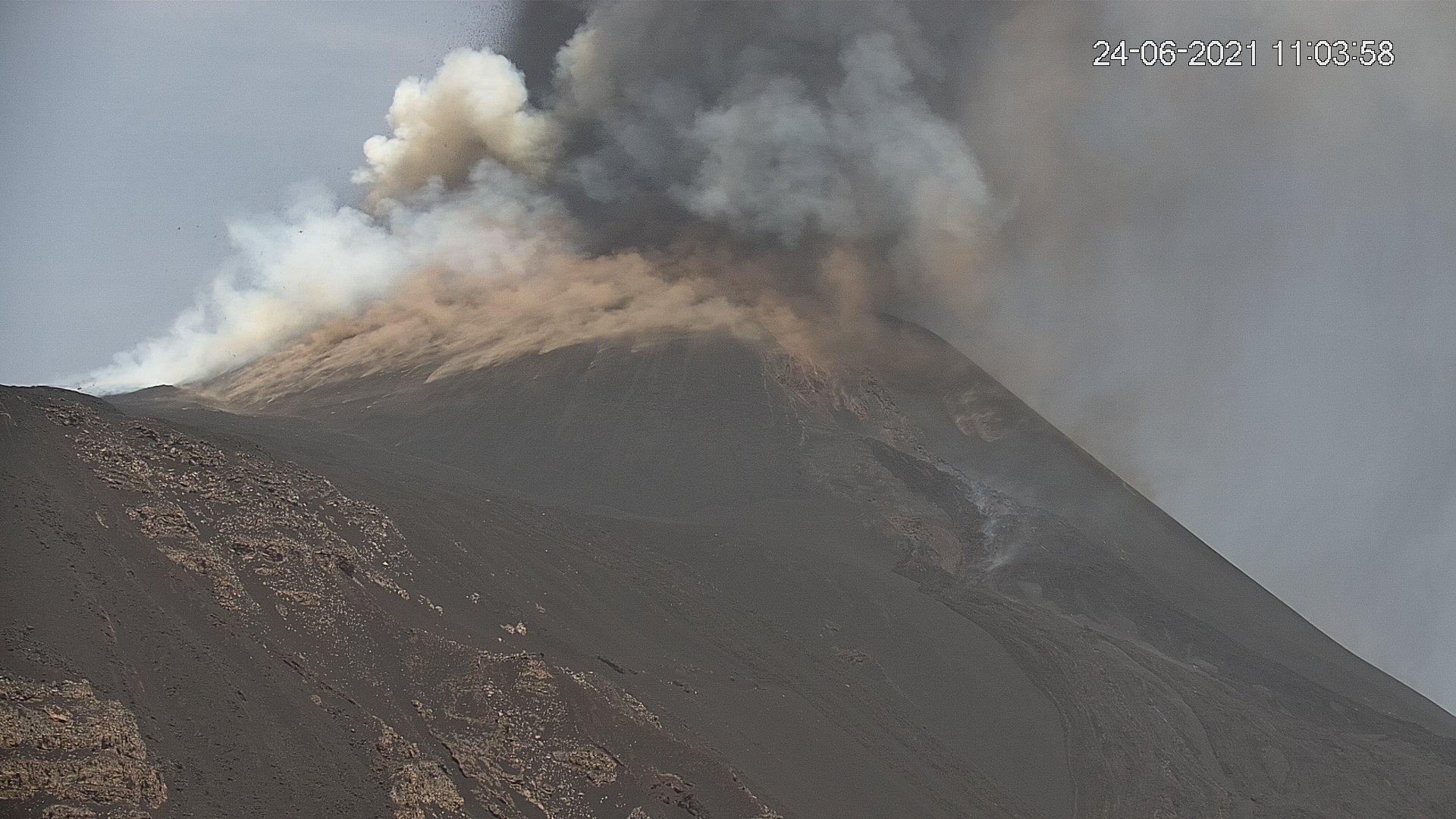
New paroxysm at Etna today at noon (image: LAVE webcam)
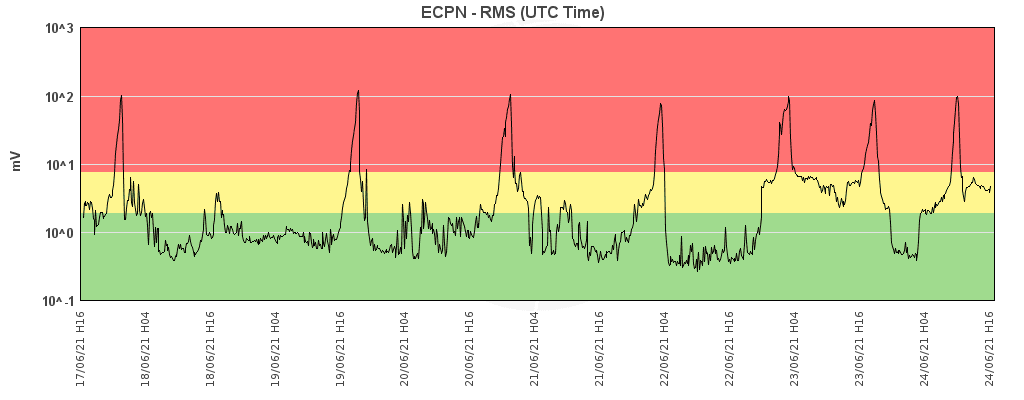
Current tremor signal (image: INGV Catania)
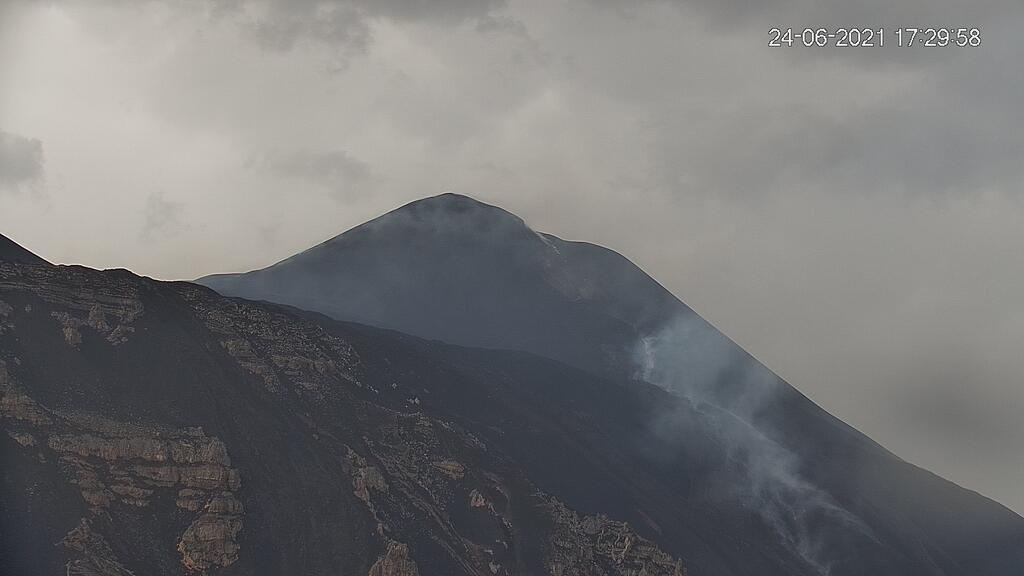
The lava flow from the fissure vent at the SE base of the New SE crater this afternoon (image: LAVE webcam)
Etna is accelerating its rhythm of intermittent strong eruptions: Only about 16 hours since last evening's paroxysm, another similar event occurred today around noon:
Accompanied by the usual rising tremor signal, sign of magma on the move upwards, shortly after 11 am local time, strombolian activity started to occur again at the New SE crater. At the same time, a small lava flow continued to be active from a fissure vent on its lower SE flank.
By noon, the explosive activity had increased to reach lava fountaining and an additional lava flow over-topped the southern rim and traveled to the SW.
The lava fountains reached 400-500 m height and produced an eruption column that rose to 9-10 km above sea level, again drifting towards the ESE where heavy ash and lapilli fall occurred, in particular in the town of Linguaglossa.
The paroxysm lasted approx. one hour and activity rapidly decreased around 1 pm. While explosive activity ceased, the lava flow from the effusive vent at the southeastern flank of the cone, at approx. 3050 m elevation, was reactivated and began to feed a small lava flow that remained active until the time of this update. By early afternoon, it had reached an elevation of 2800 m in the western slope of the Valle del Bove.
Update Thu 24 Jun 2021 08:25
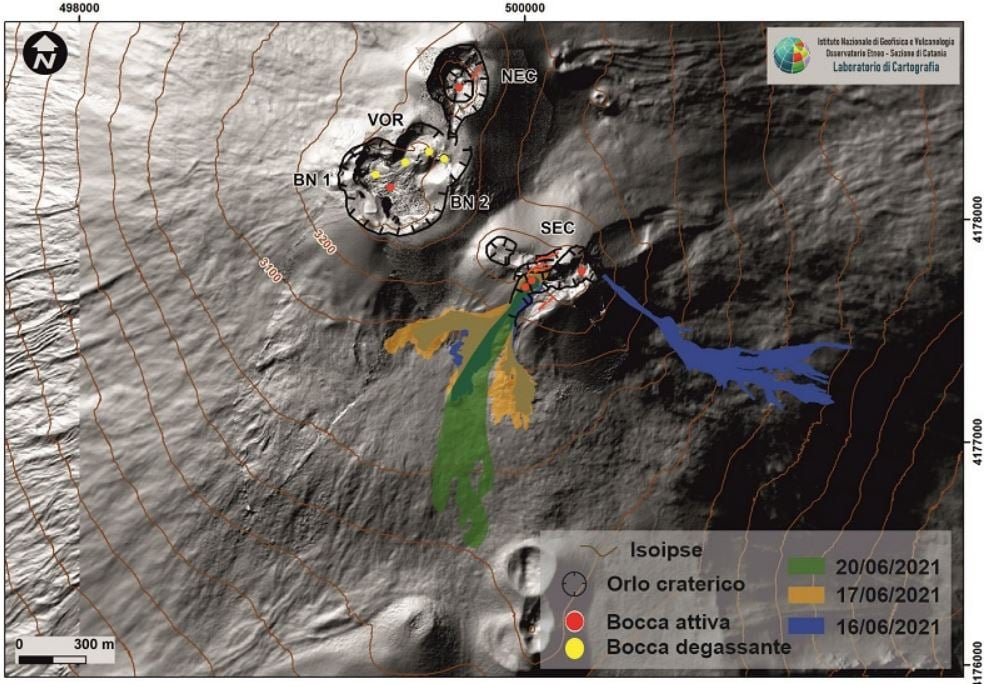
A map of the configuration of Etna's summit vents as of late June 2021 (image: INVG Catania / facebook)
Spectacular activity of lava fountains and flows, southeast crater opens its flank
Update Thu 24 Jun 2021 08:14
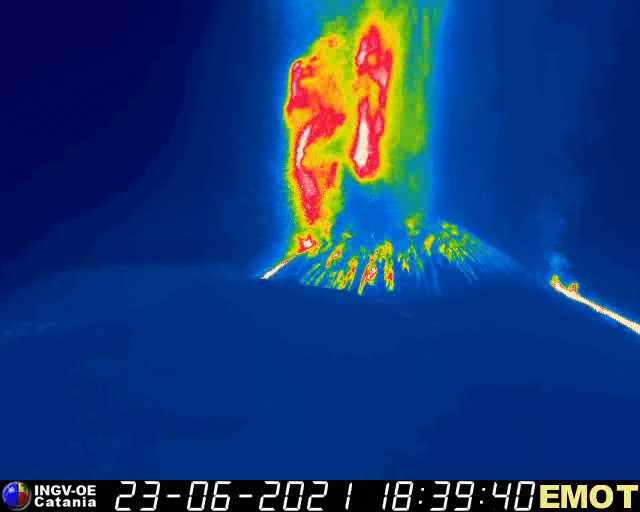
Last evening's lava fountain at Etna's New SE crater
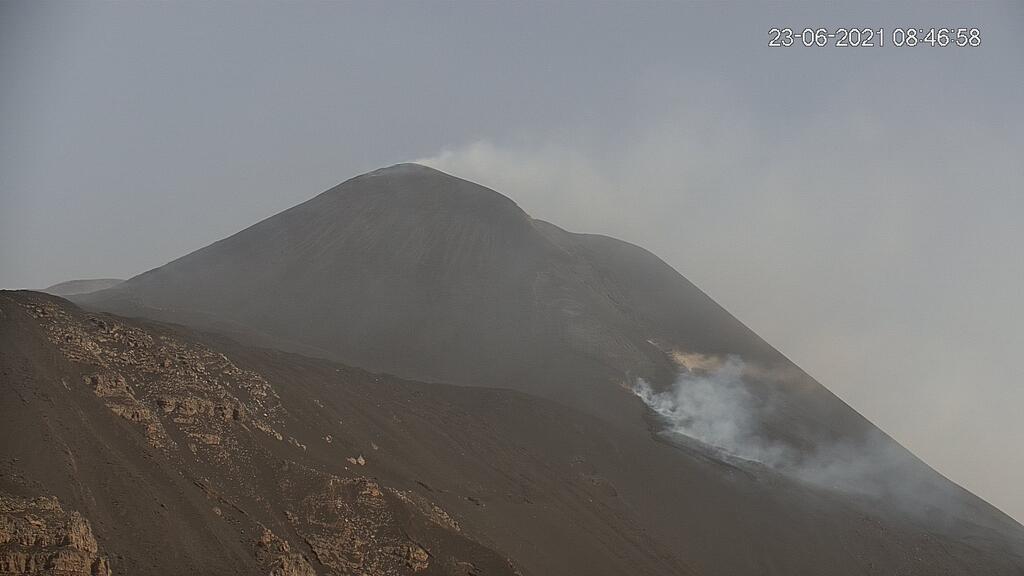
Lava flows from the new effusive vents yesterday morning (image: LAVE webcam)
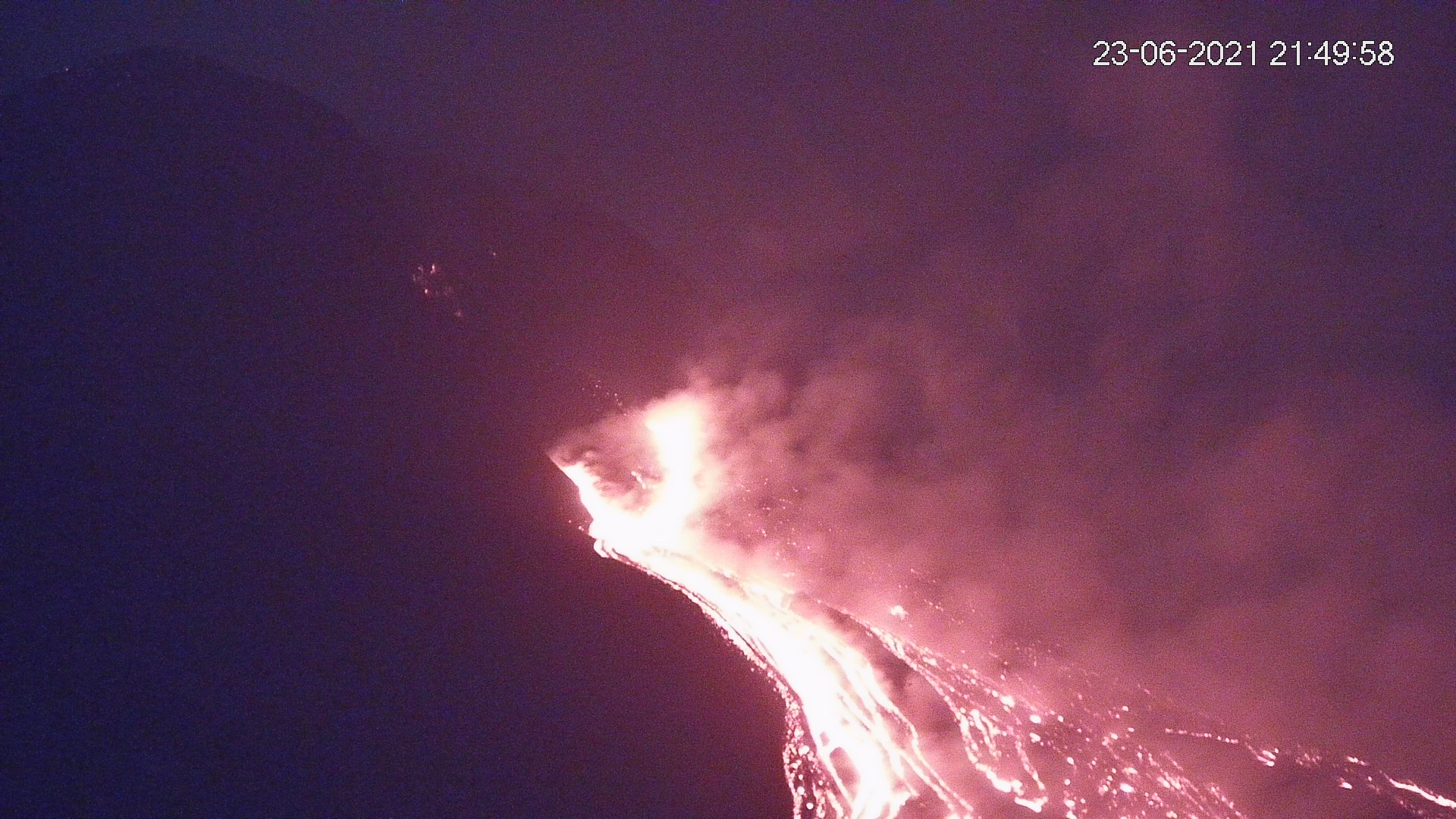
Lava flows from the new effusive vents after the evening paroxysm (image: LAVE webcam)
Following yesterday early morning's paroxysm, the volcano, known for its capricious mood, surprised us again by a dramatic change in activity, both involving opening new fissures feeding lava flows AND producing another lava fountain episode from the New SE crater in the evening of the same day...:
First, two small lava flows started to flow from two new effusive vents that opened in the lower part of the southeastern flank of the crater in the early morning, a higher one at 06:25 local time, and a lower one at 07:59 am.
These two lava flows remained well alimented and the most advanced fronts reached the western headwall of the Valle del Bove at an estimated altitude of about 2900 m a.s.l.
Tremor did not decrease as much as usually after paroxysms, reflecting the ongoing magma supply. The effusive activity at these vents seemed to gradually decrease during the course of the day.
Another paroxysm was about to occur in the evening - less than 24 hours since the previous one: Strombolian activity from the summit vents set in in the evening at about 19:17 local time, and volcanic tremor began to rise sharply from 18:30. Strombolian activity also increased noticeably from 19:45. Starting from around 20:00, the activity at the summit vents merged to a lava fountain, producing an eruptive cloud that reached an estimated height of about 9 km a.s.l. that dispersed in an East-North-East direction.
Furthermore, starting at 20:28 UTC, an eruptive vent opened on the high eastern slope of the Southeast Crater, producing both explosive activity and a lava flow that spread in an easterly direction. It appears that this vent is close (likely located on the same fissure) to the effusive vents that had opened earlier described above.
In addition, the lava fountains caused another lava overflow from the southern crater rim that traveled towards the SW.
After the cessation of the lava fountains at around 21:00, weak strombolian activity continued for some tens of minutes before stopping as well. However, the lava effusion from the vents on the eastern flank of the cone continued during the night, at decreasing rate. The new lava flow had reached about 2600 m elevation on the western wall of Valle del Bove at its most advanced point by early this morning.
At dawn today, only a small flow, some tens of meters long, was still active near the effusive vent.
What comes next?
The underlying rhythmic supply of magma surges at short intervals of 24-36 hours seems to be quite stable, but the mechanisms how the magma is erupted at the vents is perhaps changing as more and more fractures weaken the New SE cone, favoring the opening of vents on its flank as was seen yesterday.
It seems likely that we might see more of mixed explosive-effusive eruptive episodes similar to the past ones in the near future. For how long this could continue and what might come afterwards is impossible to predict. With more than 40 paroxysms this year alone, it approaches the record of 66 paroxysms at the SE crater in 2000, which later was followed by the 2001 and 2002 flank eruptions.
New paroxysm lights up morning sky
Update Wed 23 Jun 2021 06:55
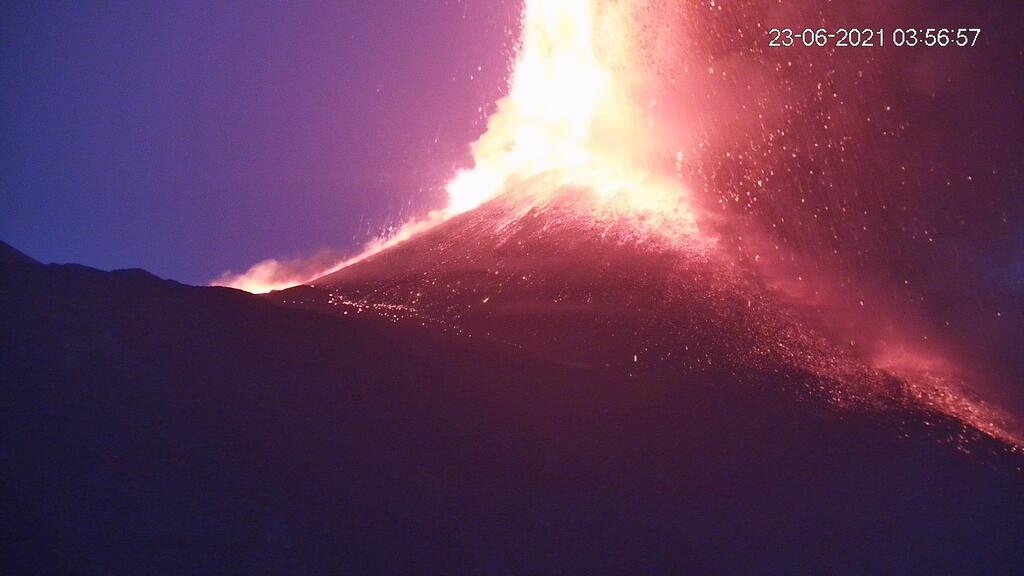
Lava fountain from this morning's paroxysm at Etna's New SE crater (image: LAVE webcam)
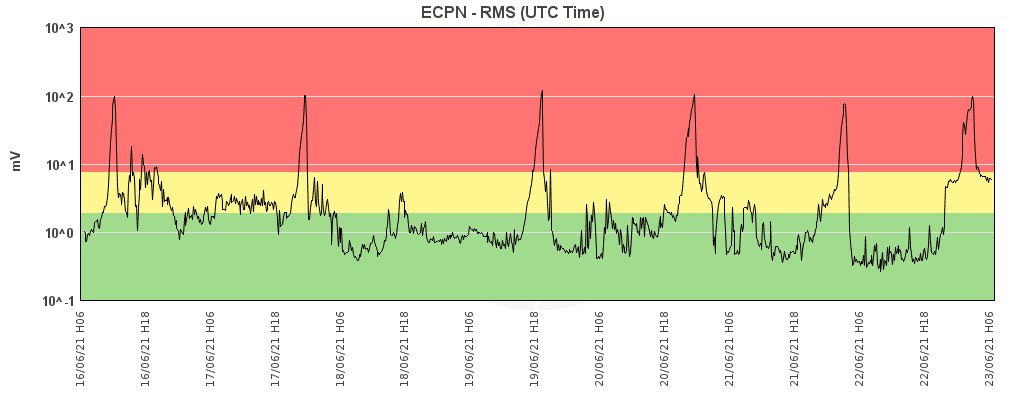
Current tremor signal (image: INGV Catania)
Only about 24 hours since the last one, yet another paroxysm occurred at the New SE crater in the early hours today, marking it the 42th or so event this year alone.
As during the previous ones, the episode announced itself with a shift and increase of tremor from around midnight, before strombolian activity began from at least 3 vents at the New SE crater from around 2:30 am (local time). From 4:15, a lava flow started to travel from the southern crater rim towards the SW.
Explosive activity increased quickly and reached lava fountaining by 4:45 am, lasting about an hour before ceasing abruptly around 5:45.
During the eruption, a second short lava flow was erupted towards the east, and the eruption column rose to more than 9 km height above sea level, according to the volcano observatory. Ash and lapilli fall occurred the eastern sector around Milo and Giarre towns.
The paroxysm today seems to have been more violent than the past ones and it came only about 24 hours since the preceding one: it seems that the intervals between events in the current series are gradually becoming shorter. It is impossible to predict how long this pattern might last and what will come next at the volcano.
New paroxysm in the early morning of 22 June 2021
Update Tue 22 Jun 2021 18:38
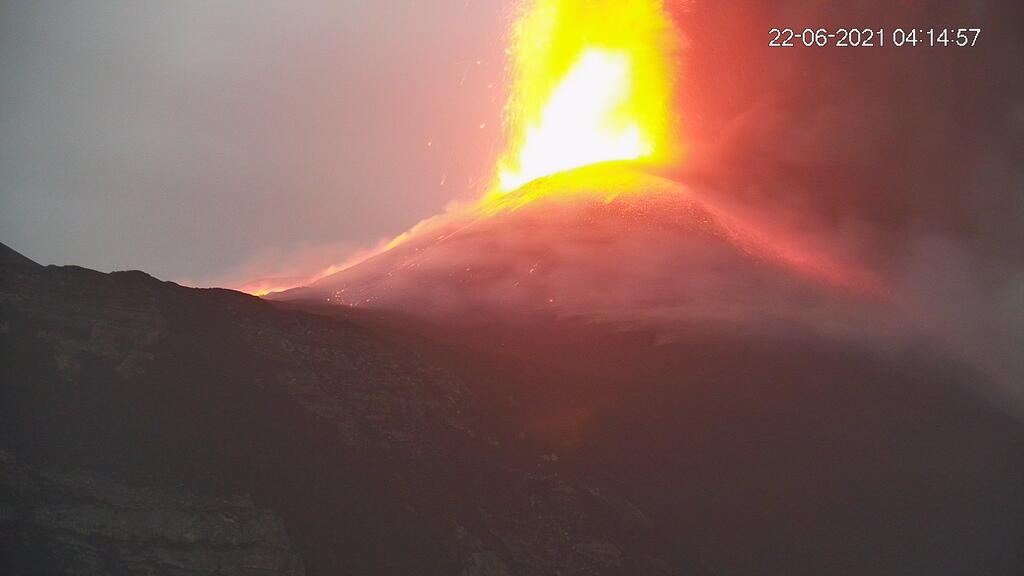
Paroxysm at Etna's New SE crater early on 22 June 2021 (image: LAVE webcam)
The volcano continues to produce lava fountaining episodes (paroxysms) from the New SE crater at almost constant time intervals. About 30 hours since the preceding one around midnight between Sunday-Monday, a new paroxysm occurred early this morning.
The event unfold very much in a similar fashion as the preceding ones: At 04:15 local time, strombolian activity began to appear again at the New SE crater and volcanic tremor began to rise. Shortly after, at 04:30, this activity started to increase rapidly and reached lava fountaining stage by 04:55. The paroxysm lasted about an hour and quickly ceased at around 6 am in the early morning.
During the eruption, yet another lava overflow issued from the crater towards the SW, overlapping the numerous earlier flows.
A tall ash plume rose from the vent and drifted ENE.
Two more lava fountains at clockwork rhythm
Update Mon 21 Jun 2021 07:20
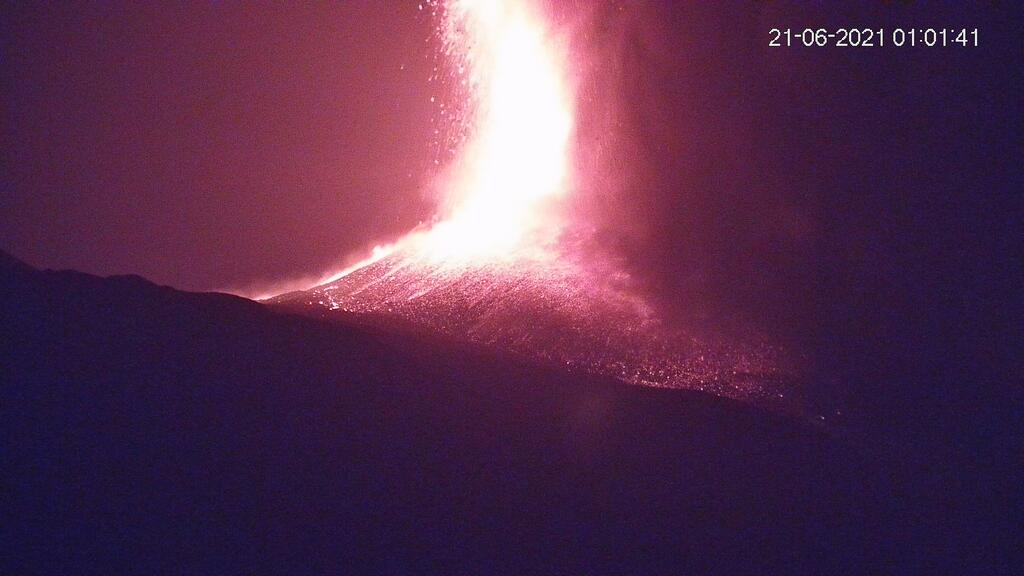
Lava fountain from this morning's paroxysm at Etna's New SE crater (image: LAVE webcam)
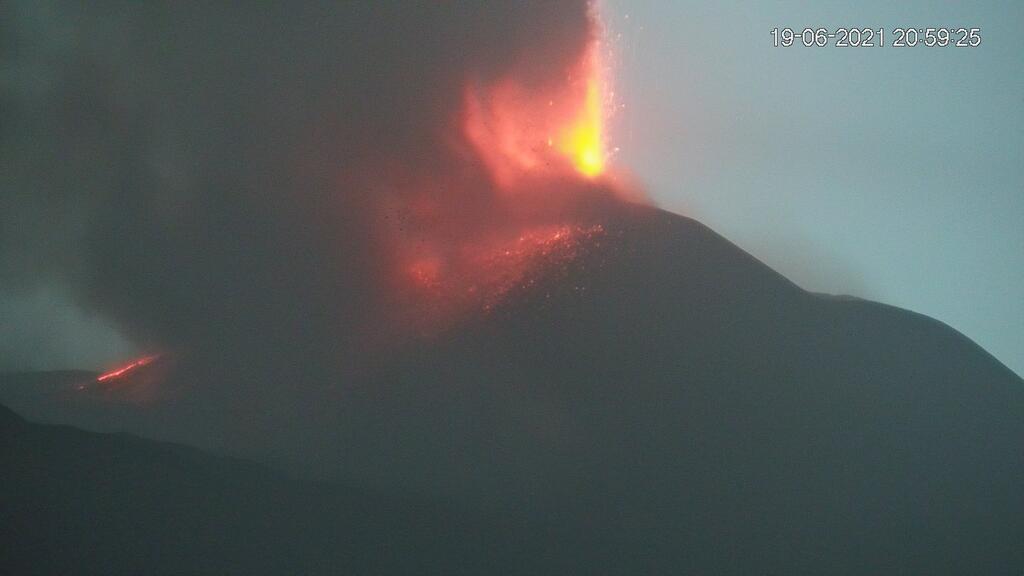
Lava fountain from Satuday evening's paroxysm at Etna's New SE crater (image: LAVE webcam)
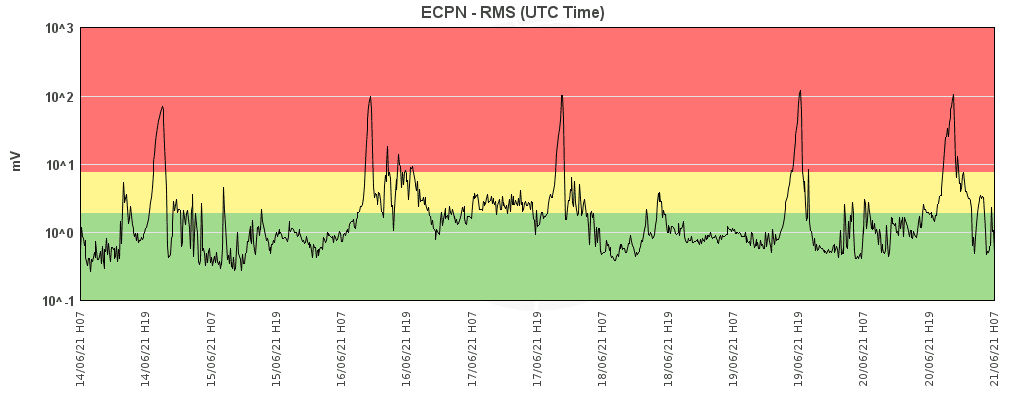
Current tremor signal showing the two peaks of the recent paroxysms (image: INGV Catania)
The volcano is again in a phase with very regular rhythmic eruptive behavior, as short, but violent lava fountaining episodes (paroxysms) continue to occur from the New SE crater at intervals of approx. 36-48 hours, with little to no activity in the times between.
The latest ones happened Saturday evening (19 June 2021) between 20:45-21:30 local time and this night between around midnight to 1:45 am this morning.
In both cases, strombolian activity started to reappear about an hour before the lava fountaining phase, then quickly intensified to merge into fountains, which abruptly ceased after reaching their peak phase with heights of several hundred meters.
New lava flows were erupted in both cases from the southern part of the cone towards the SW into the Torre del Filosofo area, which is becoming a thick shield of overlapping recent lava flows.
This behavior is well reflected by the sharp spikes in volcanic tremor that separate quiet, recharging phases during the intervals.
New paroxysm 36 hours after previous one
Update Fri 18 Jun 2021 21:46
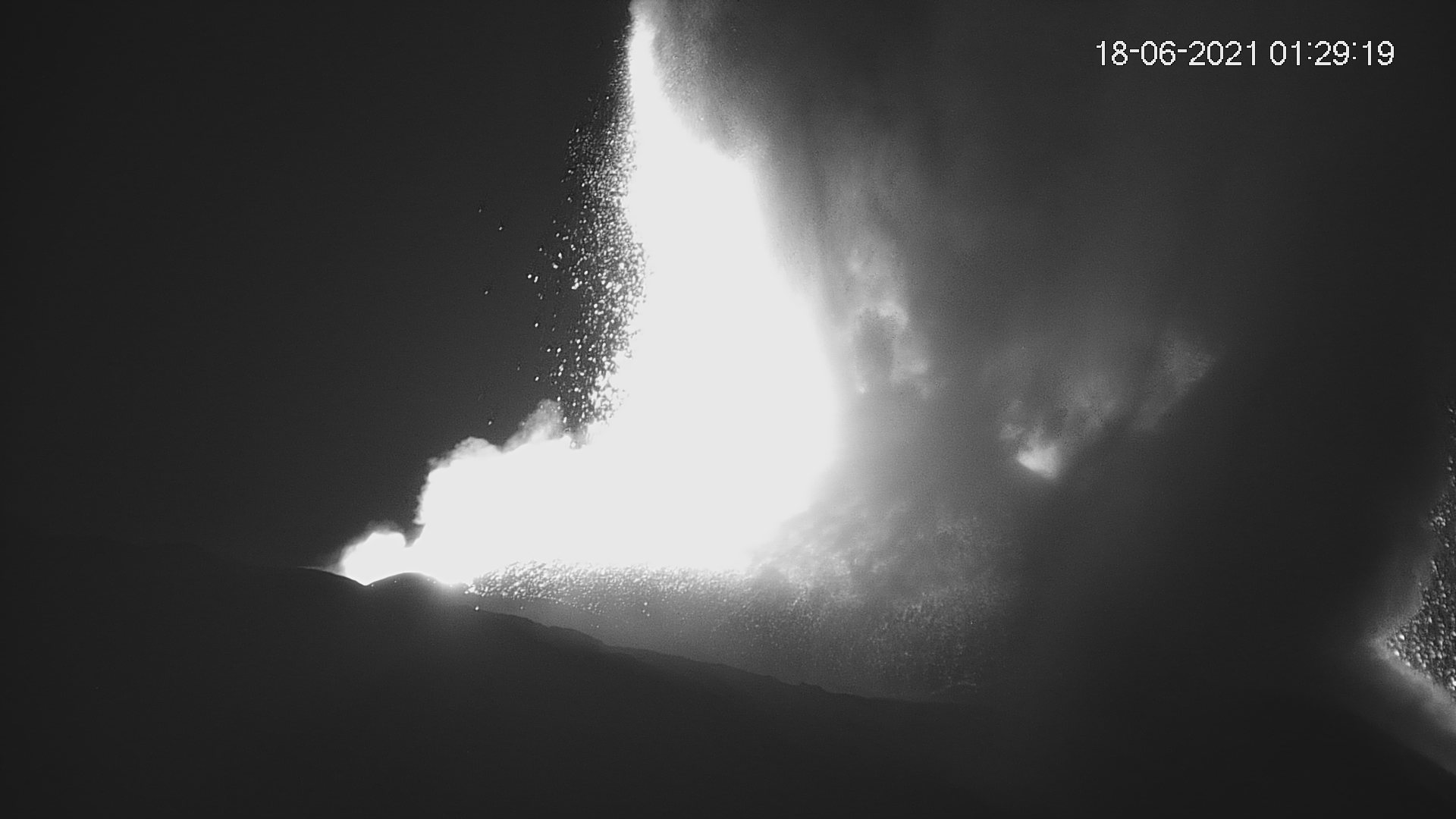
Lava fountain from Etna last night (image: LAVE webcam)
Only about a day and a half since the paroxysm in the early afternoon of 16 June, another one occurred early on 18 June from the New SE crater:
After a quiet interval of approx. 30 hours, weak strombolian activity started again to appear at the New SE crater after midnight 17-18 June, then quickly intensified and produced sustained lava fountains several hundred meters tall between 1.20 - 2.10 am (local time). Another lava flow traveled from the southern crater rim towards the SW.
The similarity of the latest events and their quite regular occurrence at similar but decreasing trend suggest that the volcano again is in a phase of rhythmic behavior of short-lived, but violent lava fountaining episodes following each other at similar intervals of currently around 36-40 hours. A next event like this might well occur during the afternoon of Sat, 19 June, if the pattern continues to repeat.
New SE crater has paroxysm in less than 2 days
Update Wed 16 Jun 2021 16:12
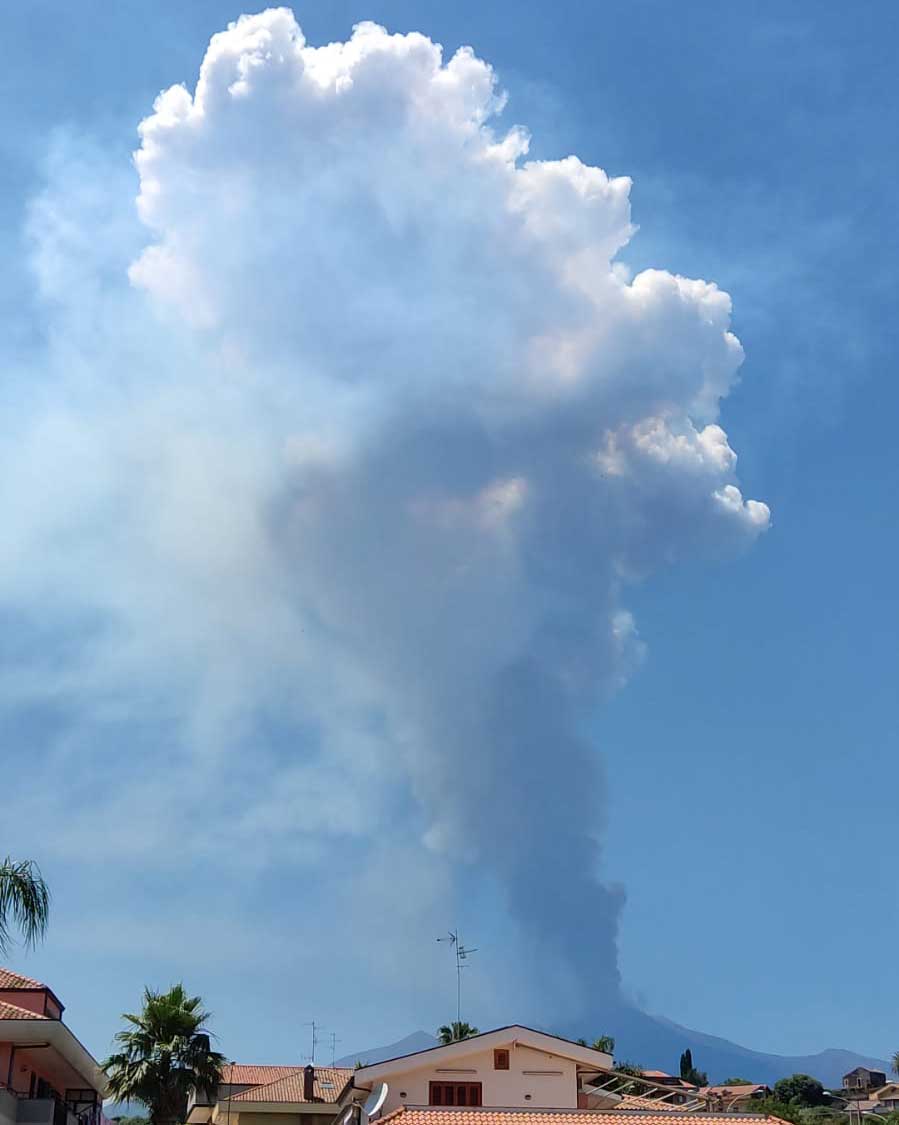
Eruption column from today's paroxysm at Etna (image: INGVvulcani / facebook)
Yet another short-lived lava fountaining episode, or paroxysm, occurred today at the New SE crater only about 40 hours since the previous one.
Accompanied by a steeply rising volcanic tremor signal, strombolian activity began to appear at the crater in the early afternoon and increased quickly from 13:30 local time, reaching lava fountains by 14:08. These lasted until 14:50, making it one of the shorter episodes.
Just as during the previous ones, a lava overflow traveled from the southern crater rim area to the SW during the event.
Another powerful lava fountaining episode over night
Update Tue 15 Jun 2021 15:00
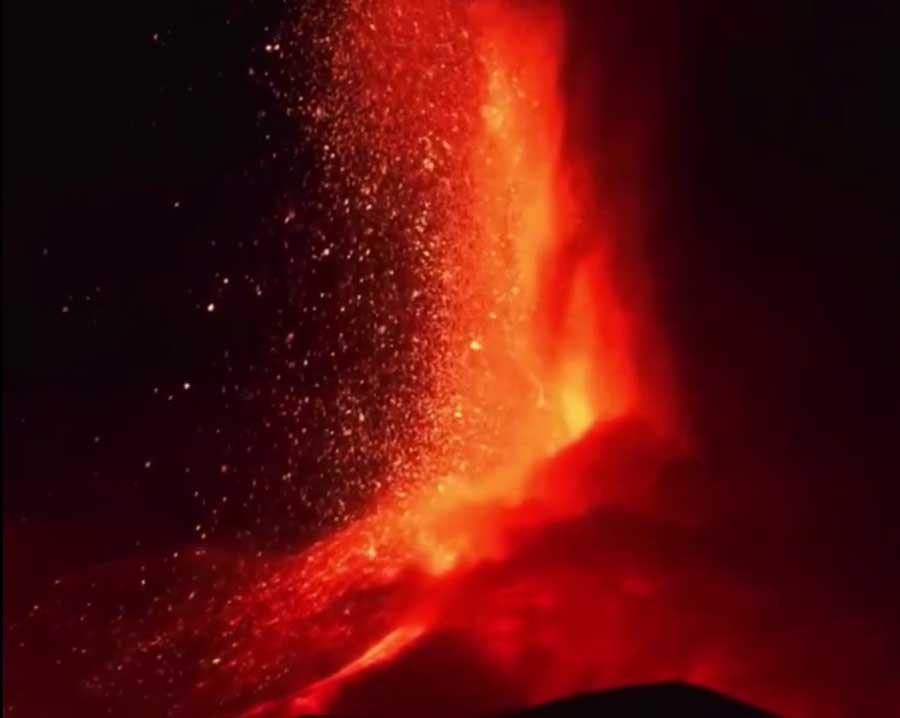
Lava fountain during last night's paroxysm at Etna's New SE crater (image: Roberto Viglianisi / facebook)
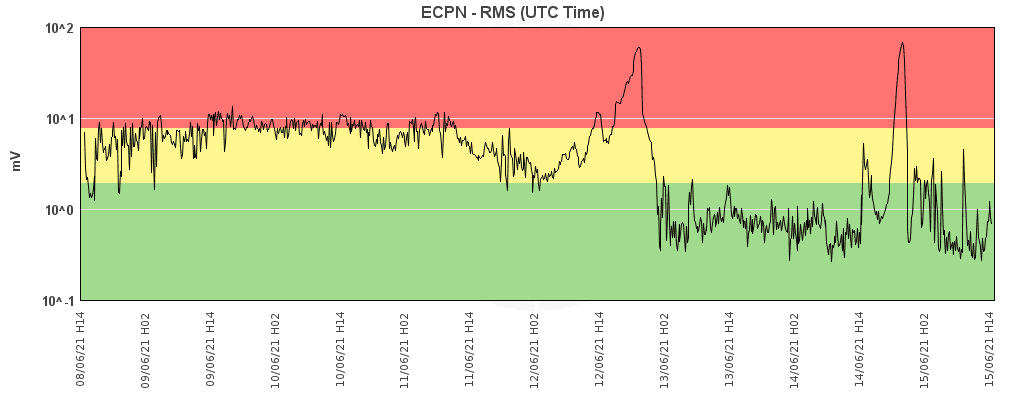
Current tremor signal (image: INGV Catania)
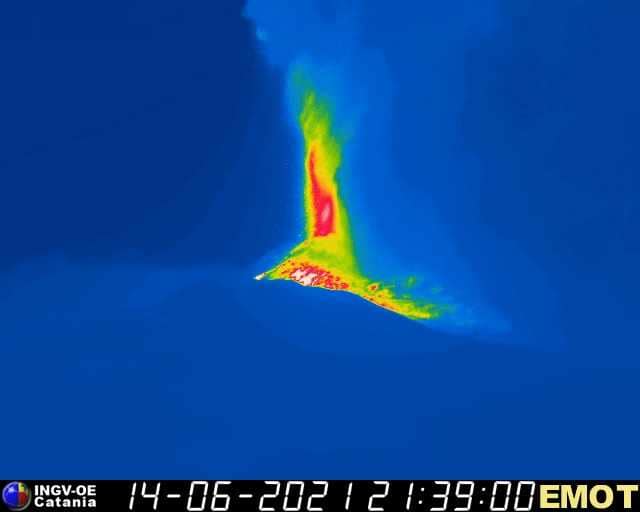
Thermal image showing the lava fountain (image: INGV Catania)
Just two days since the preceding one, another paroxysm occurred at the New SE crater over last night 14-15 June 2021. As the intervals had been longer and the beginning of the most recent paroxysms was generally a longer period of fluctuating and overall increasing activity, it came a bit as a surprise.
Very weak and intermittent strombolian activity restarted at the crater probably during the afternoon or early evening yesterday. At around 22:56, this activity began to increase quickly, along with a sharp increase of volcanic tremor to high values. By 23:45 had reached the stage of continuous, tall lava fountains rising several hundred meters. The eruption column produced an ash plume that rose to approx. 6000 m above sea level. The peak phase occurred around midnight and lasted until about 00:20, when activity - as usual - dropped sharply and more or less ceased.
As during the previous paroxysms, some of the lava formed a flow issued from the southern part of the crater and traveling to the SW.
Link: Video of the eruption (Roberto Viglianisi / facebook)New paroxysm Saturday evening - lava fountains light up Sicily's sky
Update Sat 12 Jun 2021 22:06

Lava fountain during Saturday night's paroxysm at Etna volcano (image: INGV thermal webcam)
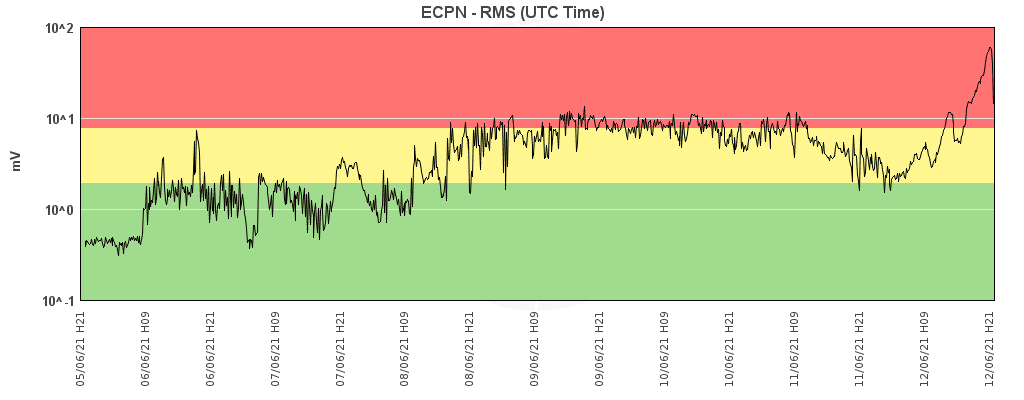
Current tremor signal (image: INGV Catania)
A powerful paroxysm - or lava fountaining episode - is in progress at the volcano now at the SE crater. After a week of activity fluctuating between moderate and high levels, Etna decided again to escalate into a short-lived phase of intense lava fountains.
This episode comes about a week since the last one on 4 June. In the time between, the volcano had not calmed down as usual during intervals, but remained active with weak to moderate strombolian activity from the crater, and moderate to high tremor levels, indicating that the magma column had not subsided a lot since.
The newest episode this evening began to produce lava fountains from around 21:45 pm local time and lasted until about midnight. This time, the activity was noticeable stronger than during the previous shorter episodes observed in late May and more similar to typical paroxysms such as those in February and March earlier this year.
The lava flow from the southern flank of the crater was well alimented and continued to travel towards the SW. Another lava flow emerged during the paroxysm from the east side of the cone and reached the western headwall of the Valle del Bove.
Increasing activity and small lava flow from New SE crater
Update Sat 12 Jun 2021 16:55
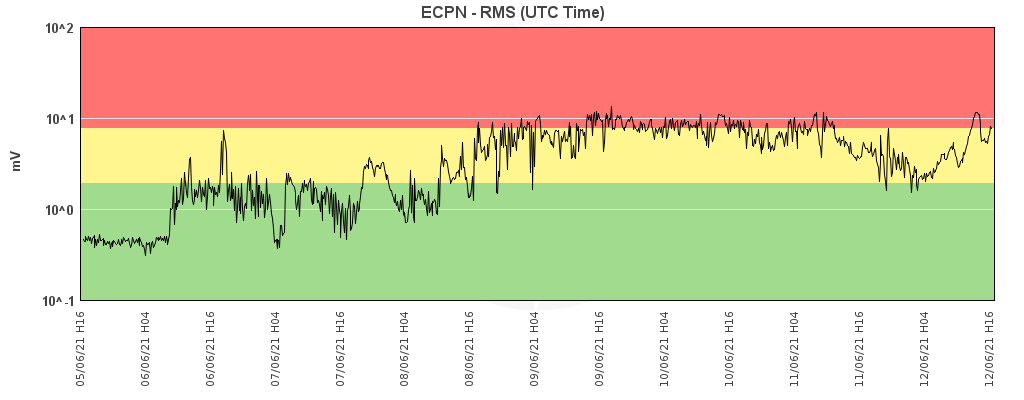
Current tremor signal at Etna volcano (image: INGV Catania)
Things remain very dynamic at Europe's most active volcano: Since yesterday morning, strombolian activity at the New SE crater began to increase, followed by the appearance of a lava overflow issued from a vent on the southern flank of the cone, which traveled towards the southwest.
The mean amplitude of the volcanic tremor continued to grow reaching high values and its source was found to be at shallow depths beneath the crater - all pointing towards a possible new paroxysm.
This trend reversed itself again temporarily, and then recovered and seems to be on the increase again now: it looks as if the New SE crater is undecided whether or not to go for a paroxysm or not...
Volcano becoming restless, strombolian activity at SE crater increases
Update Wed 09 Jun 2021 20:06
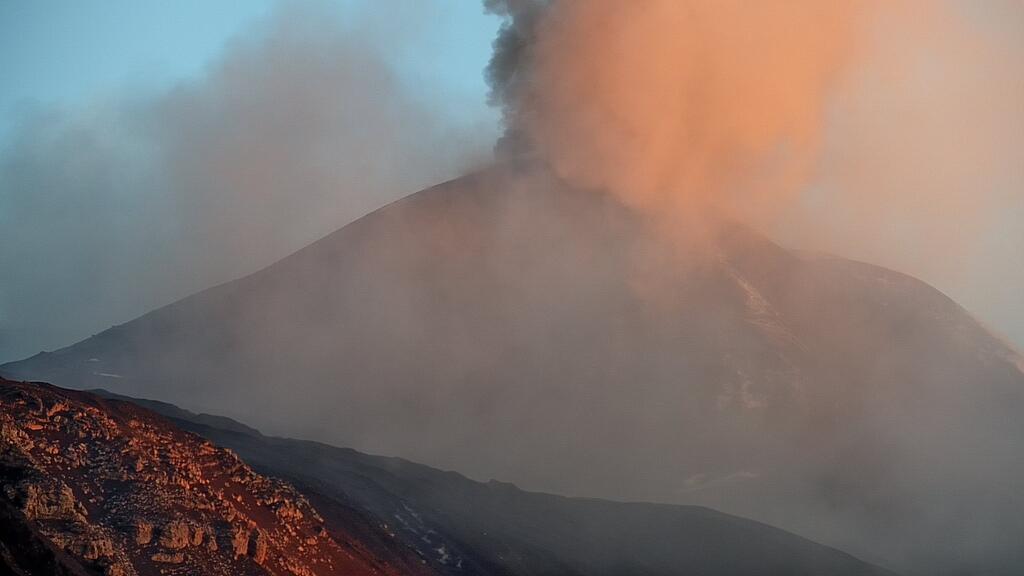
Ash emission from Etna's New SE crater this morning (image: LAVE webcam)
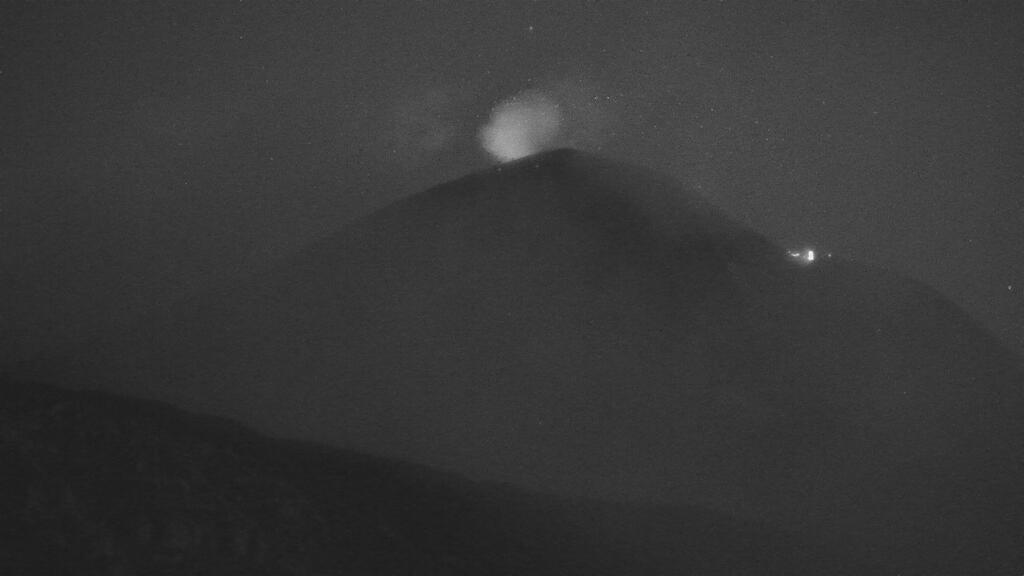
Glow from the New SE crater early this morning (image: LAVE webcam)
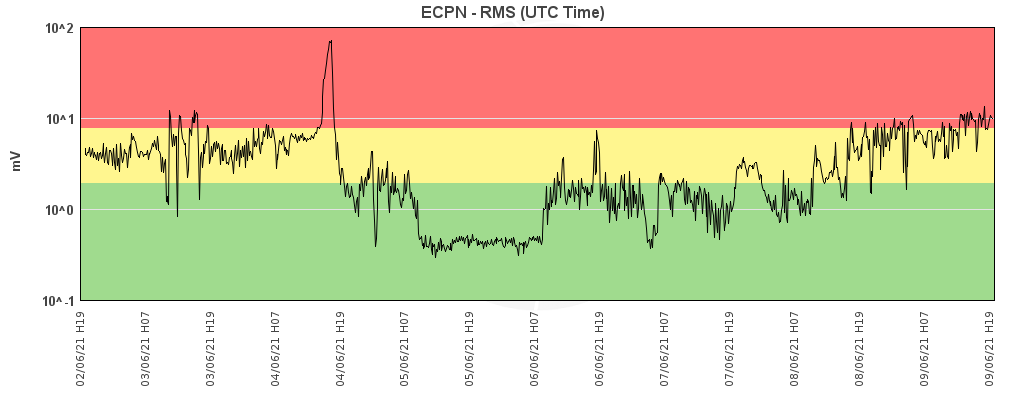
Current tremor signal (image: INGV Catania)
The volcano's New SE crater has become more and more active over the past few days, and started to show weak strombolian activity of varying intensity since yesterday morning. This activity produces occasional ash emissions which are rapidly dispersed in the summit area.
Over the past days, volcanic tremor amplitude has been showing continuous oscillations, with an overall gradually increasing trend, reaching high values during the past 24 hours. According to the volcano observatory, the source of the tremor - corresponding to the area of magma movement - is located under the SE Crater area at an elevation of 2800-2900 m above sea level, or 300-400 m below the crater rims.
No significant variations of ground deformation have been observed.
Although it has not (yet) produced another paroxysm since the last one past Friday, it might be heading towards one, or otherwise maybe shift towards a longer phase of moderate, persistent activity.
New paroxysm Friday evening
Update Sat 05 Jun 2021 05:52
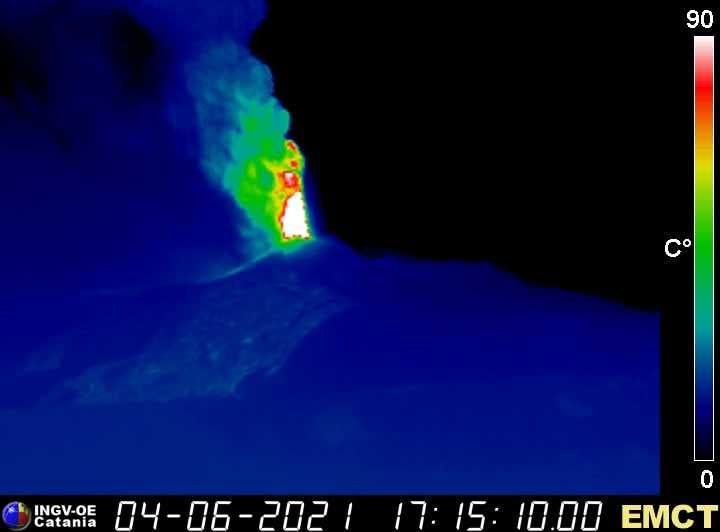
Lava fountain during last night's paroxysm at Etna (image: INGVvulcani / facebook)
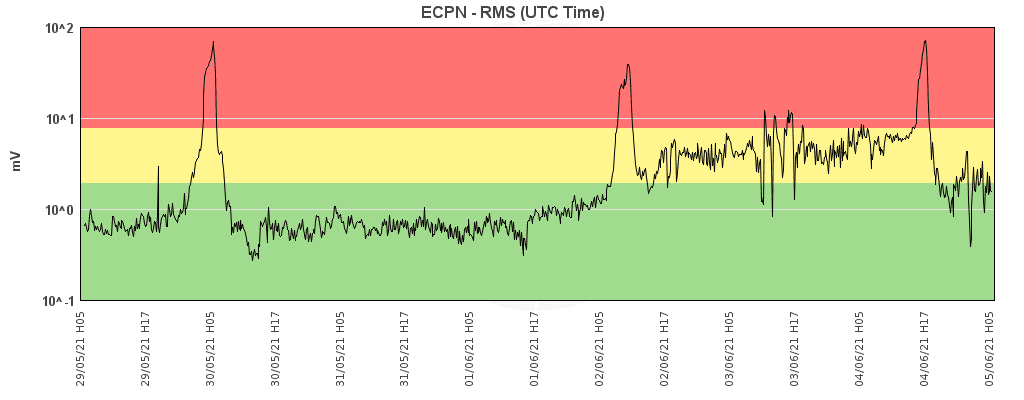
Current tremor signal (image: INGV Catania)
Two and a half days after the previous one, the New SE crater produced yet another phase of lava fountaining (paroxysm) yesterday evening 4 June 2021.
It was preceded by a relatively long phase of weak to moderate, but intermittent strombolian activity and fluctuating tremor levels - contrary to most other episodes, the activity had not dropped to low levels after the previous paroxysm, but remained moderate.
The activity increased rapidly after 18:00 local time, then passed to lava fountaining at around 18:20, which generated an ash plume that rose to approx. 6500 meters above sea level and drifted SE.
Like during the previous paroxysms, a lava flow traveled from the rim of the saddle vent area of the New SE crater towards the SW.
The lava fountain ended around 19:30 and activity dropped again sharply. However, the lava flow remained weakly alimented for several hours. By midnight, it had reached an elevation of 2800 m below the Torre del Filosofo area.
New paroxysm this morning with lava fountains up to 400 m tall
Update Wed 02 Jun 2021 16:10
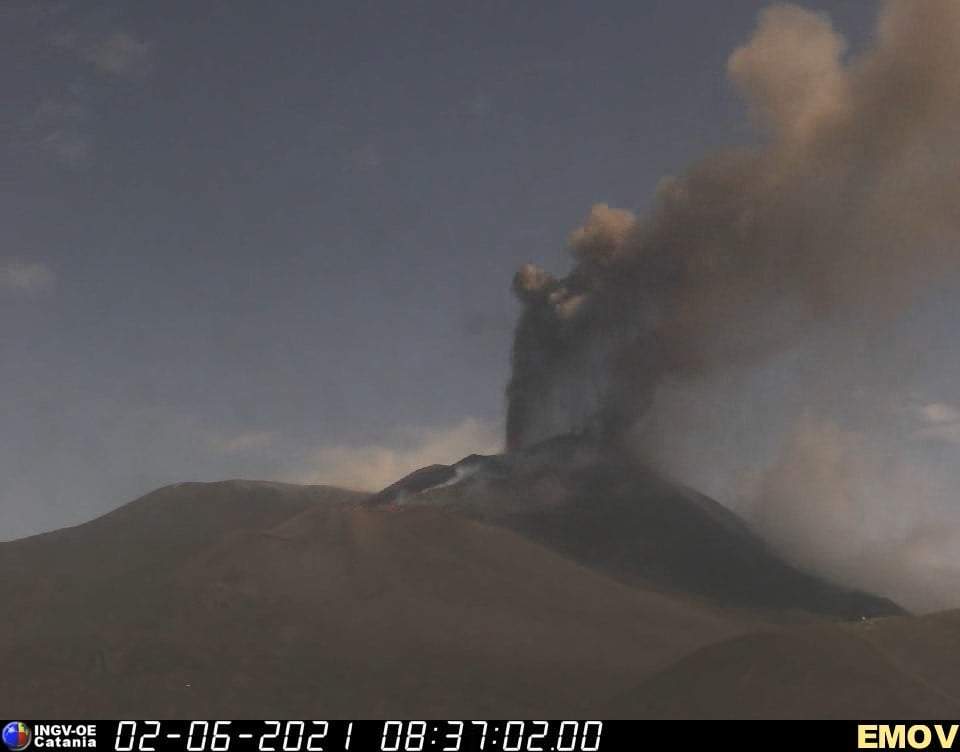
Lava fountain during Etna's paroxysm this morning (image: INGV Catania webcam)
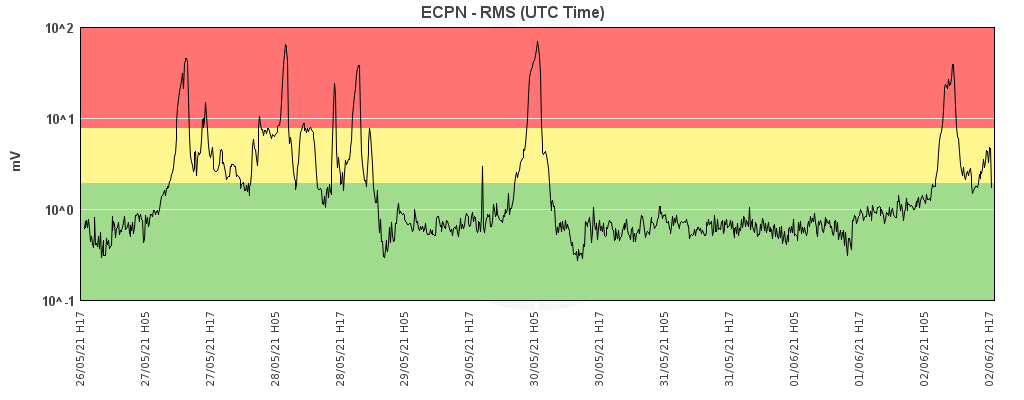
Current tremor signal
The volcano produced yet another lava-fountaining episode or paroxysm from the New SE crater this morning. 3 days since the previous one, it followed the by now "usual pattern":
Volcanic tremor began to increase from around 8 am, followed by the onset of weak strombolian explosions at the New SE crater's saddle vent from around 9:45. This activity increased slowly first, then very quickly reached the phase of lava fountains at 10:30 local time, generating an eruptive column that rose several kilometers and drifted east-southeast.
Ash and small lapilli (up to 1.0-1.5 cm) was falling in the northern part of Zafferana Etnea and in Santa Venerina town.
The activity also produced a modest overflow of lava, which traveled southwest. During the phase of maximum intensity, the lava fountains reached heights of 300-400 m. Two vents were periodically active in the "saddle" area, as already observed during the eruptive episodes on 28 and 30 May 2021.
The lava fountain activity lasted until about 12:40 local time, after when the explosive activity quickly decreased and mostly finished at 12:50.
The magnitude of the volcanic tremor showed the usual, rather sudden increase at the beginning of the episode, and a rapid collapse at the end; during the paroxysm, its source was located under the Southeast Crater. The infrasonic signals also came from the same crater; small variations in tilt were recorded, as usual during the eruptive episodes at the Southeast Crater.
Source: adapted from INGVvulcani / facebookParoxysm on the morning of 30 May 2021
Update Tue 01 Jun 2021 13:46
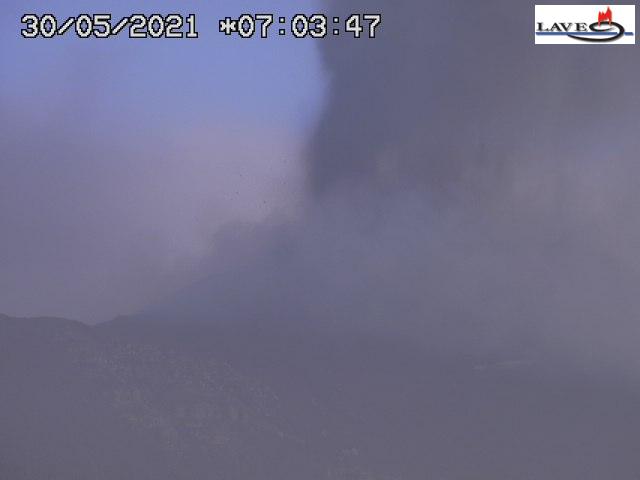
View of Etna's paroxysm in the morning of 30 May 2021 (image: LAVE webcam)
Since the latest lava fountaining phase at the New SE crater early on Sunday 30 May 2021, the volcano has remained more or less calm.
The so-far latest paroxysm began to announce itself 03:10 local time, when volcanic tremor began to rise, followed by the onset of strombolian activity at around 05:45. This activity rapidly increased and turned into lava fountaining by 06:30 which lasted about an hour and produced an ash plume that rose to estimated 6500 m altitude.
By 07:45, it had ceased. Similar as during the previous episodes, a the lava fountaining produced a lava overflow from the rim of the crater towards the SW.
Due to bad weather conditions, the event was not very well observed visually.
Two short lava fountains in the afternoon and evening of 28 May
Update Sat 29 May 2021 19:15
Two short lava fountaining episodes occurred last evening. The first weak one from 18:00-18:15 local time, followed by a pause of activity until 21:47 when strombolian activity again set in at the New SE crater, leading to a another lava fountaining phase from around 22:00-22:40 local time.
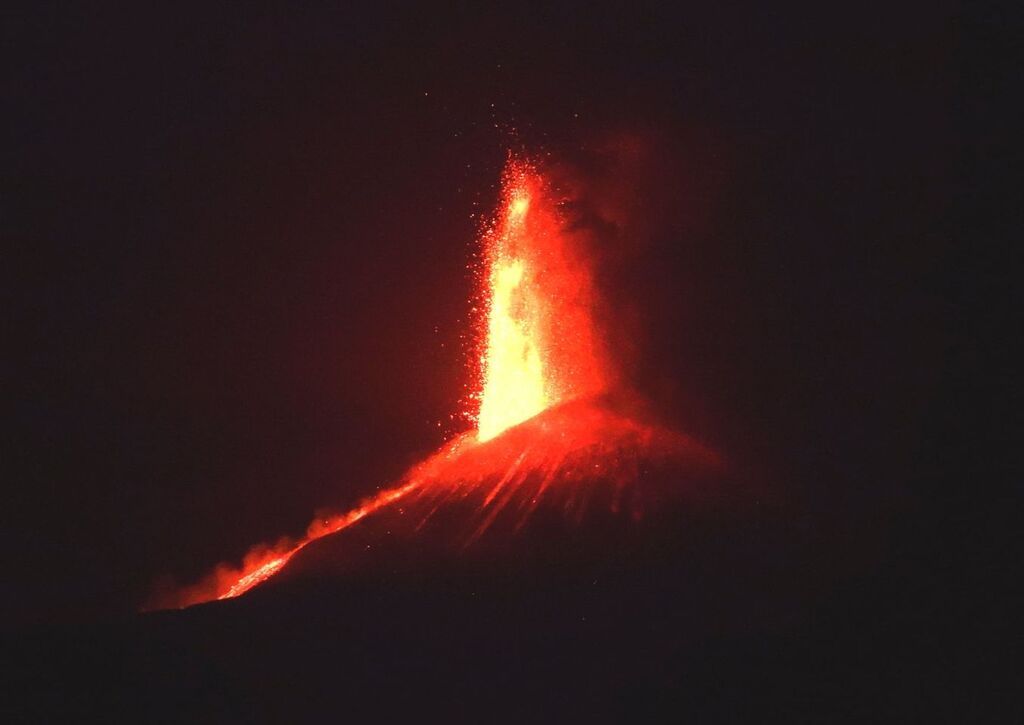
Lava fountain from the saddle vent of the New SE crater on the evening of 28 May 21 (image: INGVulcani / facebook)
Etna volcano (Italy): two more "mini paroxysms" today so far
ven., 28 mai 2021, 16:32 16:32 PM | AUTEUR : T
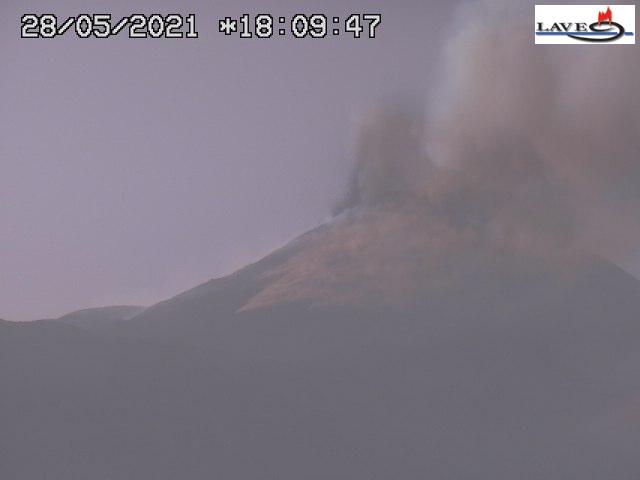
Lava fountain episode at Etna's New SE crater this afternoon
The New SE crater produced two short-lived weak lava fountaining episodes today, one in the morning during around 9:30-10:30 am local time and one in the afternoon / early evening that started around 17:40 and is in progress at the time of this update.
In both cases, the activity and its evolution followed the same pattern as observed in the past days: after being more or less silent at the end of the previous episode, strombolian activity picks up along with rapidly increasing volcanic tremor signal (internal vibrations corresponding to rising magma). It rapidly increases, typically within an hour or two after beginning, reaching a short phase of sustained lava fountaining from the summit vent at the crater, known as the Saddle vent.
However, these recent episodes, if they can be called paroxysms, seem to only generate lava fountains of modest intensity when compared to paroxysms observed earlier in May and during Feb-March this year. This might explain the current frequency of several events occurred per day now, vs typically one paroxysm at intervals of at least 36-40 hours or longer (but much stronger).
Another paroxysm with this afternoon, and likely one more to come soon
Update Thu 27 May 2021 16:42
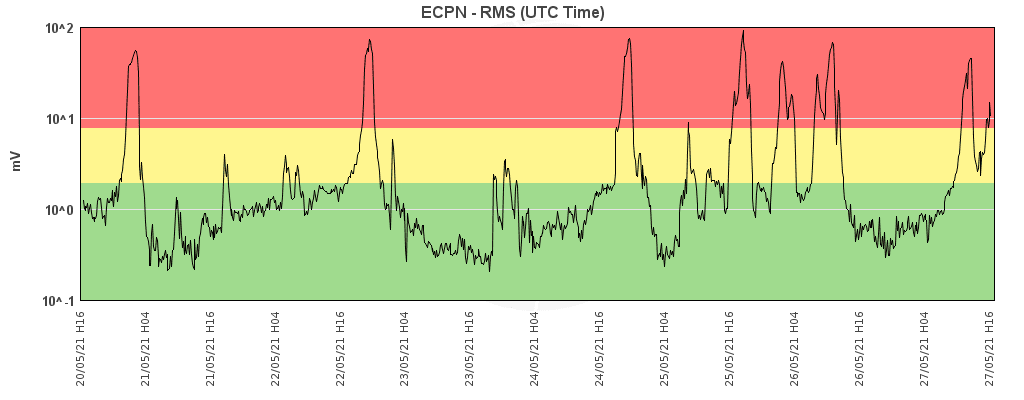
Current tremor signal showing the peaks of the recent and likely to be soon paroxysms (image: INGV Catania)
Another intense eruptive phase likely with lava fountains occurred this afternoon, but due to cloud cover, it was not possible to observe it very well visually.
Tremor started to rise in the morning, followed by increasing explosions and ash emissions from the New SE crater. It reached high peak values between around 14:40 and 15:15 local time, when the activity likely consisted in sustained lava fountains. Activity dropped sharply afterwards only to pick up again after about 2 hours and is currently again rising, possibly giving way to yet another lava fountain phase in the next hours or so.
4th lava foutnaining phase in less than a day
Update Wed 26 May 2021 17:56

Lava fountain at Etna around noon today (image: LAVE webcam)
Shortly after the short lava fountaining phase in the morning, another similar eruptive phase occurred only about 90 minutes later: at around 11:40 local time, activity at the New SE crater again picked up and passed to lava fountaining by noon.
Yet another small lava flow was erupted to the SW. The lava fountaining phase lasted until around 13:30 and activity rapidly decreased as usual. The eruption plume reached 7000 m above sea level according to an activity update of INGV Catania.
Video of the eruption:
After 4 small paroxysms in little more than 12 hours, Etna so far has stayed more or less calm for the rest of today so far.
Etna volcano (Italy): another short violent phase of lava fountain this morning
mer., 26 mai 2021, 08:57 08:57 AM | AUTEUR : T

Lava fountain from Etna's New SE crater this morning (image: INGV webcam on Montagnola)
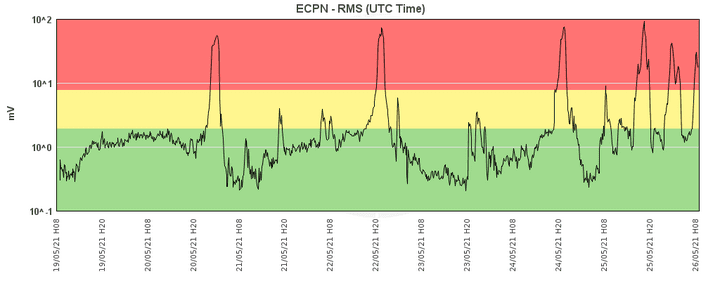
Current tremor signal showing the peaks of this morning's paroxysms (image: INGV Catania)
A third, brief phase of lava fountaining occurred this morning between around 9.30-10 am this morning. A dense ash plume drifted eastwards.
This marks the 3rd small paroxysm in a row in less than 24 hours.
Intense fireworks - two lava fountain episodes over night
Update Wed 26 May 2021 07:13
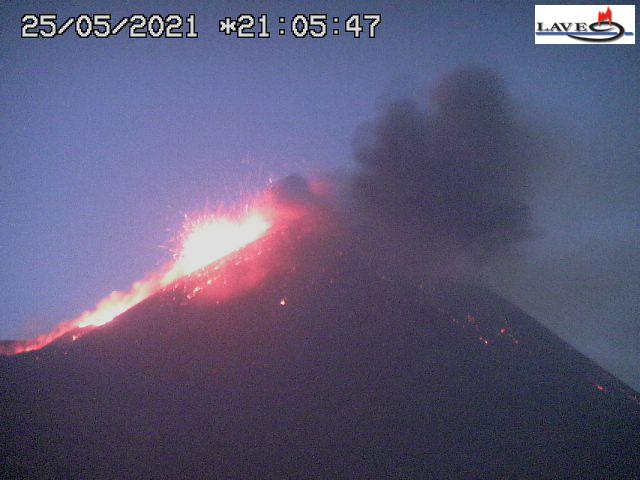
Activity at Etna's New SE crater last night
After the rather surprising onset of a new intense phase of activity in the late afternoon, the New SE crater produced not only one, but two paroxysms during the night, marking them the 26th and 27th such episodes for 2021 so far.
Likely compensating the suddenly much shorter intervals, the eruptions were significantly weaker, though, when compared with earlier paroxysms observed in Feb-Mar and May this year.
Last night's activity reached its peak between around 20:30-21:30 local time, when explosions from the New SE crater merged into lava fountains and the lava flow towards the SW was most strongly fed.
Activity abruptly ceased and volcanic tremor dropped sharply and returned to low levels by 22:30. The volcano remained calm until 02:40 am early this morning. Calm, this is except occasional glow hinting towards that strombolian explosions from Voragine central summit crater still go on as well. Like the other summit vents of Bocca Nova and NE crater, the Voragine seems to act almost completely unaffected by what is happening at the New SE crater.
The calm didn't last very long, though: at 02:40, activity suddenly picked up again at the New SE crater and quickly developed a second paroxysm with lava fountaining that lasted until around 4am, before ceasing again. As during the preceding phase, yet another lava flow was erupted from the main vent of the New SE crater towards the southwestern base.
The following time-lapse shows the whole sequence of activity between yesterday afternoon and this morning:
How the activity likely will continue is uncertain - given that the volcano has broken the rather stable pattern of 40-48 hours between individual events, it hints that it is in a more unstable phase right now, and it can only be speculated upon what and when might come next.
Intense strombolian activity from New SE crater - possibly new paroxysm after less than 24 hours?
Update Tue 25 May 2021 18:01

Strong ash emissions from strombolian explosions at the New SE crater of Etna (image: LAVE webcam)
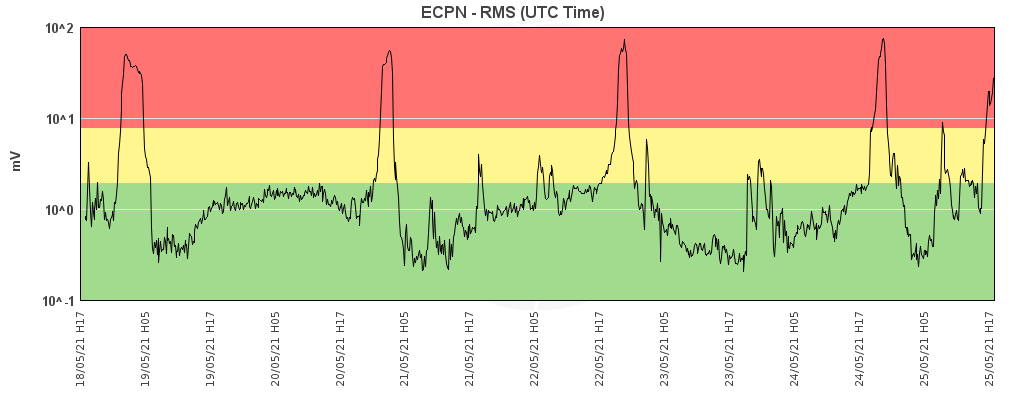
Current tremor signal (image: INGV Catania)
Starting from 17:30 local time, volcanic tremor once again started to rise sharply and from around 18:20, intense strombolian activity started at the New SE crater, producing dense ash plumes that rose a few 100 meters and drifted into easterly directions.
This activity seems to be still increasing and if continues might well lead up to yet another paroxysm, this time less than 24 hours since the previous one!
Clockwork Etna - 4th paroxysm in a row of near-identical intervals
Update Tue 25 May 2021 07:14
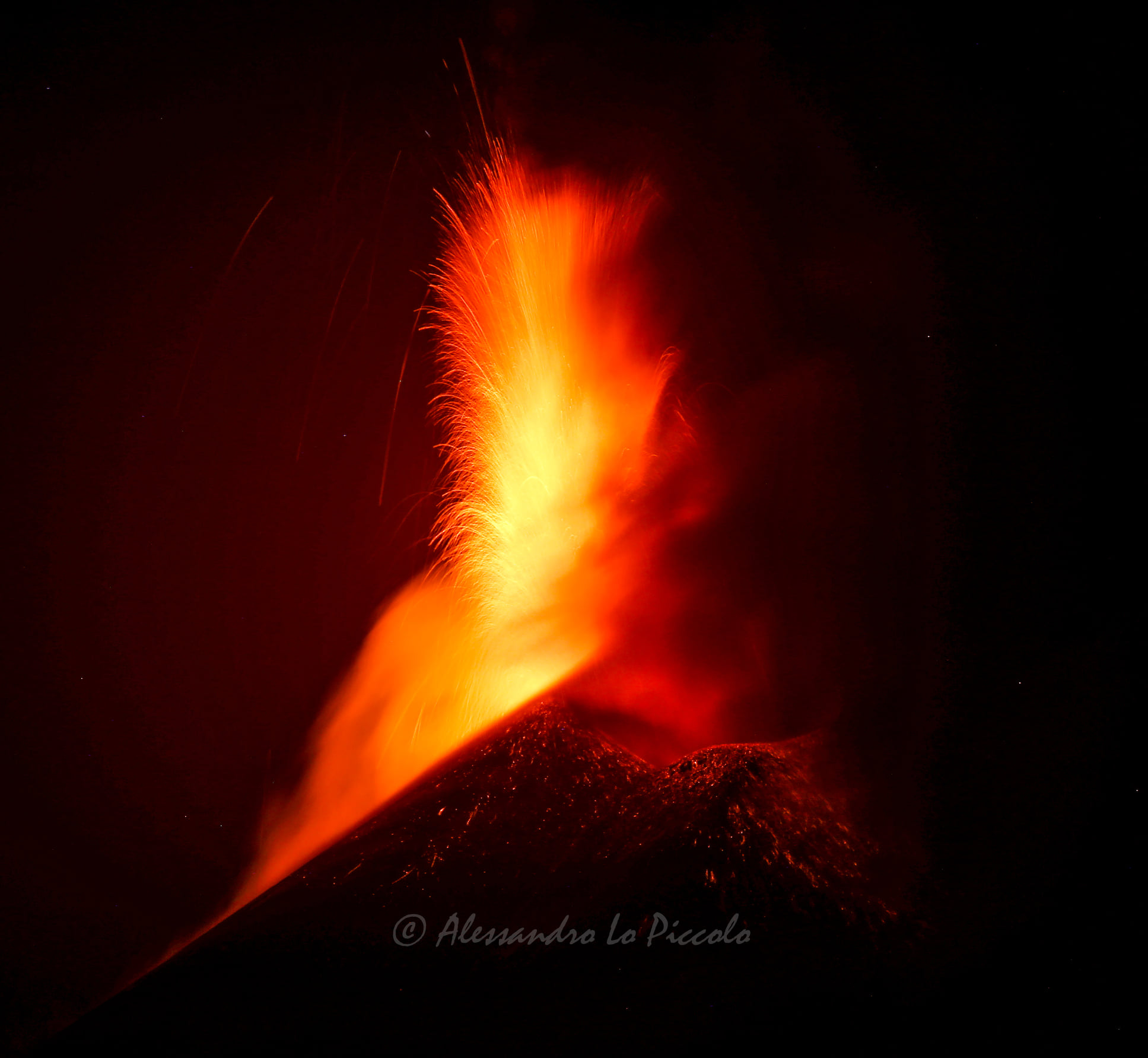
Etna's lava fountain on 24 May 2021 night (image: Alessandro Lo Piccolo / facebook)
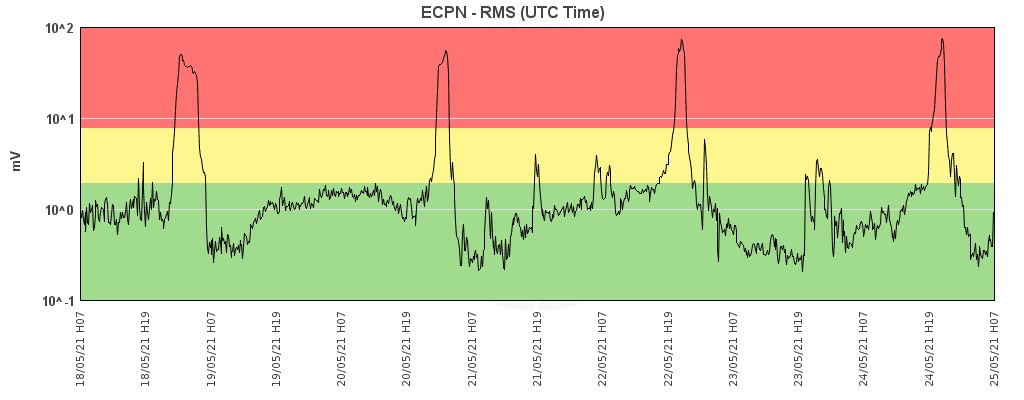
Current tremor signal showing the 4 peaks of the recent paroxysms (image: INGV Catania)
Like clockwork, approx. 48 hours after the previous one, Etna produced a 4th paroxysm in a row with near-identical time intervals from the New SE crater last night. It marked the 25th lava-fountaining episode during 2021.
The eruption followed very much the style observed during the previous lava-fountaining episodes: first, from 20:58 local time, strombolian activity resumed at the New SE crater while volcanic tremor began again to rise and its source moved to the area of underneath the New SE crater.
About 1 and a half hour later, activity had increased towards sustained lava fountains from 22:25 on. A tall plume of ash and scoria lapilli drifted ENE. The lava fountain lasted until midnight, when it rapidly ceased.
A lava flow was erupted that like during the previous episodes last week traveled to the SW from the New SE crater.
Lava fountains light up Sicily's sky during Etna's 3rd paroxysm in May 2021
Update Sun 23 May 2021 07:43
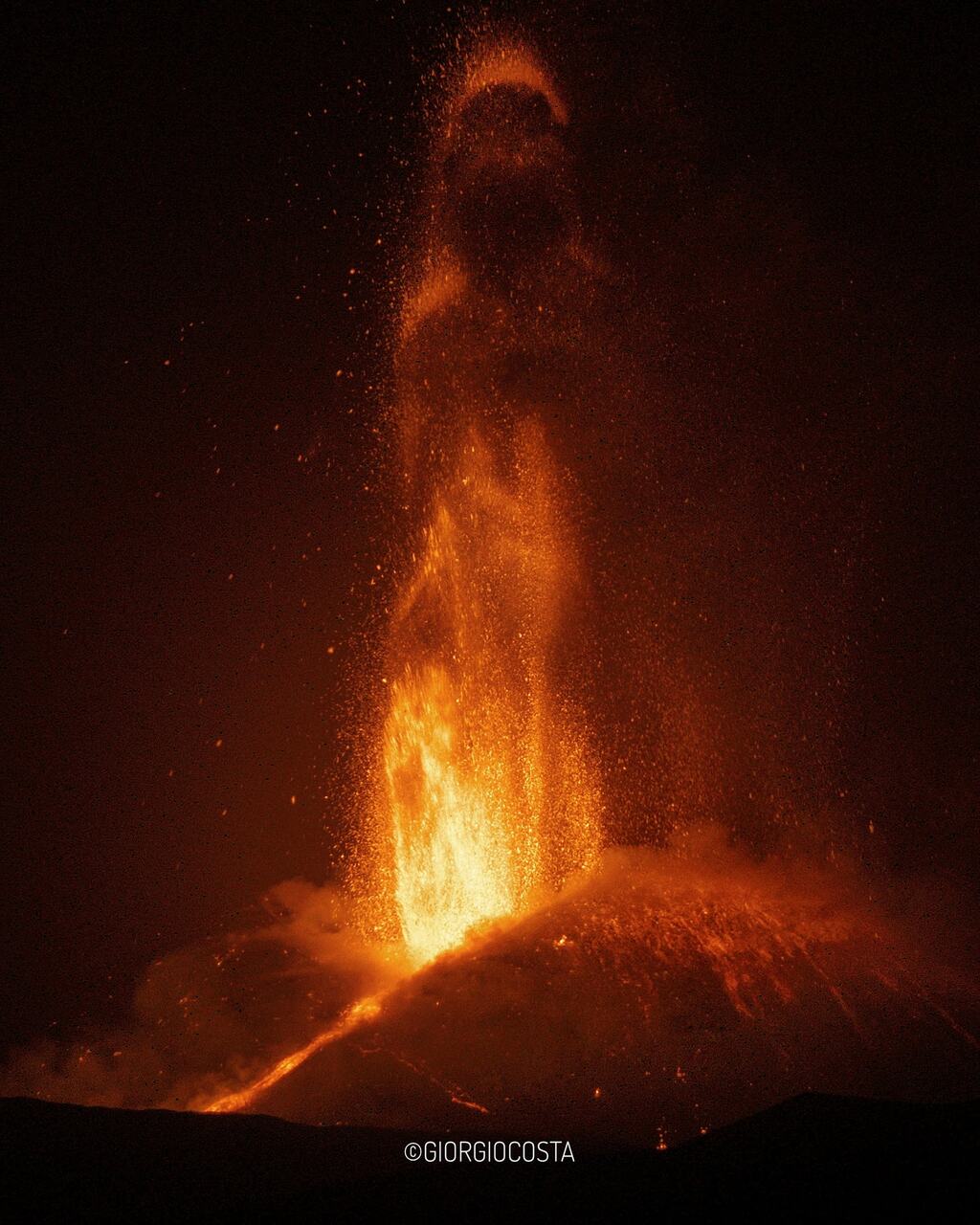
Lava fountain during yesterday's paroxysm at Etna (image: Giorgio Costa / facebook)
The latest paroxysm of Etna occurred during last night 22-23 May 2021, following about 40 hours since the previous one during 20-21 May, and marking the 3rd such episode in a row in May or number 20 during the year 2021 so far.
Similar as during the preceding two eruptions, the main active vent was in the summit region of the New SE crater, the one known as "saddle vent" (because it used to be in a small depression between the old SE crater and the "New" SE crater, which has been growing a large cone complex to the side of it since 2011).
The peak phase of the eruption occurred between 22:30 local time and midnight. As typical for such paroxysms, the activity ended abruptly, and had ceased by 00:30. Approx. two hours later, a brief phase of reactivation with strong explosions occurred again from the New SE crater, but ceased again quickly.
During the eruption, another rather small lava flow was formed from the cone that traveled to the SW and overlapped older lava flows in this area.
Etna volcano (Italy): 3rd paroxysm in a row
sam., 22 mai 2021, 21:33 21:33 PM | AUTEUR : T
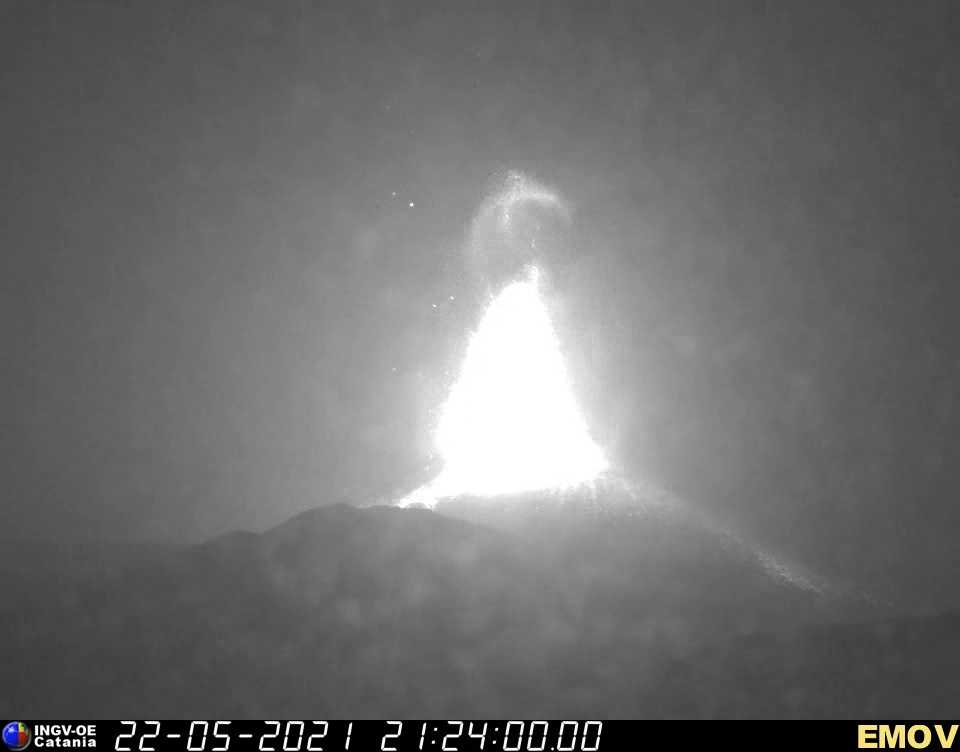
Lava fountain from Etna's New SE crater (image: INGV webcam on Montagnola)
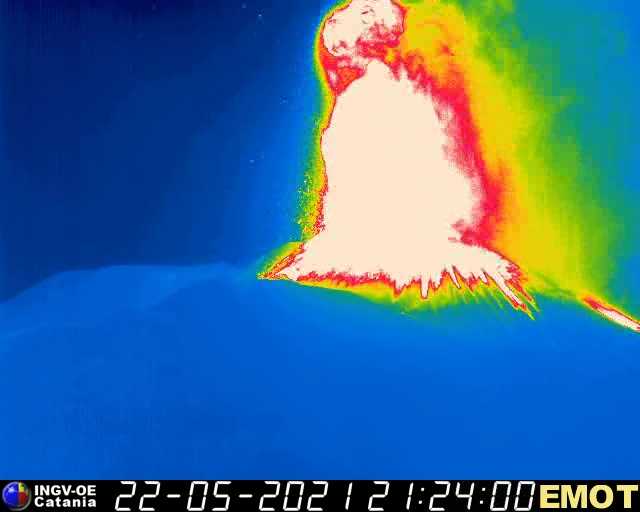
Thermal image of the same view
The 3rd paroxysm or lava fountaining episode in a row is occurring at the volcano right now.
After a gradual climb, activity rapidly increased at the New SE crater during the past hours and is now producing a lava fountain. An ash plume is rising several kilometers and drifting towards the east.
The current eruption came at almost exactly the same interval, approx. 48 hours, as between the previous two. It looks as if the volcano once again has embarked on a rhythmic pattern of paroxysms, similar to what had occurred during Feb-April earlier this year.
Increasing tremor and beginning of small explosions at New SE crater
Update Sat 22 May 2021 10:09

Small explosion at Etna's New SE crater earlier today (image: LAVE webcam)
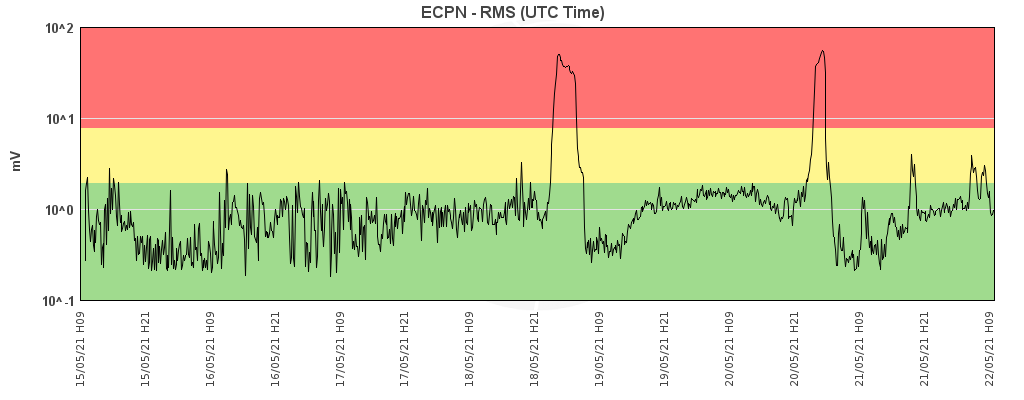
Current tremor signal showing the two peaks of the recent paroxysms (image: INGV Catania)
Activity at the New SE crater is again gradually picking up.
Starting from 07:30 local time, a constant increase in volcanic tremor amplitude was registered and its source moved to the vicinity of the SE Crater at a depth of about 2.8 km above sea level (or approx. 500 m below the crater rim itself).
Sporadic deep-seated intra-crater explosions and later small strombolian explosions are being observed from the summit vent of the SE Crater.
Small ash plumes were generated that drift east-southeast.
This might be an early indication that the volcano is again heading towards a paroxysm, which might (or not) follow the same intervals of 48 hours as it did often in the past, but it is still early to know for sure.
Spectacular new lava fountaining episode just after 48 hours
Update Fri 21 May 2021 05:54

Lava fountain at Etna early this morning (image: Giorgio Costa / faceebook)

The eruption seen from the Sciena dell'Asino - only the summit and western vents were involved (LAVE webcam)
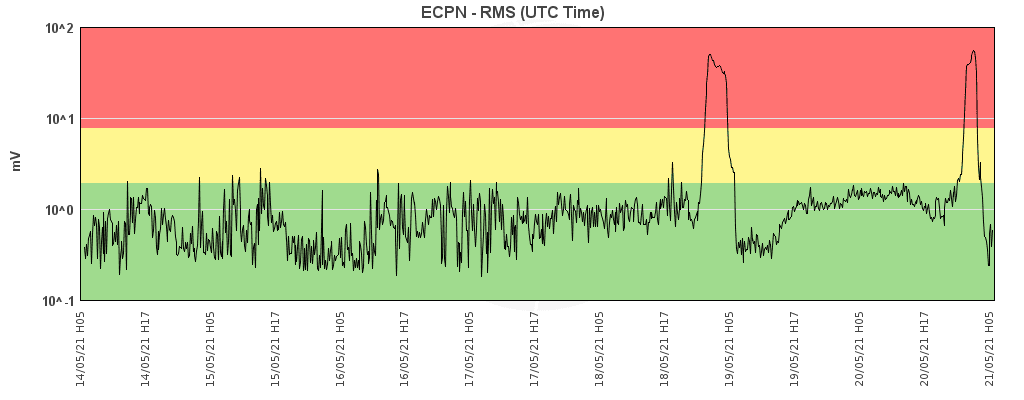
Current tremor signal showing the two peaks of the recent paroxysms (image: INGV Catania)
Another spectacular lava fountaining episode (or paroxysm) occurred at the volcano over night, again from the New SE crater. It came almost exactly 48 hours after the surprise eruption that had taken place during the night of 18-19 May:
It evolved in a very typical fashion, again. After having been almost completely silent since the end of the previous eruption, signs of life returned around 1.30 local time early this morning. From 1.34 am, strombolian activity set in at the New SE crater's summit vent and began to quickly pick up in frequency and intensity over the next 90 minutes.
By 3 am, it had merged into sustained lava fountains that reached heights of approx. 500 meters. The lava fountaining phase lasted about 2 hours, and, as typical for Etna's paroxysms, suddenly and rapidly ceased at around 5 am in the morning.
During the eruption, the eastern vents of the SE crater were not or only weakly active, while most activity had been from vents on the central and western vents. Only a small lava flow was erupted as overflow from the central crater area towards the SW (Torre del Filosofo area), following and overlying the paths of numerous previous lava flows erupted in the past months and years.
Are we at the beginning of another series of lava fountaining phases with regular and rather short intervals? Only Etna knows, but it might very well be so. It will be interesting to see what happens at the volcano in the next 48 hours or so...
Image credit:
Giorgio Costa / facebookEtna volcano (Italy): surprise paroxysm - lava fountain illuminates morning sky
mer., 19 mai 2021, 13:30 13:30 PM | AUTEUR : T
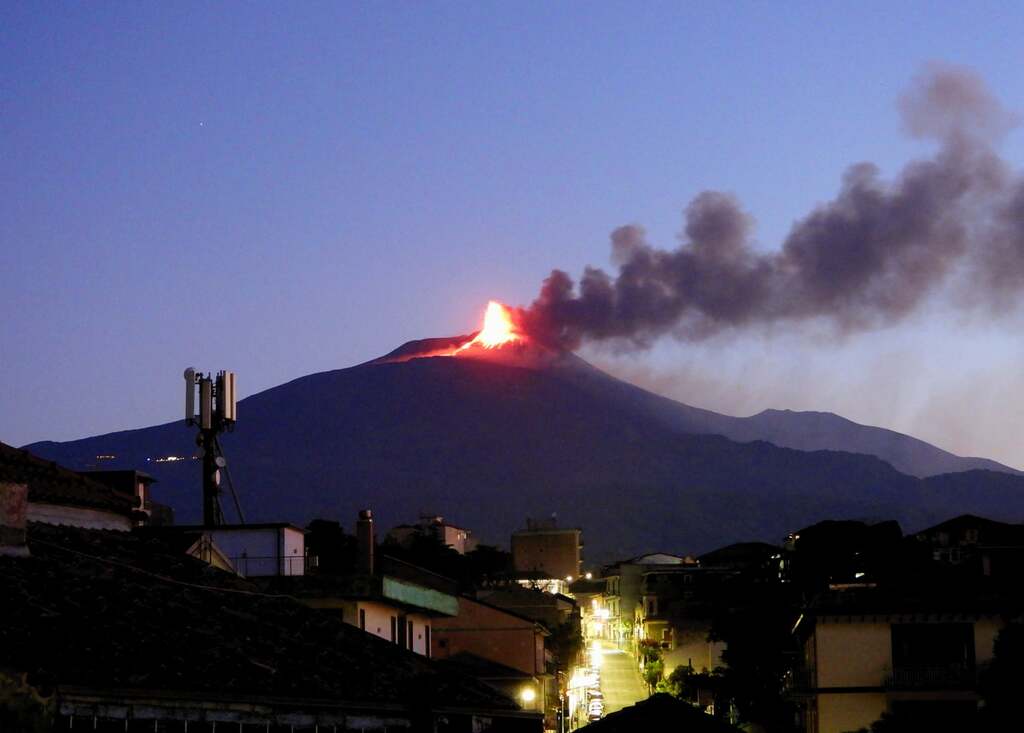
The eruption of Etna seen early this morning (image: Boris Behncke / facebook)
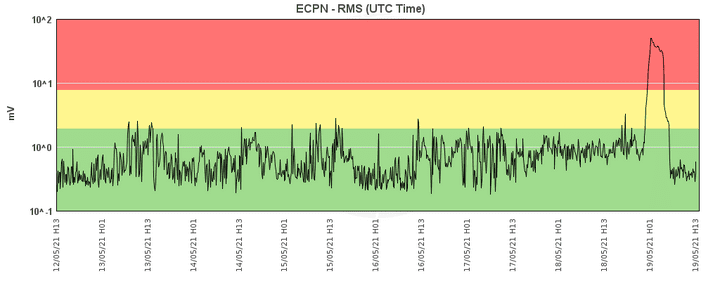
Current tremor signal showing the peak of this morning's paroxysm (image: INGV Catania)
Almost without warning or significant preceding activity, a paroxysm - a short-lived, but intense lava fountaining eruption - took place at the New SE crater during the early hours today.
Shortly after midnight, volcanic tremor amplitude rose sharply to very high levels and a lava flow started to descend from the cone towards the SW into the upper Valle del Bove, as the magma column inside its conduit was being pushed up by a batch of gas-rich fresh magma.
Shortly after, strombolian activity began from the cone's summit crater as well, and quickly merged into moderate lava fountains. Shortly before the eruption, volcanologists could record a rapid inflation by about 1 microradiant of the volcanic edifice. By about 6 am in the morning, the eruption had ceased.
Etna volcano (Italy): Earthquake swarm under eastern flank
lun., 10 mai 2021, 06:01 06:01 AM | AUTEUR : T
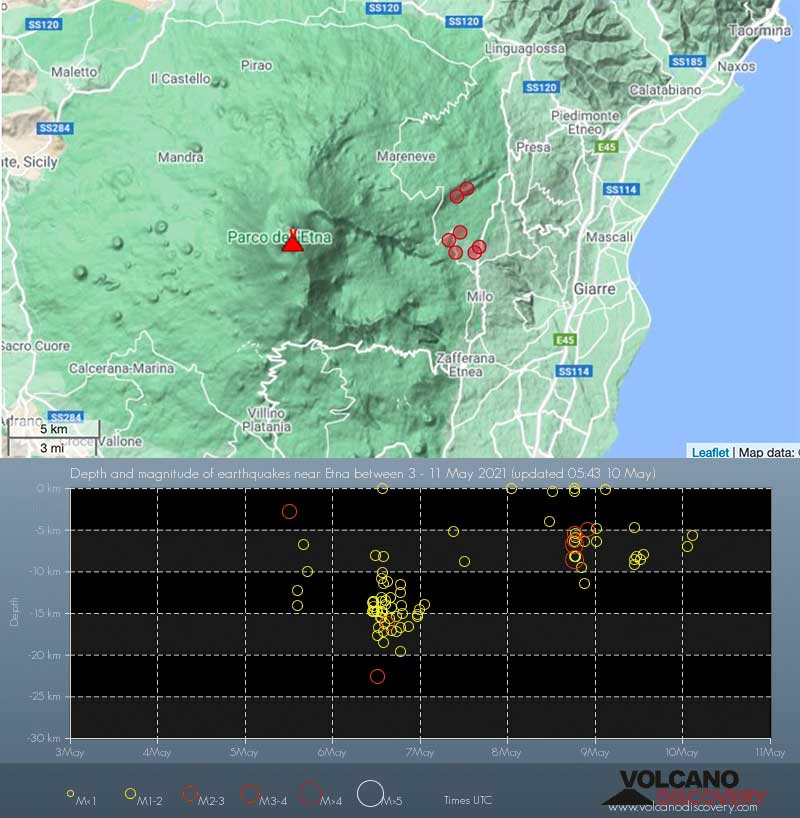
Location and depth of recent quakes under Etna volcano
The recent phase of intermittent strombolian activity at the New SE crater seems to have ended for now.
While the volcano has once again calmed down at the surface, internal activity shows interesting developments: another swarm of small earthquakes occurred during the last days under the eastern flank north of Milo including two tremors of magnitudes 3.1 near Monte Fontane. Different from the previous swarm at the end of April, the quakes involved this time were shallower, located mostly between 10-5 km depths. They likely involve local faults in this area that typically react to both gravitational adjustments of Etna's eastern flank and magma intrusions into shallower reservoirs, thus could indicate a magma recharging event of Etna.
Whether the seismic swarms are heralding new eruptive activity in the near or medium-term future (weeks to months from now) can only be speculated about at this moment, but the situation merits close monitoring.
Intermittent strombolian activity from New SE crater
Update Tue 04 May 2021 15:24
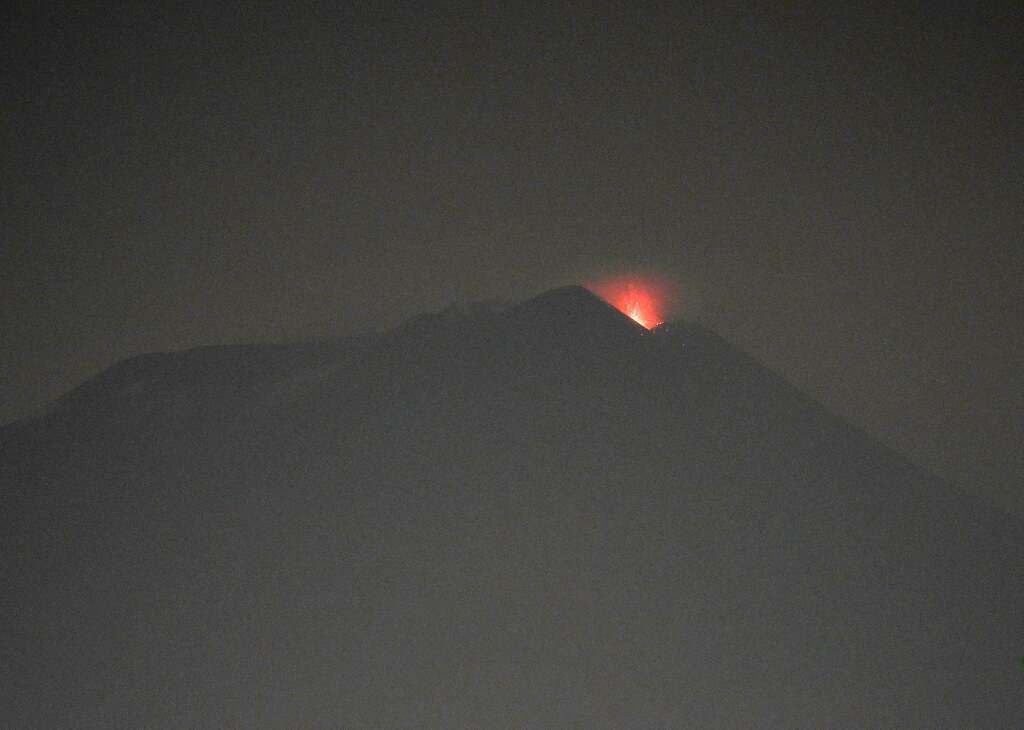
Weak strombolian eruption at Etna's New SE crater last evening (image: Boris Behncke / facebook.com/boris.behncke)
After a period of mild activity during the last days of April, the volcano had been again calm until yesterday evening, when intermittent mild strombolian activity returned once again to the New SE crater.
Current values of volcanic tremor are low, not suggesting that the activity is about to increase any time soon. It is open to speculation whether the series of particular violent lava fountain episodes during Feb-early April have now emptied the reservoir that contained eruptible magma for good, at least for the time being, and the volcano will stay relatively calm for some time now.
It is unclear whether the activity in the other summit craters (Bocca Nuova, Voragine and NE crater) still continues; it had been largely unaffected by the activity of the New SE crater and had been going on at fluctuating intensity for many months. Thermal anomalies are still present in at least some of the other vents, suggesting that mild intra-crater activity is still present, but the current near-total absence of visitors and direct observations make it difficult to know for sure.
First visit to our site? If you havn't done it yet,
download the Volcanoes & Earthquakes app to get one of the fastest volcano news online:
Android |
IOS














































































































































